

FOOTPRINTS IN PARADISE
This open access library edition is supported by Knowledge Unlatched. Not for resale.

New Directions in Anthropology
General Editor: Jacqueline Waldren, Institute of Social Anthropology, University of Oxford
Volume 1 Coping with Tourists: European Reactions
to Mass Tourism
Edited by Jeremy Boissevain
Volume 2 A Sentimental Economy: Commodity and
Community in Rural Ireland
Carles Salazar
Volume 3 Insiders and Outsiders: Paradise and
Reality in Mallorca
Jacqueline Waldren
Volume 4 The Hegemonic Male: Masculinity in a
Portuguese Town
Miguel Vale de Almeida
Volume 5 Communities of Faith: Sectarianism,
Identity, and Social Change on a Danish Island
Andrew S. Buckser
Volume 6 After Socialism: Land Reform and Rural
Social Change in Eastern Europe
Edited by Ray Abrahams
Volume 7 Immigrants and Bureaucrats: Ethiopians
in an Israeli Absorption Center
Esther Hertzog
Volume 8 A Venetian Island: Environment, History
and Change in Burano
Lidia Sciama
Volume 9 Recalling the Belgian Congo:
Conversations and Introspection
Marie-Bénédicte Dembour
Volume 10 Mastering Soldiers: Conflict, Emotions,
and the Enemy in an Israeli Military Unit
Eyal Ben-Ari
Volume 11 The Great Immigration: Russian Jews in
Israel
Dina Siegel
Volume 12 Morals of Legitimacy: Between Agency
and System
Edited by Italo Pardo
Volume 13 Academic Anthropology and the
Museum: Back to the Future
Edited by Mary Bouquet
Volume 14 Simulated Dreams: Israeli Youth and
Virtual Zionism
Haim Hazan
Volume 15 Defiance and Compliance: Negotiating
Gender in Low-Income Cairo
Heba Aziz Morsi El-Kholy
Volume 16 Troubles with Turtles: Cultural
Understandings of the Environment on a Greek Island
Dimitrios Theodossopoulos
Volume 17 Rebordering the Mediterranean:
Boundaries and Citizenship in Southern Europe
Liliana Suarez-Navaz
Volume 18 The Bounded Field: Localism and Local
Identity in an Italian Alpine Valley
Jaro Stacul
Volume 19 Foundations of National Identity: From
Catalonia to Europe
Josep Llobera
Volume 20 Bodies of Evidence: Burial, Memory and
the Recovery of Missing Persons in Cyprus
Paul Sant Cassia
Volume 21 Who Owns the Past? The Politics of Time
in a ‘Model’ Bulgarian Village
Deema Kaneff
Volume 22 An Earth-Colored Sea: ‘Race’, Culture
and the Politics of Identity in the Postcolonial
Portuguese-Speaking World
Miguel Vale De Almeida
Volume 23 Science, Magic and Religion: The Ritual
Process of Museum Magic
Edited by Mary Bouquet and Nuno Porto
Volume 24 Crossing European Boundaries: Beyond
Conventional Geographical Categories
Edited by Jaro Stacul, Christina Moutsou and
Helen Kopnina
Volume 25 Documenting Transnational Migration:
Jordanian Men Working and Studying in Europe,
Asia and North America
Richard Antoum
Volume 26 Le Malaise Créole: Ethnic Identity in
Mauritius
Rosabelle Boswell
Volume 27 Nursing Stories: Life and Death in a
German Hospice
Nicholas Eschenbruch
Volume 28 Inclusionary Rhetoric/Exclusionary
Practices: Left-wing Politics and Migrants in Italy
Davide Però
Volume 29 The Nomads of Mykonos: Performing
Liminalities in a ‘Queer’ Space
Pola Bousiou
Volume 30 Transnational Families, Migration, and
Gender: Moroccan and Filipino Women in Bologna
and Barcelona
Elisabetta Zontini
Volume 31 Envisioning Eden: Mobilizing
Imaginaries in Tourism and Beyond
Noel B. Salazar
Volume 32 Tourism, Magic and Modernity:
Cultivating the Human Garden
David Picard
Volume 33 Diasporic Generations: Memory, Politics,
and Nation among Cubans in Spain
Mette Louise Berg
Volume 34 Great Expectations: Imagination,
Anticipation and Enchantment in Tourism
Jonathan Skinner and Dimitrios
Theodossopoulos
Volume 35 Learning from the Children: Childhood,
Culture and Identity in a Changing World
Edited by Jacqueline Waldren and Ignacy-
Marek Kaminski
Volume 36 Americans in Tuscany: Charity,
Compassion and Belonging
Catherine Trundle
Volume 37 The Franco-Mauritian Elite: Power and
Anxiety in the Face of Change
Tijo Salverda
Volume 38 Tourism and Informal Encounters in
Cuba
Valerio Simoni
Volume 39 Honour and Violence: Gender, Power
and Law in Southern Pakistan
Nafisa Shah
Volume 40 Footprints in Paradise: Ecotourism,
Local Knowledge, and Nature Therapies in Okinawa
Andrea E. Murray
Volume 41 Living Before Dying: Imagining and
Remembering Home
Janette Davies
Volume 42 A Goddess in Motion: Visual Creativity
in the Cult of Maria Lionza
Roger Canals
This open access library edition is supported by Knowledge Unlatched. Not for resale.

FOOTPRINTS IN PARADISE
Ecotourism, Local Knowledge,
and Nature Therapies in Okinawa
Andrea E. Murray
berghahn
NEW YORK • OXFORD
www.berghahnbooks.com
This open access library edition is supported by Knowledge Unlatched. Not for resale.

First published in 2017 by
Berghahn Books
www.berghahnbooks.com
© 2017 Andrea E. Murray
All rights reserved. Except for the quotation of short passages
for the purposes of criticism and review, no part of this book
may be reproduced in any form or by any means, electronic or
mechanical, including photocopying, recording, or any information
storage and retrieval system now known or to be invented,
without written permission of the publisher.
Library of Congress Cataloging-in-Publication Data
Names: Murray, Andrea E.
Title: Footprints in paradise : ecotourism, local knowledge, and nature therapies in
Okinawa / Andrea E. Murray.
Description: New York : Berghahn Books, 2017. | Includes bibliographical references
and index.
Identifiers: LCCN 2017010903 (print) | LCCN 2017015913 (ebook) |
ISBN 781785333873 (eBook) | ISBN 9781785333866 (hardback : alk. paper)
Subjects: LCSH: Ecotourism—Japan—Okinawa Island. | Economic development—
Japan—Okinawa Island. | Traditional ecological knowledge—Japan—Okinawa Island.
Classification: LCC G155.J3 (ebook) | LCC G155.J3 M87 2017 (print) |
DDC 338.4/79152294—dc23
LC record available at https://lccn.loc.gov/2017010903
British Library Cataloguing in Publication Data
A catalogue record for this book is available from the British Library
ISBN 978-1-78533-386-6 (hardback)
ISBN 978-1-78533-473-3 (open access ebook)
An electronic version of this book is freely available thanks to the support of libraries
working with Knowledge Unlatched. KU is a collaborative initiative designed to make
high quality books Open Access for the public good. More information about the ini-
tiative and links to the Open Access version can be found at knowledgeunlatched.org.
is work is published subject to a Creative Commons Attribution
Noncommercial No Derivatives 4.0 International license. e terms of the
license can be found at https://creativecommons.org/licenses/by-nc-nd/4.0/.
For uses beyond those covered in the license contact Berghahn Books.
This open access library edition is supported by Knowledge Unlatched. Not for resale.

For my grandparents, Jo and Winston Murray,
who taught me the value of good old-fashioned hard work
This open access library edition is supported by Knowledge Unlatched. Not for resale.

This open access library edition is supported by Knowledge Unlatched. Not for resale.

TABLE OF CONTENTS
List of Figures
viii
Preface
x
Acknowledgments
xi
Introduction: “We want them to know nature!!”
1
Chapter One: Okinawa’s Tourism Imperative
15
Chapter Two: Slow Vulnerability in Okinawa
29
Chapter Three: Knowing and Noticing
62
Chapter Four: Ecologies of Nearness
79
Chapter Five: Healing and Nature
114
Conclusion: Yambaru Funbaru!
151
References
156
Index
167
vii
This open access library edition is supported by Knowledge Unlatched. Not for resale.

LIST OF FIGURES
Figure 0.1 Map of Okinawa Island, Okinawa Prefecture, Japan
13
Figure 1.1 Map of U.S. Military Bases in Okinawa
19
Figure 2.1 Advertisement for Habu-Mongoose Show, Nago
31
Figure 2.2a Giant Yambaru Kuina, Churaumi Aquarium, Motobu 36
Figure 2.2b Kuina in Training, Tourism Welcome Center, Kunigami 36
Figure 2.2c Cuddly Kuina Mascot at Waterfowl Festival, Naha
37
Figure 2.2d Crying Kuina, Kunigami
37
Figure 2.3a “Mongoose Northward Prevention Fence,” Yonabaru
Forest, Kunigami
39
Figure 2.3b Ministry of Environment “Mongoose Busters”
Extermination Program Logo
39
Figure 2.4 Tourist Habu-Mongoose T-Shirt: “A Battle of Legend”
41
Figure 2.5 Okinawan Agrotourists Harvest Sugarcane, Itoman
47
Figure 2.6 Agrotourists Operate Sugarcane Press, Itoman
48
Figure 3.1 Northern Okinawans Dine and Chat During
Community Gathering, Kunigami
67
Figure 4.1 Dolphins Kiss in Caricature at Wellness Village, Motobu 87
viii
This open access library edition is supported by Knowledge Unlatched. Not for resale.

List of Figures
Figure 4.2 “Restaurant Flipper” Invokes Okinawan Culinary
Tradition, Nago
92
Figure 4.3a Volunteer Coral Gardeners on Land, Ginowan
106
Figure 4.3b Coral Polyp Transplants (3 months)
107
Figure 4.3c Coral Polyp Transplants (6 months)
107
Figure 4.3d Volunteer Coral Gardeners at Sea, Ginowan
108
Figure 5.1 Okinawans Do Forest Therapy, Yonabaru Forest
114
Figure 5.2 Flier for Okinawans: “Treasure Box” Nature Games
119
ix
This open access library edition is supported by Knowledge Unlatched. Not for resale.

PREFACE
Social and political life on small subtropical islands is frequently shaped by
the economic imperative of sustainable tourism development. In Okinawa,
“ecotourism” promises to provide employment for a dwindling population
of rural youth while preserving the natural environment and bolstering re-
gional pride. In this volume, I consider how new subjectivities are produced
when host communities come to see themselves through the lens of the visit-
ing tourist. I further explore how Okinawans’ sense of place and identity are
transformed as their language, landscapes, and wildlife are reconstituted as
cherishable yet vulnerable resources.
I present a case study of how local ecological knowledge moves inter-gen-
erationally (between Okinawan elders and youth) and cross-culturally (be-
tween Okinawan nature guides and international and mainland Japanese
tourists, the latter being often also considered “foreign”). By tracing the for-
mal and informal social networks through which specific attitudes, beliefs,
and sensibilities about the environment are circulated and reproduced, I
demonstrate how nature-based therapies marketed to tourists for stress relief
and lifestyle rehabilitation (e.g., forest therapy, dolphin therapy, and coral
gardening) also influence Okinawan attitudes toward health and wellness.
These kinds of activities reconfigure human relationships with nonhuman
animal species: creatures previously “good to eat” (Harris 1985) are now
even better to heal.
Sustainability in Okinawa always begins with the question of military
bases. The ecotourism concept poses a compelling, if problematic, economic
alternative to the expansion of U.S. bases into northern Okinawa, the hub
of environmentally oriented conservationist, educational, and tourist pro-
grams on the main island. My analysis of the ecological and cultural effects
of sustaining the tourism industry in Okinawa speaks to small islands facing
similar economic and environmental challenges in East Asia, the Caribbean,
Oceania, and beyond.
x
This open access library edition is supported by Knowledge Unlatched. Not for resale.

ACKNOWLEDGMENTS
My deepest gratitude goes out to the wealth of friends, family members, and
colleagues who have helped me to generate, investigate, and ultimately com-
plete this project over the last decade. Chapter 1 was conceived with the help
of Sarah Vaughn, Goutam Gajula, Shafqat Hussain, and Anand Pandian
through a panel on “Vulnerability’s Ethical Engagements and Traces” held
at the American Anthropological Association Annual Meeting in November
2011. My colleague Rheana (Juno) Parreñas’s work on rehabilitant orang-
utans in Malaysia inspired me to consider nonhuman animal histories in
relation to human vulnerability in Chapter 2. Countless words of thanks to
Lisanne Norman and Jennifer Mack for patiently reading, editing, and cri-
tiquing every line of every chapter as they first emerged, and to Dr. Norman
for her continued editing of the manuscript as it developed. I would have
been completely lost without tracking your changes!
Sarah Kashani and Fumi Wakamatsu supported my conceptual thinking
on Japan, while the members of the Political Ecology and Reischauer Insti-
tute of Japanese Studies Working Groups provided invaluable feedback every
time we met to workshop our writing. My dear friends Illiana Quimbaya,
Sarah Kashani, Jennifer Mack, Cynthia Browne, Bridget Hanna, Aquene
Freechild, H’Sien Hayward, Alison Hillegeist, Annie Turner, and Ruthe
Farmer kept me afloat when I struggled most. Megan Scheminske, your
graphic design skills are uncrushable! My fantastic officemates Kristin Wil-
liams, Esra Gokce Sahin, Jeremy Yellen, Christopher Leighton, Hiromu
Nagahara, Raja Adal, and Jennifer Yum were always available with ample
empathy as we typed, typed, typed, in a row, day and night, Monday through
Sunday. Your humor and support were a breath of fresh air, and you know
exactly how precious oxygen was in our office.
I could not have conducted my fieldwork without the kindness and gen-
erosity of Professors Junko Ōshima and Katsunori Yamazato, and Ms. Kaori
Kinjō from the University of the Ryukyus. The incredible kindness shown
to me by my formal (and informal) advisors at Meio University—Profes-
sors Yūji Arakaki and Sumiko Ōgawa, and Dr. Eugene Boostrom—kept me
xi
This open access library edition is supported by Knowledge Unlatched. Not for resale.

Acknowledgments
healthy and at home in Okinawa. My dear healing friend, Yuri Arakaki, my
loving host mother Yoshiko Nakasone, and her wonderful niece Mutsuko
Inafuku enriched an often isolating fieldwork experience by making me feel
welcome, always. “Weasel” the wily translator: Thank you for your sense of
humor about my fieldwork.
At Harvard, Marianne Fritz, Cris Paul, Susan Farley, Amy Zug, and Su-
san Hilditch helped me to keep perspective as I struggled to clear the steep
hurdles set by the Department of Anthropology and GSAS. The endless ef-
forts of these fantastic women offer the finest argument for “Staff not Stuff!”
To my cohabitants Chris Mosier and Chenzi Xu: Our lively conversations
brought me much-needed levity during one of the most stress-filled years of
my life. Anne Allison, Diane Nelson, Deborah Thomas, and John L. Jack-
son, Jr.: Thank you for turning me on to the weird world of Anthropology
when I was most impressionable. Kimberly Theidon, thank you for helping
me to persevere when I was most discouraged.
The Department of Anthropology, the Reischauer Institute of Japanese
Studies, and the Harvard Asia Center generously supported my preliminary
summer fieldwork, as well as my participation in the Japanese language
schools and academic conferences that helped me to refine my research ques-
tions. Special thanks to Ted Gilman and Stacey Matsumoto for affording
me the many perks of being a Graduate Student Associate at RIJS (twice!).
The Fulbright Institute of International Education made my fieldwork pos-
sible despite some very difficult circumstances, and I am forever indebted to
Dr. David Satterwhite and the staff at the Japan–United States Educational
Commission in Tokyo for their tremendous support and flexibility through-
out the daunting health challenges I faced during fieldwork. My heartfelt
thanks go to Jackie Waldren for being such an inspiring friend and mentor to
me over the past decade. Without your encouragement this Berghahn Book
would not exist.
My thesis committee members each brought a different intellectual and
disciplinary gift to the table: Michael Herzfeld, you pushed me to write,
write, write, and write some more when I was blocked and despairing, and
you offered thoughtful encouragement when I needed it most. Steven Ca-
ton, you validated my unconventional writing style while gently reminding
me that I still needed to make an argument. Ian Miller, your enthusiasm
for my topic kept me engaged when my own thoughts were moving from
critical to cynical. Thanks to you, I finally have the confidence to show my
historiography to a real historian! Ted Bestor, as my advisor, friend, and sur-
rogate family in Cambridge, you and Vickey have constantly reminded me
why I became an anthropologist. You have shown me a kindness that extends
worlds beyond anything I could have imagined when I first came to big,
xii
This open access library edition is supported by Knowledge Unlatched. Not for resale.

Acknowledgments
scary Harvard University. You have both seen me through the raw and the
cooked, and I will never forget your generosity. Thank you.
Thank you to my sister, Lauren Sullivan, and to my father, Michael
Murray, for keeping the faith—in me. Jennifer “Mama Jen” Desmond: You
rescued me many times throughout graduate school and during my tumul-
tuous time in Japan. I am so grateful to you for your unfailing love and
support, always. You are also owed an honorary doctorate for your thought-
ful, real-world contributions aimed at making this project make sense.
Philip Klinkner, thank you for bringing me home after a very long journey.
I love you.
xiii
This open access library edition is supported by Knowledge Unlatched. Not for resale.

This open access library edition is supported by Knowledge Unlatched. Not for resale.

INTRODUCTION
“We want them to know nature!!”
Our guide’s impassioned explanation of his primary objective was lost on
most of the sunburned ecotour group I had joined for an afternoon of man-
grove kayaking in Higashi, one of Okinawa Island’s northernmost villages.
We sat in a circle on straw tatami mats, sheltered at last from a blazing July
sun by the red-tiled roof of a traditional Okinawan house built on sturdy
stilts to welcome rare cool breezes blowing through. An exhausted, hungry
group of ecotourists dug eagerly into a bowl full of saataa andaagii, black
sugar and pineapple-flavored “Okinawa donuts,” and chugged hibiscus tea.
Our guide, “Cha-chan,”1 a twenty-something Okinawan outdoor enthusiast
nicknamed after brown tea leaves for his year-round tan, told us about his
desire to “teach” nature, along with a bit of Okinawan history and culture,
on every tour he conducted.
His boss, Mr. Miyagi, a generation or two older and noticeably less tan,
sat on the opposite side of the floor table we were gathered around. Miyagi
interjected that the Higashi Nature School’s goals were also practical: “Of
course, our first objective is to improve the economic health of the area.
Agriculture does not appeal to the younger generations, so we bring in third
sector business and industry to retain and attract young people.”
Cha-chan was one of many self-declared “nature lovers” I met during fif-
teen months of fieldwork in the Japanese prefecture of Okinawa. He spoke
of the need to retain the rich biodiversity of northern ecosystems, symboli-
cally including himself when he told me: “I never want to be separated from
this place!” His boss, director of the Higashi Tourism Promotion Associa-
tion, was also a nature enthusiast but focused more on how to sustain the
livelihood of young guides like Cha-chan by continuing to attract the twenty
thousand mainland Japanese tourists who annually visit his hometown of
Higashi, a village with only two thousand permanent residents. Since the
late 1990s, the Higashi Nature School has grown to become northern Oki-
nawa’s model of success in promoting the “ecotourism” concept to visiting
1
This open access library edition is supported by Knowledge Unlatched. Not for resale.

Footprints in Paradise
tourists, and to a predominantly pineapple-farming community not yet ac-
customed to having large tour buses full of Japanese homestay students flood
their rivers, forests, and living rooms.
Miyagi’s description of the dramatic shift in local labor away from the
sun, sweat, and dirt afforded by the primary experience of farming, toward
the more tertiary sun, sweat, and dirt supplied by guiding ecotours, indi-
cates that tourists are not the only population to experience something pro-
foundly new and different when they don a wetsuit to dive deeper into the
ocean, or enter a subtropical forest to listen for the call of rare birds. When
I asked him whether the growth of ecotourism in Higashi had changed lo-
cal attitudes toward nature, Miyagi replied without hesitating: “Not much.
It hasn’t yet. The locals only see the money. It’s easy to see business. Then
again, people have begun to really want to show a nice clean town to visitors
for profit purposes, and this has had a good effect on the environment. The
attitudes will change from now on.”
This book is an attempt to see, notice, and know how “Nature” is con-
structed and reconstituted as a cultural, economic, and touristic resource
in Okinawa. Looking through the lens of Japanese and international eco-
tourists while tracing the footprints of their Okinawan nature interpreters, I
present a case study of how knowledge about the environment is localized,
packaged, and reproduced for tourist consumption in northern Okinawa as
part of a much larger Japanese state project promoting village revitalization.
The economic and social transformation of the northern Yambaru Area of
Okinawa Island—from an “inconvenient countryside” and a “harsh place
with only mountains” (Ministry of Environment 2008: 2) into a biodiver-
sity hotspot that hosts nearly 25 percent of Japan’s plant species and four of
Japan’s twelve endemic animals—redefines the environmental sensibilities of
visitors and residents alike.
I consider the touristic, activist, and educational initiatives through which
Okinawans express and promote their archipelago’s specific environmental
concerns to visitors while forging new touristic enterprises to sustain local
economies. The binarizing social and analytical categories of visitor/visited,
local/expert, insider/outsider, and host/guest frequently deployed in anthro-
pological studies of tourism2 are both reproduced and transcended in Oki-
nawa. Multiple forms of naturalized touristic encounters between humans
and other humans, and between humans and nonhuman forms of life are
made visible through ecotourism and other facilitated experiences of nature.
The nature of these experiences calls into question the location and limits of
the natural environment that local guides and visiting tourists seek to expe-
rience, encouraging new theoretical perspectives on why we are compelled
to get closer to “green.” In Okinawa, knowing nature—even loving it—is a
matter of interpretation.
2
This open access library edition is supported by Knowledge Unlatched. Not for resale.

Introduction
Locating the Ecotourist: Theoretical Questions
As a typical Japanese tourist in Okinawa, you would probably arrive in Jan-
uary, March, or August with your spouse and 1.25 children, drop your lug-
gage at one of Japan Airlines’ luxurious, all-inclusive beachfront hotels, and
instruct your pre-programmed GPS-equipped rental car to take you straight
to three of the most popular tourist sites: Okinawa Peace Memorial Park; an
enclosed cultural theme park such as Okinawa World; and Churaumi, the
world’s second-largest aquarium. You might collect a few kariyushi “happi-
ness” Hawaiian shirts for your co-workers and some pit viper–infused awam-
ori liquor before finally hitting the beach, where you could partake in marine
leisure sports such as snorkeling or a one-time fun dive. You would allot ap-
proximately 2.5 days to see, do, and buy it all before flying back to Tokyo to
return to work, and your fond memories might not include any Okinawans.
For a middle-class family embarking on its first big trip, the practical
appeal of taking a “quasi-overseas trip to quasi-foreign, quasi-tropical” (Figal
2012: 122) Okinawa would likely include the ease of speaking Japanese and
spending yen, minimal travel time (about four hours by plane from Tokyo
to Naha), and affordable amenities.
These stereotypes of Japanese patterns of domestic tourism3 are well-worn
territory, among both tourists (5.7 million visited Okinawa in 2009), and
anthropologists of Japan (e.g., Graburn 1989; Hendry 1995; Ivy 1995). An-
thropologists have tended to frame their studies of tourism in terms of the rit-
ual and religious origins of tourism (Graburn 1983), the marketing of village
tourism to urban Japanese (Ivy 1995; Robertson 1991), or the negative social,
cultural, and environmental effects of village tourism (Moon 1997, 1998).
Whether explaining the historical roots of contemporary Japanese modes
of travel (Graburn 1983) or analyzing the relationship between nostalgia and
national identity at play in domestic village travel (Robertson 1988), anthro-
pologists of Japan have tended to study domestic tourism from the perspective
of the tourist guest. Common scholarly assumptions that tourism has been
“imposed on locals, not sought, and not invited” (Stronza 2001: 262) have im-
peded a full understanding of why host communities engage in tourism in par-
ticular ways. Studies of recipient communities have criticized the deleterious
social and environmental effects of tourism caused by the commodification of
nature (Moon 1997: 222) without fully considering the financial, cultural, and
community benefits that locals may also derive from actively studying their
surroundings and sharing certain aspects of their lives with outsiders.
Marilyn Ivy points out that “those who are living continuously in the
place where they were born do not call that place furusato [old village or
native place]” (Ivy 1995: 103). I contribute to the anthropology of Okinawa
by asking how nostalgia operates for Okinawan hosts engaged in ecotourism
3
This open access library edition is supported by Knowledge Unlatched. Not for resale.

Footprints in Paradise
in northern towns such as Ōgimi, where a giant carved banner greets visitors:
“Welcome to the long-living furusato!” Chris Nelson’s (2008: 24) ethnogra-
phy of Okinawan popular performers provides insight into how the trope
of the idyllic Okinawan past both attracts visitors “in search of an authentic
experience of a lost Japan” and incites the postwar “will to memory” among
the performers. Okinawan nature interpreters (including young novices and
experienced retirees) also reify these discourses of loss through storytelling
and performance when leading tours.
The existing literature on Japan provides useful theoretical frameworks
for understanding how domestic tourism supports rural areas struggling
with depopulation and stagnant economies (Ivy 1988, 1995; Moon 1997;
Siegenthaler 1999) and creates educational opportunities for tourist “pil-
grims” (Graburn 1983). Yugo Ono’s (2005) study of Ainu ecotourism and
cultural heritage advocacy in Hokkaido demonstrates how one of Japan’s
ethnic minority groups can mobilize the natural resources of the countryside
to supplement previously established rural industries such as rice cultiva-
tion, fishing, and logging. While recent scholarship dedicated to the political
ecology of global tourism begins to cover more territory (cf. Mostafanezhad
et. al 2016), ecotourism in East Asia has been largely overlooked by social
scientists. Previously one had to journey to a Tanzanian island marine park
(Walley 2004), a Costa Rican rainforest (Vivanco 2006), or an Indonesian
island (Lowe 2006) to find a critical ethnographic examination of the com-
modification of the environment (Walsh 2012) through ecotourism.
Ecotourism is most commonly associated with the hyper-naturalized
imaginary of the “Global South” (this term refers to countries such as Costa
Rica, Kenya, and Brazil), but over the last twenty years national parks and
nature preserves throughout the United States, Europe, Australia, and Japan
have also begun to adopt the concept. Through a politics of nature Laura
Ogden (2011: 96) regards as “ecological fame-making,” northern Okinawa’s
Yambaru forests, for example, are now comparable to Costa Rica’s Monte
Verde, a veteran “biodiversity hot spot” (Vivanco 2006: 10) that contains
5 percent of the world’s floral and faunal species. Every ten square kilometers
of Okinawa is more than “twenty times richer” (McCormack 1999: 262)
than equivalent areas elsewhere in Japan.
Anthropologists have studied tourism as a transnational vector for the
commodification of culture (Greenwood 1989); as route for and producer
of globalization (Enloe 2014; Stronza 2005); as a mediator of insiders’ and
outsiders’ sense of community and belonging (Smith 1989: 5; Waldren
1996); as a colonialist holdover (Urry 1990); as a source of environmental
degradation and exploitation (Bundy 1996; Vivanco 2006); even as a form
of governance (West and Carrier 2004). As a result, Amanda Stronza (2005:
263) suggests, we know ‘“practically nothing’ about the impacts of tourism
4
This open access library edition is supported by Knowledge Unlatched. Not for resale.

Introduction
on tourists themselves. How are they affected by what they see, do, and
experience during their travels?” Paige West and James Carrier (2004), in
their case studies of ecotourism in Jamaica and Papua New Guinea, find
that the dominant hopes and desires of Western tourists can be gleaned from
the behaviors of host countries. They argue that ecotourism “encourages a
particular way of knowing people and things in pertinent parts of the world”
(2004: 485) and further develop Carrier’s term “virtualism” (Carrier and
Miller 1998) to explain how ecotourism, a quintessentially neoliberal busi-
ness concept, moves and grows in similar ways despite being implemented
in diverse cultural contexts.
Virtualism explains some of the contradictions inherent in ecotourism:
that it tends not to preserve valued ecosystems, but rather creates landscapes
that conform to Western fantasies about Nature4 through a rationalized
“market-oriented nature politics” (West and Carrier 2004: 485; cf. Sivara-
makrishnan 1998); or that the local (“traditional”) values that ecotourism
host communities intend to preserve tend to be replaced by capitalist com-
mercial values (West and Carrier 2004: 486). One of the most common
fantasies disseminating from the so-called Global North is the “rescue of
Nature from anthropogenic destruction” (Keller 2015: 8), a discourse driven
by the rise of industrial capitalism and an underlying belief that Nature is
(or at least should be) kept separate from humanity (West and Carrier 2004:
485). My key questions include: How are these discourses mobilized in a
non-Western, non–Judeo-Christian context? Is there a Japanese equivalent
to the Nature rescue fantasy? If so, how does it manifest in ‘“Tropical Para-
dise Okinawa’” (Figal 2012: 8)?
Clifford Geertz (1997: 20) writes that the study and management of tour-
ism requires that it be conceptualized as an “extended field of relationships,
not readily disentangled from one another, not easily sorted … into clear-cut
and exclusive, opposing categories.” Such oppositional categories include host/
guest, inside/outside, local/global, we/they, and here/there. Studies of eco-
tourism in the early twenty-first century must also address binaries such as
human/non-human, North/South, Western/non-Western, and rich/poor. Ac-
cordingly, this study of the political ecology of ecotourism in Okinawa
demonstrates that “green development” (Adams 1990) is not limited to de-
veloping equatorial nations, and challenges the binarizing discourses of the
Global North and Global South. Ecological appreciation of one form or an-
other is becoming a “positive national characteristic” (Vivanco 2006: 10) in
many countries, but cultural expressions of this cosmopolitan sentiment are
both historically and geographically contingent. This ethnography contrib-
utes to sustainable development literature by providing a case study of eco-
tourism in Okinawa—among the poorest prefectures of one of the world’s
wealthiest nations.
5
This open access library edition is supported by Knowledge Unlatched. Not for resale.

Footprints in Paradise
I began my fieldwork planning to focus on the experiences of mainland
Japanese tourists. However, the first few ecotours I joined helped me realize
that the local (“host”) experience of ecotourism, while it does not involve
travel per se, affects Okinawan perceptions of the environment that move
well beyond the socioeconomic motivations identified by Mr. Miyagi in the
opening ethnographic anecdote. Engagement in tourism-related activities
that encourage Okinawans to view their proximate natural environments as
unique and even healing shapes local participants’ sense of place and sense
of self. In the process of embracing, reappropriating, and responding to the
early twenty-first–century set of political and economic constraints, which I
label collectively as the “tourism imperative,” Okinawans also come to view
their biophysical surroundings like a tourist.
Authenticity and Power
I hate travelling and explorers. Yet here I am proposing to tell the story of [their]
expeditions.
—Claude Lévi-Strauss, Tristes Tropiques
The tourist can be defined as “a temporarily leisured person who voluntarily
visits a place away from home for the purpose of experiencing a change”
(Smith 1989: 1). Valene Smith’s classic definition is broad enough to in-
clude virtually all kinds of tourists seeking multiple forms of change (geo-
graphic, climatic, psychological, or spiritual). Amanda Stronza argues that
these leisured people are actually “key protagonists in processes of globaliza-
tion” (2005: 171). Are all tourists today mere pawns in a multibillion-dollar
global industry, or do participants in small-scale forms of alternative tour-
ism develop a sense of ethical responsibility to the places they visit? In 2012,
2 percent of all human carbon emissions came from airplane travel (Mc-
Grath 2016). If ecotourists are concerned with the protection of the natural
environment, then why not curb the carbon footprint and “staycation” at
home?
While “sun, sex, sea, and sand”5 (Crick 1989: 307) form highly visible
components of most island tourism, leisure travel in Japan is often character-
ized as including an explicitly educational element as well (Kato 1994). Go-
toh et al. (2008) find that changes in Japanese demand for marine tourism
can also be linked to larger nationwide sociological trends: growing demands
for leisure time, greater quality of life, and extended leisure activities—as
opposed to short periods of socializing around work—are all changing the
nature of domestic tourism in Okinawa. The authors suggest that ecotour-
6
This open access library edition is supported by Knowledge Unlatched. Not for resale.

Introduction
ism (sometimes referred to as “green tourism”) favors “the environment
and environmental consciousness over sightseeing” through its promise of
a “richer holiday experience through deeper interaction with a community”
(2008: 31).
Until 2015, The International Ecotourism Society (TIES) offered a
simple definition of ecotourism: “responsible travel to natural areas that
conserves the environment and improves the welfare of local people.” The
updated definition reveals the importance now given to the role of the local
interpreter: “responsible travel to natural areas that conserves the environ-
ment, sustains the well-being of the local people and involves interpretation
and education [of staff and guests]” (TIES 2015). Center for Responsible
Tourism Director Martha Honey’s vision of ecotourism is even more ambi-
tious: beyond promoting low-impact, small-scale travel to fragile, pristine,
and usually protected areas, ecotourism also “helps educate the traveler; pro-
vides funds for conservation; directly benefits the economic development
and political empowerment of local communities and fosters respect for dif-
ferent cultures and for human rights” (Honey 2000: 33). These idealized
definitions warrant unpacking; ecotourism is the fastest growing segment of
the tourism industry, with global expenditure estimates ranging from US$30
billion (Honey 1999: 9) to US$1.2 trillion (West and Carrier 2004: 483; cf.
Butcher 2007; Gössling 2003; Gössling and Hall 2006; Hill and Gale 2009;
Holden 2000). This ethnography builds on Noel B. Salazar’s (2010) study of
power in tourism by moving away from one-sided studies of the impacts of
the global tourism imperative on hosts or guests and instead analyzes the sto-
ries and experiences of local guides, interpreters, and other primary media-
tors of “Tourist Okinawa” (Figal 2012: 15), a carefully curated and mutually
constitutive tropicalized space.
Ecotourism is an idealized travel concept that often emerges in discourses
of sustainable tourism development, but perhaps due to its inherently local-
ized scope, the movement lacks internationally agreed upon standards of im-
plementation and offers few comparative or comprehensive metrics that can
be used to determine its effectiveness. Likewise, the genuine ecotourist can
hardly be identified by his or her rucksack and reusable canteen. Rather, eco-
tourism researcher Robert Fletcher suggests, the ecotourist might be more
easily identified by the strenuousness of leisure activities pursued. According
to Fletcher (2009: 276), unlike “conventional mass tourism where the object
is typically to relax and pamper oneself, the aim of ecotourism is to engage in
strenuous physical exertion and experience uncomfortable—if not expressly
unpleasant—conditions.”
Debates about the problem of authenticity pervade social science litera-
ture on tourism. Erve Chambers (2000) emphasizes the source of agency as
7
This open access library edition is supported by Knowledge Unlatched. Not for resale.

Footprints in Paradise
the key measure of authenticity in host communities. Gerald Figal’s (2012:
89) work on heritage tourism in Okinawa builds on Chambers’s theory of
authenticity by not equating the real/traditional/authentic with “always and
only things of the past one strives to reproduce faithfully under conditions
of modernity” (cf. MacCannell 1999). My objective in studying ecotourism
development in Okinawa is neither to “condemn hoaxes nor to award diplo-
mas of genuineness, but rather to understand a moral and social phenome-
non which is especially peculiar” (Lévi-Strauss 1955: 18).
West and Carrier (2004: 485) demystify another contradiction inherent
in ecotourism—the apparent ethical contradiction between conservation and
travel—by demonstrating that the authenticity of a traveler’s experience is
judged through the framework of “Nature and the frontier” rather than the
messages of conservation biologists or anthropologists. Primordial Nature,
with its host of exoticized plants, animals, and (in some cases) people, can
only be reached by “being here” (Geertz 1988: 130). We can begin to un-
derstand ecotourism’s peculiar mix of leisure, fantasy, and activism by first
studying its proponents and practitioners—those who are already “here,” nav-
igating with great passion the future of tourism development on Okinawa.
Ecotourism is meant to change the nature of encounters between hosts
and guests in destination communities and ecosystems around the world
(Stronza 2005: 171). This ethnography focuses on the experiences of “ed-
ucationally oriented” Okinawan and mainland Japanese travelers (Smith
1989: 5). The consumer profile of the ecotourist is different from that of the
middle-class Japanese tourist who, since the 1960s, has desired Tropical Para-
dise Okinawa. However, Akinori Kato finds that the difference is more likely
a matter of degree than kind. The educational component of ecotourism is
important not only to Japanese vacationers who seek to camouflage or at
least justify the purely recreational element of their trips with an educational
(or religious) component (Kato 1994: 57–59); improving environmental ed-
ucation about Okinawa is also a top priority for many of the nature guides
I met during fieldwork. By examining the touristic reciprocity that shapes
host-guest encounters at Okinawa’s natural sites, I hope to complicate our
understanding of the motives and desires of those who preserve, maintain,
package, and present these places for outsiders—and for themselves.
By studying ecotourism in Okinawa, I complicate the narrow view that
most educationally oriented travelers who participate in ecotourism, whether
as paying customers, guides, or planners, are also members of a very narrow
demographic: “namely, white, professional-middle-class members of post-
industrial Western societies” (Fletcher 2009: 271). According to Robert
Fletcher, these professionals tend to be people who practice (or were raised
by practitioners of ) “relatively well-paid white-collar professions” (271)
8
This open access library edition is supported by Knowledge Unlatched. Not for resale.

Introduction
such as teaching, journalism, business, and law. While Japanese people have
been problematically characterized as “Honorary Whites” or even “Honor-
ary Europeans” (Adachi 2010; cf. Beasley 1987; Kawasaki 2001), Fletcher’s
generalizations about the ethnic, cultural, and geographic backgrounds of
most ecotourists lose traction when considered in the Okinawan context. In
Okinawa, racialized discourses of difference constructed vis-à-vis the idea of
the dominant mainland Japanese ethnic group unsettle hemispheric divides
(cf. Keller 2015; Lowe 2006; Tsing 2005) that inform much of the existing
scholarship on ecotourism.
Nature has always been a resource in Okinawa, but Yambaru’s recent eco-
nomic transformation from supplier of lumber for postwar reconstruction
in the south to recipient of vacationers (from southern Okinawa Island,
mainland Japan, the United States, and beyond) has dramatically altered the
region’s economic makeup. This transformation has also spurred new dis-
courses of ecological uniqueness that influence local residents’ regard for the
everyday rivers, forests, and oceans that constitute the northern landscape.
By bringing this landscape to life in a dynamic new way, ecotour guides re-
conceptualize their own and their customers’ practical, physical, emotional,
and spiritual relationships with biophysical nature.
This book is a parallel endeavor. Rather than presenting the biophysical
world in snippets of colorful ethnographic details to evoke the scene of pri-
mary human-human interactions and events, I place forests, oceans, rivers,
and their array of nonhuman inhabitants centrally in my narrative. I em-
ploy “landscape ethnography,” which Laura Ogden defines as “an approach
to writing culture that is attentive to the ways in which our relations with
non-humans produce what it means to be human” (2011: 28). My objective
is to provide new interpretations of a few key interspecies relationships cul-
tivated through Okinawan ecotourism today. These relationships are clearly
influenced by, but not reducible to, the profound social, political, and en-
vironmental consequences of colonization and war, and the attendant dis-
courses of death, loss, violence, and invasion so superbly articulated by other
anthropologists of Okinawa (e.g., Angst 2003, 2008; Nelson 2008).
I attempt to expand scholarship on Okinawa by including nonhuman
animal histories, without which critical Okinawan perspectives on the en-
vironment cannot be usefully incorporated into the literature on tourism-
dependent islands, sustainability, and ecotourism. In addition to rendering
legible the lasting ecological consequences of nineteenth-century Japanese
colonialism, of the devastating 1945 Battle of Okinawa, and of the postwar
U.S. occupation of Okinawa (1945–72), I conduct a hopeful analysis of
Okinawan responses to the tourism imperative through new forms of en-
gagement with nature.
9
This open access library edition is supported by Knowledge Unlatched. Not for resale.

Footprints in Paradise
Fieldsites and Methods
I conducted the first half of my fieldwork (August 2009–April 2010) from
Ginowan, a central Okinawan city about a twenty-minute drive north of
the capital city of Naha where close to 90 percent of Okinawa’s popula-
tion resides (see Figure 0.1). I chose to move to Ginowan because it put
me just a short drive away from the University of the Ryukyus, where I
was affiliated and audited a variety of courses on ecotourism, sustainable
tourism development, and environmental education over the course of my
fieldwork. Ginowan, located next to the town of Chatan (where I completed
my open-water scuba diving certification in 2009), is one of the primary sites
for coastal coral transplanting activities described in Chapter 4. The bulk of
my training dives were conducted with members of Reef Check Okinawa, a
nonprofit organization (NPO) in the southern city of Itoman.
For the second half of my fieldwork (December 2010–May 2011), I
moved north to Nago, the largest city in the Yambaru Area. The name “Yam-
baru” (ჰ) combines the Chinese characters for “mountain” and “field,”
refers to the area’s geographic characteristics. The Yambaru Area includes
Nago City and the three villages of Kunigami, Higashi, and Ōgimi (see Fig-
ure 0.1). From Nago, I was able to frequently visit the Wellness Center in
the town of Motobu and the Churaumi Aquarium, as well as the Kunigami
Forest Therapy Centers, all of which became central sites for my research.
Yambaru’s forests are comprised of low hills covered by evergreen oak (Itajii)
and subtropical plants, including wild orchids, azaleas, ferns, and mistle-
toe (McCormack 1999: 267). Protected species include the Ryukyu robin,
Scops owl, Pryor’s woodpecker, Okinawa rail, and rare amphibians, reptiles,
and insects.
Throughout my fieldwork I was a visiting scholar in the University of the
Ryukyus’ Department of Tourism Sciences (DTS) and at the International
Institute for Okinawan Studies (IIOS). I worked primarily with sustainable
tourism planning and environmental education specialist Professor Junko
Ōshima (DTS) and Katsunori Yamazato, Professor of American literature
and Director of IIOS. By guest lecturing in Professor Ōshima’s Ecotourism
courses, I gained a sense of the kinds of questions and problems being ad-
dressed by tourism researchers. During the second half of my fieldwork, I
was also a visiting scholar in Tourism Sciences at Meio University in Nago.
Under the auspices of Professors Yūji Arakaki and Sumiko Ōgawa, I had
the privilege of presenting my findings at the Okinawa Ecotourism Promo-
tional Association’s annual conference in 2011. These kinds of intellectual
exchange opportunities provided invaluable networking opportunities and
helped me to refocus my scope of inquiry over the course of my fieldwork.
10
This open access library edition is supported by Knowledge Unlatched. Not for resale.

Introduction
With the help of my advisers, I gained introduction to a variety of gov-
ernment agencies and NPOs that generously facilitated my participation in
the majority of activities described in this book. At the Okinawa Interna-
tional Center in Urasoe, I attended weekly lectures and training sessions on
ecotourism and sustainable tourism development sponsored by the Japan
International Cooperation Agency (JICA), a Japanese government orga-
nization frequently compared to USAID. JICA sponsors tourism industry
professionals from the Caribbean Community (CARICOM) countries and
Oceania to engage in sustainable tourism training workshops and site visits
ranging from six weeks to six months in length. By following these groups,
actively participating in their brainstorming sessions, and serving as a discus-
sant during presentations of their project summaries, I became familiar with
the discourses of sustainability and development that pervade the tourism
sector of islands currently receiving Overseas Development Aid (ODA) from
Japan.
By following and riding on the official JICA bus, I learned which na-
ture-based tourism sites are considered most important by the Okinawans
who organized our visits. Sites included the Churaumi Aquarium, the Za-
mami Whale-Watching Association, the Ufugi Nature Museum, and Kuniga-
mi’s Forest School, all of which are discussed in the chapters that follow.
JICA and the Okinawa International Center worked in conjunction with
NPOs such as the Okinawa Environment Club (OEC) and the Kunigami
and Higashi Tourism Associations to organize experiential training fieldtrips
that fostered discussion and debate between international participants on
the relative merits and disadvantages of how ecotourism is conducted in
Okinawa. With permission from key administrators of these training tours,
I participated in ecotourism activities and observed how sustainable tourism
in Okinawa is produced for tourist consumers, local residents, and tour staff.
The interviews included in this book were conducted as formal and infor-
mal semi-structured conversations with the government officials, academics,
nonprofit directors and affiliates, guides, tourists, and museum employees
who were kind enough to answer my questions before, during, and after
tours.
I also attended Okinawa Prefecture–sponsored conferences on topics
ranging from biodiversity, conservation, and slow living to long-stay tourism
and community building. Much of the data I include was gleaned from com-
prehensive presentations and handouts provided by lecturers at these talks.
A presenter at one of these conferences outlined some of the common so-
cioeconomic characteristics of ecotourists: “They are mostly women in their
twenties, of the highest educational background.” He went on to list a few
sub-categories profiling the typical ecotourist:
11
This open access library edition is supported by Knowledge Unlatched. Not for resale.

Footprints in Paradise
• Socially Aware (politically active)
• Visible Achiever (interested in material success)
• Young Optimist (age 18–24)
I quickly determined that I was the Young Optimist (or at least, that
I had been when I began graduate school). Having my demographic mir-
rored back to me so succinctly made me squirm, and reminded me to avoid
broad generalizations about my informants wherever possible. Castaneda
and Wallace (NAPA Tourism Workshop, 19 November 2008) acknowledge
some common challenges associated with studying tourists, a category most
anthropologists have probably occupied at some point during their time in
the field: “One runs the risk of studying her/himself being a tourist partic-
ipant. … Studying tourism, especially tourists, can lead to uncomfortable
introspection without a path through the maze of self-interpretation.” The
theme of “uncomfortable introspection” that runs throughout this book is
an unintended consequence of my methodological approach, which can
be summarized as participating in ecotours and other nature-based tourist
activities; observing the ways that guides and tourists interacted with each
other and with the nonhuman life forms they sought; and conducting in-
formal, semi-structured interviews with the ecotourism advocates and local
participants whose lives and livelihoods are affected most directly by the
expansion of alternative tourism activities in the north.
This book represents my attempt to create a path through the “maze of
self-interpretation” that concerned me as an ethnographer, but also held clear
significance for Nago Museum and Ufugi Nature Museum affiliates, Forest
and Dolphin Therapy participants, and perhaps most of all for the Japanese
and Okinawan nature interpreters who, like me, linked their identities di-
rectly to their interpretive work. My research contributes to anthropological
perspectives on tourism, inter- and intra-subjectivity, and the environment
by probing the ways in which discourses of vulnerability, loss, and disaster
shape the politics of island tourism development and produce new forms
of environmental affect in guides and participants. I bridge the existing an-
thropological literature on the small island “vulnerability paradigm” (Moore
2010), “hosts and guests” (Smith 1989), and interspecies (or “post-human”)
relationships by focusing on the organized natural and touristic encounters
that bring these discourses into the same frame.
I begin my inquiry by asking: How do people become ecological stake-
holders through participation in forms of travel idealized as sustainable?
What kinds of performative acts serve to destabilize and reconstitute the
economic, political, and social categories oversimplified by the labels Tour-
ist, Expert, and Local? I consider broadly what is at stake in our ability to
12
This open access library edition is supported by Knowledge Unlatched. Not for resale.

Introduction
cultivate and support affective relationships with nonhuman forms of life—a
need that increasingly manifests in the form of nature-based tourism.
The pages that follow will take you on a series of ethnographically ren-
dered ecotours and other touristic animal encounters that re-create the com-
plexity of experience I saw, touched, and felt when following guides and
their tourists into the woods, under the sea, and into the town halls, con-
ference rooms, and museums where they discussed what these forays into
nature mean to them.
FIGURE 0.1 • Map of Okinawa Island, Okinawa Prefecture, Japan6
13
This open access library edition is supported by Knowledge Unlatched. Not for resale.

Footprints in Paradise
Notes
1. All informants’ given names and nicknames have been changed. All Japanese and Oki-
nawan names are presented throughout the text as follows: [First Name] [Family Name]
in accordance with standard English language practice.
2. Noel Salazar (2010: 139) grapples with the politics of naming social actors in host com-
munities, considering “passive” terms favored by other scholars: “visitee,” “travelee,” and
“touree.” Salazar favors the more agentive “tourate” for his multi-sited study of foreign
tourist guides in developing countries. Because this ethnography explores the fluidity of
identities within domestic tourism and across multiple social frames (cultural, occupa-
tional, political), I do not favor any one descriptor for Okinawans involved in the tourism
industry. Rather, I adopt the language used by my informants to describe their work.
3. While the focus of this ethnography is Japanese domestic tourism, it is worth noting that,
according to the World Tourism Organization, in 2005 roughly a quarter of international
“tropical island tourists” came from Australia, Japan, and Indonesia (Picard 2013: 17). For
a discussion of translation, knowledge, and nature-based Japanese tourism in Canada, see
Satsuka (2015).
4. Raymond Williams (1983) observes that the word “Nature” is “perhaps the most com-
plex word in the [English] language” (219). Following Anna Tsing (2005) and Eva Keller
(2015), I capitalize “Nature” when emphasizing a particular related discourse or defini-
tion such as “singular global system uniting all life” (Tsing 2005: 91). I do not capitalize
“nature” when using the term to convey its many other meanings. For a groundbreaking
history of a similarly problematic term, “Wilderness,” see Cronon (1995).
5. These are Crick’s often cited “4-S’s of tourism” (1989).
6. Courtesy of the University of Texas Libraries, The University of Texas at Austin.
14
This open access library edition is supported by Knowledge Unlatched. Not for resale.

Chapter 1
OKINAWA’S TOURISM IMPERATIVE
Introduction
A basic familiarity with Okinawa’s history and political economy is essential
to understanding the prefecture’s tourism industry in the early twenty-first
century. In this chapter, I provide a brief overview of the historical circum-
stances that have produced tourism dependency in Okinawa. I trace the
development of Okinawa’s tourism imperative to explain the contemporary
practice and presentation of ecotourism in northern Okinawa.
Island Geographies, Populations, and the Politics of Naming
Okinawa is Japan’s southernmost prefecture. The formal prefecture consists
of roughly 160 islands encompassed by a longer chain of islands collectively
known as the Ryūkyū Archipelago (ਹ౯⊝ặ), about forty of which are
inhabited by people. The Ryūkyū Archipelago stretches over a thousand
kilometers, extending southwest from Kyushu (the southernmost island of
Japan’s four main islands) to Taiwan. The archipelago is usually divided from
northeast to southwest and includes four geographic subgroupings: Oki-
nawa, Miyako, Yaeyama, and Senkaku Islands. The prefecture’s capital city,
Naha, is centrally located on Okinawa Island (Okinawa hontō),1 by far the
largest of the Ryūkyū Islands and the primary site of my fieldwork.
Okinawa’s political history can be examined through the lens of language,
which is also deeply linked to the questions of cultural authenticity, exoti-
cized otherness, and regional pride that continue to shape touristic represen-
tations of the island today. The former semi-autonomous Ryūkyū Kingdom
operated centrally in an expansive trading system that began during the sev-
enth century, connecting the archipelago with China from the fourteenth
15
This open access library edition is supported by Knowledge Unlatched. Not for resale.

Footprints in Paradise
century, and Japan from the fifteenth century, until the late nineteenth cen-
tury, throughout which the Ryūkyūan government paid tribute to both pow-
ers (Zabilka 1959: 15–17).
The name, according to the Chinese, is of Chinese origin, for the word “Lew-
k’ew” [Ryūkyū] means “hanging beads” and refers to the fact that this island
chain is like a string of tassels on the skirt of China. But though the Japanese
have allowed their own pronunciation of this name to stand, they favor the name
“Okinawa” or the “long sea rope” which stretches as a cable between Japan and
Formosa [Taiwan], and thus makes these islands and Formosa an integral part of
Japan proper. (Gast 1945: 12)
The expansionist Japanese government formally annexed Okinawa in 1872,
establishing Okinawa Prefecture in 1879. Americans referred to the same
group of islands as “Ryukyu” from their first involvement in the mid nine-
teenth century until the end of the post–World War II U.S. military occu-
pation (1945–72).
The Okinawan-language term for Okinawa is Uchinaa. There are many
ways to refer to the Okinawan language, each carrying a different political
valence. In Japanese, the now dominant language of Okinawa Prefecture
(and the language in which I conducted the bulk of my fieldwork), one is
most likely to hear the terms Okinawa-go (Okinawan) or hōgen (dialect of
Japanese). In Okinawan, however, Uchinaaguchi (literally “mouth of Uchi-
naa”) denotes the umbrella language that was spoken throughout the island,
with some regional variation, until Japan’s forced assimilation policies sys-
tematically eradicated it from classrooms and other public spheres during
the early twentieth century.
Linguists such as Rumiko Shinzato have recently established that Uchinaa-
guchi2 is not, in fact, a dialect of Japanese. While the two languages are genea-
logically related, Okinawan is less than 70 percent cognate with standardized
Japanese and the two are mutually unintelligible (2003: 284). Shinzato
(2003: 284-291) identifies the following six distinct periods over the course
of less than one century, a period during which the Okinawan language was
purged from daily life but eventually emerged as a key marker of cultural
pride and difference:
1) Before the creation of Okinawa Prefecture (1879): Okinawan exists as
an independent language of the Ryūkyū Kingdom
2) From 1879 until the start of First Sino-Japanese War (1895): Oki-
nawan is gradually marginalized through the “top-down” imposition
of Japanese-language–only schools and conversation training centers
for monolingual adults
16
This open access library edition is supported by Knowledge Unlatched. Not for resale.

Okinawa’s Tourism Imperative
3) From 1895 until Japan invades China again, effectively beginning the
Second World War (1937): Japanese becomes the language of educa-
tion through a period of more grassroots standardization, while Oki-
nawan is still spoken at home
4) 1937–45, a period which spans the Second Sino-Japanese War and
World War II: Okinawan is denigrated as a dialect, the use of which
is punishable in increasingly militarized schools during a period of
extreme Japanese nationalism
5) 1945–72, the period of the formal U.S. Military occupation of Oki-
nawa: Okinawan declines rapidly under postwar U.S. policies designed
to propagate English and squelch the rise of pro-Japanese sentiment
6) 1972–present (Reversion to Japan in 1972): Okinawan resurges as a
point of prefectural pride following Okinawa’s political reversion to
Japan
Until 1879, Okinawan monolingualism was standard throughout the
Ryūkyū Kingdom; today, Okinawans under age sixty speak and understand
Okinawan-accented standard Japanese. The Japanese (and later, the U.S.)
government’s political conquest of Okinawa was achieved in part through
“linguistic conquest” (286), and I very briefly summarize these periods to
historicize one of the most intensive processes through which Uchinaan-
chu (people of Okinawa) have come to regard themselves as “Okinawan”
and, to a lesser degree, “Japanese.”3 Okinawan-language greetings such as
Haisai! (Hello) and Menso~re! (Welcome) are much more likely to be di-
rected at sunblocked tourists than spoken between Okinawans in everyday
conversation.
Okinawans also have many names for mainland Japan4: Yamato (which
indexes the ancient Japanese capital of Nara and the dominant Japanese
ethnic group, known in Okinawan as Yamatonchu), Naichi (a relic of the
Japanese colonial period that indexes the main islands as the “internal” or
“home” territories), and occasionally even just Nihon (today’s most com-
monly used Japanese language name for Japan). My informants frequently
used these descriptors selectively to imply varying degrees of historical, cul-
tural, and linguistic separateness from Japan.
My informants regarded the reclamation and continued use of Okinawan,
and of dialects of Okinawan unique to the northern area where I worked, as
central to the joint enterprises of revitalizing local pride and strengthening
small-scale tourist economies. Whether for the edification and entertainment
of mainland Japanese tourists or for the benefit of Okinawans, the preserva-
tion of the Okinawan language functions as a strategic claim to authenticity
by emphasizing the islands’ cultural and historical difference from Japan.
17
This open access library edition is supported by Knowledge Unlatched. Not for resale.

Footprints in Paradise
Okinawa’s “3-k” Economy
Your assignment to the Ryukyu (Ree-YOU-que) Islands—of which Okinawa is
the largest—will place you in pleasant surroundings, face to face with people
quite different from those back home. If you have not been in the Far East before,
the sights you see and the people you meet will seem strange at first. But you
will feel at home once you get acquainted with the Ryukyuan people and make
friends with them.
It would be a mistake, in an essentially rural and village country such as the
Ryukyus, to expect the dazzling attractions found in Tokyo, London, or Paris.
But the Ryukyus have much to offer, not the least of which is the natural beauty
of a varied landscape. And wherever you go, you will find the Ryukyuans friendly
and hospitable. These winning traits of the people have earned for Okinawa such
titles as “Land of Courtesy” and “Isle of Smiles.” Even the most glum visitor will
enjoy the good-natured smiles and laughter of the Okinawans …
Because of the strategic importance of the Ryukyus, it is essential that you
understand the islands’ background and people and the political circumstances
under which the United States retains control there. This guide will help you ap-
preciate the Ryukyuan point of view by telling you a little about the Ryukyuans,
their way of life, their problems, and their aspirations. The more you know about
the Ryukyuans, the more you will appreciate them and enjoy your tour of duty
among them. Take advantage of an unusual opportunity to know at close range
these delightful Asian people. (A Pocket Guide to Okinawa,5 U.S. Department
of Defense 1961)
The above excerpt, taken from an early 1960s U.S. Department of Defense
“Pocket Guide to Okinawa” written for military personnel, illustrates key
aspects of the deep connections between Okinawa’s tourism industry and the
presence of U.S. military bases on the island (see Figure 1.1). Glenn Hook
and Richard Siddle (2003: 6) reject the image of Okinawans as “non-threat-
ening, laid-back and relaxed ‘exotic’ islander[s], ever ready to burst into song
and dance, happily supportive of the status quo and the ‘warm’ relationship
with the mainland,” a stereotype reified through similar kinds of pamphlets
now directed at mainland Japanese tourists instead of U.S. soldiers.
The formal U.S. occupation of mainland Japan ended in 1952 with the
signing of the San Francisco Peace Treaty, which recognized Japan’s ‘“resid-
ual sovereignty”’ (Tanji 2006: 61), but allowed U.S. forces ‘“to be stationed
all the time in and about Japan.” Of Okinawa, President Eisenhower pro-
claimed in his 1952 State of the Union message: ‘“The Ryukyu Islands will
be held for an indefinite period,”’ thus reinscribing the politicized differences
between Uchinaa and Yamato described previously. Another twenty years
passed before Japan and the United States negotiated the return of Okinawa
to Tokyo’s jurisdiction.
18
This open access library edition is supported by Knowledge Unlatched. Not for resale.

Okinawa’s Tourism Imperative
FIGURE 1.1 • Map of U.S. Military Bases in Okinawa6
Note: Not all U.S. military facilities are labeled.
On 15 May 1972, seven new laws were implemented to administer the
islands, including a law to address “Special Measures for Promotion and De-
velopment of the Islands of Okinawa” (Asato 2003: 234). Tourism fell under
the rubric of the Promotion and Development Plan, meant to help Okinawa
achieve parity with mainland Japan. In 1973 the mayor of Nago City fore-
shadowed the issues I explore here when he criticized Tokyo’s industry-driven
approach to development: “Human beings have become enslaved to produc-
tionism, which results in the destruction of the basis of our existence. Rather,
we citizens of Nago should take as our goal the creation of the most favorable
life environment” (234). The mayor’s criticism of Okinawans’ postwar de-
velopment imperatives as “productionism” can be read as a response to the
Okinawa Tourism Association’s (OTA) attempts to produce what members
called “tourism consciousness” (kankō ishiki) in the prefecture beginning
in 1954 (Figal 2012: 37). Gerald Figal’s (2012: 39) description of the OTA
mission can be understood as a kind of virtualism wherein “Okinawans
needed to view physically and conceptualize discursively their island in terms
consonant with the expectations of outsider visitors.”7 The Tropical Paradise/
19
This open access library edition is supported by Knowledge Unlatched. Not for resale.

Footprints in Paradise
Tourist Okinawa mentality expressed by so many Okinawans today had to
be learned as an alternative narrative to the all too real “poverty-stricken,
foreign-occupied, war-ravaged homeland” (39) Okinawans were forced to
contend with in the postwar period.
Once the 1972 Reversion eliminated strict U.S. policies that required
passports and visas for travel between Okinawa and Japan, a newly domestic
tourism promoting the “subtropical climate, the beautiful ocean, and the
exotic city scene” became a major industry (Shinzato 2003: 290). Gavan
McCormack (1999: 275) identifies the 1975 Marine Expo as the beginning
of mainland Japanese interest in Okinawa’s touristic potential, which led to a
decades-long “wave of steel” and concrete in the form of resort development.
Tourist visits jumped from 800,000 annually in 1974 to 1.8 million in 1975,
3 million in 1992, and nearly 6 million in 2009.
By the mid 1980s and 1990s, streamlined travel was furthering the spread
of a so-called “Okinawa boom” across Japan: Okinawa-themed music, the-
ater, and cinema gained popularity on the Japanese mainland, driving re-
newed interest in the revival and preservation of the Okinawan language and
mainstreaming a renewed sense of Okinawan pride. Domestic tourism con-
tinued to rise as things Okinawan grew in popularity and commercial prof-
itability, and the previously stigmatized idea of “Okinawa Time” (a slower,
more relaxed pace of life) found new currency among stressed mainland vis-
itors (Nelson 2008: 236).
Now, in the midst of what Hook and Siddle (2003: 6) identify as the
“third wave” of the post-Reversion tourism frequently characterized by bat-
tlefield tours and organized shopping trips for cheap goods, Okinawans in-
volved in ecotourism are actively resisting the typical travel packages that
place visitors in mainland-funded luxury hotels staffed by non-Okinawans.
Tourism forms one leg of Okinawa’s basic economic structure, often re-
ferred to as the “3-k” economy, meaning that kichi, kankō, kōkyō jigyō—
“bases,” “tourism,” and “public works,” respectively—constitute the main
sectors of employment in Okinawa. These three industries frequently come
into conflict over questions of aesthetics and environmental health. Hook
and Siddle describe how human intervention in the form of widespread U.S.
military base construction subjected postwar Okinawa to “the good, the bad
and the ugly” (2003: 3). Bases bring at least four major kinds of suffering
to Okinawans living nearby: clamor, calamity, contamination, and crime
(Gillem 2007: 17). Linda Angst (2003) and Cynthia Enloe (2014) show that
Okinawan girls and women are particularly vulnerable to sexual violence
perpetrated by U.S. soldiers, who between 1972 and 2001 constituted four
percent of Okinawa’s population and were responsible for 1.7 percent of
crime (Cullen 2001, quoted in Gillem 2007: 308). Chronic aircraft-related
noise pollution,8 oil spills, accidental jet and auto crashes, and robberies and
20
This open access library edition is supported by Knowledge Unlatched. Not for resale.

Okinawa’s Tourism Imperative
murders committed by U.S. soldiers are among the many complaints voiced
by Okinawans (Gillem 2007: 48).
Among Japan’s forty-seven prefectures, Okinawa comprises just 1 percent
of Japan’s landmass but holds 75 percent of U.S. bases in Japan (Hein and
Selden 2003: 5). The United States, which has more overseas military bases
than any other country (Enloe 2014: 126), currently maintains fourteen
military bases on or near Okinawa Island. These bases occupy close to 20 per-
cent of the island’s landmass and comprise roughly one-third of Yambaru in
the form of jungle training areas (McCormack 1999: 267). In 2016, there
were roughly 27,000 active-duty service members stationed on Okinawa, a
number that doubles when Department of Defense civilians and dependents
are included (Narang 2016). The social problems caused by U.S. military
bases remain the top priority in contemporary Okinawan politics, and griev-
ances frequently invoke base-related environmental destruction and the loss
of natural habitat for Okinawa’s animals.
In 1996 the Okinawa Development Agency’s expansive public works
projects constituted more than half of all construction business in Okinawa
(Hein and Selden 2003: 4). The “pristine” forests of the north become in-
creasingly valuable when juxtaposed with the “bulldozed and concreted”
rivers, beaches, and land, the damage from which feeds into the coastline
in the form of red soil runoff, killing coral and other sea life in less obvious
ways (5).
Redefining “The Environment” in the Postwar Period
To approach defining a “favorable life environment,” we must first consider
how the meaning of the term “environment” has taken shape throughout
Okinawa’s history. Okinawa-based scholar Eiko Asato succinctly outlines the
development trajectory I explore in this work: the destruction of the natural
and social environment, Asato (2003: 236) writes, “began with the devastation
of war, was followed by the degradation of the environment through military
base construction [and was] followed by industrial and tourism development.”
Shin Yamashiro’s (2005: 51–55) summary of the “critical phases” of Oki-
nawa’s environmental history complements Shinzato’s earlier analysis of Oki-
nawa’s linguistic history:
1) Preparation for War (1940s to October 1944)
2) Direct Impact of the War (1944–45)
3) Aftermath of the War (1945–72)
4) Preservation and Conservation of Natural Resources (1972 to the
1990s and onwards)
21
This open access library edition is supported by Knowledge Unlatched. Not for resale.

Footprints in Paradise
During the immediate postwar period, the newly formed United States
Civil Administration of the Ryukyus (USCAR) Department of Health, Ed-
ucation and Welfare focused on urgent matters such as sanitation, disease
control, and the primary concern of better ‘“health”’ (52)—better social en-
vironments where people could live. During the 1950s, U.S. administrative
archives used the term “environment” in reference to other issues such as
family planning, water quality, and pest control (52) (likely the control of
the rodents, snakes, and mongooses I will discuss in Chapter 2). In 1950s
and 1960s Okinawa, concerns for the environment revolved around infra-
structure and public health.
The reversion movement for Okinawan “interdependence” was framed
as a nationalist, anti-capitalist effort, as was common for decolonization
movements throughout Asia and Africa following World War II; and for
many Okinawans (and Japanese) the struggle for Okinawan independence
represented not only the retrieval of Okinawa for Japan but also a strong
assertion of Japanese independence (Tanji 2006: 86). By the 1970s, Oki-
nawa’s environmental administration had shifted from a “human-centered”
orientation toward a more comprehensive view that incorporated human
and nonhuman species as well (Yamashiro 2005: 52). Yamashiro identifies
the 1970s post-Reversion period as the moment of the Okinawan environ-
mental movement’s emergence, a time “through which we can witness how
environmental affairs became infused with attempts to protect the endan-
gered natural environment and to preserve Okinawan identity” (52).
In the early postwar period, the tourism industry was seen as an economic
sector with “great potential for national economies, opening up opportu-
nities for recreation and leisure for large parts of the population in indus-
trialized countries” (Gössling and Hall 2006: 13). Although the notion of
tourism-as-development persists in many countries, the rise of the Green
Movement in the 1960s and 1970s raised public interest in issues such as
erosion and beach crowding. The confluence of differing attitudes toward
the environment by U.S. military and Okinawans produced the milieu of
environmental politics that shapes discourses of the environment today. In
the 1960s, for example, U.S. military interest in developing central Okina-
wa’s Ishikawa Beach for recreational purposes led to the discovery that the
seawater was severely contaminated by nearby Ishikawa City—a finding that
eventually led to the first water and sewage disposal system in Okinawa (Ya-
mashiro 2005: 53–54).
In early twenty-first–century Okinawa, discourses of environment-as-
health and environment-as-nature remain intertwined in ways strongly influ-
enced by the tourism imperative. Dolphin Therapy and Forest Therapy, which
I discuss at length in Chapters 3 and 4, further naturalize contemporary beliefs
that affiliating with nature improves human health and overall well-being.
22
This open access library edition is supported by Knowledge Unlatched. Not for resale.

Okinawa’s Tourism Imperative
Tourism in Okinawa Today
Following reversion to the Japanese state in 1972, Okinawa has undergone
major economic transformations. The Okinawa Development and Promo-
tion Plan (ODP) (drafted by the prefectural government in cooperation with
Tokyo) was designed to reduce the socioeconomic gap between Okinawa
and mainland Japan and improve Okinawa’s economic self-reliance (Kakazu
1994: 151), primarily through an expansion of domestic agricultural exports
and tourist imports. Small islands such as Okinawa tend to suffer from what
Kakazu calls “dis-economies of scale”: overdependence on external trade and
official economic assistance, extremely limited resource bases, high costs of
transportation and other infrastructure, extensive out-migration, and vul-
nerability to natural disasters and environmental disruptions (217). Okina-
wa’s former agriculture (primarily sugar) and manufacturing industries have
shrunk rapidly in the face of increasing global competition, and the prefecture
depends heavily on the Japanese government for domestic development aid.
Tourism and associated service sector activities constitute the most
profound change in Okinawa’s economic and geographic landscape post-
Reversion. During the U.S. occupation, tourism accounted for only 4 percent
of Okinawa’s gross prefectural product; by the 1990s tourism had reached
25 percent (Egami 1994: 829), and by 2004 tourism accounted for 20 per-
cent of Okinawa’s total external receipts, of which 40 percent is spent on
imported goods and services (Kakazu 2011, quoted in Murphy 2011: 16).
Toward the end of the U.S. occupation, the Okinawan labor of the “house-
keeping force” required for non-tactical, non-operational chores became
the “prime pillar” of Okinawa’s economy (Morris 1968: 3). Today military
bases constitute only 5 percent of Okinawa’s GDP, down from 15 percent in
1972 (Gillem 2007: 233). According to University of the Ryukyus econo-
mist Tetsuo Umemura (2007 n.d.), in 2006 Okinawa’s economic structure
by industry was as follows: primary (agriculture, fishery, and forestry) 1.9
percent, secondary (manufacturing and construction) 11.8 percent, and ter-
tiary (services, including tourism) 90.3 percent. The gradual shift from a
military-based to a tourism-based economy has also produced the greatest
economic boom in Okinawa since 1972: more than ever, Okinawa Prefec-
ture’s 1.4 million residents rely on mainland tourists who spend more than
JP¥400 billion9 (approximately US$4.7 billion) annually—close to a quarter
of Okinawa’s gross regional product (Kakazu 1994: 5).
The tourism industry grew roughly tenfold from the 1960s to the mid
1990s (Kakazu 1994: 1), yet Okinawans still rank lowest among Japanese
in terms of per capita income: a report by the Japan Cabinet Office shows
Okinawans earned an average of ¥2,021,000 ($24,000) in 2005, less than
half that of the average Tokyo resident. Nonetheless, Okinawa currently has
23
This open access library edition is supported by Knowledge Unlatched. Not for resale.

Footprints in Paradise
the fastest-growing economy in Japan (2.6 percent, 2003–2013), and the
prefecture’s population, unlike that of the rest of the Japanese archipelago,
continues to grow.
Tourism has expanded as U.S. military base–related spending has declined,
and the results of this substantial industrial changeover have been mixed. Re-
sort facilities, for example, run the risk of becoming economic fortresses that
never fully integrate with the local economy, even as they vacuum up pre-
cious natural resources to draw mainland visitors. The rapid “resortization of
the Ryukyus” (Kakazu 1994: 151) involves giant Japanese firms edging out
local hotels to build massive resort complexes replete with eighteen-hole golf
courses and multiple swimming pools. Hotel development is always capital-
and space-intensive, but water use statistics are perhaps the most staggering:
while the average Okinawan household consumes 391 liters of water per
day, a typical city hotel and a grand resort hotel respectively use more than
810 and 1,192 liters per guest per day. Mass tourism may ultimately cause
the demise of the beautiful beaches and lush sceneries that make Okinawa
such an ideal place for a luxuriant new resort. Okinawa’s ability to resume
its Ryūkyū Kingdom status as a host of international (touristic) exchange
depends on the preservation of the islands’ most cherished natural resources.
Ecotourism in Okinawa is part of a broader localization movement in-
tended to stem what Hiroshi Kakazu calls the economic “boomerang effect”
of large-scale package tourism, whereby Japanese investment funds quickly
boomerang back to mainland Japan with limited spillover effects on the local
economy (Kakazu 1994: 159). Ecotourists visiting Okinawa would ideally
do a homestay, patronize a local minshuku,10 or rent a pension for one or two
weeks, during which time they would participate in trekking, snorkeling,
canoeing, and kayaking tours operated by local nature interpreters11 rather
than spending their money on bus tours run by guides who typically come
from mainland Japan.
The World Tourism Organization (WTO) estimates that by 2020 more
than 1.6 billion tourists will have visited the Asia Pacific region, and Oki-
nawa’s former governor Hirokazu Nakaima worked to attract at least ten
million of these visitors to Okinawa by 2017 (Murphy 2011: 16). Under
the banners of sustainable rural development, local income generation, and
the preservation of biodiversity, international lending and aid agencies have
pumped millions of dollars into ecotourism projects worldwide since the
late 1970s (Honey 1999: 7). Thus, over the last twenty years the practice
and philosophy of ecotourism has developed in response to the mass tourism
“Big Bang” (Oshiro 2007) that has already hit the Asia Pacific.
Amidst a sprinkling of Taiwanese duty-free shoppers, South Korean golf-
ers, and families of American soldiers, the vast majority (95 percent) of tour-
ists in Okinawa still come from mainland Japan (Okinawa Tourism Direc-
24
This open access library edition is supported by Knowledge Unlatched. Not for resale.

Okinawa’s Tourism Imperative
tory). The ODP estimated the “eco-footprints” of an additional one million
tourists annually in 2013, a source of major concern and protest among the
many Okinawans who would prefer to increase the quality of tourists rather
than their quantity. Many residents feel that the islands’ touristic carrying
capacity has already been surpassed and do not support former governor Na-
kaima’s ODP because of the long-term social and environmental risks posed
by extensive tourism development in Okinawa.
Mobilizing Difference: Distinguishing the Exotic
Anthropologists have noted the “ambivalent valorization” (Nelson 2008:
14) of Okinawa as culturally separate from a Japan that remains invested in
discourses of its own ethnic homogeneity (see also Hein and Selden 2003;
Molasky 1999). Over the last 150 years Okinawans were often portrayed as
racially different from Japanese. This led to social effects with grave material
consequences, including poverty and famine, forced labor and migration,
and military conscription and occupation (Nelson 2008: 12). Being distinc-
tive, on the other hand, can also mean being desired. In the context of the
tourism industry, the cultivation of Okinawa as an exoticized tropical12 par-
adise (as opposed to a backward colonial outlier) has sustained the cultural
“boom” needed to support the prefecture economically.
During fieldwork my Okinawan informants intermittently referred to
their islands as “Japan’s Hawaii” (paradisiacal), the “Galapagos of the East”
(biodiverse) (McCormack 1999: 263), and the “Keystone of the Pacific”
(strategic) (Zabilka 1959: 21). The latter term adopts the U.S. military’s per-
spective on the island but has more recently served to promote international
business tourism as well. The 2010 Okinawa Tourism Promotion Plan ap-
peals to business travelers incentivized by the prefecture’s exoticized beauty
to attend international conferences and conventions held in Okinawa, a
place that can be reached within four hours by plane from many major cities
in Asia, including Hong Kong, Manila, and Seoul. Emphasizing Okinawans’
unusual longevity13 and the population’s “overall superior state of wellness”
(Willcox et al. 2001: 423), medical anthropologist Craig Willcox even lik-
ens the archipelago to “The Real Shangri-La” (healthy) (2001: 1) (cf. Zhang
2017). These kinds of images are what attracted the six million domestic and
international tourists who visited Okinawa in 2009.
Upon closer examination, however, each of these highly marketable char-
acterizations of Okinawa contain a much deeper history of the island’s en-
vironmental and political vulnerability to outside forces. Ecological wounds
inflicted on Okinawa during World War II are today reflected by the absence
of certain features of the landscape, such as formerly vibrant villages and
25
This open access library edition is supported by Knowledge Unlatched. Not for resale.

Footprints in Paradise
greenery in the south. The southern half of Okinawa Island was left as a geo-
graphic palimpsest in the wake of the Battle of Okinawa; a surface on which
the “traumatic erasures” (Daniel 1996) of recent history can still be seen. The
obliteration of so many features of the prewar landscape eventually created
the space to reinscribe the memory of human life lost during the war. At the
Okinawa Prefectural Peace Memorial Museum in Itoman the names of more
than 240,000 war dead14 are engraved onto row upon row of black granite
walls known as the “Cornerstone of Peace.” More than 100 stones fan out
across Mabuni Hill, the location of Japanese military headquarters during
the Battle and the site of some of the fiercest fighting at the end of the battle.
The stoic memorialization of the wounded dead in this case historicizes an
acute instance of violence, while the legacy of defeat keeps Okinawa vulner-
able to U.S. military interests decades later.
The war-based “dark tourism”15 (Lennon and Foley 2000) conducted in
the south grows stark when juxtaposed with the “green,” nature-based tour-
ism of the north. Taku Suzuki, following Maria Tumarkin (2005), charac-
terizes the postwar “touristification of traumascapes” in southern Okinawa
as “neither a gradual nor a linear transformation of a place of horror and
sorrow into a place of consumerism and pleasure” (Suzuki 2010: 16). Suzuki
articulates the historical push and pull between touristified former battle
sites, labeling them as places for “sincere mourning of the victims and seri-
ous commitment to pacifism” and as sites of sheer vulgarity (16). Suzuki’s
example of the Himeyuri Cenotaph,16 a war memorial visited by more than
800,000 people per year, suggests that battlegrounds shift in meaning and
recognition over time, in accordance with tourist popularity and a changing
political climate.
J. John Lennon and Malcolm Foley (2000: 11) theorize the popularity of
visits to war memorials and battlegrounds in the early twenty-first century
as secular pilgrimages made possible by global communications technolo-
gies, advertised through the commodification of destinations for their edu-
cational value, and ultimately driven by their capacity to introduce visitors to
“anxiety and doubt about the project of modernity.” If the tragedies of World
War II can be reified through the present-day preservation and commer-
cialization of dark locations, then where and when does the war end? What
can a close examination of the places where the Battle of Okinawa did not
devastate the landscape—where there is an absence of stone memorials
and dated, quantified placards—teach us about the full scope of Okinawa’s
traumascape?
The tourism imperative has shaped the way that human history is told
in Okinawa. The legacy of the Battle of Okinawa can also be found in the
presence (and preservation) of new features of the landscape, such as acces-
sible highways,17 marked battle sites, and historical museums. The northern
26
This open access library edition is supported by Knowledge Unlatched. Not for resale.

Okinawa’s Tourism Imperative
Okuni Forest Road, built between 1977 and 1994, crosses thirty-five kilo-
meters through the heart of Yambaru and has paved the way for the invasion
of “hitherto unknown feral animals,” including dogs, cats, and mongooses
(McCormack 1999: 269). The next chapter unravels the discourses of vul-
nerability that have come to shape human-animal touristic encounters in
northern Okinawa today.
Notes
1. Unless otherwise noted, when I use the terms “Okinawa” and “Okinawan” I am referring
specifically to Okinawa Island and its human inhabitants.
2. I indicate romanized Japanese-language long vowels using conventional macrons (ā, ū, ō,
etc.). I present Okinawan-language long vowels differently (aa, uu, oo) to reinforce the
linguistic differences between the two languages that my informants unfailingly pointed
out to me.
3. Particularly when traveling abroad, many Okinawans will introduce themselves as Oki-
nawan first, and Japanese second, to demonstrate their pride and, as a few of my infor-
mants mentioned, because most of the Americans they meet are already familiar with
Okinawa owing to the U.S. military connection.
4. When Okinawans speak of mainland Japan (hondo) they are referring to the four largest
islands of Honshu, Kyushu, Shikoku, and Hokkaido. (Residents of Hokkaido Prefecture,
another relatively late addition to the Japanese state, tend to speak of only the first three
as Japan’s “mainland”). In this text, “mainland” indicates the Okinawan perspective unless
otherwise indicated. Within Okinawa Prefecture, Okinawa Island is considered the main
island of the Ryūkyū Archipelago and is referred to as Okinawa hontō.
5. This Department of Defense official publication (DOD Pam 2–50) was created by the
Office of Armed Forces Information and Education. Secretary of Defense Robert S. Mc-
Namara endorsed the guidebook for use by U.S. military personnel.
6. Courtesy of Megan M. Scheminske.
7. See Thompson (2006) for a more general discussion of island (re)tropicalization and
Picard (2011) for analysis of host-community agency within the context of the tourism
imperative.
8. For the first half of my fieldwork, I lived about 3 km from U.S. Marine Corps Futenma
Air Station in Ginowan (central Okinawa) (see Figures 0.1 and 1.1). The noise blaring
from aircraft flying overhead shook the walls of my American-style house a few times each
week. I escaped this noise pollution entirely when I moved north to Nago.
9. Due to constant fluctuations in the exchange rate between Japanese yen and U.S. dollar, I
quote most monetary figures in yen. At the time I conducted my fieldwork (2009–2011),
the average exchange rate was JP¥85 to US$1. (Hereafter currency will be represented as
“¥” for Japanese yen and “$” for U.S. dollar.)
10. Minshuku translates roughly as “peoples’ lodgings” or “staying with the people.” This form
of lodging is popular throughout Japan: Okpyo Moon discusses the mutual benefits of
such an arrangement in her case study of Hanasaku (Gunma Prefecture) (Moon 1998:
117–18).
27
This open access library edition is supported by Knowledge Unlatched. Not for resale.

Footprints in Paradise
11. Honey (2000: 30) defines nature interpreters (discussed at length in Chapter 5) “well-
trained, multilingual naturalist guides with skills in natural and cultural history, environ-
mental interpretation, ethical principles, and effective communication,” and key agents of
ecotourism’s success.
12. Following Eva Keller (2015), I recognize that “the tropics” is both an imaginative and an
empirical concept. Because the notion of the tropical is deeply embedded in discourses of
European colonial expansion in the eighteenth and nineteenth centuries (some, but not
all, of which resonate with the Japanese colonial project during the same time period),
in this ethnography I avoid using the language of tropicality except where I am quoting
secondary sources.
13. According to 1996 World Health Organization and Japan Ministry of Health and Welfare
statistical data, Okinawans ranked first in the world for longevity, with an average lifespan
of 81.2 (compared with 79.9 in mainland Japan) (Willcox et al. 2001: 2). By 2008, how-
ever, researchers at the University of the Ryukyus found that Okinawan female longevity
had declined slightly while male longevity had dropped from first place to twenty-sixth
out of Japan’s 47 prefectures (NIH 2008 n.d.).
14. This figure includes military and civilian deaths across nationality and ethnicity, and also
accounts for the war-related deaths of Okinawans in other parts of Japan and abroad.
While the name “Cornerstone of Peace” alludes to the U.S.-Japan security agreement, the
inclusion of the names of all non-Okinawan casualties is meant to express a more universal
and transcendent ‘“philosophy of peace’” (Hein and Selden 2003: 69). Sociologist Masaie
Ishihara describes this philosophy as “a kind of habitual way of life born of Okinawan
historical experience” (Ishihara 2001, quoted in Hein and Selden 2003: 69).
15. A competing term coined to encompass the phenomenon of morbid tourism is Tony
Seaton’s thanatourism. Seaton (1996: 236) defines thanatourism as “travel to a location …
motivated by the desire for actual or symbolic encounters with death.”
16. The Himeyuri Cenotaph memorializes the gas bombing deaths of the Himeyuri Nurse
Corps, a group of 211 high school girls who cared for wounded Japanese soldiers during
the Battle of Okinawa.
17. The construction of an extensive network of highways across Okinawa in lieu of trains
during the U.S. occupation made the island susceptible to the global politics of gas and
oil in an unprecedented way, and precluded the rebuilding of the old railway system in
the age of the automobile. Since 2003 a monorail has run throughout Naha City, but
Okinawa remains the only prefecture in Japan without a sophisticated railway system.
28
This open access library edition is supported by Knowledge Unlatched. Not for resale.

Chapter 2
SLOW VULNERABILITY IN OKINAWA
Introduction
Vulnerability is often understood as a condition of defenselessness to the
surrounding environment. To be vulnerable is to be susceptible to physical
or emotional harm. Human beings may find themselves vulnerable in the
context of violent warfare, in the presence of provoked venomous snakes,
and in the throes of global economic instability. Yet there is no satisfactory
verb to describe the act of being made vulnerable. “Vulnerability” is rather
conceived of as a state or a quality, comparable to a noun such as “power-
lessness” or an adjective akin to “defenseless.” In Japanese, a person can be
easy to wound (℗ƇŴƬƯƧżŧ) and a group of people can be charac-
terized as socially vulnerable (ഠ߶֥ᆀ). However, both the English and
Japanese languages could be vitalized by a verb that describes more fully the
process of being made vulnerable or “vulnerabilized.” In this chapter, I ar-
gue that social, political, and environmental vulnerability in Okinawa is not
static; rather, vulnerability is a processual phenomenon that must be situated
historically to be properly understood. This chapter reconsiders the relation-
ship between violence and vulnerability by attending to the problem of time.
Temporality is crucial to understanding the long-term effects of colonization
and war, the experiences of those who are vulnerabilized, and the expression
of this vulnerability in Okinawa today.
Animals, Violence, and Vulnerability
Forests full of Itajii (Castanopsis sieboldii), numerous valleys and flowing rivers,
and the sea surrounded by Inoo (lagoon). … Stretching from north to south
and with only a short distance from the mountain recesses to the sea, Yambaru
consists of diverse environments that change in a variety of ways. The creatures
29
This open access library edition is supported by Knowledge Unlatched. Not for resale.

Footprints in Paradise
of Yambaru use various environments in intelligent ways and live closely
linked together. The nature of Yambaru supports human beings too, who
are also closely connected to other creatures and the natural environments.
—Exhibit caption on “The Nature and Creatures of Yambaru”
Ufugi Nature Museum, Kunigami
Vulnerability in Okinawa is expressed through animals. Since it was first
formally described by scientists in 1981, the Okinawa rail (in the Okinawan
language, Yanbaru/Yambaru kuina), has become the cultural, touristic, and
conservationist mascot of northern Okinawa’s Yambaru region. The Oki-
nawa rail is a rare flightless bird endemic1 to the main island, an area fa-
mous for its natural beauty and rare semitropical forests. The rail’s inability
to defend itself against both “natural” predators such as the venomous habu
(pit viper), and “unnatural” predators, primarily the mongoose (an invasive
species), make the bird particularly powerful as a symbol of Okinawa’s envi-
ronmental vulnerability. More recently, human automobile drivers have also
killed the nocturnal bird known for crossing rural roads at dawn.
I first learned about the rail, the habu, and the mongoose while hiking
on group forest treks in the northern Yambaru Area of Okinawa Island. Our
guides’ lively moralized stories about these three animals’ relationships to the
landscape, to humans, and to each other are what first led me to think about
nonhuman animals as agents of environmental change in Okinawa. The na-
ture of the human-animal “close connections” alluded to in the epigraph
can be more fully understood by combining two histories that are often told
separately: (1) the mongoose’s environmental colonization of Yambaru, and
(2) Japan’s political and economic colonization of Okinawa.
In this chapter, I argue that the sensationalized “violence” enacted between
a pit viper and a mongoose in a contemporary, touristic context reflects a
much larger history of economic violence. This violence began when Japan’s
development of an expansive sugar industry on Okinawa Island during the
late nineteenth century thrust Okinawa into a volatile global economic sys-
tem. Sugar quickly became a quintessential vulnerabilizing cash crop that
intensified the links between humans and animals during this period—both
intimately, to each other, and to the larger economic and environmental
imperatives that prompted new forms of interspecies contact on the island.
The environmental vulnerability produced by the “sugaring” of Okinawa
exploded into an acute crisis during the 1945 Battle of Okinawa, which de-
stroyed much of the southern and central part of Okinawa. Compared with
the overwhelming environmental devastation wrought by World War II, sug-
ar’s relatively protracted agricultural “assault” on the Okinawan landscape
may appear insignificant. Even so, Okinawa’s current economic structure
30
This open access library edition is supported by Knowledge Unlatched. Not for resale.

Slow Vulnerability in Okinawa
and environmental challenges cannot be adequately understood without
attending to historical processes large and small, and to violent forces fast
and slow. Stories of the habu, the mongoose, and the Okinawa rail can
be told in many ways; in this version, I emphasize time as the narrative
vector that connects Okinawa’s nineteenth-century political economy with
today’s tourism imperative. Through the creation of a multispecies narrative
history we can begin to understand the legacy of colonization and war on
Okinawa’s “untouched” northern landscape, and how this history continues
to shape the “conditions of possibility” (Foucault 2002) for contemporary
island tourism.
Animal Actors
Mr. Uchihara, a cheerful man in his mid-sixties, jumped on stage wearing
amber-colored glasses, a tropical Okinawan kariyushi shirt, and a headband
reminiscent of an Okinawan eisaa drummer.2 Welcoming about a dozen vis-
itors to the habu-mongoose show at the Izumi tourist rest stop in Nago (see
Figure 2.1), he encouraged us to take pictures before things had even started.
FIGURE 2.1 • Advertisement for Habu-Mongoose Show, Nago
31
This open access library edition is supported by Knowledge Unlatched. Not for resale.

Footprints in Paradise
“Did you know that a pit viper can survive without food for six months?!”
Uchihara asked, warming up the audience by sharing some bits of trivia
about the snake we were there to see. A few months earlier, I had seen an en-
tirely computer-simulated habu-mongoose show at a nearby cultural theme
park. After hearing that these shows were no longer “real,” I was unsure what
to expect.
Suddenly he surprised us all by whipping the lid off a large plastic garbage
can tucked in a corner of the room to produce a real live yellow- and white-
splotched snake. Of the four poisonous snake species on Okinawa Island, he
assured us, this was not one. He enticed a few nervous children to go up on
stage and try on the harmless “boa” for size. “Click! Click! Click!” went their
parents’ mobile devices. “Remember to use your flash!” he repeated, clearly
concerned with the quality of our photos. I did not desire this particular
memory, not even for fieldwork. Was it too late for me to flee on the grounds
of animal cruelty? As though reading my mind, Uchihara singled me out as
the only non-Japanese tourist present, and stated that my foreignness made
it doubly important for me to enjoy the experience. He brought the snake
closer, suggesting that I hand my camcorder to my neighbor for a photo
opportunity. I shuddered, and was immediately embarrassed by my reflex-
ive recoil. I very tentatively grazed the snake’s skin with my fingertips, then
placed the luckless creature back in its garbage can.
“And now, for the real thing!” Uchihara shouted merrily as he used a
shiny metal hook to scoop out a habu from an adjacent can. He squeezed
the base of the snake’s head, forcing its jaws open to reveal a sharp pair
of fangs. He swung the snake around effortlessly, manipulating its poses
like a master puppeteer. There were a few squeaks and tremors from the
audience, but most people appeared to trust him to keep us alive through
the end of the show. Pointing to the snake’s brown-grey triangular head,
Uchihara taught us that head shape is the easiest way to determine whether
a species is poisonous, and commanded, “Repeat after me: I will not touch
this outside.”
After a few more minutes of showing the habu, Uchihara returned the
snake to its plastic lair and pulled down a giant projector screen. He stood
before us and began recounting the history of the live habu-mongoose show
we were not about to see: “It’s funny, isn’t it? It’s okay for dogs to fight dogs,
and for bulls to fight bulls. And people fight people, right? But to pit one
animal against a different species is illegal. This is a very unusual law. They
say Japan is the only place in the world with a law like this.” I was surprised
by his disapproval of what seemed to me like a fairly reasonable (if imper-
fect) moral delineation, but as he continued I began to understand his logic:
“It’s okay for a human to kill a mongoose, and it’s okay for a human to kill
32
This open access library edition is supported by Knowledge Unlatched. Not for resale.

Slow Vulnerability in Okinawa
a habu.3 These animals are exterminated! But it’s not okay for us to let them
kill each other. The fine for doing this is ¥1,000,000 [$12,000]!”
Anticipating a tinge of disappointment from those of us who had hoped to
see a live show, he reassured us that we were still in for a rare treat, because this
“precious” film could only be seen at his habu house. The film was about four
minutes long, and this version was indeed on the “real” end of the violence
spectrum. After opening with an aerial view of Yambaru’s lush green forests
full of chirping birds and leaping frogs, we were plunged into the midst of
a battle: an angry-looking snake stared us down, accompanied by an omi-
nous surging soundtrack reminiscent of the film Jaws. Then a vicious-looking
mongoose appeared, swaying to the mesmerizing beat of Indian tabla drums
that invoke its geographic homeland. The mongoose panted and hissed and
the habu darted wildly around it, both angling to strike. For a while things
looked promising for the snake, but the mongoose was victorious.
The lights came back on, and set before us was the real live champion.
“Meet Michiko!” Uchihara cried. Michiko was a twelve-year-old fighting
mongoose that Uchihara described dotingly as “undefeated” despite her
smaller stature. He kneeled down and cooed to her, “Oh, Michiko…,” mak-
ing everyone laugh. Her medium brown fur was surprisingly fluffy, and she
yawned and stretched as she cleaned herself within the confines of her small
metal cage. As with the habu, nobody was allowed to touch Michiko. Her
eyes danced curiously around the room while Uchihara spoke. After we met
Michiko, the show quickly devolved into a sales pitch for habu-derived male
potency pills and other snake by-products.
At the close of the show I approached Uchihara and Michiko to intro-
duce myself. The stench of urine emanating from the newspaper that lined
her cage was overwhelming, and made it difficult for me to imagine her
as anything much scarier than a guinea pig. Up close she was even cuter,
though her rhythmic shimmying turned into a nervous circular pace as I
approached. I asked Uchihara a few more questions about his views on ha-
bu-mongoose fights, and he explained that he and his colleagues had been
running these shows for over thirty years: “This is our work,” he reiterated.
Shortly thereafter he tried to recruit me to talk to the prefectural government
on his behalf, saying, “You’re a student! Maybe they’ll listen to you.” I po-
litely excused myself to purchase some snake oil.
Staged performances such as the habu-mongoose show described here
are naturalized and sensationalized in Okinawa for a variety of profit-driven
and political purposes. These animals are framed as natural enemies by the
tourism industry, through local conservation initiatives, on postcards and in
cages; their actual recorded histories belie a much more complicated biolog-
ical and political relationship.
33
This open access library edition is supported by Knowledge Unlatched. Not for resale.

Footprints in Paradise
Animal Actors in situ: “And now, for the real thing!”
Okinawa Rail
The Okinawa rail has not always been endangered, and it has not always
been restricted to the forests of northern Okinawa. As a sixty-year-old Yam-
baru retiree put it: “That bird was so common it hardly had a name. We used
to eat it.”4 First formally described by Japanese ornithologists in 1981, the
rail has many official monikers: Okinawa rail (English), Gallirallus okinawae
(Linnaean), Yambaru kuina ǺȉǦȁDžƺǠ (Okinawan), and ჰඣ哇
(Japanese).5
The rail’s population was estimated at around 1,800 in 1986, but by 2004
this number had dropped to somewhere between 700 and 1,000. The bird’s
transformation from an unremarkable forest dweller to an endangered spe-
cies and national treasure began when two Japanese researchers from the
Yamashita Institute of Ornithology published an article based on a dead
specimen they discovered in the northern village of Kunigami. Until World
War II, the bird could be found in many parts of Okinawa Island, but much
of its forest habitat was destroyed during the Battle of Okinawa and, to a
much greater extent, through postwar urban reconstruction. Jun Ui, a leader
in Japanese environmental studies, estimates that 90 percent of Okinawa’s
“pristine nature” has been lost since the 1972 Reversion (McCormack 1999:
270). Both these events were catastrophic for the bird, driving it farther and
farther north until, according to an administrator I met from the Ministry
of Environment, it could no longer accurately be called the “Okinawa” rail.
Thus, it came to be known by its current northern habitat as the national
protected species: Yambaru kuina.
The kuina can run fast, jump high, and flutter, but it cannot fly. It roosts
in trees, especially Itajii (evergreen chinquapin), and forages for small frogs,
snails, and lizards on the forest floor. Its eggs commonly fall prey to forest
crows and the habu. The pint-sized bird which weighs around 430 grams
and has a wingspan of about fifty centimeters, is also eaten by mongooses,
abandoned stray dogs, and feral cats.
Habu
Habu is the Japanese term for a variety of native venomous pit vipers found
in Okinawa. Adult Okinawa habu (Trimeresurus flavoviridis) and Hime habu
(Ovophis okinavensis), the two species most commonly found on Okinawa’s
main island, are between 120 and 150 centimeters long. Like the kuina, the
34
This open access library edition is supported by Knowledge Unlatched. Not for resale.

Slow Vulnerability in Okinawa
habu is nocturnal, but its habitat is much more diverse: it can live in forests
and fields, on mountains, and near small bodies of water. One may even
encounter a habu seeking shelter (or rodents) in old sheds and around family
tombs. The habu often resides somewhere between open palm forest and
cultivated farming areas, increasing its likelihood of contact with humans.
Mongoose
The small Indian mongoose (Herpestes javanicus) was introduced to Oki-
nawa Island in 1910 as a “biological pesticide,” a chemical-free alternative
to controlling the habu and the black rat (Rattus rattus), both of which are
detrimental to sugarcane farming. The mongoose prefers drier forest and
scrublands, but it can tolerate areas with fairly dense human populations
and is notorious for raiding chicken and egg farms. It is an opportunistic
feeder that ranges from 50 to 65 centimeters in length. Mongooses subsist
on insects but also eat amphibians, reptiles, birds, and bird eggs.
The Japanese term for “invasive species,” gairaishu (literally “species that
comes from the outside”), can also be translated as “introduced,” “non-native,”
“foreign,” or “alien” species. English-language literature on the mongoose (cf.
Yamada and Sugimura 2004) commonly refers to the animal as “invasive,”
owing to the degree of harm it is perceived to cause in its new environment.
The politics of naming, labeling, and categorizing animal species according
to their geographic origin greatly influences discourses of natural heritage,
biodiversity, and vulnerability in Okinawa. Moralized discourses of the vil-
lainous mongoose, the pathetic kuina, and the dangerous habu are brought
to life for Okinawan and tourist consumption and contrived through perfor-
mances such as habu-mongoose shows. The commoditized versions of their
“cultural biographies” (Kopytoff 1986) and interrelationships—as natural or
unnatural, right or wrong, funny or tragic, fair or unfair—are couched in an
environmental politics that elides much deeper historical connections.
During fifteen months of fieldwork in Okinawa, I saw plenty of kui-
nas: stuffed, drawn, carved, sculpted, and sold. Only once did I manage
to see a live kuina as it paced frantically behind the glass walls of a cage at
NeoPark Okinawa, an animal park in Nago City. One of my ecotour guides
pointed out its loud, distinctive morning call while we were hiking, but the
Ufugi Nature Museum’s taxidermic version, complete with recorded vocals,
brought me as close as I could get to the bird without receiving special per-
mission to visit a kuina rehabilitation center. When I asked one of the mu-
seum’s employees why it was so difficult to find a live kuina, she asked me in
return why I expected it to be easy: “They are, after all, still wild.”
35
This open access library edition is supported by Knowledge Unlatched. Not for resale.

Footprints in Paradise
Type-casting
Aside from when the kuina becomes front-page news following a gruesome
roadkill incident, or darts successfully across the road in a streak of good
timing, most people in Okinawa experience the rare bird as caricature (see
Figures 2.2a–2.2d).
FIGURE 2.2a • Giant Yambaru Kuina, Churaumi Aquarium, Motobu
FIGURE 2.2b • Kuina in Training, Tourism Welcome Center, Kunigami
36
This open access library edition is supported by Knowledge Unlatched. Not for resale.
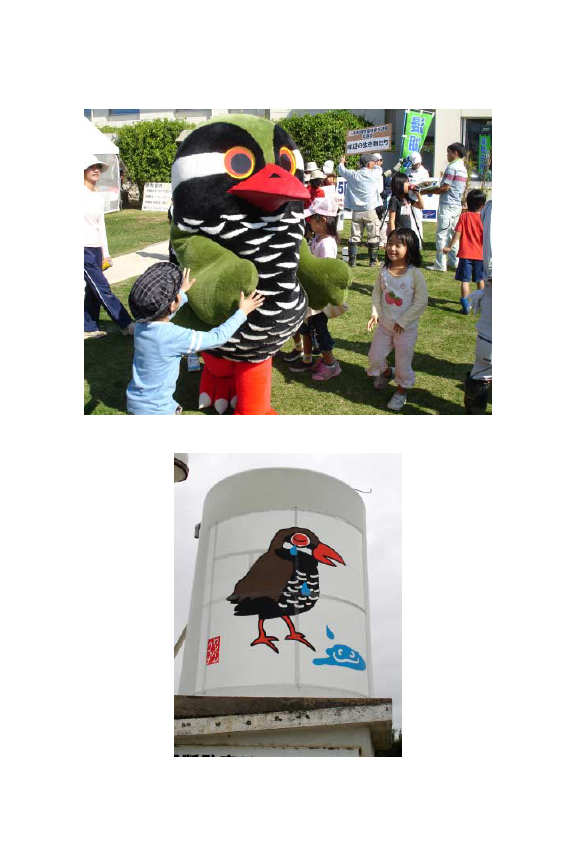
Slow Vulnerability in Okinawa
FIGURE 2.2c • Cuddly Kuina Mascot at Waterfowl Festival, Naha
FIGURE 2.2d • Crying Kuina, Kunigami
37
This open access library edition is supported by Knowledge Unlatched. Not for resale.

Footprints in Paradise
Whether it is wallowing in a pool of its own tears, nurturing its young in the
form of a gigantic Chia Pet, pumping iron for self-protection, or bumbling
around as a playful children’s mascot, in Okinawa the kuina has become an
icon of all things endangered. The Ministry of Environment and nonprofit
organizations such as the Kunigami Tourism Association regularly invoke
the kuina in the promotion of conservationist agendas. Its “cuteness” has also
made it extremely marketable on t-shirts, postcards, posters, and as stuffed
animals sold at tourist hubs across Okinawa.
Habu are not considered endangered, and most farmers attempt to kill
them on sight because of the health hazard they pose. Today, habu bites are
not usually fatal if medical care is sought immediately, but they occasionally
cause paralysis. (Bodily risks are compounded if one is unfortunate enough
to be bitten multiple times.) According to Uchihara, the master of ceremo-
nies at the habu-mongoose show I attended, until an effective serum became
available in 1963, 75 percent of people bitten died within twenty hours
(96% if bitten a second time, 99% if bitten a third time). Colorful habu
warning signs are frequently posted near forested hiking trails, on university
and lower school campuses, and around popular tourist attractions.
Habu warnings are much more likely to be encountered than the snake
itself. Most Okinawans I spoke with have happened upon a live habu once or
twice, and I was often told to avoid parks after dark to prevent contact with
habu. I once saw a dead habu sprawled on the side of the steep winding road
that leads to Kunigami’s Yonabaru Forest, but most encounters I had with
live habu were through glass. The first time I saw a habu, it was preserved in a
jar of clear alcohol and for sale on International Street (Kokusaidōri), Naha’s
main tourist strip.
Habu are hunted primarily for extermination purposes and to produce
habu-shu, a snake-infused version of the popular Okinawan distilled rice
liquor awamori. Hunters can be paid more than ¥5,000 ($40) per snake.
Habu-shu is considered a gourmet souvenir and sells for anywhere from
¥10,000 to ¥80,000 yen ($85 to $700), depending on the size of the snake
and the quality of the alcohol.
Unlike the kuina and the habu, the diurnal mongoose can be seen cross-
ing the road by people living in Yambaru. Outside a museum or theme park,
I saw a mongoose only once and nearly mistook it for a small feral cat when
it darted in front of me near my apartment in Nago. Like the kuina and the
habu, the mongoose is most commonly witnessed in the abstract (see Figures
2.3a and 2.3b).
The mongoose was imported to combat pests on sugarcane plantations
in southern Okinawa, but it was unexpectedly prolific; by the 1990s it had
spread throughout the central part of the island and was encroaching on
the north. Okinawa Prefecture and the national Ministry of Environment
38
This open access library edition is supported by Knowledge Unlatched. Not for resale.

Slow Vulnerability in Okinawa
FIGURE 2.3a • “Mongoose Northward Prevention Fence,” Yonabaru Forest,
Kunigami
FIGURE 2.3b • Ministry of Environment “Mongoose Busters” Extermination
Program Logo6
39
This open access library edition is supported by Knowledge Unlatched. Not for resale.

Footprints in Paradise
have jointly sponsored the “Yambaru Mongoose Busters,” a volunteer-driven
program based in the north that aims to eradicate the mongoose from the
prefecture. Imagery generated in connection with these efforts reifies the
interspecies morality play described in popular accounts. The Mongoose
Busters logo (Figure 2.3b) presents the mongoose and the kuina together in
a stark, abstracted manner that emphasizes the “batsu” (incorrect) nature of
their unnatural relationship. (The red x in Figure 2.3b is a symbol commonly
used to flag mistakes and errors; here x marks this particular animal dynamic
as wrong.) The mongoose is the banned aggressor, depicted in black, while
the kuina is the innocent victim in white.
Paired images of the mongoose and the habu imply a similar kind of
power imbalance, but they are completely different in tone. The habu-mon-
goose show sign in Figure 2.1 celebrates the violence of the foreign mon-
goose against another of Okinawa’s native species and exploits it for profit at
¥300 ($2.50) per ticket.
Legendary Propaganda
A legend is a story coming down from the past, one popularly regarded as
true, but not historically verifiable (see Figure 2.4). Kay Milton (2002: 150)
discusses myth in the “popular sense that it is false,” and in the anthropolog-
ical sense: “that it is believed in and dogmatically asserted because it protects
particular interests and ideologies.” Legends can also be thought of as myths
of recent origin. In this sense, the habu-mongoose fight is doubly legendary:
a recent myth, whose persistence maintains certain Okinawan ideologies of
indigenousness and invasion.
In addition to the moral and narrative dimensions already described,
popular perceptions of species vulnerability in Okinawa are shaped by the
kinds of images provided this chapter. The kuina falls prey to both the habu
and the mongoose, yet the relationship between the habu and the kuina
is considered natural because these two animals are both Okinawan. As
an invasive species, on the other hand, the mongoose is subject to much
greater scrutiny and more aggressive extermination tactics because it does
not “belong.”
The habu-mongoose dynamic in Okinawa can also be regarded as “un-
natural” because of the animals’ opposing activity cycles. Without human
intervention, they would only rarely encounter one another in the wild and
should therefore be considered “legendary” rather than “natural” enemies.
Furthermore, though it possesses immunity to viper venom, the small In-
dian mongoose has to be trained to eat snake meat through regular pre-fight
exposure to its smell and taste. Nor is the fight evenly matched—the mon-
40
This open access library edition is supported by Knowledge Unlatched. Not for resale.
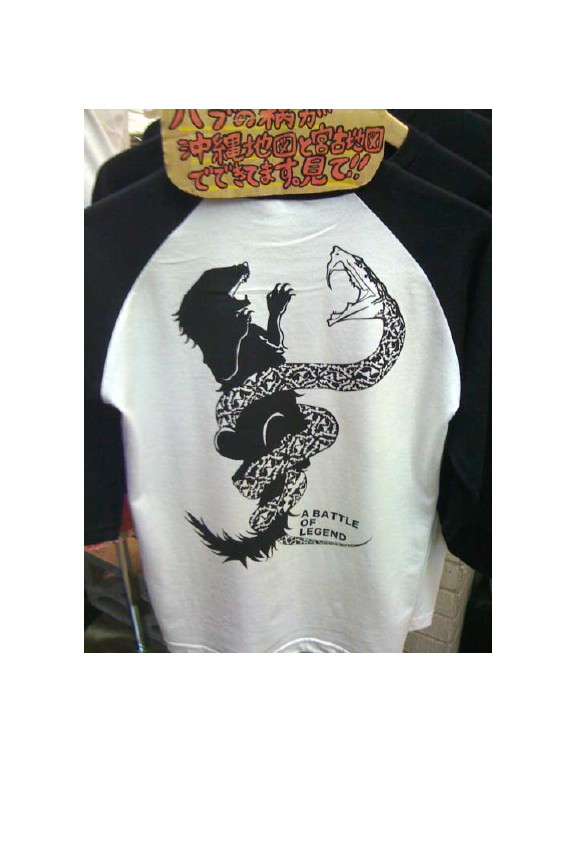
Slow Vulnerability in Okinawa
FIGURE 2.4 • Tourist Habu-Mongoose T-Shirt: “A Battle of Legend”
goose wins more than 90 percent of the time, sustaining little more than a
temporary limp if bitten.
Habu-mongoose interaction has been symbolically naturalized by specta-
cles that pit one animal against the other in a death match. These shows were
held live until 2000, when they were outlawed as Okinawa fell under intense
41
This open access library edition is supported by Knowledge Unlatched. Not for resale.

Footprints in Paradise
international scrutiny while hosting the G8 summit. The subsequent shift in
narrative is reflected in an English-language handout I was given explaining
a “swimming competition” I watched between a sea snake and a mongoose
at the theme park Okinawa World: “Now, the death match is replaced by a
friendly swimming competition, promoting love and peace.” According to
Uchihara, as of 2011 the bloody live version can only be found on Amami
Ōshima, a small Ryukyu island north of Okinawa that belongs to Kyushu
Prefecture.
Theodore C. Bestor (1989: 2) distinguishes between tradition understood
as historical continuity and tradition understood as traditionalism, which he
defines as “the manipulation, invention, and recombination of cultural pat-
terns, symbols, and motifs so as to legitimate contemporary social realities by
imbuing them with a patina of venerable historicity.” The manipulation and
antagonizing “recombination” of the habu and mongoose can be imagined as
a traditionalistic performance: these animals are cultural symbols for “native”
and “invader” in a contemporary Okinawan social reality shaped by power-
ful discourses of vulnerability, heritage loss, invasion, and endangerment.
By way of critiquing Eric Hobsbawm’s “invention of tradition” hypothe-
sis (Hobsbawm and Ranger 1983), Marilyn Ivy (1995: 21) resists analytical
binaries such as invention/authenticity, fiction/reality, and discourse/history.
Ivy settles instead on the term “phantasmatic” to characterize the late twen-
tieth-century reinscription of Japan’s cultural and historical erasures in re-
sponse to popular anxieties over the loss of national identity. For Ivy, the
phantasm is “an epistemological object whose presence or absence cannot
be definitively located” (1995: 22). The historical origins of the phantasmatic
event can never be sufficiently pinpointed; rather, the origin of an event
“emerges as such only through its displacement” (22). In the habu-mongoose
fight, the animals and the show event itself are “displaced” in what Ivy calls
the “second event”—as opposed to the first fight, which took place some-
where between the Okinawan imaginary and South Asia. The habu and the
mongoose represent the “nature that culture uses to make second nature”
(Taussig 1993, quoted in Ivy 1995: 21), through the production of a second
event. Digitally simulated and (re)produced clips of staged habu-mongoose
fights might then be regarded as a “third event”—the mimesis of a mimesis.
Today, habu-mongoose shows in Okinawa are comprised of filmed re-
productions and computer simulations replete with dim lights and dramatic
soundtracks. The virtual simulation of an always already simulated fight
perpetuates the legend in a manner that further collapses the distinction
between reality and representation, real and imaginary (Baudrillard 1994:
3). To be sure, the actual habu-mongoose fight is only “really real” (Geertz
1973: 443) to the animals. When placed in a ring together, the two will
fight, and at least one (usually the snake) will die. Their antagonistic relation-
42
This open access library edition is supported by Knowledge Unlatched. Not for resale.

Slow Vulnerability in Okinawa
ship can also be described as “hyperreal,”7 Jean Baudrillard’s (1994: 1) term
for the “generation by models of a real without origin or reality.”
And yet, as Clifford Geertz observes in a study of the Balinese cockfight,
these matches invoke important cultural themes that also pervade contem-
porary life in Okinawa, including death, loss, and vulnerability. The habu-
mongoose fight presents one view of the “essential nature” of these dominant
discourses, “rendering ordinary, everyday experience comprehensible by pre-
senting it in terms of acts and objects” (1973: 443). Here the metaphorical
finds dramatic, violent expression in the bodies of two animal actors—“ac-
tors” who can be viewed jointly as dramatic performers, and as nonhuman
agents of social change (cf. Latour 2004). What caused this fight? Is there a
really real story? The history that follows reveals the material origins of this
mythical pairing.
Setting The Scene
One version of the story begins like this:
In 1910, a leading Japanese biologist could not ignore the fact that hundreds of
Okinawans died every year from venomous snakebites. He decided to apply the
natural enemy theory, and released 17 mongooses in Okinawa, where they are
not an indigenous species. In 1981, a new species of bird called the Okinawa rail
was discovered in the Yambaru, the northern forest area of the island. Almost at
the same time, researchers for the first time realized that the original population
of 17 mongooses had increased to about 30,000, thus placing the Okinawa rail
and other indigenous species on the verge of extinction. Today, the foreign preda-
tors are conquering the Yambaru, the safest haven of the Okinawa rail.
—Yas Mamemachi (Detour Japan n.d.)
“The Mongoose Conquers Indigenous Species in Okinawa”
Detour Japan website editor Yas Mamemachi begins his posting in an online
series on “The Fear of Foreign Species” by summarizing the history of the
specific interspecies relationship that troubles many Okinawan and main-
land Japanese conservationists today.8 Literature from biology, history, and
anthropology shine light on social, political, and environmental vulnerabil-
ities. Newly shuffled sources narrate a re-contextualized story of the factors
that have gradually led to the kuina’s demise, and offer alternative plotlines
often drowned out by presentist cries of “Save the kuina! Kill the mongoose!”
While many foreign species are introduced accidentally, the mongoose’s
forced “invasion” of Okinawa Island was deliberate and well documented.9
Describing the seventeen mongoose pioneers, wildlife biologists Fumio Ya-
mada and Ken Sugimura (citing Kishida 1931) write that “six males, six
43
This open access library edition is supported by Knowledge Unlatched. Not for resale.

Footprints in Paradise
females and five individuals of unknown sexes were trapped in what is now
Bangladesh and taken to Okinawa Island by Dr. S. Watase” (Yamada and
Sugimura 2004: 118). These individuals reached sexual maturity at around
four months and expanded their range rapidly (by approximately one kilo-
meter per year) from their original site of release in Naha.
The kuina has been designated one of Japan’s Natural Monuments,10 but
the mongoose is not without its titles. In 2000 the International Union for
Conservation of Nature identified it as one of the “World’s 100 Worst In-
vasive Alien Species” (IUCN 2000; Yamada and Sugimura 2004: 118). The
mongoose has earned this title in part because there is no clear evidence that
it actually preys on the snakes it was introduced to combat (Yamada and
Sugimura 2004: 120). Furthermore, in addition to eating (and thus in a
sense creating) Japan’s “exotic species,” it causes even more damage to taro,
sweet potato, melon, and sugarcane—the very crops that it was brought in
to protect.
The predator mongoose is easy to hate but hard to kill. In addition to rely-
ing on volunteer efforts, the Ministry of Environment incentivized trappers
with a bounty of $45 (up from $20 in 2000) per mongoose killed in 2003.
Despite the combined efforts of Okinawa Prefecture and the national Min-
istry of Environment, only 1,290 mongooses were captured between 2000
and 2003 (Yamada and Sugimura 2004: 122). As I observed when hiking on
ecotours, current methods of trapping over large areas are cumbersome and
frequently capture the wrong animal.
Most mongoose narratives emphasize 1910 as the moment of rupture
in Okinawa’s environmental history, eliding important connections between
the mongoose “invasion” and Japan’s earlier colonization of the archipelago.
The wildlife biology articles I consulted for information about the mongoose
in Okinawa (e.g., Gosling 1989; Kishida 1931; Simberloff 2001; Yamada
and Sugimura 2004) mention the nineteenth-century development of plan-
tation agriculture, and historians explain the problem of snakes that drove
the animal’s introduction to the island.
Follow the Snakes
The bite of a habu should be lanced, and a tourniquet applied above
the wound as soon as possible after the snake has struck. The blood should
then be drained from the area of the bite and the wound washed with
potassium permanganate or treated with sulphur and heat. After
bandaging, the patient should be immobilized and kept warm. The
serum must be administered to snake-bite victims as soon as possible.
—Gladys Zabilka, Customs and Culture of Okinawa
44
This open access library edition is supported by Knowledge Unlatched. Not for resale.

Slow Vulnerability in Okinawa
The Japanese government wanted to tackle the problem of snakebites in Oki-
nawa by non-mammalian means, as well. In 1905, Charles Leavenworth, a
visiting history professor from Shanghai’s Imperial Nanyang College, pub-
lished a pamphlet describing a visit to the “Loochoo [Ryukyu] Islands.”11 In
a section entitled “The Snakes,” Leavenworth (1905: 44) writes, “A number
of persons are bitten every year, and of these some die and others are injured
for the rest of their lives, as a result of the poison.” Leavenworth recounts
his tour of a government-established snake laboratory where “the poison has
been carefully investigated and a Serum Antivenomicum, prepared by the Jap-
anese Government Serum Institute of Tokyo, is provided there for dealing
with the snake-bites” (44).
Leavenworth’s colorful description frames the habu in a familiar way:
“seven hundred hissing monsters were there in wire cages … An actor might
have practiced there, as Demosthenes did before the sea waves, for a chorus
of hisses could be heard on all sides” (44–45). These caged snakes were no
more a threat to him than the pickled ones I encountered on Naha’s touristy
International Street in 2011: “As one passed along the rows, hideous snakes
would rise and dart at one, until striking against the metal barrier, they
would fall back in harmless inaction” (45). A bounty was offered for snakes
at this time, too, but for a purpose predating the habu liquor market.12 Fifty
sen13 (former Japanese currency also used in Okinawa) was paid for a live
habu “specimen,” five for a dead one. Leavenworth alludes to the abundance
of snakes on the main island, adding that “this … was not an offer for an un-
limited supply, but only for those which were needed for scientific work, for
at that rate to all comers the treasury of the institution might be exhausted
much sooner than the snakes.” The historian concludes poetically: “It is an
ill-wind, however, which blows no good and the writer was informed … that
the snakes do one useful service by eating the rats, which otherwise might do
great injury to the stalks of the sugar cane” (45).
The “Spirit” of Okinawan Sugar
In early March 2011, a Nago Museum researcher, Mr. Yamato, invited me to
join him at a museum-sponsored community volunteer sugarcane harvesting
and pressing event. At this early juncture in my research, the kurozatō (black
sugar) that is today ubiquitous on the dining tables of Okinawan homes,
and at every tourist venue, meant little more to me than a breath mint.
While driving along Okinawa’s many winding country roads I had learned
to recognize sugarcane fields, some of which bumped right up against major
traffic arteries on the drive south to meet my scuba diving club at Odo Beach
in Itoman City (see Figure 0.1). I had eaten molasses-flavored black sugar
45
This open access library edition is supported by Knowledge Unlatched. Not for resale.

Footprints in Paradise
chunks at all kinds of social gatherings, but I had no idea how it was made.
Yamato convinced me to participate by insisting, “By doing this you will un-
derstand the Okinawan spirit.”
He picked me up near my apartment in Nago and drove me and his
nephew Fumitaka, who was visiting from Tokyo for spring break, to a small
sugarcane farm in the neighboring town of Motobu. The basic history he
provided as we drove began with sugarcane being grown as a cash crop in
the late nineteenth century, by the direct order of the Japanese Meiji colonial
government. Then he quickly fast-forwarded to the 1960s, explaining to my
surprise that the prevalence of sugarcane in Okinawa today is a direct result
of the Cuban Missile Crisis, during which the skyrocketing international
price of sugar prompted many more Okinawan farmers to convert their rice
fields into sugarcane fields.
We parked next to the field and I borrowed some rubber boots and gloves
from the trunk of his car. Two other volunteers were present—a married
couple who also worked for the museum. The couple explained that they
participated in these monthly museum-sponsored outings as a form of con-
tinuing education to keep them informed about things they identified as
“traditionally” Okinawan.
Mr. Arasato, a tan farmer in his late sixties, introduced himself as the
owner of the field and handed each of us a rusty machete. We walked sin-
gle-file toward row upon row of unruly green and brown sugarcane stalks that
shot out in all directions. Arasato demonstrated how to hack into the base of
the stalk incisively, without injuring oneself. He paid particular attention to
me as we practiced. Fumitaka and I were new to sugarcane harvesting but the
others dug into their work with vigorous confidence. Arasato also showed us
how to recognize and avoid rotting and mouse-ravaged stalks, which were no
good for juicing and had to be tossed into a separate junk pile (see Figure 2.5).
The gnarled cane stalks grew close together, flailing wildly, and I had no
idea where to begin chopping. I tentatively picked through a few stalks,
looking around every couple of minutes to see if the others had some sort of
divide-and-conquer strategy for cutting. I wanted to do it right, to be effi-
cient with each strike. After watching me toil for about ten minutes, Arasato
came to correct my grip on the machete. He offered some encouragement:
“See, it’s easy!” Indeed, the task was not very complicated. Forsaking per-
fection, I slowly relaxed into the work and began cutting rhythmically. The
sound of hacking permeated the field. “This is fun!” I thought as I started to
sweat and grew more aggressive toward the cane with each blow.
Just as I was about to carve into some “really real” fieldwork, Arasato
was back. He invited me to gather up the severed stalks and carry them to
his pickup truck. He made a passing comment about leaving the chopping
to the men, “This work is hard … ,” which I resented for a moment until
46
This open access library edition is supported by Knowledge Unlatched. Not for resale.

Slow Vulnerability in Okinawa
FIGURE 2.5 • Okinawan Agrotourists Harvest Sugarcane, Itoman
I looked around and realized how much more the others had harvested. I
reluctantly relinquished my machete and instead began dragging the long,
crooked cane stalks to the truck.
We had only worked for about twenty-five minutes when Arasato began
gnawing on a piece of sugarcane rather loudly. He invited us to copy him as
he peeled back the tough green skin with his front teeth. “It’s more fun to
eat than to harvest, isn’t it? Kids today don’t know how to handle raw sug-
arcane,” he lamented. He bit further into the pulpy, fibrous, cream-colored
meat of the stalk, and juice ran down his chin. I removed my gloves and at-
tempted to peel back a small chunk of the stalk with my bare fingers. When
this did not work, I decided to follow suit and bit straight into the thing. The
sweet cane juice was refreshing and delicious.
We got back to work, and in less than an hour we had amassed enough
sugarcane to fill the bed of Arasato’s truck. We drove a couple of miles back to
his house, where he revealed his rugged, rusty sugarcane-pressing machine.
The diesel-powered machine choked and sputtered as we began feeding the
long stalks through its grinding metal teeth. As the crushed cane emerged
on the other side, its murky juice squirted into a pail underneath. I lined up
the straightest stalks for insertion, saving the twisted ones for someone more
experienced. Arasato warned me to protect my fingers by gently guiding the
cane through unforced. We had to stop production numerous times when
47
This open access library edition is supported by Knowledge Unlatched. Not for resale.
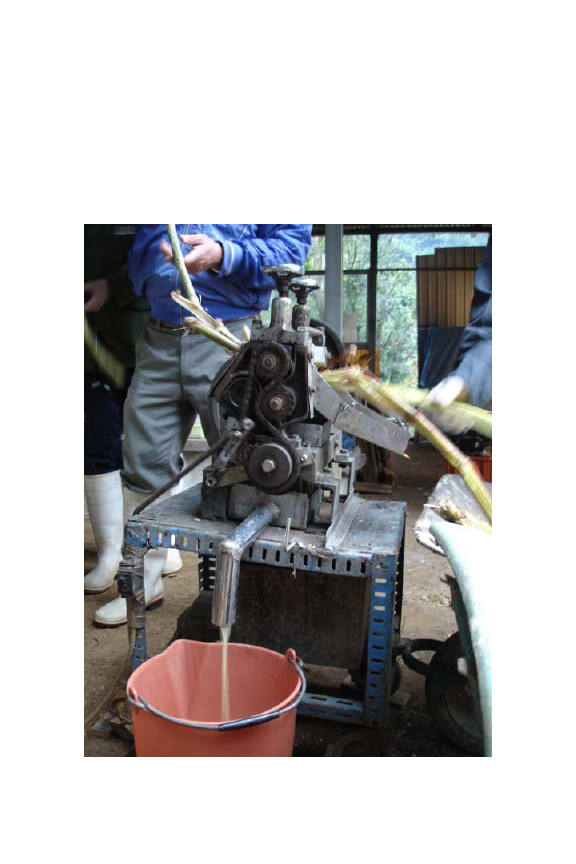
Footprints in Paradise
the stalks jammed in the jaws of the machine, but this was easily fixed by a
little reverse heave-ho. My eyes traced the only visible power cord to a small
generator that appeared to be connected to the truck’s engine. Curious, I
asked whether this was the “old-fashioned” way of pressing cane juice (see
Figure 2.6); Arasato smiled and retorted that the truly old-fashioned method
involved a cow pushing a cart in a circle.
FIGURE 2.6 • Agrotourists Operate Sugarcane Press, Itoman
48
This open access library edition is supported by Knowledge Unlatched. Not for resale.

Slow Vulnerability in Okinawa
After we had filled two large jugs with the dark amber-colored liquid,
Arasato led us into his shed, where he had stoked a small fire. We sat on
tree stumps encircling the fire pit while he served us hot black tea from a
thermos. One of the other volunteers had washed some fresh potatoes and
put them in a vat to boil. We munched on the hot potatoes sprinkled with
Okinawan salt and chatted about the freezing weather, which was roughly
10° Celsius that day (50° Fahrenheit).
During a lull in conversation, I asked Arasato what he thought about the
future of farm tourism on the island. He told me about his plan to begin host-
ing student groups over the next three years, predicting that a mixture of tradi-
tional farming and agrotourism (known in other parts of Japan since the 1970s
and 1980s by the village revitalization catchphrase “Nōgyō to Kankō” or “Agri-
culture and Tourism” [Moon 1997: 221]) would be the most viable option in
the future. I handed him my business card and invited him to email me with
any upcoming farming volunteer opportunities. “Yes, my daughter has been
meaning to set up my computer …” he replied. I apologized, embarrassed, and
pointed to my phone number instead. He sent me home with a recycled PET
bottle full of the raw juice and reminded me to boil it first before drinking.
Becoming “Sugar Islands”
To understand the Japanese government’s increased attention to snakebites
in the early twentieth century (and hence the introduction of the mongoose
as one possible solution to the problem), we must turn the clock back even
further. Okinawa’s history of agricultural development in the context of col-
onization is crucial to understanding the changes that led farmers to spend
substantially more time working in rapidly expanding, rodent-ridden cane
fields and being bitten by habu.
Sugarcane (satōkibi) was never grown on a large scale for local consump-
tion. The traditional Okinawan diet is based on sweet potatoes (rather than
rice), which were first introduced from China’s Fukien Province around
1605 (Kerr 1958: 560). Sugarcane was cultivated in Okinawa long before
more advanced production technology was introduced in 1623, but it was
typically consumed raw or ground and boiled into a syrupy sweet liquid.
The Japanese government formally annexed the Ryukyu Islands in 1872,
but Okinawa Prefecture was not established until 1879. What was Okinawa
like before it became a formal colony of Japan? One traveler’s romantic mid
nineteenth-century account reads as follows:
The prospect, as ships near the land in approaching the harbor of Napha [Naha],
is beautiful. From the beach to the summit of the long and gently ascending
49
This open access library edition is supported by Knowledge Unlatched. Not for resale.

Footprints in Paradise
slope, nearly the whole surface seems to be in the highest state of cultivation. The
different shades of green presented by the different winter crops; the uniform, ter-
raced hills; the groves to relieve the uniformity of cultivated fields, and on the dis-
tant and even line of the summit of the ridge, the peculiar pines, with their limbless
trunks and flat, broad, spreading tops, under which the deep-blue sky is seen, all
conspire to form a most rich and highly cultivated rural landscape. (Gast 1945: 19)
This excerpt comes from agriculturalist James Morrow’s “Report Made to
Commodore Perry on the Agriculture of Lew Chew” (7 February 1854)
for the 1853 United States Japan Expedition.14 Morrow’s rendering of mid-
nineteenth-century Okinawa suggests an agricultural abundance: “Every foot
of ground appears to be carefully cultivated, unless from situation or barren-
ness cultivation would be unprofitable” (19). In addition to sugar, his report
describes beans, rice, and patches of red and white sweet potatoes that “meet
the eye in every direction” (20).
Historian George Kerr’s (1958: 402) depiction of Okinawa in the 1880s
paints a much less paradisiacal portrait of the island: “Okinawa had no po-
tential wealth to exploit, and Tokyo did not have surplus wealth to invest in a
profitless regional economy.”15 Japan’s policies toward Okinawa differed from
those regarding Hokkaido (another recently annexed island in the north-
ernmost part of Japan), where abundant forests, fisheries, and mines drew
greater administrative and financial investment. Kerr describes Okinawa as
“of secondary importance, merely an economically unrewarding territorial
link between Japan proper and the new ‘treasure island’ [Taiwan]” (423),
which Japan acquired following the Sino-Japanese War in 1895. Lacking
any “material assets of value” (402), late nineteenth-century Okinawa was
viewed by Tokyo as an underutilized landscape in need of development.
Neither Morrow’s nor Kerr’s representation of Okinawa is sufficiently
complex, but together they offer opposing perspectives that shed light on
Okinawa’s transition from a semi-independent Ryukyu Kingdom to a “prof-
itless” colony of Japan in the decades following Perry’s 1854 visit. Once a
part of the Japanese Empire, Okinawa came to be viewed as lacking in com-
parison to a much larger colonial sphere that grew to include Taiwan (1895),
Korea (1910), Manchuria (1931), and beyond.
In Okinawa, sugar was deemed the most profitable product for main-
land Japanese brokers and shippers. Between 1890 and 1910 the Ministry of
Agriculture organized administrative agencies such as the Okinawa Prefec-
tural Sugar Improvement Bureau to transform the modes of production and
monitor the quality of the product (Kerr 1958: 431). This attracted further
investment from capitalists in Osaka and Tokyo, as well as government sup-
port for experimental farms designed to increase Okinawa’s competitiveness
in a growing global market.
50
This open access library edition is supported by Knowledge Unlatched. Not for resale.

Slow Vulnerability in Okinawa
By 1915, all the assets of the Sugar Improvement Bureau were controlled
by the Okinawa Sugar Company, followed by the even larger and more pow-
erful Taiwan Sugar Corporation, whose principal shareholders included Ja-
pan’s imperial household and the Mitsui and Mitsubishi corporations (432).
Thusly, Kerr writes, “control of Okinawa’s basic agricultural industry passed
entirely out of Okinawan hands.” As the bulk of profits derived from Oki-
nawan sugarcane boomeranged back to the mainland, a high percentage of
Okinawa’s farming population “became entirely dependent upon the metro-
politan markets, which left them extremely vulnerable to price fluctuations
caused by conditions in Formosa [Taiwan] or in Japan proper” (431). The
rapid expansion of the Okinawan sugar industry produced an insidious form
of economic vulnerability.
Historian Wendy Matsumura (2007: 39) describes this shift through bi-
ography, drawing on the firsthand observations of Noboru Jahana, a bureau-
crat who, as one of the first Okinawan students sent to be educated in Tokyo,
became an intellectual export. When Jahana returned to Okinawa in 1891:
He observed that the poor peasantry, who depended on sweet potato for their
food source, was being pushed to the brink of starvation because they had no
energy or land left over to grow their food supply after converting most of their
lands into sugar cane fields. As a response to the twofold problem of decreased
self-sufficiency and increased indebtedness that emerged from the conversion of
lands to sugar cane fields, [he] proposed encouraging higher yield planting and
manufacture methods rather than increasing the total area over which cane is
cultivated. (Matsumura 2007: 154)
Instead of expansion of the acreage devoted to cane cultivation, Jahana en-
couraged the production of new technologies that would increase overall
yield through improved planting and manufacture methods. Jahana recog-
nized what Matsumura describes as the peasantry’s “vulnerability to starva-
tion” (154), and advocated for more balanced crop production.
Okinawa’s economic vulnerability was both created and maintained
through Japan’s colonial influence. Writing in 1933, economic geographer
Yukuo Uyehara characterizes Okinawa’s sugarcane production as inferior to
that in places such as Cuba and Hawaii, where the plantation system of agricul-
ture was better established. In the early 1930s, Okinawa had only five of the
smoky sugar refineries described by Jahana in the previous excerpt. Uyehara
describes the “very primitive” modes of labor in Okinawan “home factories”
(1933: 403), some of which I witnessed during my time as an agrotourist:
These fields are operated by the families in a way similar to that of the rice fields
of the mainland. The men cut the cane and carry it back to the homes on horse-
back, by hand, or on wagons. On the farmsteads are compressing machines into
51
This open access library edition is supported by Knowledge Unlatched. Not for resale.

Footprints in Paradise
which two or three women, sitting on either side of each machine, feed the cane.
Compressed juice is then boiled in big pots to black sugar, which is the last stage
of nearly all Okinawa sugar. (Uyehara 1933: 400)
This passage from Uyehara’s account of the Ryukyus was written to empha-
size that “urgent attention” (403) was needed to improve refining methods
in order to raise the income of farmers.
With the influx of Japanese manufactured goods and the rising urban
standard of living, the island’s traditional system of bartering for items such
as foodstuffs for handicrafts began to give way to a currency-based economy
(Kerr 1958: 404). Okinawans were compelled to engage in sugar production
because they now had to produce foodstuffs and textiles for themselves and
“enough in addition to pay for the new things which they now believed to
be necessities.” Perhaps most vulnerabilizing, villagers struggled to maintain
the self-sufficient communal landholding arrangements that had supported
farming for centuries.
Another form of instability derived from changing consumer tastes. The
national demand for sugar shifted from brown to white, and by the 1920s,
large capital-backed sugar factories linked to refineries on the mainland had
become “major intrusions to the existing landscape of Okinawa” (Matsu-
mura 2007: 154). Matsumura depicts these factories, “whose black smoke
filled the island’s skies,” as “unnerving contrasts to the 3,000 or so small brown
sugar manufacture huts littered throughout Okinawa’s countryside” (301).
The growth of these kinds of commercial-scale refineries further reduced
farmers’ home cultivation of sweet potatoes in favor of the more profitable
work of supplying sugarcane to factories. The state’s sugar-centered policies,
particularly during the early Taisho period (1912–1926), precluded the kind
of balanced economy that Jahana envisioned.
By the outbreak of World War I, Okinawa had become a “monocultural
producer of a global commodity” (304) and was intricately connected to
Imperial Japan and the larger world economy.16 The limited global supply of
sugar ensuing from the destruction of Europe’s beet-sugar factories during
the war precipitated the ‘“golden years of Okinawa’s brown sugar industry’
[between 1918 and 1919]” (304), but the 1920 Tokyo Stock Market collapse
devastated what was by then Okinawa’s primary export commodity just as
suddenly. In 1926, sugar was valued at 22% or ¥11,000,000 (approximately
$130,000) of the value of all island products and constituted 59% of total
exports (Uyehara 1933: 400).
The transformation of sugar from an exotic foreign luxury into a basic
necessity of daily life was part of a much larger global trend that began in
Europe and the Americas in the mid-seventeenth century. Sidney Mintz’s
(1985: 197) trailblazing analysis of the relationship between the commod-
52
This open access library edition is supported by Knowledge Unlatched. Not for resale.

Slow Vulnerability in Okinawa
ification of sugar and the history of capitalism and industry in Europe and
the Americas traces a growing consumer dependence on “sweetness” during
this period: “From 1880 until the onset of World War I—the period when
sugar production was technically modernized—the production of centrifu-
gal (‘modern’) sugar rose to more than sixteen million tons.” Between 1900
and 1970, global sugar production increased somewhere between 500 and
800 percent (197).
Celia Lowe (2006: 21) identifies the “archaeological shift in the milieu
of reason” that occurred when, at the turn of the nineteenth century, Eu-
ropean colonial projects shifted from primarily “extractive trade practices”
such as the sugar trade, toward a larger project of governing, educating, and
“advancing” colonial populations. In Okinawa, the extraction of sugar grew
into a kind of “civilizing mission” with the Imperial Japanese (and later U.S.)
government’s investment in pest control. The deep connections between sci-
ence, public health, and animal control continue to intersect in the bodies
of hunted habu, but today are more visible in the form of the “Mongoose
Busters.”
Matsumura (2007: 309) details the history of sugar production and
economic crisis in Okinawa in terms of a “broader crises of politics and
existence” that occurred with the islands’ transformation from a semiauton-
omous kingdom into a prefecture of Japan. Through the development of
the sugar industry on the islands, political colonization became economic
colonization (Kerr 1958: 432); moreover, I argue that this agricultural shift
produced a form of environmental colonization. The Japanese state’s sug-
ar-producing imperative permanently altered the landscape of Okinawa
Island. From 1880 to 1920, the area planted with sugarcane in Okinawa in-
creased more than tenfold. By the early 1930s, 70 percent of Okinawan
farmers were invested in this cash crop (Uyehara 1933: 400), provoking a
crisis of existence not only for both humans and nonhumans. With the help
of the rat-eating and (occasionally) snake-ridding mongoose, sugarcane fields
came to dominate the landscape, and this opportunistic “invader” came to
dominate the “indigenous” kuina and its shrinking habitat.
Multi-species and Multidisciplinary Histories
Scholars have increasingly recognized the need for more integrative research
that explicitly connects social and natural histories. In many respects, the
structure of Clarence Glacken’s 1955 study of human geography in three
Okinawan villages resembles that of a classic anthropological village study.
Glacken’s chapters, all written in the simple present tense, fall under static
headings such as “The Family System,” “Community Life,” “Agriculture,”
53
This open access library edition is supported by Knowledge Unlatched. Not for resale.

Footprints in Paradise
and “Religion.” In a very brief final chapter on “Environmental and Social
Change,” however, Glacken calls for precisely the kind of historiography I
have attempted here: “If these two histories … here artificially divided—
could be written as one, if changes in the physical environment at certain
periods could be correlated with known historical events, much would be
learned … of the relation of a culture to its environment” (1955: 295).
Glacken concludes that “the history of the Okinawan people, like the con-
jectural [early] history of their land use, demonstrates the importance of
culture contact, as a consequence of warlike migrations and invasions or of
peacetime trade and travel, in forming the culture as it appears today” (298).
The anthropocentric notion of “culture contact” (Shostak and Nisa 1981:
346) is enriched by a simultaneous discussion of interspecies physical con-
tact, such as biting, hoeing, chopping, fluttering, clawing, pickling, and
pouncing. Igor Kopytoff (1986: 67) argues that “biographies of things can
make salient what might otherwise remain obscure … in situations of cul-
ture contact, they can show what anthropologists have so often stressed: that
what is significant about the adoption of alien objects—as of alien ideas—is
not the fact that they are adopted, but the way they are culturally redefined
and put to use.” The objectified, alien mongoose scratches its biography onto
the landscape while pressing northward.
Mary Louise Pratt (1991: 34) complicates the notion of “culture contact,”
instead offering “contact zone” as a “term to refer to social spaces where cul-
tures meet, clash, and grapple with each other, often in contexts of highly
asymmetrical relations of power, such as colonialism, slavery, or their after-
maths as they are lived out in many parts of the world today” (see also Pratt
1992). Laura Ogden (2011: 76) expands the “contact zone” into a “space
of knowing,” “where bodies, geographies, biota, and mythologies engage in
overlapping mobilities.”
Stefan Helmreich applies Jean and John Comaroff’s concept of “alien-
nature” (2001) to invasive species, which Helmreich (2009: 17) regards as
“emissaries of … a biotic world of illegitimate, inundating flows called forth
by the shifting and contradictory dynamics of globalizing social forces” such
as the sugar trade. The “alien” mongoose was adopted and commoditized
by Japanese agriculturalists, and put to use in Okinawa for a specific pur-
pose that quickly went awry. The mongoose’s deviation from its intended
use has redefined its material and cultural significance from “pesticide” to
“predator.”
Biologists such as Yamada and Sugimura (2004) document the species
vulnerability that resulted from the 1910 introduction of the small Indian
mongoose in Okinawa. Historians such as Kerr (1958) and Matsumura
(2007) delineate the human experience of economic vulnerability during
the same time period, but little work has been done to explicitly link the
54
This open access library edition is supported by Knowledge Unlatched. Not for resale.

Slow Vulnerability in Okinawa
parallel stories of this protracted yet profound transformation of Okinawa’s
physical environment.
Temporalizing Vulnerability
For those familiar with the trajectory of the World War II Pacific Theater,
“Okinawa” evokes the superlatives of fast violence: the Battle of Okinawa17
(fought early April to mid-June, 1945) is often called the “Typhoon of Steel”
(tetsu no bōfū) in reference to the U.S. assault on the island. This phrase
vividly characterizes the kind of high-speed destruction witnessed by civil-
ians and soldiers through a battle often remembered as the bloodiest in the
Pacific. Somewhere between one-fourth and one-third of the Okinawan
population—at least 100,000 civilians—were killed, as were roughly 60,000
Japanese and 14,000 U.S. soldiers (Allen 2002: 33). This fast-paced devas-
tation also set a slower problem in motion: the postwar U.S. military col-
onization of the main island, by which U.S. bases displaced thousands of
Okinawans and came to occupy more than 20 percent of the land on Oki-
nawa (Gillem 2007). Over time, this loss has “compound[ed] the onslaught”
(Asato 2003: 229) of the original battle.
The “mongoose invasion” of Okinawa and the U.S. Marine Corps inva-
sion both followed a northward route18 that pushed through Japanese defen-
sive lines. I juxtapose these two historical events not to imply that they are
somehow morally equivalent, or similar in terms of the scale of devastation,
but rather to illustrate some of the striking narrative and geographical pat-
terns that emerge when equal attention is given to otherwise incomparable
events. It took eighty years for the mongoose to travel from southern Oki-
nawa to the north, and for an original population of seventeen animals to
expand to roughly 30,000 today. This slow movement with its slow con-
sequences, including the “long dying” (Nixon 2011: 3) of the kuina, rep-
resents what environmental activist and literary critic Rob Nixon calls “slow
violence” for its subtle perniciousness.
This contrasts sharply with the “spectacular time” of the 82-day Battle of
Okinawa in the spring of 1945. Okinawans died at the hands of both mili-
taries, but the Japanese military is notorious in Okinawa for its compulsory,
enforced civilian group suicides and policy of non-surrender despite a losing
battle. This extreme physical violence is linked to the economic violence
of the previous century: in both cases, Okinawan land was viewed by the
Japanese state as exploitable, whether for planting sugarcane or as a proxy
battleground.
Gladys Zabilka (1959: 19), writing on the Ryukyu Islands under U.S. oc-
cupation, characterizes the U.S. military’s efforts after the Battle of Okinawa
55
This open access library edition is supported by Knowledge Unlatched. Not for resale.

Footprints in Paradise
as a “mop-up campaign” that began on 23 June 1945: “Cave positions were
systematically sealed up by flame throwers and demolitions, with hundreds
of Japanese entombed within. Extensive patrolling ferreted out individual Jap-
anese soldiers hiding out in the cane fields and rice paddies. By the end of the
month the mop-up had yielded an estimated total of 8,975 Japanese soldiers
killed, 2,902 military prisoners taken, and 906 labor troops rounded up”
(1959: 20, my emphasis). The United States’ Ryukyus campaign officially
ended on 2 July 1945.
Sugar, war, and furry carnivores come together in brief narrative mo-
ments such as M. D. Morris’s discussion of the uses of prewar Okinawan
sugarcane, all of which was sent to “Japan, the Hungry Ermine”19 (1968:
144): “Japan used the cane to produce commercial alcohol for torpedoes
and engines—war production” (56). Even farms with some access to new
technologies were set back tremendously by the battle. Ross Gast (1945: 14)
describes the majority of Okinawans as “ill-treated and under-paid sugar
cane laborers” in the period leading up to and throughout the war. By the
1950s, not much had improved: Clarence Glacken (1955: 150) finds that
“the old Okinawan method of crushing the cane is used in the northern
village[s] because machinery destroyed in the war has not been replaced.”
The lack of parity between southern and northern Okinawa was determined
more by Japan’s postwar investment strategy than by which region was most
devastated during the battle, and is still evidenced by the advent of nostalgic
agrotourism in the north.
Mapping Tourism
Amid the rubble generated by “two competing cultures” (Zabilka 1959:
3)—Japan and the United States—M. D. Morris (1968: 2) describes Okina-
wa’s postwar landscape as “mountains of systematically stacked steel chemi-
cal drums and wood shipping crates range over square miles of depot areas
fenced in by mesh and barbed wire. Acres of new vehicles sticky with cosmo-
line stand ready to be put into motion in convoy caravans.” As early as 1955,
the Japanese defensive lines from World War II were beginning to translate
into what I call the ecological “beauty lines” that would ultimately determine
the kinds of regional tourism practiced in postwar Okinawa:
The recent war was a powerful agent in changing the physical environment of
Okinawa. In the south the destruction affected the grasses, shrubs, and the trees,
adding to the contrast, which already existed before the war, between the scenery
of the south and of the north. The physical beauty of the mountains, the wooded
hills sloping to the sea, the pleasant commingling of neatly hoed fields, trees, and
56
This open access library edition is supported by Knowledge Unlatched. Not for resale.

Slow Vulnerability in Okinawa
wild-growing shrubs belong to Okinawa north of the Ishikawa-Nakadomari line.
(Glacken 1955: 298)
Roughly 60 percent of Okinawa Prefecture was forested before the war, in-
cluding standing trees and cut areas (Uyehara 1933: 402). Today just 40
percent of the main island of Okinawa is forested, primarily in the north
(Yamada and Sugimura 2004: 118). During the battle, 94% of all build-
ings on Okinawa were also destroyed (Zabilka 1959: 19). Massive postwar
reconstruction made southern Okinawa a locus of stone war memorials and
marble monuments such as the Peace Memorial, while in the north anything
still green and “natural” also became a potential touristic resource.
This ecological, political, and aesthetic borderline has been reinforced by
more recent (and largely unsuccessful) attempts to quarantine the mongoose
in the south by setting traps and building a fence along what has become
known as the Shioya-Taira line. The artificial border formed by the Shioya-
Taira (nicknamed the “S-T line”) runs between the two towns located on
opposite coasts just north of Nago City. The growth of ecotourism in the
north has produced a small-scale economy through which tourists and locals
are introduced to each of the species discussed in this chapter. Yambaru eco-
tourism is itself a creative enterprise built along these beauty lines.
A Kunigami Tourism Association (KUTA) ecotourism promotional book-
let20 I received in 2009 cites one of the few positive environmental effects of
the U.S. military presence in Okinawa: The U.S. Marine Corps Jungle War-
fare Training Center (JWTC, also known as Camp Gonsalves and the North-
ern Training Area) had kept ordinary citizens and non-military researchers
out of large sections of the forest since its creation in 1958. This restriction
left many abundant areas undeveloped and contributed to the relatively late
scientific discovery, and ensuing protection, of the kuina. While most people
were kept out of the Northern Training Area, some animals still managed
to infiltrate the military’s built environment: M.D. Morris (1968: 4) writes
that “nature … is in conflict with progress. The habu, the Ryukyus’ resident
reptile, perhaps a direct descendant of the one that allegedly disrupted the
bliss of Eden, at night often climbs the [U.S. military’s] high-tension towers
and while slithering across the cables, short-circuits a whole community’s
electric power.”21
Continuing the Japanese government’s early twentieth-century attempts
to conquer the habu, USCAR (United States Civil Administration of the
Ryukyu Islands) built a serum-manufacturing habu station on Amami
Ōshima in the early postwar period. In 1951, the station was supplied with
977 habu, many of which came from a special farm in Nago that paid a
bounty of ¥100 (then worth about $.80) for each snake captured (Zabilka
1959: 25). The snakes were “milked” for venom, which was then dehydrated,
57
This open access library edition is supported by Knowledge Unlatched. Not for resale.

Footprints in Paradise
shipped to Japan for processing, and returned to the Ryukyus as bottled
serum (26).
The JWTC, first established as an early Vietnam War counter-guerilla
school, was originally roughly eighty square kilometers in area (see Figure
1.1). About half of this land has gradually been returned to the Japanese gov-
ernment since 1996, through a U.S.-Japanese Special Action Committee on
Okinawa (SACO) agreement intended to reduce the military burden and re-
lease the use of reservoirs that control the flow of drinking water to the south
(MOFA 1996). The control and creation of water (through desalination) is
affected significantly by these kinds of agreements, which in turn make wa-
ter use a top priority in debates over tourism and sustainable development
in Okinawa. The national protected forests that surround tourist-oriented
environmental education centers such as the Forest School (࿐ƖƑ೦) and
forest therapy programs (both discussed in subsequent chapters) were also
returned to the Japanese government beginning in 1996. Following more
than twenty years of negotiations, in late 2016 U.S. Secretary of Defense
Ashton Carter announced that an additional 9,800 acres (roughly forty
square kilometers) of Northern Training Area land would be returned to the
Japanese government by year’s end. While Japan has, in turn, agreed to build
helicopter landing zones and access roads for continued use as U.S. military
training grounds, this agreement marks the greatest land return since Okina-
wa’s 1972 reversion (Browne 2016 n.d.).
Conclusion
Natural disasters do not exist.
—Ilan Kelman, “Natural Disasters Do Not Exist”
Contemporary touristic narratives of environmental vulnerability between
the habu, the mongoose, and the Yambaru kuina have slowly shed the his-
torical context needed to understand broader political and environmental
discourse in Okinawa. Stories center on the current state of these three an-
imals, both naturalizing and occluding the human interventions that first
brought them together. Problems of scale and temporality, of past, present,
and future, shape our interpretations of violence. The relatively unspectac-
ular time of the late nineteenth- and early twentieth-century sugaring of
Okinawa amounts to a form of environmental colonization that began in
southern cane fields but has migrated to northern forests over the course of
the last century.
Following Edward Said, Nixon writes that “struggles over geography are
never reducible to armed struggle but have a profound symbolic and narra-
58
This open access library edition is supported by Knowledge Unlatched. Not for resale.

Slow Vulnerability in Okinawa
tive component as well” (Said 2001, quoted in Nixon 2011: 7). Okinawa’s
slow vulnerabilities are exacerbated by its unstable relationship with the Im-
perial Japanese state and the U.S. military; and through shifting interspecies
dynamics over time. As central actors in this complicated story, the habu,
kuina, and mongoose—along with associated discourses of threat, victim-
hood, cuteness, and nuisance—have been the focus of both science and fable.
The legacy of the Japanese colonial project in Okinawa leading up to
World War II and throughout the postwar U.S. military occupation of the
islands lives on in the forest as much as it does in memorials, museums,
and local memory. The infamous story of ravaging mongoose versus inno-
cent kuina (a battle triangulated by the scary habu) is retold and re-created
through touristic avenues. Yet this story is truncated, because it elides the
larger political picture that unleashed the lesser-known animal invasion of
Okinawa.
Economic and environmental vulnerability in Okinawa cannot be un-
derstood without careful attention to historical detail. In this chapter, I have
responded to Amelia Moore’s (2010: 119) critique of the “vulnerability par-
adigm” that pervades much of the social science literature on small islands.
The environmental history provided in this chapter resists the notion that
small islands have inherently, naturally, structurally, and systemically vulner-
able societies, economies, and environments (Moore 2010: 122; cf. Kelman
2010, 2015). As the Nature Museum epigraph toward the beginning of this
chapter suggests, Yambaru’s “diverse environments” do “change in a variety
of ways,” none of which can be adequately understood without analyzing
how Okinawa’s vulnerabilization by external forces throughout the nine-
teenth- and twentieth-centuries. Colonization and conflict, both fast and
slow, have shaped the archipelago’s political economy and have influenced
the conditions of possibility for natural heritage conservation, as well as the
problems of environmental vulnerability and tourism dependency today.
Notes
1. In the context of animal species identification, endemic means “restricted to a locality or
region.” “Endemic” is similar to “indigenous” or “native,” but the latter two terms imply
that a given species also originated in the place where it is currently found. The habu (pit
viper), for example, is considered “native” to Okinawa but can also be found in Taiwan.
2. In Okinawan, kariyushi means “gift of happiness” or “harmonious with nature.” “Kariy-
ushi Wear” refers to the button-down floral-pattern Hawaiian-style shirts frequently worn
by Okinawan men. Eisaa is a dance performed for ancestral spirits during Obon, the
festival of the dead (Nelson 2008: 20, 191).
3. Not only is it okay—Okinawa Prefecture offers a bounty for both animals.
59
This open access library edition is supported by Knowledge Unlatched. Not for resale.

Footprints in Paradise
4. It is more likely that the rail had multiple names (one possibility is Agachi Kimura) that
varied along with the dialects of the Okinawan language spoken on different parts of the
main island. Nobody eats the rail today. I asked a friend about the name of the “Restau-
rant Kuina” at a tourist rest stop in Kunigami: “Don’t you get it?,” he laughed. “It’s a pun:
“Resutoran Kuina! (literally “Restaurant don’t eat [the kuina]).”
5. Japanese scientific nomenclature always uses the phonetic katakana syllabary to describe
plant and animal species. This is also the syllabary used to demarcate foreign loanwords,
including words from the Okinawan language.
6. Courtesy of Michael Lynch.
7. This term is also developed by Umberto Eco (1986), whose concept of “hyper reality” is
located specifically within the framework of travel. For Eco, the technologically produced
replica is so perfect that it replaces and displaces the original, and displaces the value of its
irreplaceable and authentic uniqueness such that copies live on with a life of their own.
8. Detour Japan is a self-published website that focuses on “selected local issues that can be
shared globally” (n.d.) I cite Mamemachi’s summary of the history of the mongoose not
as a source of historical information (though shared details are correct), but because his
explanation reflects key elements of the dominant narrative I encountered in Okinawa.
9. Examples of unintentional but consequential alien species introductions include the Afri-
canized honeybee in Brazil and Asian carp in the United States.
10. ฿ಖὸ (Tennen kinen butsu), a national designation that translates directly as
“Natural Commemorative Thing,” encompasses unusual or endangered animals, plants,
topographical features, etc. Other Natural Monuments endemic to Okinawa include the
Pryor’s Woodpecker, the Ryukyu Long-Tailed Giant Rat, and the Jambar Long-Armed
Scarab Beetle.
11. See Chapter 1 for an explanation of alternate historical names for “Ryukyu.”
12. In an amusing, if racist, account of his visit, Leavenworth’s Okinawan boy servant foretells
the habu’s eventual touristic transformation from a scientific specimen in a wire cage to a
drinkable commodity in a jar: “After we had looked at the squirming, writhing mass for
some little time and were turning away with loathing, the writer’s ‘boy,’ who had been
observing the reptiles, and wondering why so much trouble should be taken by the man-
agement for the comfort of the beasts, queried: ‘They wantchee eat these?’” (Leavenworth
1905: 45).
13. 100 sen = ¥1.
14. Ross Gast, author of the 1945 wartime informational pamphlet from which Morrow’s
account is excerpted, labels Perry’s expedition as the United States’ “First ‘Invasion’ of
Japan” (Gast 1945: cover page). At the time of its publication, this sensationalized char-
acterization of Perry’s visit would have connected the United States’ impending invasion
of Okinawa to a much longer history of U.S.-Ryukyu contact that was less well known
to Gast’s widespread American and military readership. The timeliness of the pamphlet
is palpable: a last-minute insert reads: “As this booklet is being made ready for the press,
Tokyo reports the invasion of the Kerama Islands off the coast of Okinawa. This move has
not been confirmed by American authorities, although Admiral Chester Nimitz tells of
heavy bombardment of Okinawa by a United States fleet” (1945: 16).
15. Kerr’s Okinawa: The History of an Island People (1958) is still regarded as the most compre-
hensive English-language text on the history of Okinawa (Nelson 2008: 222). For more
recent contributions, see Molasky (1999) and Hook and Siddle (2003).
60
This open access library edition is supported by Knowledge Unlatched. Not for resale.

Slow Vulnerability in Okinawa
16. For a comprehensive history and political economy of sugar cultivation in Okinawa, see
also Matsumura (2015).
17. The Battle of Okinawa is called “Okinawa-sen” in Japanese and “Uchinaa ikusa” in
Okinawan.
18. I have simplified these routes for the purpose of comparison. The mongoose and the U.S.
Army Corps pushed south as well, and some U.S. forces changed directions over the
course of the battle.
19. This is the title of a chapter in Morris’s book Okinawa: A Tiger by the Tail (1968). Writing
during the late U.S. occupation, Morris characterized Okinawa as a “tiger by the tail” for
every foreign invested government, wherein each state strives to “maintain a firm grasp
on a vital situation from which it would truly rather be free” (8). Other chapters written
about Okinawans are “The Gentle People” and “China, the Befuddled Dragon.”
20. This booklet was still being drafted by KUTA during my fieldwork, and the final pub-
lished version does not include any information about the U.S. military. Rather, it empha-
sizes the presence of poisonous snakes and the forest’s inaccessibility to “ordinary people,”
due to its unusually dense growth and humid subtropical climate, as the primary factors in
the survival of Yambaru’s “precious creatures.” The 2008 document draws on information
from an Okinawa Prefectural textbook called “The Untouched Forest” (w൭ƇŮŽƑ
೦xğ㢽䍵㼖).
21. For a parallel tale of snakes’ “power” to alter human and nonhuman uses of the landscape,
see the Epilogue of Laura Ogden’s Swamplife: People, Gators, and Mangroves Entangled in
the Everglades (2011).
61
This open access library edition is supported by Knowledge Unlatched. Not for resale.

Chapter 3
KNOWING AND NOTICING
All knowledge is local, no matter what its pretentions.
—Renato Rosaldo, “A Note on Geertz as a Cultural Essayist”
Local people don’t know, but local people notice.
—Professor Kenji Arasaki
Ecotourism Lecture, 6 January 2011
Introduction
Okinawan scholars, elders, and nature lovers today are self-consciously con-
cerned with the preservation and dissemination of local knowledge.1 Profes-
sor Yokota, an Okinawan scholar who advised me throughout my fieldwork,
refers to this phenomenon as jimotogaku or “placeology”: the study of place,
based on “the principle that knowledge of place equals knowledge of self.”
The question of what constitutes “local” and “knowledge,” and the ongo-
ing negotiation of these intellectual categorizations, are the subjects of this
chapter.
Ethnographic study of ecotourism in Okinawa provides a useful lens
through which to examine discourses of local knowledge production because
ecotourism discourse frequently distinguishes between those who know and
those who don’t know. For example, on every tour there are novice customers
and expert guides (e.g., peace guides at memorials in the south and nature
interpreters in the north). My fieldwork revealed that the “knowers” are not
necessarily local residents and the “non-knowers” are not visiting tourists.
The fluidity of these identity markers and their associated bodies of knowl-
edge in the context of ecotourism, and with respect to the politics of knowl-
edge production more generally, calls into question the place of knowledge
assumed to be local. The shifting positionalities of many of my informants
62
This open access library edition is supported by Knowledge Unlatched. Not for resale.

Knowing and Noticing
blur the classical anthropological distinction between “experience-near” and
“experience-distant” (Geertz 1983) forms of knowledge by shrinking the dis-
tance, both geographic and conceptual, between the experiences of nearby
locals and distant researchers.
In this chapter, I demonstrate the pervasive power of the intellectual
distinction often made between these categories of social actor, despite its
failure to adequately sort the people making the distinction. I analyze how
certain kinds of knowledge about the environment are actively made and
kept local through intentional community engagement, and conclude by
revisiting the local/researcher binary in order to consider the place of local
knowledge within the academy.
When I began my fieldwork, I quickly developed the impression that
those who work in ecotourism wear many different hats. I saw ecotour guides
at Ministry of Environment–sponsored town hall meetings, and once shared
a kayak with the director of the Naha branch of the ministry while on a
community-oriented ecotour of the Gesashi River in Higashi Village. One of
my senior colleagues at the University of the Ryukyus commuted nearly four
hours most days of the week so that she could teach in the Department of
Tourism Sciences while living in Yambaru and keep up her activities with the
Kunigami Tourism Association and the Forest School. Though each business
card I received designated a different occupational title, the collaborations I
witnessed suggest that people’s practical roles and functions in these social
circles were much more nuanced and frequently overlapped.
Two of the most common categorical divisions I encountered were re-
searchers (scientific experts, often from mainland Japan or abroad) and locals
(Okinawans). The following discussion of the intellectuals involved in pro-
moting different aspects of nature-based tourism provides a sense of the in-
tellectual landscape that informs discourses of cultural and natural heritage,
as well as environmental knowledge production in Okinawa. The following
three conversations reveal how the distinction between local and researcher
is problematized by the positionality of the speaker.
Researching Locals
I sat in a white-walled lecture hall at the Okinawa International Center (OIC)
in Urasoe listening to Professor Arasaki discuss the roles of various actors in
Okinawa ecotourism promotion. His lecture was delivered in English to a
group of recently arrived JICA trainees from CARICOM countries includ-
ing St. Lucia, Grenada, and Belize. The twelve trainees all worked for the
tourism industries in their home countries in positions ranging from strate-
gic marketing to parks management.
63
This open access library edition is supported by Knowledge Unlatched. Not for resale.

Footprints in Paradise
In his Powerpoint presentation, Professor Arasaki grouped the key players
as follows: locals/interpreters, travel agents, administrators, and researchers.
His explanation of why researchers are crucial to the development of eco-
tourism in northern Okinawa caught my attention: “Local people don’t
know, but local people notice.” By this he meant, for example, that Oki-
nawans may not historically have known the Yambaru kuina’s biodiversity
significance, “but local people notice”—that is, most people living in Yam-
baru would be able to tell you roughly where to find one or at least pick out
its call amidst the biosymphony of the forest.
Professor Arasaki emphasized the need for collaboration between “notic-
ing” locals and “knowing” researchers who hold critical new and marketable
information about the biodiversity and significance of Okinawa’s semitrop-
ical forests, oceans, and rivers. Ideally, he explained, researchers, whom he
described as academic advisers on local resources and management, would
team up with nature interpreters2 to create the most informative, enjoyable
tours possible. When describing locals, he explained their value by stating
that “they are very near,” as opposed to the others involved. This statement
seems obvious when taken literally, but beyond geographic and physical
closeness, his words also imply a certain psychological and spiritual intimacy
between locals and nature.
Arasaki bridges the role of researcher and local; born and raised in north-
ern Okinawa and educated in Okinawan universities, he became a scholar of
tourism science and frequently presents at academic conferences in mainland
Japan. His professional objectives are to educate groups of foreigners about
Okinawa’s contributions to the practice of ecotourism and to learn about
diverse international sustainable tourism development strategies in turn. In
short, he is a local who both knows and notices.
In a speech at Nago Museum in March 2011, Mr. Yamato, a researcher
and dolphin expert at the museum, made the statement, “We don’t notice
but others notice.” At first glance, these words seem to directly contradict
Professor Arasaki’s characterization of locals. Both men are highly educated
scholars who grew up in Yambaru. By “we don’t notice,” Yamato was lament-
ing his observation that many residents of the area are unaware of the value
of the natural and cultural resources found in their own backyards. In this
case, the “others”—those who do notice—are visitors or outsiders who are
much more likely to remark on the stunning red blossoms of the Deigo tree
(Pinus luchuensis, Indian Coral Bean) or be surprised by the sight of what
they view as the “cute” mongoose dashing across the road in broad daylight.
Like Professor Arasaki’s work on ecotourism, Yamato’s knowledge of dol-
phin hunting, a northern Okinawan practice found only rarely in other parts
of Japan (discussed in Chapter 4), is what constitutes him as a researcher. By
his own definition, his knowing and noticing dolphins, and his formal pub-
64
This open access library edition is supported by Knowledge Unlatched. Not for resale.

Knowing and Noticing
lication of that knowledge in a book on the history of whaling in Okinawa,
make him less local. Both scholars articulated an affective difference between
the environmental sensibilities of a Yambaru resident who has heard of or
seen a plant or animal around town, and one who regards the same biota as
a meaningful cultural or natural resource to be shared with and preserved for
the next generation (and for tourist consumption). Their mutual concern
with identifying who is doing the noticing of these resources reifies the dis-
tinction between local and researcher also problematized by their own mixed
identities.
The Localized Researcher
My experience is different from your experience.
—Dr. Karen Magik, coral activist
Interview, 15 January 2011
Dr. Karen Magik is an American environmental activist, marine biologist,
and self-described “scientific consultant” who lived on Okinawa fighting to
save coral and Fukugi (Garcinia) trees for more than twenty-five years. Magik
is well known throughout the island for her vehement proclamations about
the need to protect Okinawa’s coral reefs. We met on a sunny winter day at
the Churaumi Aquarium, one of Okinawa’s most popular tourist attractions,
where she worked as the only foreign researcher in an office full of mainland
Japanese and Okinawan marine scientists.
We sat on the steps outside the front entrance to absorb the subtle warmth
of the sunshine, and I asked her to tell me more about her lifelong love of
diving. She stated confidently that, when underwater, “My experience is dif-
ferent from your experience.” Magik was referring to hobby and tourist div-
ers in general, but she gave the example of Okinawan divers in Onna-son, a
relatively tough northern village that is home to many underemployed “hoo-
ligans” with bleached blondish hair and even the occasional taboo tattoo. For
these divers, she asserted dismissively, the leisure recreation activity was more
about showing off their new gear than it was about experiencing the wonders
of underwater life “up close and personal.”
Magik did not see all subjective diving experiences as equal. In her view,
her qualifications as a researcher—her formal training and academic ex-
pertise on coral—are what granted her access to this privileged, awestruck
experience of nature. She had lived in Yambaru longer than most of the
local divers had even been alive. She knew where the country back roads
went, where to buy the freshest umibudō (Okinawan seagrapes, also known
as “poor man’s caviar”), and which beaches were least frequented by tourists.
65
This open access library edition is supported by Knowledge Unlatched. Not for resale.

Footprints in Paradise
In many ways, this American researcher was a local. But Magik, who delin-
eated a clear experiential hierarchy in relation to scuba diving, identified two
salient differences between herself and most Okinawan: 1) level of familiarity
with particular forms of scientific knowledge about the natural world and
2) degree of comfort moving in the scholarly communities that generate this
knowledge.
The examples of Arasaki, Yamato, and Magik illustrate the clearly con-
structed yet pervasive distinction between researcher and local in Okinawa.
Each of these informants’ worldviews hinged on their acceptance of this
categorical divide to express his or her viewpoint—despite embodying ele-
ments of both identities. Professor Arasaki constructed his distinction along
a dichotomous scale of awareness of a particular plant’s or animal’s physical
location versus understanding of its global scientific significance. Mr. Yamato
used his knowledge as a researcher to advocate for a grassroots revitalization
of characteristically “local” activities, such as dolphin hunting, for the pur-
pose of maintaining a sense of community pride in the city of Nago. And
finally, Dr. Magik articulated the local/researcher divide in terms of the qual-
ity she attributed to the dive experience.
Locating “Local Knowledge”
In December 2009 I attended a Yuntaku-kai or “community chat” session in
the Hiji neighborhood of Kunigami Village. A Tokyo-based environmental
consulting and research group specializing in environmental impact assess-
ment, environmental surveying, and environmental planning and design
had been hired by the prefectural office of the Ministry of Environment to
coordinate a series of facilitated chats in Yambaru. We met on an unusually
stormy night, and the rain beating against the glass windows of the town hall
gave the otherwise sterile multipurpose room an almost cozy feel.
I sat at a round table with roughly fifteen male retirees and one woman
who had gathered to review a map they had created during a nature walk
that fall. The colorful, hand-drawn map was the size of a large poster and
was taped to a whiteboard at the front of the room. On the map were tacked
cutout images of the plants and animals the group had identified during the
walk. Taketo Tsuchiya, one of the consultants from Tokyo, stood next to the
map and moved the images around as if to complete Nature’s jigsaw puz-
zle. The volunteers directed his placement of each piece as they collectively
re-created memorable sightings from their walk. Once the many hand-drawn
and photographic images of plants and animals were overlaid on the village
map, participants were asked to share what they knew about the ecological
collage. This discussion did not take the form of a question-and-answer ses-
66
This open access library edition is supported by Knowledge Unlatched. Not for resale.
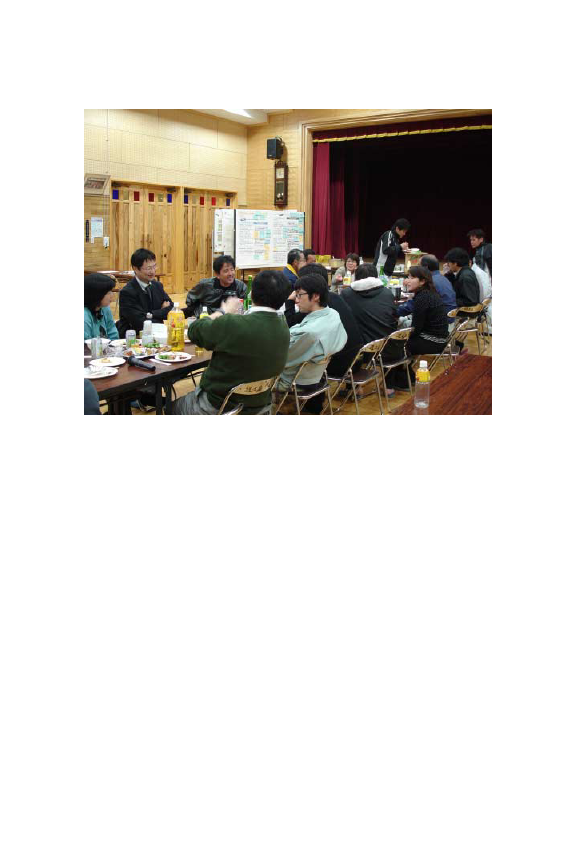
Knowing and Noticing
FIGURE 3.1 • Northern Okinawans Dine and Chat During Community
Gathering, Kunigami
sion between consultant and local; rather, the participants talked freely to
one another by telling stories that inevitably harked back to their youth.
“We used to eat that!”
Over the course of the discussion, one of the most frequently repeated
phrases I heard was, “We used to eat that!” One particularly jovial older man
told a story about pigs: “We used to use their bladders as volleyballs at end-
of-year parties. The only times when anyone could afford meat were big
festivals, Obon3 and the New Year. We didn’t throw anything away! We ate
everything. There wasn’t much to eat, so we ate it all.” Another man re-
counted eating the Ryūkyū Kōmori, a bat so big its English name is “Ryukyu
Flying Fox.” This left everybody rolling in nostalgic laughter.
With these stories emerged a distinct mode of speaking. Many of the
participants used the Okinawan names for the plants, animals, and places
they discussed, such as atemoya (sugar apple) or goya (bitter gourd), and
included specific northern Okinawan dialect variations such as hiitu (short-
finned pilot whale), pronounced “pitu” elsewhere in Okinawa, and Kunjan
67
This open access library edition is supported by Knowledge Unlatched. Not for resale.

Footprints in Paradise
(Kunigami Village). Mr. Tsuchiya wrote frantically on the board to keep
track of the local vocabulary as it emerged, and his boss took backup notes
from the side of the room. The group debated the etymologies and proper
“old-fashioned” usage of these words, and I sensed their bittersweet frustra-
tion over trying to recall parts of a language that they had heard as children
but could not speak as adults. By the end of the session, the walking map was
overwritten with terms from the Yambaru dialect of Okinawan.
As the discussion drew to a close, two participants reflected that the mi-
nutiae of their daily lives today were sometimes difficult to remember—but
the past was very clear. They jokingly attributed this to the aging process, but
in a more serious vein one man added: “This is why it’s especially import-
ant to conduct some kind of oral history with the elders, even if they may
be going senile.” Another man mentioned the recent loss of a particularly
knowledgeable older woman in the community, noting the urgent need for
participants to chat with folks even just ten years older than themselves. He
wanted to keep this natural history alive for tourists, visiting Japanese stu-
dent groups, and especially Okinawan schoolchildren. Just as the group fell
silent in reflection, a man in his sixties pointed to the only forty-something
man in the circle, teasing him: “… because the only thing you’re going to re-
member is video games!” The laughter continued into the night as we dined
on piping hot Okinawan-style oden (a hot pot dish of sweet-salty broth
served with pig’s feet, greens, and chunks of giant white radish, flavored with
spicy American-style mustard) and muuchi (a bright purple yam- or black
sugar-infused Okinawan version of Japanese mochi, pounded glutinous rice
cakes).
The participants’ chat expressed the deep linkages they perceived between
knowledge of place, in the form of local plant and animal identification,
and knowledge of self, through language and history reclaimed. Locals were
tasked with first noticing the details of the natural world around them and
then providing the experiential context that turns these details into legible
cultural knowledge. In many ways, however, the format and framework for
discussion felt imported. During a planning meeting for these sessions, a
Yambaru Wildlife Center employee expressed concern over the number of
English loanwords being used to explain the chatting process to participants
past sixty years of age. Examples of potentially obscure words included: ȅ
✣DžǍǽǙǭ (workshop), ǜ✣Ǵ (theme), ƸƺǝƸ (idea), ljǷȉǞ
(comment), ƸƺǏǬȂƺDž (icebreaker), ǴƺȉǟǴǙǭ (mindmap),
and ǃ✣ȅ✣ǟ (keyword), many of which, she pointed out, had perfectly
good (if less fashionable) Japanese equivalents. The consultants facilitated
the discussion but, as outsiders, were also there to learn. Local knowledge
was reconstituted through conversations and cross-comparison of childhood
memories, but also benefited outside researchers. The deliberate process by
68
This open access library edition is supported by Knowledge Unlatched. Not for resale.

Knowing and Noticing
which this local knowledge is achieved demonstrates how knowledge is kept
local, much as scholarly knowledge is self-consciously produced to address
more “global” concerns.
Chatting for the Future
In March 2011, I attended the fourth and final community chat session in
the series sponsored by the Ministry of Environment. About twenty-five res-
idents of Kunigami County gathered to discuss environmental and commu-
nity health challenges faced by the area. At the top of the list were long-stay
tourist recruitment, youth retention, and employment strategies (discussed
in Chapter 5). Participants were mostly retired men, but there were also a
few women and a few young male public employees.
The approximately three-hour meeting was replete with flow charts, bullet
points, and broad objectives related to community growth and sustainability.
The assembled group was quiet until one man volunteered the words of his
99-year-old neighbor: “To restore the region is to love the region.” Machiko
Kakazu, a Ministry of Environment employee who works at the Ufugi Na-
ture Museum in Kunigami, seamlessly linked community restoration and
tourism by building on his comment: “We must take it as our premise that
we want tourists to come, and we want their presence to turn into work for
the youth.” The retiree nature interpreter who had led me on a Treasure Box4
tour of the Yambaru forest the year before added, “There is something spe-
cial about every place, and I really want this island’s people to learn how to
speak well about its unique traits.” Each of these reflections advocated a sort
of grassroots pro-tourism attitude meant to encourage community members
to know their village as a guide does, and to notice their surroundings as a
tourist does.
Mr. Oku, director of the Naha Division of the Ministry of Environment,
concluded the formal meeting by talking about the importance of imple-
menting environmental regulations in the area: “This is a good place, so
let’s protect it. We should take hold of nature as a resource and use it well.”
He stressed that his purpose was not to push the Ministry of Environment’s
agenda on the area, but rather to listen to the objectives of locals and assist
them in taking action by training guides and making rules. He summarized
three key themes from the meeting as follows: community power, connec-
tions (between rivers, oceans, and mountains), and consensus building.
Afterward I was asked to share my impressions as an outside observer.
I noted politely how passionate everyone seemed to be about serving their
community, but I later admitted privately to Mr. Chinen (director of the
Kunigami Environmental Education Center’s Forest School, also affiliated
69
This open access library edition is supported by Knowledge Unlatched. Not for resale.

Footprints in Paradise
with the Kunigami Tourism Association) that I had not really followed the
flow of the meeting. The first community chat I attended was much more
straightforward in its purpose: to sketch the cultural and natural landscape
of the area by creating a walking map of Hiji Village. Chinen took me aside
and in low tones told me:
In my opinion, here is what’s really going on: one, the town office’s job is to make
money, and two, the Ministry of Environment’s job is to make rules. But no
matter what happens, this village will go on. These people are just trying not to
lose the wisdom of the area. We are doing this to preserve the knowledge (chie wo
nokosu tame ni yatteiru). We have joined up to keep this village going. If you think
of it this way, this meeting becomes much easier to understand.
Soon the traditional Okinawan feast that concluded most community
meetings I attended appeared, and I knew that people’s tongues would loosen
up as they drank beer and awamori. We passed the microphone around the
table as we ate, listening to short speeches, individual reactions to the group
chatting experience, and a few jokes. Among the most poignant of the senti-
ments to emerge from this jovial roundtable were “Of course you go crazy when
you can’t feel nature! (Yappari, shizen ni furenai to atama ga okashikunaru!),”5
“We want to keep the population up! Keep the young people here,” and “Let’s
work to raise up the village, but without destroying nature.” Mr. Teruya,
another Ministry of Environment employee, added, “Most people stay for
just one night … we want six-night stays in Kunigami!” A sixty-something
woman from nearby Sosu Village chimed in: “Please can someone in charge
bring us a bus? There’s no bus between Kunigami and Sosu. We want to im-
prove Sosu, and then visitors can come to Sosu too! It’s an amazing place!”
“Aha also has great views!” someone from Aha echoed. One man likened the
villages in Kunigami area to the contents of Cup Ramen: “Mixing many dif-
ferent ingredients together makes for an interesting place.”
Soon people were laughing loudly and talking amongst themselves, not
pausing to listen to whoever held the microphone. Teruya stood up and
declared, over the hum of eager chatter, “Most people think of ecotourism
as going into the mountains or looking at a Yambaru kuina, but we at the
Ministry of Environment also think about the culture connection. We are
concerned with protecting the environment, and one way to do that is to
keep people out entirely. Another way is to regard nature as a resource, a
tool. Who would destroy their own car? Or house? We must think of nature
in the same way.”
Mr. Chinen spoke next, and gave a direct response to what he called my
“naive question” about the purpose of the gathering. On the subject of not
seeing the “big picture” context for these community meetings, he reflected
that “Eight years ago we began talks about building the Forest School,” and at
70
This open access library edition is supported by Knowledge Unlatched. Not for resale.

Knowing and Noticing
that time a student had asked, ‘Why is nature important?’ Well, in Yambaru,
nature equals culture,” was Chinen’s response. He acknowledged the ups
and downs of the nationwide village revitalization movement (mura okoshi
undō), but added proudly that “there is no minus for the village caused by
the Forest School.” He concluded by calling for a community-based, grass-
roots approach to revitalization: “It’s not the national government, it’s not
the prefectural government—we do it!” Everyone applauded.
Chinen introduced me to Ms. Hamakawa, another mainland Japanese
environmental consultant who had been hired to sit in on the meeting. Ha-
makawa compared Yambaru to the Ogasawara Islands, a UNESCO World
Heritage site6 also combating invasive species. She began speaking in meta-
phor: “There is something in the wind and the waves, the wind is blowing,
you can feel it really strongly, something is lost.” She reached her hand down
in front of her chest as if plumbing her core and said, “We need to pull
this [spirit] out from our DNA, to get back our unique character for all of
Japan.” I encountered the deep feeling that “something is lost” frequently
when speaking with informants over the age of fifty, who tended to frame
their concerns in reference to the health of the ocean.
Hamakawa never used the term “globalization” to describe the regional
and national loss of Japanese character, but she implied that some form of
worldwide phenomenon was to blame for this change. When I went to
ask her more about what she meant by “unique character,” as if on cue,
two young, slightly inebriated town workers interjected with an Okinawan
language lesson for me: “Andii-san, ‘Icharibachoodi!’ Do you know what it
means? ‘Once we’ve met we are siblings.’” In this small moment, through
this small gesture, they fought the loss of an endangered language by invok-
ing the informal friendliness often thought to distinguish Okinawans from
mainland Japanese.
Though I could not follow every discussion, I found the meetings helpful
for conceptualizing the formalized spaces through which residents of Yam-
baru come together to tackle social and environmental problems in their
communities. Chinen’s explanation of the gathering led me to conclude that
simply assembling a group of concerned citizens and engaging them in con-
versation, argument, and laughter with one another was just as vital to keep-
ing the village going as any consensus-based grand conclusion or resolution
that might result from the meeting.
Meta-anthropology
Is local knowledge production simply a matter of collecting new and old
things? By what process does noticing become knowing, and who benefits
71
This open access library edition is supported by Knowledge Unlatched. Not for resale.

Footprints in Paradise
from the production of this knowledge? I ask these questions of myself as an
outside researcher and of my local informants, who further complicated these
social and political categories for me when I noticed them doing my job.
Mr. Yamato invited me to attend what I thought would be a nature walk
through the neighborhoods of Nago City. I turned up at the Nago Museum
on a Wednesday afternoon in March wearing my yoga pants and a pair of
hiking boots. I was ready to experience nature. I entered the lecture hall
where everyone was gathering to find neatly ordered rows of chairs filled pri-
marily by older men, a few women, and a few younger males dressed in the
light green jumpsuits worn by city workers. Everyone faced forward, glued
to a Powerpoint projection at the front of the room that read “Everyone
Learns Together in Nago.” Four well-dressed men from the Yambaru villages
of Ginoza, Higashi, Oku, and Nakijin sat in the front row, going over their
presentation notes.
The meeting was not a walk, it turned out, but a summary review of
the last two community walks that had been organized by the museum.
We began with a silent prayer for the victims of what would soon come to
be known as the Great East Japan Earthquake Disaster,7 which had struck
just a few days before on 11 March 2011. Before the prayer, the organizer
added that in addition to the tremendous loss of human life, many precious
historical archives had been washed away by the tsunami that followed the
earthquake in northeastern Japan.
The first presenter opened by asking, “How should we understand this
vast Yambaru? Even in our own heads, there are many different ways to
think about the area.” This question was surprisingly similar to the one I
was formulating: “How do they understand this vast Yambaru? Even in their
own heads, there are many different ways.” Strange as it felt to become just
one more brain in a room full of placeologists, I was relieved to be in good
company.
The neighborhood walking project had been conceived as a grassroots
experiment to determine the “scenery we want to pass on 100 years from
now,” as well as an opportunity to educate local youth who “don’t notice”
the intrinsic or touristic value of their surroundings (although Yamato noted
that it was primarily retirees in their fifties and sixties who participated in
these kinds of museum events). Volunteer walkers were asked to identify
and record the presence of buildings, rocks, and other natural things in their
respective villages. Charming historic sites were not the only places of inter-
est; as if in disbelief, one walk leader asked his group, “What is this building
doing here?” He pointed toward a new and controversial chain mall just
completed in Nago.
In a play on words, these walks were cleverly referred to as “Aruki,” which
means both “to walk” and “to write something down.”8 Participants were
72
This open access library edition is supported by Knowledge Unlatched. Not for resale.

Knowing and Noticing
encouraged to record the stories of older residents and to borrow the black
and white photographs they encountered along the way. They were further
asked to determine the types of resources they found and to report back to
the museum. The walls of the lecture hall where we sat were covered with
these old photographs, alongside photographs of the walk itself. Gazing at
the collection, one late middle-aged participant commented wistfully, “All I
can say is I’m feeling nostalgic.”
The methods of inquiry the village walkers described are familiar to any
social anthropologist: circle the village, borrow the photo albums of people
living in the area, and actually go to the place and walk around. One pre-
senter even used an English loanword, calling what they were doing “Fiiru-
dowaaku” (fieldwork). Clifford Geertz (1983: 167) has called ethnography
a “to-know-a-city-is-to-know-its-streets approach to things,” and my infor-
mants had embraced this technique. I suddenly found myself tasked with
constructing a story about people constructing stories about themselves.
During his summary presentation, the Ginoza Village Museum repre-
sentative stood and remarked, “We’re working to train the imaginations of
participants in the walks so they can effectively show how things used to be
here.” “We discovered that the resources of this region are still asleep,” the
representative from Oku Village added. One of the key concerns voiced was
that, in as few as ten to fifteen years, the things they had discovered might no
longer be there. One woman suggested transferring their findings to a DVD
that also documented their methods, in addition to putting their walking
data on the town website as a form of living history. This comment sparked
a collective brainstorm that erupted into debate over how to involve more
young people: “They use computers, and could listen to the older people’s
stories while also teaching them how to use the computer,” another woman
offered. Those present agreed that it would be a good chance to share infor-
mation between different generations who might not otherwise communi-
cate about the past.
A second objective of the walks was to connect Yambaru’s village museums
with a broader audience. Yamato reminded everyone that the self-selected
group in the room, which included faithful museumgoers and a number of
academics, was not typical with respect to its level of concern for and interest
in cultural and natural preservation. With this sobering comment, the two
hours allotted for formal presentation and discussion were up, and we began
rearranging the chairs and tables to allow for the much-anticipated banquet.
In a matter of minutes, and with the help of awamori and Orion Beer,
the mood in the room shifted from quiet and contemplative into jovial and
joking. As I munched on boiled leeks and juushii fried rice balls mixed with
boiled vegetables, a young female museum intern sat down beside me and
asked me, “What’s the difference between a museum and a vegetable stand?”
73
This open access library edition is supported by Knowledge Unlatched. Not for resale.

Footprints in Paradise
I thought perhaps this was the beginning of a bad joke, but she was suddenly
very serious and concerned: “Whether they sell things, and freshness! What
do you want to do now? What do you want to know now?” She called Jap-
anese museums “stoic,” and praised American museums for doing a much
better job of appealing to a broad range of people, especially children, and
for being interactive.
Yamato asked me to introduce myself to the group, and when I men-
tioned that I was studying ecotourism the conversation quickly turned to a
discussion of tourism and museums. One Nago resident argued that, unlike
the typical mass tourism scene in the south (he was alluding to Naha and
the southern World War II memorial circuit), “Yambaru still has a lot of
potential for development.” Yamato quickly interjected: “Yes, but if you do
not have a purpose, things become unclear. This purpose is jumpstarting
tourism as a resource. We must connect with tourism, but our research, our
work must come first. Otherwise, we have nothing to share.”
Walking as Knowing
Movement … is not adjunct to knowledge …
Rather, the movement of walking is itself a way of knowing.
—Tim Ingold and Jo Lee Vergunst, Ways of Walking
Aruki memory walks make strange the familiar by mobilizing village walk-
ers to notice things new, old, and different about their home place. Tim
Ingold and Jo Lee Vergunst (2008: 2) argue that a way of walking “does
not merely express thoughts and feelings that have already been imparted
through an education in cultural precepts and proprieties. It is itself a way of
thinking and of feeling, through which, in the practice of pedestrian move-
ment, these cultural forms are continually generated.” Hayden Lorimer and
Katrin Lund (2008: 186) similarly emphasize walking as a form of social
encounter, a “complex weave where collecting happens on foot in the midst
of epistemic ambition, and emotional and embodied response.” For my
informants, as for these anthropologists, walking is a profoundly creative
and social activity.
Aruki village walkers strive to know their own ordinary surroundings by
noticing new things amidst an everyday perspective. These walkers collect
experiences, memories, and material objects through dynamic movements
specific to a particular time and place. By placing them in the role of student,
Aruki walks and community chats encourage Okinawans to view their own
everyday environment like a tourist and, in many ways, like an ethnographer.
74
This open access library edition is supported by Knowledge Unlatched. Not for resale.

Knowing and Noticing
Localizing Scholarly Knowledge
Scholarly language can become so local (i.e., specialized) as to require trans-
lation across disciplines. Clifford Geertz describes ethnography as a “craft of
place” that “work[s] by the light of local knowledge” (1983: 167). If, as Re-
nato Rosaldo (1997) claims in an interpretation of Geertz’s work on cultural
interpretation (an intensely local intellectual engagement), all knowledge is
local, then under what pretense can the researcher’s “etic” interpretation be
integrated with the local’s “emic” experience?9 As discussed earlier in this
chapter: What happens when the researcher is also a member of the commu-
nity s/he is studying? (cf. Abu-Lughod 1986). Perhaps less commonly, what
can we learn about ethnography from a local researcher who is pursuing a
parallel endeavor by practicing a comparable methodology? Geertz likens
“Being There” to a “postcard experience,” but adds that it is “Being Here,
a scholar among scholars, that gets your anthropology read” (Geertz 1988:
130). How do I localize my fieldwork knowledge for you, my scholarly au-
dience? Can I simply circle the library and re-tell the inside jokes of theory?
Or is it all just turtles back and forth?10
Identifying experience-near versus experience-distant11 forms of knowl-
edge is as much a question of locating or grounding different perspectives as
it is of distinguishing between subjective phenomena (i.e., love, illness) and
theorized abstraction (i.e., object cathexis, disease). The scholarly experience
of theorizing a social phenomenon also demands an ethnographic context.
In Local Knowledge, Geertz (1983: 16) writes that it is from “seeing ourselves
amongst others, as a local example of the forms human life has locally taken,
a case among cases, a world among worlds, that the largeness of mind, with-
out which objectivity is self-congratulation and tolerance a sham, comes. If
interpretive anthropology has any general office in the world it is to keep
re-teaching this fugitive truth.” The dual positionalities of Professor Arasaki,
Mr. Yamato, and Dr. Magik can be reconciled if we consider them local ex-
amples of the forms scholarship has locally taken (and by “we” I mean myself
and my imagined community of scholarly readers).
Part of my interest in the politics of place-based knowledge production
in Okinawa derives from my anxieties over placing the universally particu-
larized forms of knowledge produced by anthropologists. I bring this dis-
cussion to bear on the community practices I observed during fieldwork
in order to attempt Geertz’s call for a “largeness of mind” (1983), without
which the limits of locality might evade reflexive interrogation. Historian
Robert Kohler (2006, quoted in Ogden 2011: 112) develops the term “resi-
dential knowledge” to distinguish between the “global” and “particularistic”
forms of knowledge that tend to dominate scientistic and rationalized global
75
This open access library edition is supported by Knowledge Unlatched. Not for resale.

Footprints in Paradise
discourses of natural history. Residential knowledge creates a space for an
“experiential epistemology” that diverges from scientists’ theory-producing
knowledge because it can come only from “living in a place”—from “living
there.” Ethnographic research, I learned, is not the exclusive purview of the
anthropologist; communities can conduct fieldwork that integrates globaliz-
ing themes of cultural and biological diversity. Even the most universalizing
theory has its place.
Conclusion
In this chapter, I have problematized a dominant discourse that informs
ecotourism development in Okinawa: that local knowledge is the domain of
locals who depend on outside researchers for the verification and valuation
of this knowledge in a more global context. Following Celia Lowe (2006:
162), I have tried to avoid the temptation to “read nature and identity as a
determining relationship … or as a carceral relationship, for example in the
figure of the ‘local person.’” I have also tried to transcend the value-laden
poles of “science” and “indigenous knowledge” (Walley 2002) by presenting
figures who occupy both spheres of thought. Lowe (2006: 163) explains
that her informants’ “nature-making” means “tracking emergent rationalities
and practices of thought rather than codes found in the mind.” I muddle
the binaries of local/non-local, knower/non-knower in a similar fashion by
illustrating, from the ground up, the intentional (re)production of these cat-
egorical identities and their associated bodies of knowledge.
Sustainable development specialist Tighe Geoghegan’s analysis of commu-
nity-based resource management discourse offers an important critique of the
practices of consulting firms and governing institutions such as the Ministry
of Environment. Geoghegan sees a danger in importing outside concepts
designed to enhance a community’s capacity for certain forms of tourism
development: these models further a misleading discourse of the “global en-
vironment”—a world in which “all people have a right to participate in deci-
sions about the future of the world’s natural patrimony” (Geoghegan 2013:
115). Even models designed to increase stakeholder participation, such as
the community chats, risk weakening stakeholders’ voices by undermining
informal networks in favor of new and less effective participatory organiza-
tions (128). While such possible outcomes must be considered, my findings
suggest that the community and development models put forth by consul-
tants and Japanese government officials resonated with Okinawan partici-
pants’ familiar cultural and commensal practices. Chatters and walkers in
Yambaru exercised their agency by personalizing prescribed activities with
enthusiasm and a sense of community and personal empowerment.
76
This open access library edition is supported by Knowledge Unlatched. Not for resale.

Knowing and Noticing
Geertz (1983: 58) writes that “the ethnographer does not, and … largely
cannot, perceive what his informants perceive. What he perceives, and
that uncertainly enough, is what they perceive ‘with’—or ‘by means of,’ or
‘through’ … or whatever the word should be.” By examining the commu-
nity processes through which local knowledge is aggregated, I have shown
how many Okinawans’ self-understanding is shaped (at least in part) by the
tourism imperative.
Existentialist Michael Jackson (1998) compares the act of ‘“storying”’
(chatting) to ‘“journeying”’ (walking), suggesting that, while storytelling is
motivated by “self-expression,” stories are by definition “relational” and inter-
subjective (Jackson 1998, quoted in Skinner 2012: 14). Self-understanding
in Yambaru is cultivated through performative acts of chatting and walking.
Placeology in Okinawa is practiced through facilitated engagement with the
natural environment, rather than by less fluid factors such as geographic
proximity, ethnic background, or educational level. In the next chapter, I ex-
plore the problem of creating and negotiating interspecies intimacy through
touristic forms of engagement with nature.
Notes
1. “Local knowledge” was most commonly referred to as “local information” (jimoto no chi-
shiki) or “local wisdom” (jimoto no chie).
2. For further discussion of nature interpreters, see Chapter 5.
3. Obon is a Buddhist All Souls Day during which families reunite to honor departed ances-
tors. Throughout Japan it is generally celebrated for three days in mid-August based on the
solar calendar. Okinawans follow the lunar calendar, so their festivities fall at a different
time each year.
4. For a description of this community-based ecotour, see Chapter 5.
5. For further discussion of the human need for nature, see the section “Biophilia” in Chap-
ter 5.
6. As of late 2016, Japan’s Ministry of Environment is in the process of registering Yambaru
as a UNESCO World Heritage site for natural assets. By 2018, the 17,300-hectare na-
tional park should be able to enforce a 790-hectare special protection zone banning plant
and animal collection, along with a 4,402-hectare special zone free of building develop-
ment (Jiji 2016).
7. In Japanese, the 2011 triple disaster (which included an unprecedented 9.1 magnitude
earthquake, tsunami, and nuclear reactor emergency) is referred to as ỌКֹٚ
လ㢽ֹᆑ (Tōhoku-chihō Taiheiyō Oki Jishin). Approximately 20,000 people were killed
(CNN 2016).
8. In Japanese, 㠜Ű (aruki) “to walk,” becomes ťƮὸ (also pronounced aruki) “to write
something down.” These guided walks are reminiscent of the 1980s student peace educa-
tion program outlined in an alternative tour book for bases and battlefields called Aruku,
miru, kangaeru Okinawa (“Okinawa to Walk, Look At, and Think About” (Figal 2012:
77
This open access library edition is supported by Knowledge Unlatched. Not for resale.

Footprints in Paradise
72). This book, authored by the Okinawa High School Teachers’ Union and the Peace
Education Research Committee, was designed for mainland Japanese students on what
are now extremely popular, largely standardized school field trips known as ‘“peace study
field trips”’ (heiwa gakushū). Other common destinations include the sites of the World
War II U.S. atomic bombings, Hiroshima and Nagasaki.
9. These anthropological concepts have also been construed as inside/outside, first person/
third person, phenomenological/objectivist, and cognitive/behavioral (Geertz 1983: 56).
10. Of course, Geertz’s (1973: 29) original allusion to the interpretation of cultures is that it
is turtles “all the way down.” Here I change directionality to avoid implying a hierarchical
relationship among emic and etic forms of knowledge, whose differences are not meant to
be “normative” in the field of anthropology (Geertz 1983: 57).
11. Geertz adopts psychoanalyst Heinz Kohut (1971) terms, “experience-near” and “ex-
perience-distant,” when he writes: “An experience-near concept is, roughly, one that
someone—a patient, a subject, in our case an informant—might himself naturally and
effortlessly use to define what he or his fellows see, feel, think, imagine, and so on, and
which he would readily understand when similarly applied by others. An experience-
distant concept is one that specialists of one sort or another—an analyst, an experimenter,
an ethnographer, even a priest or an ideologist—employ to forward their scientific, philo-
sophical, or practical aims” (Geertz 1983: 56).
78
This open access library edition is supported by Knowledge Unlatched. Not for resale.

Chapter 4
ECOLOGIES OF NEARNESS
Touch ramifies and shapes accountability. Accountability, caring for,
being affected, and entering into responsibility are not ethical abstractions;
these mundane, prosaic things are the result of having truck with each
other. … Touch, regard, looking back, becoming with—all these make
us responsible in unpredictable ways for which worlds take shape. …
Touch and regard have consequences.
—Donna Haraway, When Species Meet
Introduction
The question of propriety in interspecies nearness pervades ecotourism dis-
course: How close should we get to animals? How close can we get to nature?
How close are we already? This chapter examines tourist and volunteer activ-
ities designed to facilitate human nearness to a diversity of marine life to ask
how interspecies affective relationships are cultivated through the slippery
phenomenological moments we sometimes call “experience.” Sometimes the
quest for remarkable experiences entails traveling great distances: Much like
humpback whales, tourists from the north migrate south to warmer climes
in December and January. The opportunity to watch whales breeding in
their natural environment is a seasonal delight available to any ecotourist
with seeing eyes and access to Dramamine. Swimming with dolphins, while
controversial, gets us even closer because we can watch, touch, feel, and even
kiss them, all from the comfort of a human-scale swimming pool. Coral
transplanting, on the other hand, is a much more involved activity that takes
us out of our terrestrial habitat and plunges us into theirs. The practice is
meant to attract the “ethical tourist,” someone who volunteers (and in many
cases pays) for the chance to see and touch coral, to transplant new life, and
to learn the realities of coral degradation by getting up close and person-
alizing reefs.
79
This open access library edition is supported by Knowledge Unlatched. Not for resale.

Footprints in Paradise
Nearness is not only a problem of achieving physical proximity to an-
other being. As I discussed in Chapter 3, for humans getting close and “be-
ing there” (Geertz 1988) entails a psychological, affective, sometimes even
spiritual engagement with other life forms. Nature-based tours gain mean-
ing through the anthropomorphism of animals, and by offering interspe-
cies contact predicated on the delicate negotiation of looking, feeling, and
touching for experience.
Proximities of Nearness
In 1998, a group of visitors to Okinawa climbed and clustered around a
giant looking glass tree (an evergreen mangrove with an umbrella-shaped
crown and above-ground roots that radiate from its base like wooden rib-
bons). Tourists wrapped themselves around the tree, leaning up against it
and feeling its bark with their bare hands. In 2004, a different group stood
near the same tree but were unable to touch it. A small fence had been built
around this “arboreal monument” (Ogden 2011: 108) to protect the tree
from the thousands of tourists who encircle it every year. Professor Arasaki
opened his lecture on ecotourism by comparing photographs of these visits
to illustrate how restrictions on tourist access to Okinawa’s natural beauty
were tightening as the number of annual visitors rose.
Next, Arasaki showed a promotional video about ecotourism in Higashi to
a room full of JICA Sustainable Tourism trainees. The film centered on Keiko,
a Nature interpreter who, like many of the guides I met during fieldwork,
had transplanted herself from mainland Japan to pursue a more meaningful,
“grounded” career. Followed by the camera, she guides two young girls on a
rather tame kayaking trip down the Gesashi River. Upon noticing that the
girls aren’t having much fun, Keiko paddles closer to the shoreline and shows
them how to lean back in their kayaks and glide underneath the mangroves,
leaving only a few inches between their faces and a maze of twisting brown
roots. Soon the girls are giggling and squealing with delight, as intended.
I was once that bored customer, paddling aimlessly down the river until
our guide directed us toward a mangrove and invited us to taste its salty
leaves. Upon closer examination, I could actually see the leaf ’s color grada-
tion change from green to yellow, indicating how far up the saltwater had
been absorbed. It was the taste of the salt that finally alerted my senses and
drew me into the tour experience.
You just read an anecdote describing a lecture that contained photographs
of trees and a filmed clip of an Okinawan ecotour guide trying to bring
her customers closer to nature. Did you feel anything? What was your ex-
perience of mine? Surely the jarring impropriety of a “close-up” paragraph
80
This open access library edition is supported by Knowledge Unlatched. Not for resale.

Ecologies of Nearness
such as this—one in which I, the writer, directly address you, my reader—is
bringing you uncomfortably close to this experience. How close is too close?
How close is close enough?
Experience Near (But Not Too Near)
How do you convince someone that she is affected
by something if she can’t feel it?
How do you teach her how to feel it?
—Dr. Karen Magik,
coral activist
When we watch the whales in action, we are very moved or excited.
—Zamami Whale Watching Association,
English-language brochure
When I met with Karen Magik at the Churaumi Aquarium, one of the first
things she said to me was, “I think the key [to education] is through expe-
rience. People don’t care [about an issue] until it affects them.” She spoke
broadly about public awareness of the many environmental issues faced by
Okinawa: red soil run-off and erosion, ocean pollution, and the loss of bio-
diversity. Her question about how to “feel” a problem rather than simply
studying it or noticing it left me pondering the “world’s largest” circular pane
of curved glass that separates visitors from the enormous whale shark (jinbei-
zame) and manta rays on display at the aquarium. The glass was designed to
enable spectators to get closer to the animals, and to simulate the experience
of aquatic immersion by providing them with panoramic views from above
and below. Of course we could not touch them, but were we close enough
to feel them?
According to marine tourism specialist Carl Cater, no. Cater suggests that
the experientially oriented “new tourist” (see also Krippendorf 1987 and
Poon 1993) seeks a particular form of intimacy premised on the anthropo-
morphosis of certain animals both on and “in our own terms” (Cater 2010:
135). We emphasize the maternal relationship between dolphins and their
calves, for example, seeking a sort of mammalian kinship. We want to get
closer: psychologically, emotionally, and physically, as we try to understand
animals. Despite our substantial differences, charismatic megafauna be-
come “constructed as ‘near’ to us, while those we know little about [are con-
structed] as the ‘others.’” One of these “others” is coral, a species most of us
would struggle to relate to, save for appreciating their natural beauty. Our
non-human “others” need not be alien to our everyday life, however the
educational experiences afforded by marine aquariums and other sea life in-
81
This open access library edition is supported by Knowledge Unlatched. Not for resale.

Footprints in Paradise
teractions may send us home knowing “more about dolphins than chickens”
(136).
How do we establish interspecies closeness in the twenty-first century?
For many travelers, sightseeing—seeing sights, seeing the sea—is no longer
enough. Tourists are increasingly doing things “with their own bodies, with
embodied objectives such as fitness, thrill, spirituality, risk, sensual connec-
tion, sexuality, taste, inscription and flow” (Franklin 2003: 213). As ecotour-
ists, “sharing a breath with a whale from an observation boat, hearing dolphins
communicating underwater while diving, or feeling the warmth in one’s arms
after kayaking” (Cater 2010: 138) allows us to feel these experiences.1
Watching Whales Watching Us
In Okinawa, there are at least three ways to feel a cetacean: you can watch
one, you can play with one, and you can eat one. Perplexed by the merits
of Dolphin Therapy and ambivalent about dining on Flipper (I discuss this
moral quandary later), at first I opted to simply watch. On a frigid (for Oki-
nawa) Tuesday morning in late January 2011, I joined program coordinators
from the Okinawa International Center, Okinawa Environment Club staff,
and JICA CARICOM trainees at Tomari Wharf in Naha. We popped our
motion sickness pills and boarded a giant ferry headed for Zamami Island,
part of the beautiful Kerama Archipelago about 30 km west of Okinawa
Island. Our guide met us at Zamami Port and ushered us into their wel-
come center. “Momo,” a very energetic and sprightly woman in her forties
nicknamed for a peach, spoke good English but relied on Weasel2 (the offi-
cial JICA interpreter) to explain the remarkable anatomy of the humpback
whales (zatō kujira) we were about to see. She held up a stuffed whale toy
to illustrate different physical characteristics. Males and females, I learned,
are the same size so one has to locate their sex organs to determine which is
which (no small task).
Unaware of the rhythmic nature of whale watching, I had always assumed
that any sightings were fairly sporadic if not altogether random. I asked
Momo how often they fail to see any whales, and she replied that only once
in her ten-year career had they missed the whales entirely. They have spotters
who watch for familiar whales, who are often annual visitors, and the short
boat ride out into the bay is canceled if the whales do not show up on any
given morning during the late winter/early spring breeding period. Once
the tour group is out in the water, it is fairly easy to predict when—though
not where—the humpbacks will emerge. Whale breathing is periodic, and
though they can cover quite a lot of territory in the interim, each individual
resurfaces every seven, eight, nine or even twelve minutes to take another
82
This open access library edition is supported by Knowledge Unlatched. Not for resale.

Ecologies of Nearness
breath. To improve our odds of sighting them each time, we divided our boat
into quadrants. Half of us stood on one side, half on the other, and as we
looked out across the water we shouted, “Twelve o’clock!” or “Five o’clock!”
and so on to indicate which direction the others should turn.
Most of the JICA participants were eagerly snapping their cameras in all
directions, trying to capture any part of a whale’s breach, the stunning pose
where they rise up on their backs and then slam back down into the water.
Capturing the experience on film, as opposed to merely watching the whales,
appeared central to this experience. For most of this group, the most reward-
ing and entertaining activity was to capture images of the whales digitally—
for immediate sharing with friends, family, and (eventually) for posterity. I
found the process of searching for the whales through a camera lens, while
balancing on a rocking boat, dizzying and disorienting. I decided just to
take in the three solo whales and one pair with my naked eyes, and hoped to
remember what I saw.
Each whale that comes to Zamami is assigned a number and given a
nickname based on the different patterns and markings on its flukes. Each
tail has a unique combination of gray and black patterning with splotches
of white, and watching for them was like taking a prehistoric Rorschach test
writ large: one individual flashed the pattern of a butterfly, another a fleur
de lis. “The Mayor,” so named for the regularity of his visits to the same spot
over many years, gave us multiple splashing encores.
We returned to the Welcome Center, our freezing bodies and faces warmed
only by windburn, and the Director of the Zamami Whale Watching As-
sociation greeted us and gave a short lecture on the activities of Zamami
tourism as we thawed. I asked about the most evocative or emotive experi-
ence tourists report from their visits, and without hesitating he replied that
mother-calf sightings never fail to astound whale watchers. He qualified this
statement by adding that it is now illegal to follow these precious pairs be-
cause the calves tend to get overly curious about the vessels and often come
too close, wanting to play. “It is considered stressful and disruptive, and
potentially dangerous for the baby whales that risk getting caught in the
engine,” he explained. He said that just seeing the whales breach is enough
to bring some people to tears, but the most exciting moments are when the
adults come very near the boat, occasionally even swimming underneath it.
“How to watch whales watching the boat.” This loosely translated head-
ing from the English-language Zamami tourist orientation pamphlet I was
handed invites watchers to ponder what Jennifer Wolch and Jody Emel (1998)
call the “ultimate animal question”—Who’s doing the watching? (quoted in
Cater 2010: 144, my emphasis). Whales swimming toward the boat pro-
duced a sudden and thrilling nearness—an exhilarating reminder that per-
haps we were being watched, too. The whales also wanted to get closer.
83
This open access library edition is supported by Knowledge Unlatched. Not for resale.

Footprints in Paradise
Experiencing Dolphins
When I first heard about dolphin therapy in Okinawa, I wondered who ex-
actly was being healed. I tracked down Dr. Nakasone, a diminutive middle-
aged man sporting spiked black hair and a white lab coat. He directs the
dolphin therapy program at Wellness Village Motobu (Motobu Genki Mura)
in northern Okinawa. The Wellness Village offers a variety of dolphin ex-
periences to accommodate a range of time frames and budgets. Activities
range from the fifty-minute Training Workshop, where tourists pay ¥3,000
($35) to watch dolphin trainers do their job, to the fifty-minute Dolphin
School, where for ¥6,500 ($75) customers can kiss a dolphin and feed it
vitamin-laced fish.
After perusing the list of offerings, however, I still was not sure how this
qualified as “therapy.” Noting my confusion, Professor Nakasone explained
that two other programs offered: one is the experience (taiken) program; the
other is intentionally therapeutic. When I asked him about the salient dif-
ference between the two, he smiled and explained that, in fact, “The content
is completely identical.” Rather, it is the outcome that varies: “Those in the
Experience course might go home and say, ‘That was fun!’ while those in the
formal Dolphin Therapy Program might say ‘That was fun and my heart has
grown lighter.’”
“In either case,” he continued, “you are only spending 1–2 hours per
day with the dolphins, trainer, and psychologist.” (Only the therapy course
involves a psychologist.) The most important difference between the two
programs is goal setting: Those who choose Experience do not associate their
experience with a strategic healing objective, while those opting for Ther-
apy do. Participants’ therapeutic objectives are formally outlined and docu-
mented before, during, and after the program.
The dolphin therapy program is also lengthier than the experience course.
It lasts five days and costs roughly ¥400,000 ($4,700). I was still unclear; if
the content of both programs was the same, then what did Dr. Nakasone
mean by “therapy”? His grin widened as he explained that simply being with
the dolphins and communicating with them can be therapeutic for autistic
and depressed children, and for adults who suffer from mental illness (men-
taruteki na byōki).3 He produced an elaborate photo album documenting the
program. I grew a bit teary-eyed when he turned to the image of a small boy
who was recovering from the psychological trauma of a car accident. He was
petting a dolphin and then coaxing it to jump over a white-and-red stick that
he held out over the side of the tank.
The somewhat arbitrary categorical distinction between “therapy” and
“experience” became clearer to me when he compared dolphin therapy to
horse therapy: “It’s just riding horses, you know.” Dr. Nakasone gestured
84
This open access library edition is supported by Knowledge Unlatched. Not for resale.

Ecologies of Nearness
playfully like he was taking the pulse and temperature of a dolphin, and then
a horse. Or perhaps he was mimicking a dolphin or horse trying to take his
temperature? I could not quite tell. “You can’t do this,” he smiled. “You can’t
do this kind of [medicalized] therapy with the animals.” He was making
light of the directional ambiguity of the phrase “dolphin therapy.” I asked,
“What makes this health tourism?,” still stuck on the hybrid travel category
he had outlined earlier. “Most participants come from outside Okinawa
Prefecture and stay at local hotels for the week. That’s why we tack on [call
it] ‘Tourism.’ And once the therapy [session] is over they are free.” Adult
participants are released to do other sightseeing activities for the rest of the
day.
I opted for the “Dolphin Adventure” course, settling on a sort of discount
therapy where, for ninety minutes and ¥13,000 ($150), I could experience
all of the above as well as the opportunity to be ferried (or, in some cases,
dragged) by a docile dolphin across an enclosed swimming tank. At the
Wellness Village, a friend and I joined a family of four visiting from the
Tokyo area. We changed into the wetsuits and rubber slippers provided and
then sat baking in the sun like sea lions as we waited for the program to
begin. The thick suits seemed rather cumbersome and unnecessary given the
sunny weather in late February. This marine outfitting was a required feature
of the Experience.
Our twenty-something guide, who introduced herself as Kokoro (“Heart”
or “Spirit”) began the tour by giving us a cursory introduction to small Oki-
nawan sea life. She led us into an artificial wading pool and taught us how to
tell the difference between a sea cucumber’s bottom and its mouth. I found
myself feeling underwhelmed, but the eight-year-old girl standing next to
me was clearly both disgusted and delighted by the prospect of touching the
slimy black, sand-filtering loaf.
Kokoro introduced us to a few small banana fish (Gurukun)—popular
bright blue and yellow animals that turn a pinkish red when deep fried and
are a staple of the northern Okinawan diet—and a few large Deigo trees. She
then led us into a lecture room where she pulled out a large colorful chart
of “Cetaceans of the World” found in Okinawa. Kokoro held up a small
rubber dolphin and challenged us to point out which species we were about
to meet. Bottlenose (Bandō iruka) was correct: “Seikai!” she exclaimed, clap-
ping excitedly for the little girl. I stupidly asked where the whale sharks were
on the family web, to which Kokoro kindly replied that the animals that had
mesmerized me at the aquarium were, in fact, sharks (not whales). There was
no applause.
My heart sank as Kokoro enthusiastically explained that all of the dol-
phins housed at the Wellness Center are transplants from Taiji, Japan. My
ears immediately fogged over, and I could hardly hear to her explanation
85
This open access library edition is supported by Knowledge Unlatched. Not for resale.

Footprints in Paradise
of how the dolphins are carefully selected, then wrapped up and shipped
south via airplane and boat in what to me resembled crude coffins. Having
watched the movie The Cove the year before, I was devastated by this revela-
tion. I felt immediately complicit and profoundly ignorant for failing to ask
in advance one of the most basic questions: “Where do the dolphins come
from?” I lived just a few miles down the road in Nago, where drivers entering
the city are greeted with a giant gray marble sculpture of a bottlenose dol-
phin that reads “Welcome to the Safe Dolphin Village.” I had just assumed
that the animals were captured locally. I debated whether I should quit this
Experience early and ask for a partial refund, but I did not want to alienate
or offend my hospitable informants. I stared at the colorful photographs of
shrink-wrapped dolphins being sloshed about by large cranes, and felt a little
too guilty a little too late. Kokoro called for me to join the others as they
headed toward the dolphin tanks, and I followed.
Kokoro introduced the dolphins individually, calling them forward to tell
us their names and asking us to remember them because “each one is differ-
ent.” First we stuffed vitamins into dead fish and fed them to the dolphins.
They did a variety of tricks, each time rewarded with another fish and ample
praise. They fetched and bounced balls with their noses, leapt over my out-
stretched candy cane pole, and clapped their dorsal fins as if mirroring our
loud applause. One even surfaced to give me a kiss on the lips, a behavior
naturalized in many dolphin depictions across Motobu (see Figure 4.1). The
whole time we were with them I felt anxious and confused about what I was
doing with (to?) these highly intelligent cetaceans.
The only activity during which I was able to temporarily forget my own
quandary, and lose my self-consciousness was the swim. Kei-chan swam up
to the edge of the tank and waited for me like a floating taxi. I was elated
when I successfully latched on to her dorsal fin by clasping my right hand
over my left, and she shot across the pool with me on her back. The little girl
in our group needed a lot of coaxing and encouragement, but on her fourth
try she grabbed onto Kei-chan and away they went. We emerged from the
water and began to towel down. I wrestled with my petite wetsuit, and my
conscience. Was there any sense in which this was not cruel? Dolphins are
trained through positive reinforcement and motivated by praise and love,
just as humans are, we were told.
Swimming with dolphins has been correlated with the relief of depres-
sion, but the mammals’ “healing properties” (Antonioli and Reveley 2005:
1233; Frumkin 2001) may derive from the affective boost that humans gain
through this unusual sensorial interaction. Marino and Lilienfeld (2007:
243) hypothesize that the therapeutic benefits are attributable less to the
presence of the dolphins themselves than to factors such as the size and touch
of the animal, and the opportunity for human interaction with them. Autis-
86
This open access library edition is supported by Knowledge Unlatched. Not for resale.

Ecologies of Nearness
FIGURE 4.1 • Dolphins Kiss in Caricature at Wellness Village, Motobu
tic children benefit from learning to communicate both with and through
dolphins. Curiosity about these kinds of alternative healing programs drew
me to researching dolphin therapy, and I would have been content to pursue
only the human perspective on such encounters had The Cove not suggested
that the dolphins might be depressed, too.
Changing Perspectives: A Tale of Two Films
Our sentimentality toward animals is a sure sign of the disdain in which we
hold them. It is proportional to this disdain. It is in proportion to being rele-
gated to irresponsibility, to the inhuman, that the animal becomes worthy of the
human ritual of affection and protection … [Ecological] sentimentality is noth-
ing but the infinitely degraded form of bestiality … in which we ridiculously
cloak animals to the point of rendering them sentimental themselves.
—Jean Baudrillard (1994: 134)
The Cove
The Cove (2009) is a highly politicized documentary produced by the Oce-
anic Preservation Society and starring Rick O’Barry, the world-famous dol-
87
This open access library edition is supported by Knowledge Unlatched. Not for resale.

Footprints in Paradise
phin trainer and activist. The film won the 2010 Academy Award for Best
Documentary Feature for its controversial exposé of dolphin slaughters in
the mainland town of Taiji, Wakayama Prefecture. Images of Taiji resem-
ble images of Nago: both towns are chock full of dolphin motifs painted
on signs, woven into fences, grown into elaborate flower formations, and
prominently displayed in statue form (see Figure 4.1). Unaware of Nago’s
history of dolphin hunting when I first arrived, I assumed that the many
colorful, caricatured images of dolphins I saw were a celebration of a local
animal tourist attraction and an advertisement for the Churaumi Aquarium.
My initial impression of Nago matched Rick O’Barry’s in Taiji: “You would
think this is a town that really loves whales and dolphins.”
Toward the beginning of the film, O’Barry declares that human beings
are entering a new era of human-animal relations: “It’s all about respect now,
not exploitation.” One of his primary objections to dolphinariums is that the
dolphin’s quality of “self-awareness” makes them unfit for captivity. In con-
trast, Japan’s International Whaling Commisson (IWC) representative Jōji
Marushita (who quickly becomes the film’s scapegoat) is quoted as saying:
“We have never heard a convincing reason why this species is so special.” Put
another way by the Taiji fishermen: “You eat cows. We eat dolphins.” This is
precisely the same rationale I heard from the trainer Kokoro at the Wellness
Village when I asked her how she felt about the film.
O’Barry became internationally famous for his work training lead dol-
phins for the popular 1970s US television show Flipper. O’Barry tells the
story of how Cathy (one of a few dolphins that played Flipper during the
course of the show) “committed suicide” in front of him when she stopped
breathing. (Unlike human beings, he explains, dolphins are conscious
breathers and can choose to stop at any point). He attributes this act to her
unhappiness and suffering while in captivity.
At one point the film attempts to shift perspectives from human to dol-
phin by pointing out the inadequacy of using a variation of sign language
to communicate with dolphins (who have no hands). One trainer asks, “We
can teach them, but what about what they can give to us?”
O’Barry even implies that in some senses the dolphins possess greater
(self-)awareness than the fishermen: “It’s not about intelligence, it’s about
consciousness. They are self-aware, like humans are self-aware. I don’t believe
that the fishermen here are aware of that.”4
Questions of animal agency and self-awareness (not merely “Who’s doing
the looking?” but also “Can they suffer?”) have been explored across time,
geography, and disciplines. Philosopher Jacques Derrida, in a treatise critiqu-
ing the Cartesian distinction between “thinking human” and “every other
living species,” reaches back to the sixteenth century to quote Michel de
Montaigne on the problem of perspective in our relationships with animals:
88
This open access library edition is supported by Knowledge Unlatched. Not for resale.

Ecologies of Nearness
‘“When I play with my cat … who knows if I am not a pastime to her more
than she is to me?”’ (Derrida and Mallet 2008: 7). In Japanese literature,
Sōseki Natsume’s I Am A Cat (2002) offers an equally playful role reversal in
which the life story of the owner is told by “his” cat, from the rather haughty
cat’s perspective.5
Gregory Bateson’s (2000: 371–72) work on communicational theories
argues against the notion that dolphins might possess anything a linguist
would call language. Rather, he suggests that, like humans and other mam-
mals, “[Dolphins] are preoccupied with the patterns of their relationships.”
Bateson writes: “The cat asks for milk by saying ‘Dependency,’ and I ask
for your attention and perhaps respect by talking about whales. But we do
not know that dolphins, in their communication, resemble either me or the
cat. They may have quite a different system” (372). Bateson’s groundbreak-
ing work on animal communication transcended the language question and
paved the way for social scientists to grapple with the problem of cross-
species relationships broadly construed.
Sociologist of science Bruno Latour (2004) asks whether animals can
intervene in their own representations, while historian of biology Donna
Haraway in When Species Meet (2008) philosophizes about dogs and other
“companion species” by alluding to Geertz’s turtles: “We are in a knot of
species coshaping one another in layers of reciprocating complexity all the
way down. Response and respect are possible only in those knots, with ac-
tual animals and people looking back at each other, sticky with all their
muddled histories” (Haraway 2008: 42). Haraway’s studies of affect between
human and nonhuman animals theorizes these relationships as intrasubjec-
tive rather than the more conventional intersubjective; she re-conceptualizes
human-animal inter-actions as mutually constitutive “intra-actions” (2008:
262) that are hermeneutical rather than dyadic. This alternative view of non-
humans, in which the human species is always already entangled, may be
part of why proponents of The Cove interpret respect for dolphins as freedom
for dolphins.
Dolphins and the People of Nago
The “muddled history” of human-dolphin relations in Okinawa is sum-
marized in a 2010 Okinawan documentary film made for Japan’s Nation-
wide Whale Forum (Zenkoku Kujira Fuoramu). Dolphins and the People of
Nago6 opens with many black-and-white photos of pre–World War II dol-
phin hunts, rolling through tranquil images of old fish markets and small
children helping to pull landed dolphins in to shore with single ropes tied
around their tails. Still images then transition into full culinary color as vid-
eos of people cooking in groups and dancing in traditional performances
that center around ritualized dolphin hunts. Unlike The Cove, which delivers
89
This open access library edition is supported by Knowledge Unlatched. Not for resale.

Footprints in Paradise
many fast-paced, bloody action scenes accompanied by a dramatic dooms-
day soundtrack, the background music in this promotional film is soft and
mellow.
First hunted in Okinawa during the Meiji period (1868–1912), dolphins
were considered a favor or blessing from God (kami no onkei). Opinions
vary as to why Pitu7 first migrated into Nago Bay, but stranding is the most
likely reason. Mr. Yamato (the whaling expert introduced in Chapter 3), is
interviewed throughout the film and notes that the people of Nago inter-
preted this accident of nature as a “yuimun” (in Japanese: yorimono), a gift
from god that comes near, that comes to you. The narrator is nostalgic: “We
took Nago’s rough [stranding] waters as charity from the sea. It was an era
in which we took them together, we divided them together, and we used the
leftovers to be sold.”
Dolphins follow the Kuroshio (Black Current), a warm Pacific Ocean cur-
rent that moves northward from the Philippines and passes in and around
Okinawa in a northerly flow toward mainland Japan in February and March.
Before World War II, Okinawans used the roundup (oikomi) method still
used in Taiji to trap dolphins. In the film, Yamato describes this period as
one of heroic gestures, including hunting dolphins for survival. The immedi-
ate postwar period was, he told me, “a time with no protein.” Thus, dolphin
became an even greater luxury.
The whaling industry in Japan developed significantly during the “Golden
Age” of the 1950s, as technologies for hunting larger whales improved. The
roundup method was outlawed in Okinawa in 1991, in accordance with
larger global trends to limit whaling. Today fishermen in Okinawa are re-
quired to hunt with a crossbow that allows them to take only one dolphin
at a time, which is why therapy and show dolphins are imported from Taiji.
Taiji fishermen use the round-up method, allowing for the entrapment of
a vastly greater number of animals at one time. As of 2010 only 105 dol-
phins can be taken annually in Okinawa (the Taiji figure alleged in The Cove
is 23,000). Fishermen have difficulty attaining these restricted numbers
because, according to Yamato, the dolphins “don’t come around as much
anymore.”
“It’s a food culture that you can’t enjoy unless you’re from here.”
The latter part of Dolphins and the People of Nago showcases the many ways
that dolphin can be prepared. Colorful images showing the dark purple meat
being stir-fried, sautéed, and chopped into dolphin rib soup are meant to
leave the viewer salivating. The narrator emphasizes the need to find exciting
new ways to cook these traditional foods in order to keep young people in-
terested in eating them. Nago’s diverse dolphin food culture must go on for
the vitality of the city, the viewer is told. The film concludes with Yamato’s
90
This open access library edition is supported by Knowledge Unlatched. Not for resale.

Ecologies of Nearness
declaration: “We must manage our resources while advocating for a symbio-
sis between things we eat and things we observe.”
In pre-war Nago, dolphins were for eating but humpback whales were, as
they are today, a sight to behold. According to Yamato, humpbacks that en-
tered Nago Bay were also originally regarded as yuimun, but unlike the smaller
dolphins this enormous “gift from god” was also regarded as a god that could
not be eaten (or, from a more practical standpoint, could not be taken). By
the end of the war, however, these whales were “worshipped” for a different
reason: Okinawans were starving. This was a time when the post-meal Jap-
anese saying “Gochisōsamadeshita” (literally “I feasted,” but meaning “Thank
you for the delicious meal”) was frequently replaced by the Okinawan phrase
“Tarajishimashita” (“More please” or “This was not enough”). Hunting tech-
nologies had advanced such that hunters could now land the larger whales.
But even a yuimun can come too near. In southern Okinawa, fishermen
regard dolphins as pests on the order of the mongoose. There is no strong
history of dolphin hunting in southern towns because there is no bay in
which to trap them easily. Some older divers in the southern town of Itoman
told me that dolphins pose a major problem for local tuna fishermen. Sharks
will eat one bundle of fish bait (used to catch the tuna) and then move along,
but dolphins can hear everything: the clinking of fishing wires as deep as
five hundred meters, the approaching fishing boats, humming engines. They
recognize these underwater mechanical sounds as “chow time” and follow
the boats relentlessly to catch the catch.
In a follow-up interview with Yamato, I asked him what he thought about
the future of whaling in Nago. His prediction, that the industry would most
likely shift away from hunting and more toward dolphin and whale watch-
ing, echoed other stories I had heard about Okinawan fishermen. Some re-
sponded to the rapid decline in fish stocks over the last couple of decades by
converting their vessels into touring and diving boats. An empty fishing boat
might depart and return empty on wasted fuel, but a tourist-filled vessel was
sure to provide a reliable “catch.” In the end, Yamato turned my questions
back on me: “So, which story do you believe? Mine or theirs?” (referring to
The Cove). Trying to be diplomatic, I replied that I thought both films made
important points about changing dolphin culture in the twenty-first century.
“Both?” He balked, incredulous.
On my way home from the museum, I passed an older woman hunched
over picking wildflowers next to a placard that described the history of whal-
ing in Okinawa. I could read the Japanese portion, but I asked her to ex-
plain the Okinawan expression “Hiitudooi!” (in Japanese: “Irukadazo!”). She
told me that when she was small, the whalers would shout this out when a
dolphin was spotted. Everybody, including children, would run from their
schools, homes, and workplaces toward Nago Bay to help land the animal or
91
This open access library edition is supported by Knowledge Unlatched. Not for resale.

Footprints in Paradise
at least catch a glimpse. “So you grew up eating dolphin?” I asked. “Yes, of
course. Dolphins are Nago’s specialty,” she replied. Yamato had told me that
I should still be able to find dolphin sold in most local grocery stores, but
this woman said it was harder to come by these days. I followed up at four
supermarkets in Nago but was unable to find any meat labeled “dolphin,”
and store employees told me they did not carry it. Even the surf ’n’ turf menu
at Restaurant Flipper—a popular dining establishment with a blissful-look-
ing cartoon dolphin on its sign—was limited to deep fried shrimp and steak
(see Figure 4.2).
FIGURE 4.2 • “Restaurant Flipper” Invokes Okinawan Culinary Tradition, Nago
92
This open access library edition is supported by Knowledge Unlatched. Not for resale.

Ecologies of Nearness
The purpose of this discussion is not to promote or criticize the practice
of whaling or the consumption of cetaceans.8 I aim only to compare two
distinct perspectives on what it means to “respect” nonhuman animal spe-
cies, specifically whales and dolphins. I divulge my own gut responses to
uncomfortable fieldwork experiences to illustrate the surprising and small
ways in which tourists and ethnographers are occasionally challenged to re-
orient pre-existing beliefs and political commitments. The ethics of nearness
is complicated, perhaps even defined, by a globalizing environmental politics
that influences our attitudes toward certain charismatic animals—or what
Jean Baudrillard (1994: 134) would call our disdainful “sentimentality.”
Today the opportunity to touch, ride, and eat a dolphin is a tourist nov-
elty. Dolphin consumption is rare in mainland Japan; when Yamato’s To-
kyoite nephew overheard us chatting he blurted out, “You eat dolphins?!”
Regardless of whether they are for eating, touching, or watching, dolphins in
Okinawa (as with many places) are popularly portrayed as cuddly creatures
close to human beings. Indeed, humans and dolphins are both mammals; eat
at the same level of the food chain; and respond to whistles. Still, my facili-
tated encounter at the Motobu Wellness Village only served to increase my
awe for these cetaceans. In the next section I consider the pursuit of nearness
to a tiny animal so “other” that we have to transform our most fundamental
human traits just to get close.
Aquatic Adaptation
What does it mean, in the fullest sense of the phrase, to be absorbed by nature?
—Rob Nixon (2011: 185)
All the divers I met during my fieldwork were seeking an unmediated, or at
least under-mediated, experience of an underwater world. Some were pay-
ing customers in search of the world’s most colorful, fish-filled reefs. Others
were volunteers intent on ameliorating the reef damage wrought by human
beings and other natural disasters. I talked to Japanese dive guides who had
swapped their pantsuits for wetsuits to escape the corporate world in Tokyo,
and former U.S. Marines intent on transferring their amphibious reconnais-
sance skills to the leisure sport of postwar wreck diving.
If you swim too close, however, scuba diving can make you somebody’s
lunch. Every time a leisure diver is killed by a shark or pierced by a stingray,
we are reminded that we do not, in fact, own the ocean. These shocking
news stories remain so because we forget that, when underwater, human
beings quickly become “matter out of place” (Douglas 2003). In two years of
diving in Okinawa, I was never attacked or harmed by anything underwater
93
This open access library edition is supported by Knowledge Unlatched. Not for resale.

Footprints in Paradise
(the brown reef sharks I encountered stayed hidden in the shadows beneath
the coral). All of my cuts and bruises were sustained during the precarious,
pre-weightless periods I spent entering and exiting the water amidst pro-
truding shallow reefs. Most diving accidents actually occur before the diver
is even in the water, and Okinawan divers typically wear felt-soled booties to
prevent slippage on algae during rocky beach launches.
Underwater safety is a matter of preparation. SCUBA, an acronym that
emerged in the 1950s, stands for “self-contained underwater breathing appa-
ratus.” Air tanks made from aluminum or steel attach to your back through
a buoyancy control device (BCD)—an inflatable vest that regulates above-
water floatation and aquatic buoyancy. Rubber fins strapped onto your feet
help you propel yourself through the water using the “frog kick.” The wet
(or dry) suit simulates seal blubber. During the winter, my wetsuit served the
functional purpose of insulating me against the chill of cooler waters. During
the summer we were advised to wear a “shortie” (short-sleeved) wetsuit, but
were strongly encouraged to continue in our full-length gear for complete
protection against the scraping coral and stinging jellyfish down below.
Haraway (2008) does not see these kinds of technological appendages as
mere “mediations” or extensions between cohesive beings such as humans,
animals, and plants; rather, she writes that “technologies are organs” co-
terminous with our physical bodies (Haraway 2008: 249). Our biophysical
eyes, our underwater cameras, and our masks all become semiotically active
“technological eyes” (250). David Picard (2013: 102) uses a technological
metaphor when he compares the disorienting visual experience of diving in
“magic” coral gardens to the effect of a high aperture in photography. Objects
of different distances come into focus in the same frame, whereupon a group
diving experience is enhanced by each diver’s altered sensory perceptions.
Learning to Dive
Of the many forms of nature-based tourism I explored during my fieldwork
in Okinawa, coral transplanting was the only activity that required special
training. According to the international diving license in my wallet, I am an
“advanced intermediate diver” because I have logged more than fifty dives
under the supervision of certified scuba instructors. During my open-water
certification scuba-diving lessons in the summer of 2009, I was taught never
to touch anything living in the water. As a beginning diver, I had unsteady
buoyancy and balance, and I was terrified of crushing a living thing with my
tank, or underfin. The fish I did not worry about; they came and went freely,
quickly darting away before any part of my clunky apparatus could assault
them. The poor corals, however, could not escape my plunging clumsiness.
94
This open access library edition is supported by Knowledge Unlatched. Not for resale.

Ecologies of Nearness
Once I was certified, I joined a Sunday dive club to practice my under-
water skills and prepare me for future coral transplanting. I copied the senior
divers, many of whom volunteered for the non-profit organization (NPO)
Reef Check, and began wearing cheap white cotton gloves on our underwa-
ter outings. The gloves appeared to serve a dual purpose: to protect me from
the corals and to protect them from me. They certainly did not provide any
warmth.
Coral’s sensitivity to human touch is debated. Dan Brendt, one of my
American ex-military dive instructors, told me that it is actually quite hard
to kill a coral this way (though problems can arise from too many hands
lightly touching the same reef on any given day). Divers are taught not to
touch anything in order to cultivate a more cautious attitude in the water. In
Australia, in fact, gloves are prohibited precisely to dissuade touching. Pro-
fessional and advanced amateur divers often swim with their arms crossed
in front of them, both because they have achieved perfect buoyancy without
flailing their arms about (as beginners do), and to remind less experienced
divers to keep their hands to themselves.
When one is studying the contents of the ocean, however, the rules of en-
gagement change entirely. By January 2011 I was more advanced, so I began
diving with a group that had been diving together for ten years in northern
village of Henoko. The leader always maintained that he only dives as a
hobby, “because it’s fun,” and claimed to be uninterested in monitoring or
reef cleanup activities. Nonetheless, he regularly facilitated the research proj-
ects of marine biology graduate students from the University of the Ryukyus,
who latched onto him to use his boat and access the resources he provided to
the greater diving community in Oura Bay.9
When I dove with Diving Team Snack Snufkin (so named for their lead-
er’s resemblance to a Swedish anime character popular in Japan), we all pitched
in to help one student with his project examining the eating habits of small
conch (tōkamuri, a marine mollusk with a spiral shell). We gathered in a
shack-turned-meetinghouse in Mr. Snufkin’s backyard at nine o’clock on a
cool Sunday morning. The space was littered with miscellaneous dive gear
and empty beer cans (for post-dive consumption only) and plastered with
fading color photographs chronicling Snufkin’s lifetime of diving adventures.
We sat in a circle around a fire pit, introducing ourselves as smiling late-
comers rolled in. The day’s leading researcher, Pakuchi (a postdoctoral stu-
dent nicknamed for his unusual love of cilantro), explained his project. We
were each handed a small, lidded plastic jar, a special notepad for writing
underwater, and a regular mechanical pencil attached with Velcro. Much to
my surprise, most of the materials required for this sophisticated survey were
purchased at the hundred-yen (dollar) store. Suddenly thinking better of it,
Pakuchi returned to me and asked how many times I had dived. At this point
95
This open access library edition is supported by Knowledge Unlatched. Not for resale.

Footprints in Paradise
in my fieldwork the number was about thirty. Everyone else was in the high
hundreds if not thousands. As he confiscated my materials, he reassured me,
“Maybe next time.” I was both disappointed and relieved not to be skewing
his data on my first dive with a new group.
Fingering Eyes
Diving with ten marine biologists was wildly different from diving with
tourist pleasure seekers. They touched, poked, prodded, and picked things
up. They uprooted sea grasses and various other plants, examined them, and
replanted them in the sand afterward, glove-free. I found this more “schol-
arly” approach to ocean life exhilarating and liberating, and reasoned that
it might be all right if I touched a few things too. I located a mostly dead-
looking sea slug (though they never move much, this one had begun to
shrivel), flipped it over and began to gently poke at its belly with my gloved
finger. In my excitement, I began touching all kinds of things with the busy-
ness of bumblebee pollinating flowers. Ostensibly searching for live conch,
I went willy-nilly round the reef, lightly fondling the spiny tips of green
coral and delicately tracing the intricate lined curves of creamy brain coral. I
tittered with a child’s delight as bright purple tentacles of clustered sea anem-
ones instinctively shrank down around my probing index finger.
Pakuchi had instructed me to stay close to him and his partner, and for-
tunately the unusually clear water that day made it difficult to get lost. Once
my exploratory spree was over, I returned and watched as the others wrote
brief notes to one another on their waterproof pads. I had not managed to
locate any conch shells (most of us surfaced empty-handed that day), but
I wanted Pakuchi to see the glorious, swirly mountain of gray sand I had
found plopped perfectly, like a dollop of soft serve, on the muddy bottom of
the bay. Surely this mound housed something of interest! “Unchi,” he scrib-
bled on his pad. I had discovered worm poop.
After the dive we were all freezing. We returned to Snufkin’s house, where
the students took turns showering and used an outdoor brick pizza oven to
cook hirayachi (a thin, savory pancake-crepe hybrid made with eggs, flour,
and green onion), fried shrimp, and vegetable crackers in hot oil. Snufkin
drank beer. Nobody reprimanded me for my earlier touching frenzy, but by
this time I had started to feel guilty and promised myself I would not do it
again.
Perhaps Eva Hayward will forgive me. Hayward’s 2010 article “Fingery-
eyes” contemplates the “haptic-optic” of cross-species encounters through a
titular, slightly creepy neologism that refers to the “synaesthetic quality of
materialized sensation” and “transfer of intensity, of expressivity in the simul-
96
This open access library edition is supported by Knowledge Unlatched. Not for resale.

Ecologies of Nearness
taneity of touching and feeling” cup corals (Hayward 2010: 580–81). Hay-
ward studies cup corals (Balanophyllia elegans) in part because this species
experiences the world non-visually, and conceives of human eyes as “con-
tiguous with—not divisible from—the body’s sensorium” (582). The onto-
logical status of these “sightless” corals stems from a complex haptic-sensory
apparatus comprised of tactile, kinaesthetic, and proprioceptive senses, and
Hayward’s fascination with them derives from the fact that they exist with-
out the capacity for sight. Put more simply, “they ‘touch,’ therefore they are”
(577). I had to use my fingeryeyes to get a grip on coral.
Classifying Coral
Corals are weird, gorgeous, magnificent, perplexing, awe-inspiring, unfamil-
iar creatures. Marine biologists have established a rigorous taxonomic system
for classifying corals, but it can be difficult for the untrained onlooker to dis-
cern, based on their appearance, whether corals are rocks, plants, or animals.
Coral’s broadest definitions—as a hard stony substance secreted by certain
marine coelecterates as an external skeleton, typically forming large reefs in
warm seas; or as a sedentary coelenterate of warm seas with a calcareous,
horny, or soft skeleton—are of minimal help to non-specialists. The subor-
ders within the broadest scientific classification of coral (Anthozoa) include
reef-forming stony corals (order Scleractinia or Madreporaria), soft corals
(order Alcyonacea), and horny corals (order Gorgonacea).
Ordering the “Other”
The privileging of the visible and of the sense of sight over others in the
creation of knowledge is powerfully articulated in Michel Foucault’s (2002)
critique of Linnaeus’s taxonomic classification of plants and animals in The
Order of Things. Foucault describes the field of natural history as “nothing
more than the nomination of the visible” (144), a field in which “sense of
touch is very narrowly limited to the designation of a few fairly evident
distinctions (such as that between smooth and rough); which leaves sight
with an almost exclusive privilege, being the sense by which we perceive
extent and establish proof.” This ordering of things creates a legible system
for accumulating knowledge that simultaneously defines, through its meth-
odology, natural history’s “condition of possibility” (145). The limitations
of the predominantly visual mode of inquiry, as Hayward (2010) illustrates,
become further apparent when we recognize that eyes come mounted on
moving bodies.
97
This open access library edition is supported by Knowledge Unlatched. Not for resale.

Footprints in Paradise
Many of my diving companions imagined exploring the ocean as the
“next best thing” to space travel as we often imagine it: technologically (ox-
ygen must be regulated), experientially (buoyancy resembles weightlessness),
and visually (a host of alien life forms await). Marine anthropologist Stefan
Helmreich’s 2009 ethnography Alien Ocean highlights the discourses of oth-
ering and foreignness associated with marine scientists’ attempts to “appre-
hend” and ascribe social meaning to marine microbes, among the smallest
members of an ocean ecosystem. Such recently discovered microbes elude
existing taxonomies and classifications, in part because the “significance of
these life forms for forms of life” is poorly understood (Helmreich 2009:
16). Corals’ function in marine ecosystems is likewise complex but can be
simplified for human interest as follows: they attract and provide food and
shelter for the fish we eat. Coral is not new to taxonomies of the sea, yet its
distant, “alien” nature still informs the landlocked human imaginary. Corals
are visible to the naked (though generally masked) eye, but still they are hard
to comprehend. As one of my instructors put it, “Corals hold and protect
squid eggs just as trees hold bird eggs … but because they are not leopards,
lions, or pandas, we tend to forget about them.”
Helmreich (2009: 15) finds that “marine mascots” have “scaled down
from the nineteenth-century whale to the twentieth-century dolphin to,
now … the sensationally odd and not-quite other.” Like marine microbes,
corals are “neither charismatically mammoth nor wet and cuddly.” The Yam-
baru kuina (introduced in Chapter 2), for example, will always be cuddlier
than an abrasive stony coral, but NPOs such as Coral Okinawa, Sea Seed
Okinawa, and Reef Check are working hard to mobilize this sessile animal
for environmental education and conservationist purposes. Corals are an-
thropomorphized and gain social meaning through the interspecies nearness
produced by human underwater intervention.
Native Transplants
Transplanters’ efforts are not unambiguously beneficial to the ocean. Oki-
nawa, often referred to as the “Galapagos of the East,” is marked as a biodi-
versity hot spot because its reefs are comprised of approximately 380 different
kinds of coral. (Florida, by comparison, hosts about 30 species.) In the global
marine science community, discussions of biodiversity often include discus-
sions of “bioinvasion.” Helmreich (2009) defines marine bioinvasions, in-
tentional or otherwise, as “the human-mediated transport of creatures from
one marine ecosystem to another, an activity that frequently has deleterious
effects on destination waters” (12). Contemporary coral transplanters are
every bit as intentional in their maneuvers as the well-meaning Japanese bi-
98
This open access library edition is supported by Knowledge Unlatched. Not for resale.

Ecologies of Nearness
ologist who first brought the mongoose to Okinawa (discussed in Chapter
2). However, the impact of the coral reef “bioinvasion” on marine ecosys-
tems is less clear. The species discussed in this chapter, table coral (midori ishi
sango) from the genus Acropora, is native to Okinawa, but even native corals
of the same species have different genes. Clustering too many cousin corals
together can lead to gene-mixing and spawning that could cause one species
to go extinct. Table coral’s role in the ecosystem is well understood, but
extensive coral transplanting could nevertheless generate an “alien ocean”
comprised of “mixed up lineages” and “those outside, beyond, or within
known oceans” (17). The risk of destroying one species by saving another
complicates the ethics of promoting reef biodiversity through intervention.
Accounting for Loss
Have you ever seen deep inside the ocean?
We sea creatures are living in places you’ve probably never seen.
Please protect us.
In return, we’ll give your children a great gift, beautiful oceans.
We the ocean corals wish to coexist with human beings.
Sea Seed Okinawa (NPO)
“Message from in the Sea”
I can’t count them, but I can tell you there’s less fish.
—Dan Brendt, Director of Operations
Reef Encounters International dive school
Okinawan adults who I spoke to about the ocean nearly always began by
extolling the rolling beauty of their warm blue-green seas and brilliant coral,
but would quickly qualify all claims to paradisiacal beauty with “… but
it used to be even prettier.” My informants frequently lamented that their
grandchildren and children would never experience the beautiful beaches
they had known. Stories of loss and decline pervade discussions about the
health of all natural environments in Okinawa, but the fate of the ocean of-
ten evokes a peculiar sort of nonspecific sadness—those who had never been
scuba diving and only rarely swam in the ocean were well aware that marine
ecosystems are degrading rapidly, but their nostalgic descriptions of this loss
were often somewhat vague.
The problems of slow vulnerability and temporal difference discussed in
Chapters 2 and 3 also pervade coral reef discourse. A 300-year-old coral
killed in hours to weeks by abnormally high sea temperatures cannot be fully
replaced for centuries (Richmond et al. 2007). The phenomenon known as
“coral bleaching” (so named because many corals turn white when stressed),
99
This open access library edition is supported by Knowledge Unlatched. Not for resale.

Footprints in Paradise
kills much more slowly; the long-term causes of bleaching are less clear, but
researchers often cite climate change and ocean pollution as major contrib-
uting factors. During fieldwork I dived with members of the Okinawa chap-
ter of the international NGO Reef Check Research Group (established in
1997) and the locally based Coral Okinawa (established in 2004), an NPO10
that harnesses volunteer diver skills and labor to monitor the growth (and
regrowth) of six key reef sites on Okinawa’s main island. Volunteer divers
quite literally transplant baby coral polyps on top of bleached coral skele-
tons, using cement and metal cages to protect young corals from common
predators such as the crown-of-thorns (a brilliantly colored spiky venom-
ous sea star) and other echinoderms. The effectiveness of such transplanting
methods remains debatable (Nishihira 2006: 71), but Reef Check’s ongoing
certification of survey divers has greatly improved regional knowledge of fish
and coral species in the East China Sea and Pacific Ocean surrounding Oki-
nawa. Detailed assessments of reefs can be obtained through aerial photog-
raphy and mounted sensors on ships, boats, and submersiles; but the most
reliable sources of information about coral reefs are scuba divers themselves
(Dimitrov 2002: 63). Organizations like Reef Check and Coral Okinawa
are promoting sustainable coral interactions by “transplanting” the divers
themselves from typical tourist sites to reef recovery sites.
Planting Stakeholders
Coral Okinawa11 director Tomohiro Gibu frequently used the English loan-
word “stakeholder” (suteekuhorudaa) to describe high-level corporate and gov-
ernment coral conservation sponsors. In addition to the Ministry of Environ-
ment’s annual contributions, for example, in 2010 Okinawa Prefecture ded-
icated ¥1 billion ($12 million) to transplanting corals in the Kerama Islands
(still considered relatively healthy and vibrant). Roughly ten local businesses,
which all use the same stretch of ocean to conduct profit-based activities rang-
ing from dinner cruises to mozuku12 harvesting, are official coral stakeholders.
Divers can also become individual stakeholders, and symbolic gestures,
such as personifying each transplant with a nickname, are intended to en-
courage volunteers to grow attached to the reefs and continue monitoring
their coral’s growth over an extended period of time. In Okinawa, marine
scientists, environmental activists, and volunteer tourist divers have under-
taken not only to document and quantify coral losses not readily apparent to
landlocked eyes, but to intervene in this slow decline by transplanting new
corals atop old.
I call these reef volunteers diving stakeholders, in part because they quite
literally take a stake in the health of the ocean by hammering large silver
100
This open access library edition is supported by Knowledge Unlatched. Not for resale.

Ecologies of Nearness
nails into dying reefs to secure young polyps. Nearness achieved through
this kind of intervention gives coral an intimate, moral value for volunteer
gardeners. Divers’ identities as ecological stakeholders are produced, I ar-
gue, through the “slow labor” of harvesting, growing, and transplanting coral
reefs over periods of months and years. Their actions are motivated by in an
international discourse that considers biodiversity loss an “absolute, univer-
sally self-evident evil” that may never be forgiven (Lowe 2006: 158; Wilson
1984). Within this discourse, replacing dead corals with live ones becomes a
rational project replete with careful measurements, standardized procedures,
and photographic evidence of progress. I emphasize this aspect of coral
transplanting because, as I discuss next, the affective rewards of partaking in
this activity derive from the act of “coral gardening”13 much more than from
tracking the incremental growth of coral polyps. For coral gardeners, the
meaning and the feeling is in the doing.
Stakeholders theory contends that people will protect what they value.
The term originated in the business and finance world, but since the 1980s
the stakeholders concept has broadened to encompass niche enterprises such
as environmentally sensitive tourism intended to educate visitors and local
community members (Honey 1999a: 12). Robert Fletcher takes issue with
one of the underlying assumptions of stakeholders theory—that the primary
incentive for local engagement in conservation initiatives is economic. In
the context of ecotourism (and other forms of nature-based tourism), “stake-
holding” circulates as a discourse with a “relatively coherent and culturally
specific set of beliefs, values and assumptions” that entails a host of non-
material motivations as well (Fletcher 2009: 271). Following Martha Honey
(1999), Fletcher argues that for the typical ecotourist (described in the In-
troduction as young, highly educated, middle-class), ‘“genuine’ ecotourism
must go beyond simply selling an encounter with ‘nature’ to provide eco-
nomic, social and environmental benefits” (Fletcher 2009: 272). The “con-
dition of possibility” (Escobar 1995; Foucault 2002) for creating value and
meaning through ecotourism is shaped by a particular cosmopolitan cultural
perspective shared by this elite demographic.
What is this perspective? One feature is an emphasis on the consump-
tion of experience as a form of class distinction (Bourdieu 1984), or what
Fletcher (2009: 276) calls the “promotion of a post-industrial approach to
natural resource use, wherein rural landscapes are seen [as] a site for the the
production and consumption of experiences more than the production and
consumption of commodities characteristic of an industrial resource regime.”
As Karen Magik, argued, such experiences are the key to education—another
shorthand term used by ecotourism planners to justify the value of their
labor, and of conservation projects more generally, to local people (Fletcher
2009: 280). Environmental education (what Celia Lowe [2006] might sub-
101
This open access library edition is supported by Knowledge Unlatched. Not for resale.

Footprints in Paradise
sume under an “analytic of knowledge”) becomes an umbrella term for the
conveyance of what can appear to be straightforward facts and figures related
to conservation. This kind of learning promotes a particular set of ideologies
about nature that tend to be naturalized by members of the ecotourist demo-
graphic, which includes me and most likely you, too.
Lowe (2006: 23) writes that “thinking of humans as subjects constituted
by knowledge, rather than unconstrained individuals who possess and con-
trol knowledge, is useful for comprehending the identities that emerge from
projects to conserve biodiversity.” In a similar vein, Hayward (2010: 593)
theorizes that the coral organism’s “responsiveness with an environment are
the conditions of its emergence.” This ontological model applies to coral
transplanters as well. Volunteer divers emerge as ecological stakeholders as
they carry corals and ferry reef data between wet and dry worlds. This kind
of liquid mobility also becomes a “strategy for claiming territory” (Ogden
2011: 90)—a strategy for both humans and nonhumans to stake claims in
reef territory.
Coral Gardening
The essential Trobriander … is first and foremost a gardener … He experiences
a mysterious joy in delving into the earth, in turning it up, planting the seed,
watching the plant grow, mature, and yield the desired harvest. If you want to
know him, you must meet him in his yam garden, among his palm groves or
on his taro fields. You must see him digging his black or brown soil among the
white outcrops of dead coral and building the fence, which surrounds his garden
with a “magical wall,” which at first gleams like gold among the green of the new
growth and then shows bronzed or grey under the rich garlands of yam foliage.
(Malinowski 1935: xix)
Coral Gardens and Their Magic, Bronislaw Malinowski’s 1935 account of
agricultural economy in the Trobriand Islands, can stimulate in the reader a
deep “yearning for the physical sensuousness of a wet and blue-green Earth”
(Haraway 1999: 50 ). The descriptive contrast of blacks and browns, greens
and golds against the dead white of dead coral makes me want to delve deep,
to plant and grow new life.
However, Malinowski’s ethnography is concerned foremost with the ma-
teriality of coral primarily as a lens on Trobriander life. Like the islands of
Okinawa Prefecture, the Trobriand Islands (currently known as the Kiri-
wina Islands, a chain of atolls located off the eastern coast of New Guinea)
are comprised of coral. Malinowski’s Trobriander informants scraped small
chunks of coral from the outer ridge of their atoll and used them as an ingre-
102
This open access library edition is supported by Knowledge Unlatched. Not for resale.

Ecologies of Nearness
dient in what could be likened to magical fertilizer for yams and other crops.
This practice provides an ethnographic basis for his discussion of magic and
rationality in Trobriander daily life. In short, Malinowski followed the coral
to get near the people.
I never found an “essential” Okinawan of the sort Malinowski character-
ized in his ethnographic present, but I was intrigued by the “mysterious joy”
(1935: xix) of the coral transplanter, whose work, I can now say with confi-
dence, can prove infinitely frustrating and unrewarding. An early detractor
from so-called “armchair anthropology,” Malinowski asserted that a particu-
lar form of interactive nearness (conventionally known today as participation-
observation-interaction) is key to understanding Trobriander ways of life.
Malinowski’s famous trumpeting call for the ethnographer to “put aside
camera, notebook and pencil, and join in himself in what is going on” (Ma-
linowski 1922: 21-22, quoted in Geertz 1988: 76-77) is by now canonical
advice for anthropologists and standard fieldwork practice. To even attempt
underwater participant observation amongst Okinawan coral transplanters
and reef surveyors, however, these were precisely the participatory tools I had
to take up.
Monitoring and Maintenance
In late February 2011, I joined the NPO Coral Okinawa for an orientation
and training course that would enable me, at long last, to join them on one
of their monthly monitoring trips. We met on a crisp Wednesday morning
at the Ginowan Marine Support Center and were soon joined by six grad-
uating students from the Okinawa Well Sports Technical College. Most of
these 18–22-year-olds expressed an interest in pursuing some sort of sports
fitness career, and all of them were experienced divers. I perused blue plastic
tanks full of baby coral transplants warming under heat lamps in their watery
nursery. Mr. Gibu called us to gather around him, and began a sort of review
session by quizzing the students on what exactly we were protecting the
corals from with the green metal cages he had amassed. He held one up, and
I recognized it as a half-moon shaped upside-down hanging flower basket,
also from the hundred-yen shop. He asked the group: “Who eats the coral?”
“Onihitode (crown-of-thorns),” one student replied. Gibu continued: “What
else does?” “Reishigai (dog winkles),”14 the group chorused.
Most students were returning to do maintenance (mentenansu) and mon-
itoring (monitooringu) on corals they had transplanted the previous month.
Both of these key words were borrowed from English, and when Gibu asked
them what monitoring meant in Japanese the giddy bunch went silent. Even-
103
This open access library edition is supported by Knowledge Unlatched. Not for resale.

Footprints in Paradise
tually he conceded and told them: “Keikakansatsu” (literally “progress ob-
servation”). His translation was met with a vigorous nodding of heads. He
later explained that he preferred to use the English loanword version of these
basic words in his explanation of international standard transplanting proce-
dures because many of the training manuals and literature he drew on were
published in English. Gibu selected one of the more experienced students to
explain the basic transplanting procedure to me. The tools laid out before us
included the familiar white gardening gloves, a coarse wire brush, a mallet,
thick silver nails, clear zip ties, two varieties of mud-like dark grey glue, and
the inverted flower basket cages. The student gave a quiet, very tentative over-
view of how each of these tools was used to secure the adolescent corals atop
the reef. After another brief moment of silence, Gibu jumped in to elaborate
on the protocol we were to follow once submerged:
1) Select an appropriate reef on which to build (we relied on Gibu’s ma-
rine biologist assistant to do the choosing).
2) Use the wire brush to scrape the surface of the reef vigorously and
clean off algae and other accumulated particles.
3) Mix the two glues together into golf ball-sized lumps, taking care
never to touch the glue out of water.
4) Remove the planting corals from their plastic container and press the
square base firmly into the glue mixture, taking care to secure all four
corners.
5) Press the coral transplants into the reef such that each fits snugly un-
derneath the canopy of the wire cage.
6) Secure the cage on top of the corals, ensuring that none of the polyp
branches protrude to invite fishy nibblers. (Note: author’s translation)
7) Use the zip ties to anchor the basket atop the corals.
8) Secure zip ties to the reef by carefully hammering four nails around
the perimeter of the cage without shattering the underlying reef.
9) Adjust until zip ties are taut.
After rehearsing the process twice, we were sent to prepare the materials. I
scooped globs of the dark and light grey glues from a large tub using house-
hold rice scoopers. The glue resembled black sesame ice cream, a popular
Japanese dessert, but the sticky stuff made it difficult to transfer into our
smaller containers. I removed the hanging cords from the wire basket plant-
ers, completing their transformation from aboveground garden accessory
into underwater coral safe haven.
Mr. Gibu then led us outside to the adolescent coral nursery (these larger
specimens had been incubating for about six months). Each table coral,
104
This open access library edition is supported by Knowledge Unlatched. Not for resale.

Ecologies of Nearness
one of the most proliferous and commonly transplanted species, was rub-
ber-banded to a roughly 1.5-inch square base comprised of ground up and
recycled coral fragments. He asked us to carefully choose six corals that we
estimated would all fit inside a protective cage. We tenderly lifted them out
of their shallow, filtered seawater nurseries and placed them side by side
into clear plastic tubs and fastened lids on top. After a short bus ride to the
shoreline we all unloaded and began donning our gear. I quickly fell behind
and was still adjusting my fins while everyone else waded into the water for
a shore launch. A teasing student voice rang out: “Andy, you’re pretty slow!”
Shallow Encounters
Not all transplanters are divers. One need not even get wet. I attended a
number of family-friendly shoreline maintenance and monitoring events
where participants could wade just a few meters out toward a shallow reef
to check on the growth of their coral, or to plant a new polyp. The first
time Gibu invited me to participate in a transplanting session, he just told
me to meet him at nine in the morning at the Ginowan Marine Support
Center, giving no further details. I turned up in late January 2010 with my
wetsuit and all of my diving gear in tow and was immediately handed a
“Staff” badge and given an official NPO Coral Okinawa sweatshirt to wear.
My job was unclear, so I stood guard next to the nursery and tried to look
confident.
Soon a large tour bus arrived and unloaded about ninety volunteers. I
was surprised to see that a “typical” tourist guide, outfitted with heels and a
flag, was leading the group. I noticed that a few of the volunteers were wear-
ing t-shirts that read “We ♥ Okinawa,” a tourism promotion campaign I
had noticed across the island. The group gathered around Gibu, who briefly
explained the philosophies and procedures he had taught me the first time
I attended one of his lectures. The We ♥ Okinawa representative gave him
precisely twenty minutes to explain his NPO’s activities. Gibu later told me
that he was very frustrated because he needed at least forty minutes to ex-
plain what they do and why they do it. His speech began:
Why should anyone care about coral? First of all, because they’re alive. They are
small animals. Coral are like underwater trees—they are inhabited by fish like
birds inhabit the forest. Coral is their habitat. But 90 percent of Okinawa’s reefs
have died in the last fifteen years. Looking from above or outside nothing has
changed, Okinawa’s sea is still unusually beautiful. But inside it’s changing. The
coral could be gone in fifty years.
105
This open access library edition is supported by Knowledge Unlatched. Not for resale.
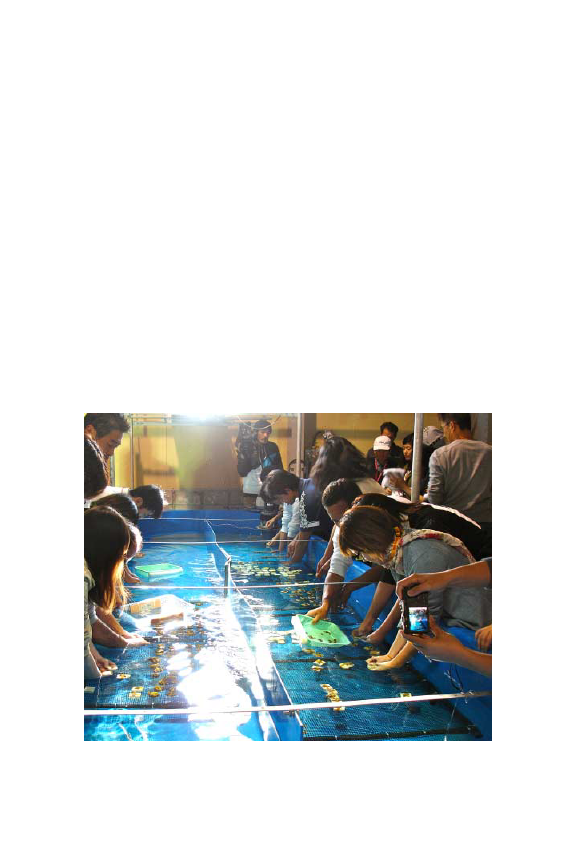
Footprints in Paradise
He touched on the devastation of El Niño in 1998,15 concluding that trans-
plantation would help at least “a little bit.” He closed with a call to “re-
turn Okinawa’s reefs to their pre-’98 condition.” When Gibu was finished
speaking, the tour guide summarized his comments as follows: “Without
beautiful, clean water we can’t make good beer!” Only then did I realize that
this coral tour was actually an Orion Beer–sponsored event, and that our
volunteers were just stopping in on their way to a brewery in Nago.
In just one hour on this sunny Sunday morning, ninety people migrated
toward the coral nursery, listened to Mr. Gibu’s brief explanation of his
work, secured a broken branch of coral onto a square base with a rubber
band, then wiped their hands with the corporate towels generously provided
by Orion (see Figure 4.3a). Then they jumped back on the bus and off they
went, completely dry. After incubating for about 2–3 months (see Figures
4.3b and 4.3c), the corals would attach to their square bases and would be
ready for transfer by an experienced diver (see Figure 4.3d).
FIGURE 4.3a • Volunteer Coral Gardeners on Land, Ginowan
106
This open access library edition is supported by Knowledge Unlatched. Not for resale.
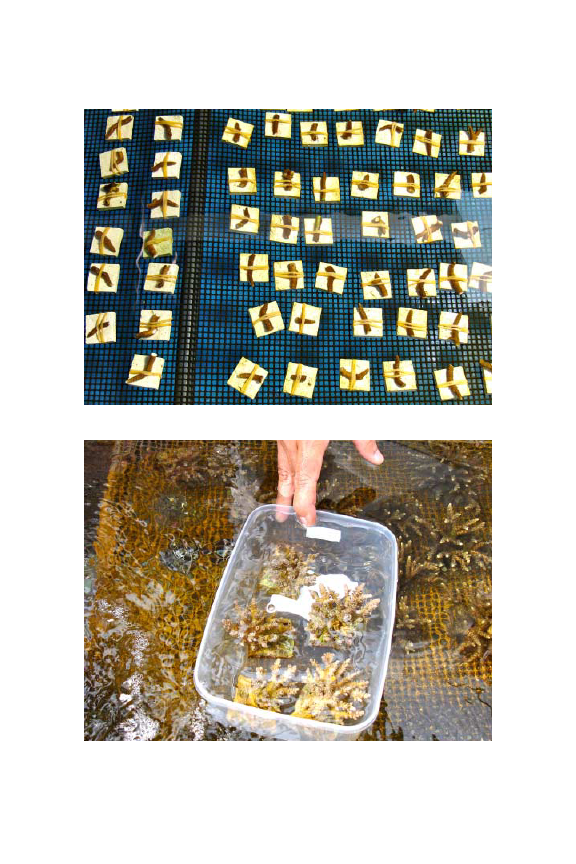
Ecologies of Nearness
FIGURE 4.3b • Coral Polyp Transplants (3 months)
FIGURE 4.3c • Coral Polyp Transplants (6 months)
107
This open access library edition is supported by Knowledge Unlatched. Not for resale.

Footprints in Paradise
FIGURE 4.3d • Volunteer Coral Gardeners at Sea, Ginowan
Diving Deeper
In March 2011, I accompanied Mr. Gibu and five professional dive instruc-
tors on a coral transplanting mission to Kamiyama Island, about a half-hour
boat ride due west from Miegusuku Port in Naha. By now I had transplanted
coral about six times. The pressure to get it right mounted when Gibu, only
half joking, pulled me aside and said, “Andy, today we’re not taking care of
you. Everyone here is a pro. You’re on your own.” Aware that I tended to
move slowly, he asked me to start setting up my gear at least twenty min-
utes before everyone else. I tried to act cool and confident, stealing sidelong
glances at the other divers to make sure none of my gear was assembled
backwards or upside down. I struggled to pull up my wetsuit, hopping on
one foot and bouncing up and down as if on a pogo stick. Trying to appear at
ease, I casually asked him about the origins of today’s batch of corals. He told
me that after permission was obtained from the prefectural government,16
baby table corals were harvested from donor corals collected specifically for
this transplanting. He added that every May the sea turns briefly but in-
tensely red when corals release their eggs for fertilization, a phenomenon I
had watched on the news but never managed to see live. Eggs and sperm are
then harvested and combined to make new corals. On this occasion we were
planting only five corals each because, Gibu informed us, “The point is to do
it cleanly and properly.”
When we arrived on Kamiyama, we did a quick review of materials and
objectives, lined up and leapt into the chilly water one at a time (left hand on
108
This open access library edition is supported by Knowledge Unlatched. Not for resale.

Ecologies of Nearness
mask, right foot pointed straight out in military marching fashion). Despite
the foreboding, nauseating waves and grey storm clouds we had encountered
on the way out, we all entered the water with relative ease. We deflated our
BCD vests, gave each other the thumbs down sign,17 sank down to about
fifteen meters, and began swimming due east. I followed behind the others,
mimicking their relaxed and leisurely graceful frog kicks with my black rub-
ber fins, and practiced reading my compass. Then my mask began to fog over
and I realized I had forgotten to spit on the hard plastic lens.18 I lifted the
mask, allowing the cool seawater to rush in and wash the inside of the lens.
I cocked my head back, angled the mask away from my face, and purged the
water with an equine nasal snort.
Perhaps for the first time since I had begun diving, I actually recognized
where I was. The reef was small, and on our previous mission I had taken
for granted that I would be able to recall where my corals were located. Such
was not the case, and I was grateful for the individualized nametags zip-tied
to each cage. Without names, they all looked the same. I began surveying
the reef for a smooth, bare spot ripe for transplanting. One of the other
divers swam up behind me and handed me two baseball-sized balls of the
grey glue; another followed with my five transplants. I had found a reason-
ably flat spot nestled in a crevice of the reef and surrounded by rusting and
algae-covered cages from past plantings. I began to scrub away with the wire
brush, recounting the planting protocol steps in my head. My buoyancy
shifted as I gradually depleted the air in my tank, and soon I had to jam my
neoprene-padded knee into the crevice to stabilize my position. I hesitated
to hammer the nails into the compromised reef, which cracked with each
strike.
After about twenty minutes I had completed my task and began looking
around for something else to do. The divers were scrubbing algae off the
cages of older coral (maintenance), so I joined in until they began signaling
that it was time to go. Gibu hovered behind us to do the monitoring, which
included photographing the corals and recording their few centimeters of
growth over the past few months. Soon I heard the faint, tinny clanking of
pointer-on-tank, which signaled that it was time to head back. By the time
I arrived back below the boat the other divers were all doing their safety
stops,19 floating in lotus position, perfectly suspended in the water, looking
peaceful.
On the ride back to Naha, I asked Gibu what the day’s activities had actu-
ally cost Coral Okinawa. He puffed carefully on a cigarette, taking care to tap
the ashes into a glass jar to prevent them from floating off into the water. He
told me that a local dive shop had donated the boat, and, save for the glue,
virtually all of the materials used were from the 100 yen store. Most expenses
were incurred in the growing and harvesting of corals prior to transplant. To
109
This open access library edition is supported by Knowledge Unlatched. Not for resale.

Footprints in Paradise
the eight thousand corals he was actively monitoring we had added fewer
than thirty—but at least this small action was cost-free.
After docking, we unloaded all of our gear and gathered in a circle to re-
view the day’s events. He asked each diver to give a three-minute impression
of their experience, asking: What went right? What could have gone better?
What did you learn? What does this mean to you? Most of the responses were
on the mild side, displaying commonplace Japanese public modesty: “I think
I might have helped a little bit,” or “I’d really like to do this more often.” I
asked Gibu a more specific question about the consequences of hammering
into one dying coral to plant a new one on top. In between thoughtful drags,
he replied that the damage done to corals by typhoons far outweighs the dam-
age we do with our hammers,20 and insisted reassured me that our methods
followed the international guidelines they had adopted in 2004.
His comments left me wondering whether our contributions were merely
a drop in the salty sea bucket. If our efforts could be thwarted any time the
sea temperature surpassed thirty degrees Celsius, or whenever a tsunami blew
through, and if every seventy years the reefs are taken over by the crown-of-
thorns anyway, then why bother? He countered my cynicism: “For policy, we
need this [protocol] as a policy. More than new technology, we need good
policies.” This is how Gibu and his volunteer transplanters take stakes in coral.
Conclusion
When we think of getting near to nature, we might imagine childhood proj-
ects such as butterfly and rock collections, or perhaps even seashells and coral
fragments once collected to decorate our bathrooms and gardens. But not all
nature collections involve removing the object of interest from its ecosystem:
diving stakeholders collect coral colonies by adding to the marine popu-
lation and naming individual transplants. This form of collecting involves
monitoring and maintaining corals, and recording the names of fish and
other species that inhabit them. Instead of acquiring natural trinkets such as
sand dollars, the take-home from this kind of coral counting and collecting
is data, accumulated and recorded on waterproof notepads and later elabo-
rated in personal dive logs. In addition to chronicling basic details such as
the temperature of the water, depth and length of each dive, logbooks (a
form of “recreational book-keeping” [Lorimer and Lund 2008: 197]) always
include a section for the diver to sketch any remarkable sightings. In Chap-
ter 3, village walkers and community chatters gathered local cultural and
ecological knowledge by collecting objects such as rocks, flowers, memories,
and photographs. In the context of coral transplanting, the experience of
monitoring and maintenance is collected rather than the coral itself.
110
This open access library edition is supported by Knowledge Unlatched. Not for resale.

Ecologies of Nearness
Hayden Lorimer and Katrin Lund (2008: 185) problematize a common
trope in outdoor travel and exploration through the figure of novelist John
Fowles. Fowles firmly believed in the possibility of a “pristine encounter”
with nature: “[Fowles’] message was clear: for as long as the conceptual urge
to classify, document, list and tick prevailed, our common response to nature
would be much the poorer.” In Fowles’s view, expressed most eloquently in
his essay “The Blinded Eye” (1984), amongst collectors an “elevated appreci-
ation” of nature is too commonly subordinate to “a much diminished, lesser
form of knowing”—a knowing based on drawing, measuring, and counting
(Fowles 1984: 77, quoted in Lorimer and Lund 2008: 186). The capacity
to see, and, in the case of coral transplanting, to touch one’s collection, is
central to the act of coral gardening. Lorimer and Lund (2008: 186) artic-
ulate shared qualities in the experience of collecting nature, where “tasks
of judgment, organization, inspection, preservation, re-inspection and com-
parison happen as a series of correspondences between nimble hands and
discriminating eyes.” Diving stakeholders’ “epistemic ambitions” are grati-
fied through haptic (involving the sense of touch) and optic intervention in
local coral reefs, as well as through the simultaneous proprioceptive (bodily)
experience of underwater movement through diving.
Our need to feel nature may derive from an overall trend identified by
Bryan Turner (1996: 1) as the turn to a “somatic society,” wherein the body
becomes part of a “self-project” wherein individuals express their emotional
needs through specific acts of bodily construction. Through this process
of embodiment, the individual body “is connected into larger networks of
meaning at a variety of scales” (Cresswell 1999: 176). The range of spatial
scales can be imagined through interactions with whales, dolphins, and coral.
The ecologies of nearness explored in this chapter consider affective, ther-
apeutic, moral, and scientific forms of intimacy between and among human
and nonhuman animal species. In Okinawa, ecological stakeholders emerge
through the use of natural tools—fingers, eyes, brains, and kisses—and also
through technological extensions of these tools: nomenclatures, notepads,
cages, harpoons, cameras, tanks, masks, and hammers. These tools bring us
close to nonhumans through a nearness that also constitutes us as human.
Chapter 5 considers what else is lost when we lose our sense of place in nature.
Notes
1. For further discussion of touristic labor as the entry point to “authentic” nature, see Chap-
ter 5.
2. When I asked my informant whether he would prefer the use of a pseudonym, he chose
this one.
111
This open access library edition is supported by Knowledge Unlatched. Not for resale.

Footprints in Paradise
3. While they do endorse much of the research showing depressed patients’ positive responses
to animals, mental health specialists Aaron Katcher and Gregory Wilkins (1993: 178–79)
dispute many of the exceptional claims regarding dolphins and autism. They write: “Press
reports of autistic children miraculously responding to the presence of captive dolphins …
are the result of uncontrolled clinical studies and the suggestive influence of the cult that
has evolved around dolphins and other cetaceans. Equally spectacular results have been
noted with cats, dogs, birds, and even a small turtle.”
4. In a remarkable 2013 announcement, India’s Ministry of Environment and Forests Cen-
tral Zoo Authority rejected various tourism development groups’ proposals to build a
commercial dolphinarium because “cetaceans in general are highly intelligent and sen-
sitive … [and] dolphin should be seen as ‘non-human persons’ and as such should have
their own specific rights and [it] is morally unacceptable to keep them captive for enter-
tainment purpose” (Ministry of Environment and Forests 2013).
5. The Japanese title of this novel is ḺƒભƊťƮ, and uses honorific language to elevate
the cat’s position relative to the owner.
6. ǪǞƻƋὊದ, pronounced in Okinawan: “Pitu to Nagunchu.”
7. In Japanese: Gondo kujira. The short-finned pilot whale is a small cetacean comparable
in size to the bottlenose dolphin. Okinawans refer to this particular species as “ikura”
(dolphin).
8. A body of literature already addresses the politics of cetacean hunting and consumption
(for a small sample see Blok 2008; Catalinac and Chan 2005; Watanabe 2006).
9. Oura Bay is famous in Okinawa as a site where the relatively rare species blue coral was
first discovered, but is perhaps better known as the home of the endangered dugong—a
charismatic animal resembling a manatee. Anti-U.S. military base protestors rally around
these and other symbolically valuable species to prevent the expansion of heliports into the
northern village of Henoko (see Figure 1.1).
10. In Japan, “NGO” refers to international non-governmental organizations, while “NPO”
refers to domestic non-profit organizations. Similar coral transplanting volunteer groups
have also been created on more than thirty islands outside Japan.
11. Coral Okinawa is one of four coral-transplanting NPOs on the main island. The or-
ganization annually receives ¥20,000,000 ($235,000) from the prefectural and national
governments, and also has about twenty private sponsor companies (including the Japan
Travel Bureau, which donates ¥5,000,000 [$60,000] every year).
12. The popular Okinawan dish mozuku (Nemacystic decipiens) is an algae-like seaweed served
in a vinegary sauce.
13. This is my term, appropriated from Malinowski’s ethnography. While I never heard any
Okinawans refer to coral transplanting (sango no ishoku) as “gardening,” NPO Sea Seed
Okinawa’s official website (www.seaseed.com) does refer to the practice as “coral farming.”
14. Dog winkles or rock shells are thumb-sized, purplish, predatory sea snails.
15. Coral bleaching is a well-documented consequence of rising sea temperatures that has
plagued Okinawa’s reefs since the major El Niño bleaching of 1998. The summer of 1998
marked the strongest El Niño on record, during which the complete absence of typhoons
in Okinawa Prefecture rendered the temperatures of the East China Sea warmer than at
any time in the previous ten years. Hurricanes and typhoons are actually critical to the sur-
vival of Okinawa’s reefs because the intense winds churn up and cool down the shallower
ocean waters in which many heat-sensitive coral species reside. Experts from the Ministry
112
This open access library edition is supported by Knowledge Unlatched. Not for resale.

Ecologies of Nearness
of Environment have also been tracking a severe bleaching from 2007; these events are
predicted to occur annually by 2050 (Harvey 2017). A 2016 reef survey conducted in
Okinawa’s Sekisei Lagoon finds that 90 percent of coral has bleached, and that 70 percent
of Japan’s largest reef has died. It is worth noting that bleaching coral reefs can recover
with time and favorable conditions.
16. Many broken coral branches wash ashore following typhoons, but it is illegal to remove
them from the shore as some may survive being beached and return to a coral colony with
low tide.
17. In dive-speak, thumbs down and thumbs up indicate one’s intention to descend or ascend.
18. Spitting in one’s mask is a low-tech anti-fog technique employed by divers worldwide, as
is urinating in one’s wetsuit to generate warmth.
19. “Safety stop” means pausing for a few minutes at a shallower depth before surfacing, giv-
ing the body a chance to equalize and avoid a potentially fatal air embolism also known as
“the bends.”
20. The meaning of environmentally friendly (kankyō ni yasashī) transplanting practices is
contested. Sea Seed Okinawa advocates transplanting by drilling holes into dead corals
and securing baby polyps with the Okinawan sponge gourd Naabeera (Hechima in Jap-
anese) rather than using chemical glues. A New York Times article on the world’s largest
government-led “coral transplant surgery” project on Sekisei Lagoon Reef (Okinawa) de-
scribes a range of other methods being tested by reef scientists that could be used else-
where to rescue reefs endangered by overfishing, pollution, and global warming (Fackler
2009).
113
This open access library edition is supported by Knowledge Unlatched. Not for resale.
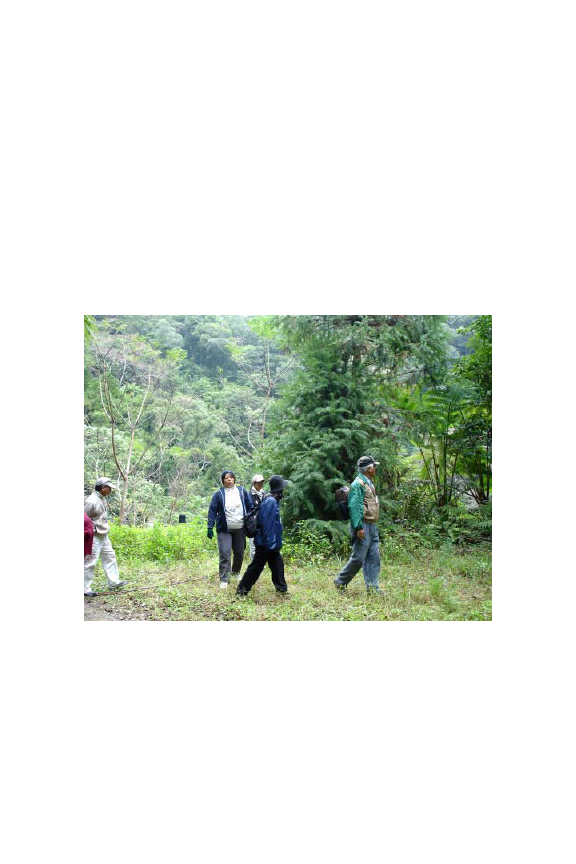
Chapter 5
HEALING AND NATURE
FIGURE 5.1 • Okinawans Do Forest Therapy, Yonabaru Forest
Nuchigusui: This is the healing forest. This is the healing village of Kunigami.
—Kunigami Forest Therapy
English-language promotional brochure
No one in his right mind looks at a pile of dead leaves
in preference to the tree from which they fell.
—E.O. Wilson, Biophilia
114
This open access library edition is supported by Knowledge Unlatched. Not for resale.

Healing and Nature
Introduction
Nuchigusui is an Okinawan term that means “to be healed from the heart”
(kokoro kara iyaseru) or “medicine for life” (inochi no kusuri). I became inter-
ested in health claims associated with the forest after hearing stories about a
local man who had left Okinawa but returned home when he fell sick. The
forest, with its “delicious water,” cured his cancer. This kind of testimonial
was often invoked by residents and nature guides living in Yambaru as evi-
dence of the intrinsic value of their forests.
What makes an environment “healing”? In this chapter, I discuss the rela-
tionship between healing and nature in the context of ecotourism by intro-
ducing the practice (and practitioners) of forest therapy and other forms of
“intraspecies” (Haraway 2008) encounters in northern Okinawa. Participants
in these activities are taught to cherish nature through their engagement in
guided outdoor activities designed to evoke a specific kind of transformative
sensory experience. The nature of these experiences, however, is not easily
defined. I begin by analyzing the external structure of the tours. Expanding
upon the themes of localization, movement, and perspective introduced in
Chapter 3, the first part of this chapter explains how nature-based tourism
is promoted to northern Okinawans as a promising new economic sphere
at community meetings and through samplings of state-supported, entre-
preneur-driven ecotours. I examine the labor of organizing and implement-
ing ecotourism used by the Kunigami Tourism Association (KUTA) and the
Ministry of Environment to encourage residents of Yambaru to see their sur-
rounding biophysical environment as a tourist does—as unique, precious,
and ultimately worth exploring and protecting. These tours are simulated,
in the sense that they are conducted to give locals a sense of how ecotourism
catered to outside visitors provides one strategy for unlocking the economic
and community healing potential of the forest.
The middle section of the chapter focuses on guides, whose work is to
bring the forest to life through a prescribed set of outdoor, nature-based ac-
tivities meant to shift the balance of participants’ everyday perceptual tools
from primarily visual to tactile and aural. The nature interpreters (neichaa
intaapuritaa) and forest therapy guides I encountered often claimed to offer
privileged access to “real” nature, and many of them derived their sense of
authority, expertise, and belonging from their ability to bring ecotourists
closer to it. Questions of authenticity in nature frequently emerged when
guides discussed their own personal biographies. As I discussed in Chapter 3,
for some guides, being native to Okinawa is much more a matter of mindset
than place of birth.
We learned in Chapter 1 that nature interpreters are ecotour guides who
distinguish themselves from other kinds of tour guides by claiming to have
115
This open access library edition is supported by Knowledge Unlatched. Not for resale.

Footprints in Paradise
an especially deep familiarity with nature that enables them to interpret the
natural environment for others. In Japanese, the term “guide” (gaido) typi-
cally connotes a young woman, dressed in hose and high heels and carrying
a small flag, leading a group of agreeably passive late middle–aged sightseers
on a rigidly scheduled bus tour generally allowing only short stops to photo-
graph scenic spots. A good Okinawan friend of mine who had worked as a
tour bus guide in her early twenties joked about having visited the Churaumi
Aquarium at least two hundred times; but for her this had been a temporary
job, and little more. She did not link her sense of being Okinawan with her
scripted narration of popular tourist sights. Nature interpreters, on the other
hand, self-consciously claim authenticity and sincerity in their work—an
authenticity and a nearness to nature not pursued by more conventional tour
guides. Nearness is what qualifies them to interpret nature: They can bring
Ishikawa’s frog and the deigo tree new meaning for the ecotourist or student
of environmental education by locating these species in the forest, and by
explaining their roles in supporting the ecosystem. This authenticity claim is
generally linked to the interpreter’s multilingual breadth of local knowledge
about indigenous, endemic, and invasive species.
In distinguishing themselves from typical guides, the nature interpreters I
interviewed emphasized the hundreds of hours they had spent studying the
Yambaru Forest and its denizens. Most, though born and raised in northern
Okinawa, did not naturalize themselves as inherently nearer to nature by
virtue of their geographic origin. The distinction between native and non-
native interpreter becomes clear in the explanation of a self-described “in-
vasive species” interpreter: rather than relying on a passive birthplace-based
claim to authenticity, a native interpreter approaches intraspecies nearness by
reclaiming or reconstituting lost or fading knowledge about the area. Inter-
preters often expressed a desire to (re)connect with the forests of Yambaru.
As one of my twenty-year-old informants put it when describing his affinity
for the Forest School and surrounding area: “I don’t want to be separated
from this place.” The nature interpreters I met pinpointed the location and
defined the limits of their nature externally, by scrutinizing the origins of
certain plants and animals, as well as their own geographical and cultural
roots. Whether local or visitor, participants’ nearness to nature was mediated
by their interpreters: through plants and animals introduced, senses height-
ened, and stories told.
Nature interpreters can also be seen as “human technologies” or as “di-
verse agents of interpretation, agents of recording, and agents for direct-
ing and multiplying relational action” (Haraway 2008: 31). Similarly, Noel
Salazar’s ethnography of the politics of international tourism refers to ex-
pert tour guides as “mechanics of glocalization” (2010: 173) to emphasize
the labor-intensive work of highly skilled guides responsible for localizing
116
This open access library edition is supported by Knowledge Unlatched. Not for resale.

Healing and Nature
global concepts circulated by tourists, and for globalizing local stories and
attractions through their tours.1 Through their embodied actions (walking,
talking, diving), the Aruki village walkers and community chatters discussed
in Chapter 3, and the coral-transplanting stakeholders from Chapter 4, en-
gage in the parallel endeavor of documenting intraspecies encounters.
In this chapter, I draw on E. O. Wilson’s biophilia hypothesis and Marc
Augé’s concept of the supermodern “non-place” to ask a fundamental ques-
tion: Why do we endeavor to get close—sometimes dangerously close—to
nature? The people I joined on the ecotours discussed next were expecting to
have fun, but some discovered medicine for life.
Cherishing Nature
I first met Mr. Oku, head of the Naha division of the of the Ministry of
Environment Nature Conservation Office when I was seated behind him
in a two-person kayak on the Gesashi River. We paddled downstream, sur-
rounded by a gaggle of ebullient ecotourists. Undaunted by the unusual set-
ting for our interview, I attempted to make conversation with the back of
his head. Taking care not to splash me with his wooden paddle, Oku turned
around and explained to me that Okinawa Prefecture’s ecotourism charter
was created to cultivate in visitors and locals a sense of nature as “cherish-
able.” Itsukushimu,2 a verb he translated as “to cherish,” suggests a reverence
for nature that comes from direct experience or contact (fureai).
In fourteen years of Japanese language study I had never come across
this verb, and one of my Japanese colleagues explained that it is an unusual,
old-fashioned sounding word that encompasses a variety of emotions: to
itsukushimu is to love, have affection for, and pity something all at the same
time. This, Oku suggested, was a sentiment long cultivated in mainland Ja-
pan owing to its long history of overcrowding and natural resource deficien-
cies.3 Meanwhile the vast majority of Okinawans, he claimed, had lived in
predominantly rural settings until quite recently and thus did not appreciate
nature in the same way mainland Japanese did.4 Coming from a Yamatonchu
(Okinawan term for “mainland Japanese”), this assertion immediately trig-
gered my skepticism—but I had also heard it from an Okinawan. Though
he did not use the word itsukushimu, Mr. Kuba (of KUTA) reiterated Oku’s
notion of cherishing when he explained that the objectives of his NPO were
to “cultivate hearts that value nature”5 in people of all ages throughout Oki-
nawa—especially Yambaru youth who underappreciate their surrounding
environment as common or mundane, to them. Both men sought to revi-
talize Yambaru by rendering everyday nature cherishable through carefully
crafted native ecotours.
117
This open access library edition is supported by Knowledge Unlatched. Not for resale.

Footprints in Paradise
Ecotours for Locals
KUTA was created in 2000 to coordinate and promote sustainable tourism
development in the Yambaru region. The organization comprises about fif-
teen members, including Professor Junko Ōshima, a self-described “nature-
lover” (neichaa rabaa) originally from the Tokyo area who has lived in Oki-
nawa since 1998. Other members of KUTA were born and raised in north-
ern Okinawa. At least one of the energetic Chinen brothers (introduced in
Chapter 3) was present at nearly every ecotourism event I attended between
August 2009 and May 2011. In addition to working for the village office,
both brothers also facilitate the maintenance of the Forest School, an envi-
ronmental education facility in Kunigami built in the mid-2000s on land
previously controlled by the U.S. military for use as a jungle warfare training
area (discussed in Chapter 2).
Mr. Shimabukuro, a KUTA associate, is a professional photographer
whose stunning images of endangered and endemic species, including the
Yambaru kuina, the Ishikawa Frog, the Ryukyu Mountain Turtle, and the
Pryor’s Woodpecker (Noguchigera), are sold as postcards and posters, and are
printed on promotional materials that circulate all over Japan. In collabo-
ration with KUTA, Shimabukuro’s son works as a nature interpreter at the
Forest School, and his daughter-in-law is a forest therapy guide.
Between November 2009 and January 2010, these KUTA members
organized a series of ecotourism promotional events called the Yambaru
3-Village Treasure Box.6 The events were scheduled to take place in Higashi,
Ōgimi, and Kunigami. The organizers staged three monthly themed expe-
ditions—“Mountain,” “River,” and “Ocean”—to teach local participants
about the interrelatedness of three distinct ecosystems while introducing
them to the ecotourism concept more generally. The museum-sponsored
village walks and organized community chats described in Chapter 3 en-
couraged locals to see their everyday surroundings as a tourist would. These
Treasure Box tours, offered to locals at no charge, were designed expressly to
gain support and enthusiasm for the expansion of ecotourism in the area.
The advertisement in Figure 5.2, circulated by KUTA, promotes a man-
grove kayak trip in Higashi, a waterfall hike in Ōgimi, and nature games in
Kunigami:
Re-discover the region’s beauty! Participate for free!
Given that these tourism promotional events were limited to local residents,
I felt quite fortunate when a colleague invited me to attend. I was unsure
where they would place me in the lineup and was surprised when, just as
118
This open access library edition is supported by Knowledge Unlatched. Not for resale.
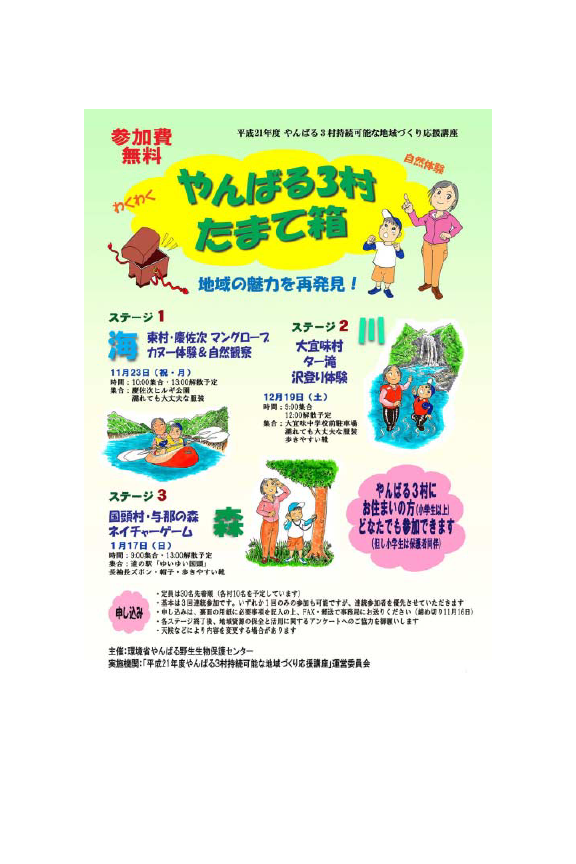
Healing and Nature
FIGURE 5.2 • Ecotourism Promotional Flier for Okinawans: “Treasure Box”
Nature Games
119
This open access library edition is supported by Knowledge Unlatched. Not for resale.

Footprints in Paradise
Mr. Gibu had done during the Orion Beer event, Ms. Kakazu from the Min-
istry of Environment quietly slipped me a “Staff” badge. With no training
whatsoever to qualify me for such a distinction, I quickly improvised a role
and introduced myself to the participants as their “English language refer-
ence guide.” This proved to be a mistake once the nature interpreters began
introducing plant and animal species, as I could not yet name most of them
in English, let alone in Japanese or Okinawan. Fortunately, the novelty of
my presence seemed to override the fact that I was neither expert nor local.
The priorities established during the KUTA planning meetings I attended
were that participants would:
1) Be safe!
2) Have fun!
3) Ponder their discoveries and their sense of natural beauty.
4) Consider how to protect each place visited.
The kayaking trip up the Gesashi River proved exciting for the roughly thirty
participants (ages 4–80, though the target demographic was mainly mothers
and children), many of whom had lived in Okinawa their whole lives with-
out ever being in a non-motorized boat. Unfortunately, the Ōgimi waterfall
walk was interrupted by inclement weather, leaving participants little oppor-
tunity for reflection.
Healing “Nature Games”
On a cool Sunday in mid-January 2010, I accompanied the KUTA staff to
a protected forest in Kunigami for the final stage of the Treasure Box Tour,
which was advertised as a series of “Nature Games.” Participants gathered in
the parking lot of a small nature center at the base of the trail and broke into
five groups of roughly ten people each. Before we departed on our journey,
one of the nature interpreters handed me a stethoscope. The guide laughed
at my puzzled expression and said we would be using it to take the pulse of
the trees.
As we trekked uphill along the beaten path, our volunteer nature inter-
preter Mr. Inafuku, a retired man in his late sixties, stopped to point out
different trees and plants that are famous in Okinawa. The Itajii 7 tree, he
revealed, was actually not indigenous but had been imported in the late
nineteenth century. He informed us in a distinctly critical tone that very
few of the plants symbolically associated with Okinawa today (e.g., hibiscus,
pineapple, dragon fruit) are actually endemic to the area.
120
This open access library edition is supported by Knowledge Unlatched. Not for resale.

Healing and Nature
Halfway up the hill, our group stopped and dispersed for a quiet moment
communing with nature. We were told to plop down in a comfortable spot
and listen for the sounds of the forest: the rustle of the wind in the trees,
the crunching of fallen leaves by camouflaged ground critters, the trickling
flow of a small stream nearby. I chose a large, smooth gray rock just off the
path and sat down, feeling sleepy and flat. I wondered how long this next
bit was going to take. After about ten minutes our guide roused us from our
thoughts and gathered us around him for a moment of group reflection.
Participants marveled politely over the various sounds and sensations they
had discovered as I tried to recall where my sluggish mind had wandered.
We continued on our trek, and our interpreter stopped every few minutes
to point out a rare plant such as a land orchid, or to listen for a Pryor’s wood-
pecker busy chiseling a new tree dwelling. One shrub had leaves that tasted
like lemongrass. We approached a giant Itajii and Inafuku paused to take the
stethoscopes out of his backpack. I watched a mother tenderly teaching her
ten-year-old son how to listen for the tree’s pulse. After many failed attempts
I finally found the tree’s muted “heartbeat,” which resembled the sound of
rushing water or the inside of a conch shell. (I later learned that what we
were actually hearing was the crackling, gurgling sound of sap flowing up to
the branches.) This tree appeared healthy and robust, but the application of
the cold metal device made me feel like we were treating it for something,
reverently. At the very least, we were treating it like it like us.
About two hours passed before we descended the hill and sat clustered in
circles on the asphalt parking lot of the nature center to reflect on our ex-
perience. My group consisted of the mother-son duo, three retired couples,
two younger couples, and a single young woman. Participants reported back
that it was nice to get outdoors; most had not known they could hike in this
particular forest. They also recounted the names of some of the plants they
had learned to recognize with the help of our interpreter.
The young woman stood up and volunteered to present our group’s feed-
back to the other tour participants. She listened attentively to their compli-
mentary but predictable comments: “It felt so nice to be outside”; “I learned
a lot”; and “I realized how much we need to protect this forest.” As the
woman began to speak, she trembled and was suddenly overcome with a rush
of emotion. She described having problems at work; having “many many”
social and family conflicts, and alluded to suffering from a long-standing ill-
ness, which, one of the coordinators later quietly suggested to me, was most
likely depression. The woman sobbed as she spoke about the sheer relief she
felt from noticing the wind on her face, breathing the clean fresh air, and
immersing herself in such an unfamiliar and pristine natural environment.
She spoke of coming back to life, thanks to the forest.
121
This open access library edition is supported by Knowledge Unlatched. Not for resale.

Footprints in Paradise
Promoting Forest Therapy
In late March 2011, I attended a daylong conference at Kunigami’s Forest
School designed to promote the longstay tourism8 model to Yambaru resi-
dents. Our featured speaker was an energetic executive in her fifties in charge
of Mahaina Wellness Resorts Okinawa, a hotel chain leader in the longstay
tourism trend since 2000. She opened by reflecting on how amazing it was
to hear the call of the Yambaru kuina in the morning when she arrived, how
quickly its cries had transported her out of her city life and working state of
mind. She raved about the “pawaa chaaji” (power charge) she had received
from the forest.
Forest therapy (also called forest bathing [೦ਟფ]) might be described
most simply as going to a forested area and wandering around. And yet
the facilitation of this simple practice provides a small but crucial economic
“power charge” for young residents who might otherwise be compelled to
leave Yambaru to seek work in Naha or Tokyo. There are forty-two certified
forest therapy centers in Japan, but only one in Okinawa Prefecture.9 The
Kunigami Village office spent seven years planning its forest therapy pro-
gram, building four distinct therapy roads; it has trained nature guides since
2007. Guides are typically recruited out of the local high school, though I
met a few non-certified guides who had arrived via a different path: after
studying for approximately one month, they flew to Kyushu (the nearest
major island to the north), sat for a ¥7,000 ($80) test in Fukuoka Prefecture,
and became certified by the national organization that runs all of Japan’s
forest therapy programs.
Mr. Tamaki, a youthful looking thirty-something man who coordinates
the forest therapy program in Kunigami, presented the key concepts of his
program to an audience of about fifty middle-aged men and women from
Yambaru: Kenkō (health), Kankyō (environment), Kankō (tourism).10 Tamaki
promoted forest therapy as a thirty-year-old technique supported by scientific
research (see Nakamura 2008; Ulrich 1993). The healing modality has been
proven to boost the immune system, lower blood pressure, slow the pulse,
and even reduce stress hormones (Nakamura 2008). In addition to “power
charging” tourists, he described Kunigami’s program as “health-making for
residents,” in part because venturing into the forest reminds older folks of their
childhoods and makes them “genki” (spirited or cheerful) (see Figure 5.1).
Interpreting Forest Therapy
Nature interpreters in Okinawa define forest therapy and ecotourism more
generally. Local ecotourism promoters with whom I met complained occa-
122
This open access library edition is supported by Knowledge Unlatched. Not for resale.

Healing and Nature
sionally that foreign tourists (primarily American, frequently U.S. military
personnel) would come to their kayak shops and request a discounted rental
for a guide-free experience. Mr. Miyagi, director of Higashi’s Tourism Pro-
motion Association, explained the relative scarcity of non-Japanese visitors
to the area: “Their sense is different.” The ecotour guides would never allow
this kind of self-directed adventuring because they strongly believed that
their natural surroundings could not be properly understood through an
outside perspective. In addition to the need to protect their livelihood, these
interpreters believed that the legitimacy of their enterprise hinged on their
ability to provide an interpretation of Yambaru’s nature unavailable through
any other medium.
Each of the interpreters introduced in the next section has negotiated his
or her professional identity in relation to the guide-interpreter spectrum.
Like the locals and researchers introduced in Chapter 3, the “knowing” and
“noticing” ecotour guides are diverse in gender, geographic origin, level of
ecological knowledge, and degree of social mobility. I include some of my
personal reactions to each tour and each guide to illustrate the physical, spir-
itual, and intellectual discomfort that comes from healing in nature.
The Native Novice
The morning after the Kunigami community chat session, I passed a giant,
colorful tourism map on display in front of the town office. I stopped to
study it for a while, making sure I knew most of the highlighted destinations.
The Forest Therapy Road (೦ਟǑǿǪ✣ȃ✣ǟ®) caught my attention,
and I entered the office to ask how I could access what I imagined as a rug-
ged, winding trail through the woods. A helpful city worker in a pastel green
jumpsuit strongly encouraged the use of a guide. He quickly made some
phone calls, and a few minutes later another young man in another green
jumpsuit was escorting me to the entrance of the therapy road.
The road wound up the hillside for about two kilometers. As we ascended
into the “Broccoli Forest,” the dark green Itajii trees grew dense. A wooden
sign posted at the entrance to the park read “Mori to mizu to yasuragi no sato,
kunigami” and was translated into English as “Kunigami offers you ‘Peace of
Mind’ from Okinawa’s best Forest and Rivers.” In my impromptu quest for
tranquility, I was about to get a lesson in patience.
I was escorted to Ms. Taira, a northern Okinawan woman in her mid-
twenties who kindly offered to take me on an abbreviated (but free) walk
on the therapy road. She had just returned from a training session at one
of the larger forest therapy facilities in Nagano Prefecture and seemed eager
to practice. As we walked, I asked her a few questions about the program:
123
This open access library edition is supported by Knowledge Unlatched. Not for resale.

Footprints in Paradise
“Who comes? Retirees? Mothers and children? Patients?” She replied that,
while it would be ideal if “genki ga nai” (unwell, literally “no spirit”) people
came, in fact most of the participants were already in good health. “People
who aren’t well can’t be bothered going outside, can they?” Her deadpan
response came in startling contrast to the dramatic healing potential Tamaki
had touted at the longstay tourism conference.
The forest therapy road was constructed of smooth concrete with white,
rubbery zebra stripes painted across it, which made it much more accessi-
ble than I had expected. Where was my rugged outdoors? I found the road
aesthetically intrusive and began to wonder about its therapeutic value. As
if reading my mind, Taira said: “The purpose of this route is not so much
trekking as it is being. We don’t want people to slip along the way. The aim
is to simply be, in the forest.”
Feeling an equal and opposite need to document the situation, I fumbled
for my camera. “First, we want people to touch the trees,” Taira explained as
she tenderly petted the soft green moss growing on the side of a tree. I copied
her skeptically. We continued walking and she bent down to uproot a small
plant. “This one’s great,” she said, holding it up to my nose. “The leaves don’t
really smell but the roots are amazing.” I sniffed the white roots and guessed:
“Spearmint?” “Actually it’s more like A&W,”11 she noted. I got the reference
and concurred, “Like root beer, sarsaparilla, yes!” Before we had progressed
another two hundred meters, she stopped and pointed to the ground. “Look!
The Iju [needlewood]12 seeds look like laughing faces!” The rugged ever-
green’s large brown dry seeds lay cracked open on the trail, smiling up at us
indeed. I picked one up and put it in my pocket.
Ignoring her suggestion to “just be,” I attempted to continue my inter-
view by asking about the documented effects of forest therapy, who sponsors
the program, and so on. She replied that she had only been working there for
a year and that there were much more experienced guides I should consult.
She paused, stooped down again, and produced a handful of bitter acorns
for me to sample.
Next Taira led me to a bench overlooking a large pond where a lone duck
swam in circles. “Try shutting your eyes for a few minutes. We are always
looking at the world, but you feel things entirely differently when you can-
not see. Notice the blowing breeze, hear the rustle and the sounds of the
insects chirping. This is where we work on breathing. People usually breathe
with their chests, but we invite them to breathe with their bellies.” I puffed
out my stomach, hoping to feel something.
We nibbled on the lemony leaves of shikwaasa, a lime-like Okinawan
citrus fruit that grows on sprawling green trees and, when mixed in, makes
awamori infinitely more palatable. We chewed the cinnamon-like essence
out of shiny green gettō (shell ginger)13 leaves as she described how much she
124
This open access library edition is supported by Knowledge Unlatched. Not for resale.

Healing and Nature
had learned from her tourist customers. She demonstrated how one man had
encouraged her to get down on all fours and sniff out the edible plants on the
path “just like an animal.”
When Taira mentioned some of the psychological consequences of liv-
ing “in concrete,” I immediately thought about my tiny grey shoebox of an
apartment in Nago. When I had first moved to Okinawa, despite living in
the centrally located city of Ginowan, I had actually been tucked away in a
very earthy and alive house replete with shikwaasa (green papaya trees) and
even a mori no aisu plant (“ice cream of the forest,” also called atemoya),
so nicknamed for its white, creamy sweet meat. Yamori geckos and giant
spiders scaled the walls of my three-bedroom house, inside and out, and a
pair of lovebirds flirted the day away on my wooden deck. The walls of my
house shook daily from U.S. military planes flying overhead, a source of
chronic, blaring noise pollution. There was a Starbucks in walking distance
from my place, and the controversial Futenma Marine Corps Air Station,14
surrounded by barbed-wire fences, was just a few blocks away. And yet, I had
unwittingly inherited my landlord’s gorgeous green garden full of wild vines
and hibiscus.
Taira asked me what had brought me to Yambaru, and I explained that for
the second half of my fieldwork I was determined to get closer to the nature
that ecotourists sought. So I moved an hour north to Nago, only to find my-
self living in a square efficiency apartment mass produced by LeoPalace21, a
nationwide chain of cookie-cutter apartments. I was closer to Yambaru’s for-
ests from Nago, but my immediate living environment felt tight and sterile.
Friends’ warnings about outdoor toilets and frequent reminders that “Living
in the countryside is a pain!” had convinced me to go for clean and new
instead of old and charming.
As we completed the therapy loop, we passed by a row of A-frame camp-
ing bungalows designed for short-term visitors. These large birdhouse–like
huts grew more attractive the more I reflected on my own housing. I won-
dered how it would be to live as a true nature lover, like Taira, immersed in
this kind of living environment day in and day out. I asked her when I could
return for a full therapy session with other customers. She explained apolo-
getically that she was moving to the mainland the next month to become a
housewife and probably would not have time to meet again.
Therapist Close to Fun
The morning after the longstay tourism symposium I reconnected with Mr.
Tamaki and six forest healing participants ranging in age from 25 to 65.
All were from Yambaru save for a youthful middle-aged reporter for the
125
This open access library edition is supported by Knowledge Unlatched. Not for resale.

Footprints in Paradise
Okinawa Times who had driven up from Naha. Tamaki’s first question to
the group was “How are you doing today?” He was not asking in the polite,
empty sort of way we all do but actually wanted us to record any specific
physical and psychological (mood) complaints on a before-and-after form he
distributed. We sat in a circle on the grass, and he came to interview us one
by one with no real pretense of privacy. He approached me last and asked
the following questions:
– How many hours did you sleep last night?
– How many hours do you usually sleep?
– How are you feeling today? Is your mood good/average/bad?
I felt quite meek next to the sporty journalist, who reported excitedly that
she works every day, never takes vacations, and requires only four hours of
sleep. After overhearing the rest of the group’s polite answers, I lied judi-
ciously in answer to the first two questions. Then I remembered that this
was supposed to be therapy. I told Tamaki that I was in a bad mood (a for-
tunate coincidence in this case), at which the energetic journalist exclaimed:
“Why?!” Tamaki filled out the front and back of my intake form, circling
areas of physical discomfort that I indicated on a generic human figure much
like those used at a chiropractor’s office.
Then we prepared for our walk. Tamaki led us in a cheek and neck
“shape-up” stretch, a simple twisting of the head up and down, left to right,
which he suggested would be good for us because we were women. This
comment did not help my mood, but I took it as an opportunity to ask him
why no men had signed up for the tour. This forest therapy course was one
of a few half-day outings, each approximately ¥3,000 ($35), coordinated
for attendees at the symposium. We had chosen it over snorkeling, tea mak-
ing, and a village tour exploring the connections between water and moun-
tains. “Well, I think that women are naturally more interested in healing,”
he replied.
After a few more rounds of cosmetic calisthenics, we sauntered down the
hill and entered the well-marked therapy road. He encouraged us to chat
as we walked slowly. He asked us to stop and smell a delicate pink flower
reminiscent of a hibiscus. Tamaki described the phenomenon of phyton-
cide (literally “exterminated by the plant”),15 wherein the very same aromatic
smells that attract humans to certain flowers serve to protect the plants from
hungry pests. He pointed out the Itajii, the preferred home of the Yambaru
kuina and the favorite tree of nearly every nature guide I met. As we contin-
ued along the striped path, he reminded us to pause for a moment to check
our breathing: “Is it deep and slow?”
126
This open access library edition is supported by Knowledge Unlatched. Not for resale.

Healing and Nature
Next it was time for tea and (more) chatting in the forest. (Tamaki told
us this was “the Yambaru way” of relaxing.) A freshly painted gazebo ap-
peared just off the zebra-striped trail, and we sat down at a table with tree
stump–shaped concrete stools. Tamaki produced two thermoses filled with
steaming hibiscus tea and a boxful of homemade Chinsukoo (Okinawan salty
shortbread). Perhaps inhibited by thoughts of drooping chins and stretching
necks, each woman took just one cookie then gave the rest to me as an omi-
yage (souvenir).
After resting for a while we resumed our walk, traversing a narrow bridge
that crossed over a large pond with two ducks paddling around. I passed the
pond unthinking, when out of the corner of my eye, a wave of glittery wind
washed over the water. For a brief and stunning moment, I was flooded with
a sense of the numinous. I checked with my neighbor to make sure I was not
imagining things; she had seen it, too.
The rest of the group had not seen it, so we kept on walking until we
arrived at a wooden sign that explained something about music, fukisoku
(irregularity), and yuragi (shaking). I had no idea what was being discussed
until one of my companions explained: “Hikaru Utada’s voice does it.”
Something vibrating in the world-famous pop diva’s voice was also in this
forest. Apparently, if one stood in that spot long enough, there was some
benefit to the parasympathetic nervous system.16 Tamaki said it was difficult
to explain but summarized the healing effect of this station as “relaxation.”
Next we engaged in a hammock experience, which was as straightforward
as one might imagine. None of my companions had ever sat in a hammock
before, and some of them looked quite nervous at the prospect of swinging
supine. One woman lay still and stiff like a corpse in distrust of the contrap-
tion before finally exclaiming, “This is pretty good!” After approximately
three minutes Tamaki asked the group, “Could you relax?”
We soon came to the end of the course, which was only about six hun-
dred meters long, and waited for lunch by some picnic benches near the
Welcome Center. Tamaki brought us handmade recycled newspaper bentō
boxes chock-full of Yambaru delights. Using hand-carved reusable bamboo
chopsticks, we feasted on juushi fried rice balls packaged in another waxy
green shell ginger leaf (gettō in Japanese) in lieu of plastic wrap, Okinawan
fatty pork, and a lightly sweetened, purplish taro yam dessert.
As we sat down one of the older women remarked: “So that’s therapy!”
Two participants began discussing the meaning of the loanword for “ther-
apy” (serapii in Japanese). Much like the coral monitoring loanword conun-
drum from Chapter 4, nobody seemed to know quite what it meant. They
asked Tamaki, who admitted that he was not entirely sure, either. He men-
tioned that iryō (medical treatment or care) and ryōhō (a method of medical
127
This open access library edition is supported by Knowledge Unlatched. Not for resale.

Footprints in Paradise
treatment or a cure) were two possible translations, but quickly added that
what we were doing was more like “therapy close to fun” (Fuan ni chikai
serapī). Eventually he settled on describing what we had done as “enjoying
the forest” (mori wo tanoshimu koto).
As we continued munching, one of the other women asked me, “So …
what does therapy mean in English? Is it medical? Is it personal?” I was
stumped as the many uses of the term in English flashed in my mind. I
thought of colloquial examples such as “retail therapy,” but there was also
physical therapy, psychotherapy, occupational therapy, even hydrotherapy.
I replied that it was a very broad term with many meanings, both physical
and psychological. “Yes, but what are its nuances?” They were not satisfied. “I
think it connotes getting help with, or for … something,” I mustered. They
nodded politely.
Using our conversation as confirmation of his earlier claim, Tamaki sum-
marized our discussion: “Yup, women respond to healing. Men prefer trek-
king.” He began asking us individually about our impressions of the tour and
took diligent notes on the before-and-after forms. The bouncy reporter was
following him around and asking follow-up questions of the participants, so
I followed her. I wanted to keep my health report card for a closer reading,
but he said he needed it for their national database.
We were invited to say what was good about the tour and what could use
improvement, but nobody offered any complaints or criticism. The ample
positive feedback included:
My stress from work just flew away …
Naha City is so dirty [compared to this forest].
My headache is gone!
I never look at the sky [when at home in the city].
The wind!
I should visit nature more often.
I could sense the real smells and real colors.
What a great opportunity to learn about local ingredients!
… and to ask about our five, six senses!
Tamaki invited us to feel our shoulders and to notice whether any tension
had been released. “But what can we do at home? What is the take-away?”
someone asked. “Breath” was his answer. We were to focus on our breath. He
concluded the session by encouraging us to “think about the health of the
forest, not only the health of people.” By experiencing the natural world on
a smaller, slower scale, this tour encouraged us to see the trees for the forest.
Then we walked back to our cars and drove home.
128
This open access library edition is supported by Knowledge Unlatched. Not for resale.

Healing and Nature
Invasive Species Expert
My next visit to the Forest Park in Kunigami was prompted by an advertis-
ing flyer for the “Yambaru Wonderland” that read, “Live well with a relaxed
stance!! Become one with the pleasant winds of Yambaru.” Mr. Satō met me
at the Welcome Center and informed me that I was the only participant that
day. He was a handsome, muscular, weathered man in his late fifties with go-
mashio (black sesame and salt) hair and a stately goatee. I studied his business
card and saw that he had named his one-man company Yambaru Great Na-
ture Experience: Let’s Play! I pointed to the flier and admitted that I did not
quite understand the description of a listed activity: Forest Pole Exhaustion
(Shinrinbō Datsuryoku). “Oh, that’s just the name I made up for the form of
outdoor martial arts I teach,” he smiled. Satō’s approach to guiding (and just
about everything else, I quickly learned) matched the “relaxed stance” advo-
cated in his flier. He decided it was too difficult to run a class with only one
student, so we went for a nature walk instead. He changed out of his karate
garb and into jeans and hiking boots.
We sat on the gleaming wooden floor of the Welcome Center for my
orientation. The receptionist brought us hot tea. Satō showed me two short
films on his laptop. The name of the first, released by the Japan Broadcasting
Corporation (NHK 2006), was “The Japan that Japanese Don’t Know” (Ni-
honjin no shiranai nihon), but was translated into English as Treasures of Ja-
pan. The films in this series showcase places and people considered to occupy
Japan’s geographical and cultural periphery, such as the Ryukyu Archipelago
(Okinawa), the Ainu (Hokkaido’s northern indigenous people), whales in
the Ogasawara Islands south of Tokyo and Kumanokodo, and a series of an-
cient pilgrimage routes and World Heritage Sites in Wakayama Prefecture.17
The second film, Wrapped in the Yambaru Wind: An Okinawa Photo Poem,
was a lengthy slideshow of beautiful images taken by a local photographer.
Mesmerizing scenes of the ocean, beaches, and broccoli forests of Yambaru
scrolled past. I felt strange sitting indoors, drinking tea out of a ceramic tea-
cup and listening to the lilting soundtrack of nature from computer speakers
while also feeling an actual breeze from a nearby open window.
After watching the orientation films, we entered the forest and began to
walk along the wooded trail. Almost immediately I noticed a number of
red wire mongoose traps placed at the side of the path. Satō told me he had
begun tracking mongooses that had traveled north of the Shioya-Taira line
(explained in Chapter 2) and entered the Forest Park long before the gov-
ernment first became involved in mongoose population control and exter-
mination in 2003. We came upon what Laura Ogden calls “state-sponsored
apparatuses of capture” (Ogden 2011: 34). The traps were quite small, and
I asked how they baited the animals. “Dried squid jerky,” he replied, joking
129
This open access library edition is supported by Knowledge Unlatched. Not for resale.

Footprints in Paradise
that the trackers ate more of it than the mongooses did. I did not under-
stand why the traps were located so close to the trail. He explained that,
whereas they would normally be placed deeper in the woods, these traps
were “resting”—temporarily out of use—due to a lack of volunteer trackers.
Satō identified himself as part of the “world of humans,” but claimed some
affinity with the mongoose: “we are both invasive species in Okinawa.” He
also identified himself as a second-generation atomic bomb victim who had
“invaded” Okinawa from Hiroshima twenty-five years ago and never left.
Many of the nature guides I encountered were particular about their titles,
so I asked him what it meant to him to be an “annainin” (this non-loanword
Japanese term for “guide” was printed on his business card). Satō distin-
guished himself from typical guides and from the nearby Forest School’s
nature interpreters—his local competition. Instead he fancied himself a
“messenger of the forest.” He elaborated further: “The trees are talking, and
I’m their feces” (Ki ga katatteiru, sono daiben). I gave him a funny look,
puzzled by his choice of metaphor. He smiled and reminded me that daiben
has two meanings; hence, “the trees are talking, and I’m their spokesperson.”
As we walked along the trail he snapped a few photos, explaining the
many different ways of capturing a plant using filmic techniques such as
backlighting. He invited me to crouch down and look up at the sunlit leaves
of a tree from below. Next came the quiz: “Why are the new leaves of the
Itajii red instead of green?” “To keep bugs away?” (My feeble guess was based
on my recent lesson in phytoncide.) He began describing what I knew must
be the process of photosynthesis despite not grasping some of the more sci-
entific language he employed. “They’re the tree’s babies. The red color means
they don’t need to work yet.”18
Just as Ms. Taira had done, Satō asked me to get down on the ground to
see the plants from the perspective of an insect or a small animal. “See how
the image changes,” he told me. I lay on my belly in the dried leaves and took
a few photographs.
His next comment echoed coral activist Karen Magik’s claim that “your
experience is different from my experience” (see Chapter 3), less the judg-
ment. “The way we see the world is different. You’re standing here and I’m
standing here but what we’re seeing, the reality we are experiencing, is differ-
ent. My reality is different from your reality. For people who find the habu
scary, that’s their reality. But I say we are all the same—the habu, mongoose,
Yambaru kuina, and noguchigera [Pryor’s woodpecker].” He paused. “But I
respect the earthworm the most because it is eaten by so many different ani-
mals. People are ‘ojamamushi’ [pests, in the way] in the forest.”
I asked him what he thought about “forest power,” to which he replied,
“I believe it is very strong.” He shared the story of a woman healing her own
cancer by spending time in the forest, and relayed how a friend had cured
130
This open access library edition is supported by Knowledge Unlatched. Not for resale.

Healing and Nature
her dangerously high fever just by walking through the forest. He told me
that the year before he could barely walk because of a pinched nerve in his
spine. His doctors instructed him to check into the hospital, but he went
into the forest instead and was healed. “I understand people’s pain. You don’t
understand when you’re healthy, do you?”
Satō told me he would do anything to avoid becoming a “sick person,”
noting, “Western medicine looks at the body as a thing and doesn’t see the
spirit, the heart.”19 He described his group tour participants standing in a cir-
cle. Without holding hands or touching, he explained, he asks them to cup
their hands over one another’s to feel their collective ki (spirit). “The power
of the spirit, the power of the trees—just as the characters read, it’s ‘Forest
Power’ (Shinrinryoku)”:
೦ਟ৯.20
In addition to explaining the healing potential of forest power/bathing, Satō
told me that we should conduct ourselves with omoi toward the forest. There
are many ways to translate the Japanese word omoi: thought, feeling, wish,
desire, or love. He compared human relationships with nature as that of a
couple who cherish one another, adding mournfully, “Cutting trees leads to
crying trees.” Suddenly he changed the subject to Doomsday and his belief
in the Ascension and the dour Mayan forecast for the coming year. I was
shocked when he referred to the recent earthquake and tsunami in north-
eastern Japan (which had struck not two weeks before) as a “message from
god saying, ‘You must change your life!—Kamoshirenai [maybe].’” He also
claimed to have seen UFOs in the forest.
Eventually the path led up to some gravel-covered steps. The walk had not
been particularly rigorous, but we sat down to rest and he whipped out his
harmonica. I was treated to “What a Wonderful World,” “When You Wish
Upon a Star,” “Somewhere Over the Rainbow,” and a Hawaiian love ballad.
I commented that the songs seemed rather romantic, and he told me that he
usually saves the ballads for his night tours. I was tempted to applaud after
each rendition but there was something startlingly tranquil about the mo-
ment. We sat in silence a while longer and soon we were back on the main
road winding down toward the Welcome Center.
When we reached my car, I grabbed my wallet and handed him the
¥2,000 ($23) fee listed on the flyer. “I’m not doing this for the money,” he
said, refusing to accept anything but my gratitude for the afternoon we’d
spent walking in the woods. He insisted that he does not charge customers
if the “official” class is canceled, so I opted to reciprocate with small souve-
nirs from the United States. Later another guide criticized me for accepting
his generosity: “It causes problems for us when customers don’t pay,” she
informed me in a scolding tone that I was unused to as a foreigner. On each
131
This open access library edition is supported by Knowledge Unlatched. Not for resale.

Footprints in Paradise
trip, independent ecotour guides like Satō had to navigate the forest trails
and the slippery line between informal ecotour and friendly walk.
“This is my Yambaru.”
Satō insisted that I return the following week so he could take me on one
of his favorite hikes. We met at the Welcome Center and I hopped into the
passenger seat of his dirty, beat-up silver van. I immediately noticed the rum-
pled bed in the back, where he told me he often camped. He had decorated
the dashboard with bits of bleached coral, leaves, a few acorns, and other
dried seeds I did not recognize. A pair of plastic mom and baby habu swayed
back and forth like hula dancers as we bumped along the road toward the
trail. The first thing Satō said to me was “Mattari,” Japanese slang for “take
it easy.” To this end he popped his copy of “Somewhere Over the Rainbow”
into his vintage tape deck. It played on loop until we arrived at the base of
Mt. Yonadake.21 We listened to the song quietly, as if setting the mood for
our next adventure.
We parked on the side of a narrow, winding road and entered the trail,
which was marked off by a sign on a long swinging gate. “You won’t learn
much about ecotours from me,” he said. “I do erotours. Eroticism.” I fol-
lowed him into the forest, only slightly unnerved. The canopied air felt damp
and cool against my skin. As we meandered along the trail he began to re-
flect on some of the differences between mainland Japanese and Okinawan
approaches to hiking: “Many older Japanese are ‘peak hunters.’” I was re-
minded of the time I had climbed Mt. Fuji in the middle of the night, strug-
gling alongside hundreds of others trying to reach the top in time for the
sunrise in perpetuation of the famous Japanese saying: “You’d be a fool not
to climb Fuji once, and a fool to climb it twice.” Satō continued: “But in
Okinawa there are no high peaks so the purpose is different. Rather, people
look for the nice flat stretches in the middle of the forest.” This comment
reflected the yukkuri (leisurely) approach to being in the forest, common
to every ecotour I joined, but also aligned with the broader life philosophy
espoused by many of my informants, both urban and rural.
A bird called, and Satō pointed to an Akahige (Ryukyu robin) perched in
a tree overhead. “We call it the Forest Guide (Mori no Annainin) because it
doesn’t mind the presence of people and will often hop around in front of
them, appearing to lead the way when in fact it’s just looking for food,” he
told me. I cracked a smile, and relaxed a bit as I recalled the many “foraging”
human forest guides I had met in these woods.
I noticed a conspicuous bald spot in the trail where the bank had been
worn down and no plants grew. Some ten years earlier a bunch of roving
132
This open access library edition is supported by Knowledge Unlatched. Not for resale.

Healing and Nature
pleasure-seekers in jeeps had caused massive premature erosion on the sides
of the trail, uprooting trees with their chomping tires. “We need rangers, real
rangers like they have in Tanzania, not just the skinny, glasses-wearing kind
they have here,” he lamented. “Those guys are really just town office workers
with a patch on their arm that says ‘Ranger.’… We need rules!”
We continued on, but soon he stopped me again, pointing to a patch of
bright green bamboo stalks and asking, “Where are the bamboo’s roots?” At
first I thought he was going to surprise me by revealing that the roots were
actually at the tips—this seemed impossible, but I had seen the sprawling
Higashi mangroves that grew this way. “China?” I guessed. “That’s right!”
Satō affirmed: “Even bamboo, or hōrai-chiku in Chinese, is an invasive spe-
cies. Just like me. You see, the pine tree (matsu) is like Americans. It’s a ‘pio-
neer plant’ that grows in a place where there is nothing else. It goes there first
and creates shade so that other plants can move in afterward. Whereas the
Itajii tree is Japanese—it grows in shy places.”
A large puddle appeared in the middle of the trail. I tiptoed delicately
around it, but Satō bent down and began fishing through the dark brown
muck with his hands. Soon he pulled up a Chapstick-sized brick-red newt
with black speckles and told me to smell it. Nothing. Then he began rub-
bing its back vigorously, and soon the creature was covered in a foamy white
paste. He held it up to my nose—it smelled like rotting vegetables—and
then returned it to the puddle. The newt just hovered in the water, making
no attempt to escape. “That’s its poison, how it protects itself from predators.
It doesn’t have to be fast.”
The most remarkable animal we encountered was dead. Just as I was
about to stumble over it, Satō shouted out for me to freeze: “It’s a Ryukyu
long-tailed giant rat!” This “rat” is a national protected species,22 one that I
had heard much about but had never seen. It lay on its side in the center of
the trail, its long tufts of brown back hair and lengthy black-and-white tail
on full display.
Satō poked at it with his finger. “Maybe it was done in by a mongoose
…” He flipped it over with a stick, but we could find no visible injuries. “Or
maybe a habu bit it but couldn’t eat it because it’s too large.” He removed his
cap and placed it next to the deceased. Interpreting this as a sign of funerary
respect, I did the same. Then he grabbed his camera and began snapping
pictures of it from all angles, using the hat as a size reference. The mood was
slightly less reverent now, so I followed suit.
“It’s still soft,” he marveled. The animal could not have been dead more
than a few hours. We admired the creature in silence for a few more minutes,
and then he asked me: “Are you ready? Let’s send it to heaven.” He picked
it up by its long striped tail, carefully swung it back and forth a few times
to gain momentum, and gently lobbed it into a nearby verdant ravine. He
133
This open access library edition is supported by Knowledge Unlatched. Not for resale.

Footprints in Paradise
then placed his hands together in prayer position and bowed to the departed.
When I later told Mr. Yamamoto from the Nago Museum about our discov-
ery, he frowned at me and said, “I wanted that.” Unfortunately, the eternal
life afforded by taxidermy had escaped us in the moment.
We hiked on. Misty gray clouds rolled in as we trudged uphill, and Satō
had to announce that we had reached the “peak” of Yonahadake because I
could not see out. We sat down, and he produced two grilled-cheese sand-
wiches and offered me a cup of coffee poured from his silver thermos. Once
again he broke out his harmonica, this time entertaining me with “Moon
River” and “La Vie en Rose.” He talked about his dream of passing on knowl-
edge about the environment, calling the practice a “baton touch”: “If I can
teach this much to someone even just ten years younger, then that person
can teach it again, and on down to the children. This is why I do these kinds
of activities with people of all ages, but especially children. ‘Somewhere Over
the Rainbow,’ ‘When You Wish Upon a Star’ … This is my Yambaru.”
Interpreting Interpreters
My portrayal of these three guides reflects the range of biographies and per-
sonalities I encountered in Yambaru ecotourism. I focused the first part of
this chapter on the role of nature interpreters because these actors filter local
visitors’ and outside tourists’ experiences of nature. Foremost, interpreters
impart specific kinds of ecological knowledge by facilitating multisensory
experiences. Taira was native to Yambaru but was new to forest therapy—
she claimed no particular authority over nature, and spoke more frequently
about what she had learned from her customers than what she was able to
teach them. Taira was already bound for mainland Japan, and although for-
est therapy provided her with a temporary job, it did not inspire in her any
particular spiritual or health-related vocation. (“People who aren’t well can’t
be bothered going outside, can they?”). Most of the young ecotour guides
I met related to Yambaru in a more emphatic, “nature-loving” manner, ex-
pressed most keenly by Cha-chan when he declared, “I never want to be sep-
arated from this place!” Taira’s relatively detached perspective complicated
my emerging expectations about who is drawn to forest therapy and why;
she reminded me that interpreting nature is also a job.
Mr. Tamaki, also a native of Yambaru, was a forest therapy spokesperson
who approached his tours in a rigorous but somewhat perfunctory fashion.
He followed the national forest therapy program’s guidelines closely and was
more interested in accumulating new data and citing convincing statistics
than facilitating a particularly emotive experience of nature. For Tamaki, for-
est therapy offered healing but also provided a much-needed local business
134
This open access library edition is supported by Knowledge Unlatched. Not for resale.

Healing and Nature
opportunity. Despite his concern with completing paperwork and conduct-
ing forest exit interviews, his depiction of forest therapy as “therapy close
to fun,” and his resistance to any overt medicalization of the experience,
privileged the touristic aspect of the enterprise. Tamaki’s perspective on his
work was consistent with Dr. Nakasone’s characterization of dolphin therapy
in Chapter 4: “That was fun and my heart has grown lighter.”
Mr. Satō, on the other hand, presented forest power as a transcendent ca-
tharsis for the human spirit. He was not a certified forest therapy guide, but
an independent competitor who organized trips and tours according to his
own intuition and self-taught ecological knowledge. He prided himself on
his ability to learn Yambaru’s forests despite being an “invasive species” from
the mainland. His passion for the healing power of the forest appeared to
feed him more than the frequently canceled tours and workshops he offered
did. He carved out a superior position for himself by marketing his “mes-
senger of the forest” persona as a leader even more closely connected to the
forest than mere nature interpreters. Other guides I spoke with regarded him
as something of a nuisance, in part for poaching their custom but mostly for
his renegade approach: “I do erotours.” He naturalized his claim to an inti-
mate relationship with the forest by downplaying the remunerative aspect
of his tours—“I’m not doing this for the money”—and by trying to inspire
others with his own dramatic healing narrative.
Whether guide, or interpreter, or messenger, every ecotourism profes-
sional I met constructed the forest as a therapeutic space whose healing
potential could be realized only through some form of direct encounter (lis-
tening to trees, smelling flowers, or even simply increasing physical points of
contact with the earth by getting close to the forest floor). The healing power
of the forest, I learned, involves a spiritual and emotional awakening realized
through participants’ sensorial reconnection with nature. How else is this
kind of healing transformation achieved?
The next section considers the relationship between direct experience and
healing events by problematizing the location and limits of Nature I en-
countered in Okinawa. I include details from one indoor healing modality
I explored to illustrate some of the unexpected overlaps I noticed between
wellness centers, forest therapy, and more conventional (i.e., non-touristic)
therapeutic modalities available on the island.
Simulated Nature, Real Healing
Following my “live” nature encounters with the forest, a giant flat-screen
television projecting images of generic paradisiacal beaches and swaying
palm trees seemed particularly odd. A pleasant, elevator music-like Hawaiian
135
This open access library edition is supported by Knowledge Unlatched. Not for resale.

Footprints in Paradise
luau melody wafted in from the overhead speakers in the waiting room at the
doctor’s office. I turned to face the other side of the room and noticed yet
another, smaller television with scrolling photographs of idyllic lakeside cot-
tages and placid forest scenery reminiscent of the slideshow Satō had shown
me at the Forest Park Welcome Center.
The clinic’s head nurse, Ms. Higa, smiled through her white mask (a stan-
dard accessory in any Japanese doctor’s office) as she took my temperature
and blood pressure. Higa handed me a “Profile of Mood States” intake sur-
vey, and I answered sixty-five questions about whether, on a scale of 0 (not
at all), 1 (a little), 2 (moderately), 3 (quite a bit), or 4 (extremely), the way I
was feeling corresponded to any of the more than seventy listed descriptors,
including: (1) Friendly, (12) Peeved, (37) Muddled, (47) Rebellious, (50)
Bewildered, (63) Vigorous, or—my personal favorite—(65) Bushed. The va-
riety of English-language terms available for this survey made me wish I had
known how to tell Mr. Tamaki about my “bad” mood in a more interesting
way.
When I was called in to see the doctor, he told me that my mood resem-
bled an inverted iceberg. I almost laughed out loud at this choice of meta-
phor. He then produced a graphical representation of my responses to the
survey questions, which indeed formed a crude upside-down “V” complete
with jagged edges and a spiky point. He gestured with his hands, softening
the shape in the direction of a more ideal “U”-shaped mood state as he
offered me some tips on how I could begin to melt away my emotional
extremes.
Next I entered the “Relaxation Room” and was surprised to find that
the clinic had invested in an Alpha-21DX Body-Mind Health Environment
Capsule identical to a relaxation capsule I had sampled at the Motobu Well-
ness Village following my ethically disorienting Dolphin Adventure. I had
another chance to re-enter this encapsulated “environment” when the JICA
training group I had accompanied on the whale watch (see Chapter 4) spent
a day exploring the many facets of health tourism in Okinawa.
The Alpha-21DX was a smooth, cream-colored vessel reminiscent of a
space-age coffin or an enormous capsule of Prozac. First, I selected a scent.
From orange, lemon, lavender, and ylang ylang (each of which promised a
different health benefit), I chose the latter because it reminded me of a beach
in Thailand (a popular place of “not work” [Graburn 1983] for interna-
tional Japanese travelers) and slid eagerly into the soft capsule. Following a
long morning of hiking, I relished the blissful complement of a twenty-five-
minute heated, vibrating, aromatherapeutic escape.
Nurse Higa tenderly tucked a bib-like towel around my neck, placed
a noise-canceling headset over my ears, and slowly pushed the curved lid
136
This open access library edition is supported by Knowledge Unlatched. Not for resale.

Healing and Nature
down over me. I was all sealed in and ready for takeoff. She dimmed the
lights and pulled the privacy curtain around me. An eerie, New Age–meets-
melancholy-Disney melody filled my ears and swirled in my mind as the
bed began to vibrate. I sank gratefully into a meditative state, made safe
and comfortable by a completely climate-controlled environment. I relished
every second spent cocooned in the capsule, which quickly had me floating
through space.
When the vibration ceased I opened my eyes to find a message on a fluo-
rescent green digital display:
ǀǚǁȂNjǴǝǍǕ
At first I did not recognize one of the most commonly uttered phrases in
the Japanese language, Otsukaresamadeshita (frequently translated as “good
job” or “you look tired” and meaning something in between the two), be-
cause it is typically written using the hiragana syllabary. The unusual use of
katakana23 to write such a quintessentially Japanese term compounded my
sense of having been temporarily transported into another world with very
little effort.
Forest of Avatar
While explaining how all life forms in the forest are connected on one of
our walks, Mr. Satō referenced a 2009 blockbuster James Cameron film that
had just hit movie theaters in Japan. His choice of phrasing—“The forest
is the world of Avatar”—stuck with me because it suggests that the forest
imitates the film rather than the reverse. Avatar tells the futuristic story of a
mid-twenty-second–century world in which human beings, having depleted
the earth’s natural resources, are forced to colonize another planet. The film
tells a moralized tale of resource abuse and respect for life by connecting
humans with nonhuman, extraterrestrial species through the use of hybrid
avatars. Characters use the consciousness-transferring “Tree of Souls” to
communicate with a vast biological network. The most striking aspect of the
film is its ability to cause real, lasting affective shifts in viewers through the
virtual simulation of an always already non-reality.
Among the highest grossing films of all time, Avatar struck a chord with
viewers worldwide not only for its epic tale of right and wrong, but also
because filmmakers utilized three-dimensional and stereoscopic technologies
to make a simulated wilderness full of giant blue alien creatures feel familiar,
and real. A January 2010 report on audiences’ “post-Avatar blues” notes:
137
This open access library edition is supported by Knowledge Unlatched. Not for resale.

Footprints in Paradise
“James Cameron’s completely immersive spectacle ‘Avatar’ may have been a
little too real for some fans who say they have experienced depression and
suicidal thoughts after seeing the film because they long to enjoy the beauty
of the alien world Pandora” (Piazza 2010). On the online fan forum Avatar
Forums, a topic thread entitled “Ways to cope with the depression of the
dream of Pandora being intangible” received more than a thousand posts
from affected viewers.
After seeing the film twice in 3-D glasses, I could understand why Satō
alluded to it in support of his grievance that “Cutting trees leads to crying
trees.” This film was compelling enough to provoke a wave of depression
among fans following the temporary escape made possible through the “im-
mersive spectacle” (Piazza 2010) of a fantastical, Technicolor nature. Avatar
is made real by its sophisticated simulation of an otherwise surreal experience
of outer space and other forms of life.
Natural Healing?
Our assumptions about the locus of the natural and the simulated inform
our experiences and shape our responses to healing moments. N. Kather-
ine Hayles questions the moral valence that often comes with discussions
of the natural and the unnatural, and that undergirds much of ecotourism
discourse: “bad simulation, good nature” (1995: 410), or what Donna Har-
away calls “the authenticity-destroying powers of the artificial” (2008: 251).
Hayles offers the example of Yosemite National Park; where “natural preser-
vation” emerges through the creation of artificial borders (1995: 410). From
another perspective, as I discuss in Chapter 2, the habu-mongoose fight, real
as it is for the combatants, is primarily imagined and experienced by humans
as a an entertaining performance.
For Hayles, “when ‘nature’ becomes an object for visual consumption, to
be appreciated by the connoisseur’s eye sweeping over an expanse of land-
scape,” it has “already left the realm of firsthand experience and entered the
category of constructed experiences that we can appropriately call simu-
lation” (1995: 411). Hayles also points out the problem of assuming that
“nature is natural because it is unmediated, whereas simulation is artificial
because it is constructed” (418). Avatar begins as a visual simulation that be-
comes real by creating the feeling of direct experience through sophisticated
media technologies. Likewise, the carefully groomed “zebra” trails that led us
safely into a space for the visual consumption of the forest; the hot tea in a
thermos that kept us comfortably, “unnaturally” warm throughout the walk;
and of course the reservations made and fees paid for guided paths through
the forest all simulate nature.
138
This open access library edition is supported by Knowledge Unlatched. Not for resale.

Healing and Nature
Locating the Self
Hayles returns the intellectual and perceptual problem of natural versus
simulation back to the bodies-doing-the-viewing by first problematizing the
location of the self. Hayles (1995: 412) writes, “the self is contracted to
some position inside the body and rendered remote from it. The body then
becomes equipment that the self has to learn to manipulate. When self is
constituted as a raft of awareness awash in an ocean of constructed experi-
ence, simulation is at a maximum.” This pelagic metaphor lends itself well
to a comparison with the phenomenology24 of scuba diving (elaborated in
Chapter 4), an experience that relies heavily on the manipulation of external
body-enhancing equipment (“virtual reality gear”) for a “maximum” simula-
tion of sea life. Informants who who spoke of scuba diving in otherworldly
terms, where one becomes hyperaware through a sensory disorientation
that ultimately dissolves the self like salt in water. When awash in the non-
metaphorical ocean, the self feels less like a raft and more like a porous sea
sponge.
To formulate our self-gear, however, we must examine our eyes as com-
pound, “technological eyes” (Haraway 2008: 250), in some senses an original
“prosthesis”—a mediating apparatus that we learn to use just like arms and
legs. Hayles locates the “marker” of the self neither internally, nor “unprob-
lematically projected outside [the body]”; and, in “drawing the distinction
between simulation and nature, where one places the marker that defines
selfhood is crucial” (1995: 412). In Chapter 4, Eva Hayward’s (2010: 581)
notion of beholding the world through “fingeryeyes” pokes at the very same
spot to articulate “the in-between of encounter” as a space of movement and
potential.
Vassos Argyrou scales up theoretical questions of self/other, real/simulated,
and authentic/inauthentic by using James Carrier’s virtualism (see Chapter 1)
to analyze the logic of contemporary environmentalism. Argyrou (2013: 24)
writes that environmentalism, like modernity, “constructs a vision of the
world, which it takes to be reality itself, and attempts to make the world con-
form to it.” The nature-based and simulated healing modalities developed in
dolphin therapy, forest therapy, and in a more conventional clinical context
each construct idealized, naturalized environments and attempt to capture
and reproduce these ideals across diverse biophysical spaces.
The Ambiguous Life of Trees
The nature-based healing described in this chapter comes from trees. Laura
Rival uses Carl Jung’s (1968) “philosophical tree,” an archetype of the hu-
139
This open access library edition is supported by Knowledge Unlatched. Not for resale.

Footprints in Paradise
man personality that accounts for the “natural growth and gradual transfor-
mation of the self ” (1998: 11), as a jumping-off point for more grounded
and historicized analyses of tree symbolism throughout the world. The act of
taking a tree’s pulse by applying a cold metal stethoscope to its bark points
to the intellectual difficulties humans face in conceptualizing forms of life
that do not bleed red.
The anthropomorphization of trees can come in the form of character
attribution. Just as Satō described certain trees as “shy Japanese” or “pio-
neering American” based on their natural temperament, anthropologist John
Knight (Knight 1998: 197) writes that on mainland Japan’s Kii Peninsula
(Wakayama Prefecture), trees become a “symbolic medium of human lives.”
In Japan’s “tree culture” people and places are frequently named after trees,
and wood remains a ubiquitous material in Japanese daily life (chopsticks,
shrines, houses, etc.) (199). The foresters Knight met often compared tree
growing to child rearing, and imbued their trees with “typically Japanese”
moral qualities such as “rectitude, endurance, and sturdiness” (Rival 1998:
11). Rival and Knight build on the widespread observation that “trees are
used symbolically to make concrete and material the abstract notion of life,”
and are “ideal supports for such symbolic purpose[s] precisely because their
status as living organisms is ambiguous” (Rival 1998: 3).
Maurice Bloch (1998: 51) interprets this ambiguity on a continuum
explained anecdotally, through the observation that most Westerners are
comfortable with the “unscientific” statement “plants are less alive than but-
terflies,” despite being taught otherwise in biology class. Put another way:
Are we more incensed by plant or by animal testing? Bloch suggests that
trees are “good substitutes” for human beings because they are different, yet
“continuous with humans, in that they both share ‘life’” (40). Bloch’s es-
say, “Trees, Too, Are Good to Think With: Towards an Anthropology of the
Meaning of Life,” contends that, like animals, trees provide intellectual tools
that we use to think about and organize human society, a theory first pro-
posed by Claude Lévi-Strauss (1972).25 Bloch is primarily concerned with
the use of plants and trees in religious rituals. He generalizes the purpose of
rituals as an ongoing negotiation of continuity, and discontinuity, between
different forms of life (in the context of religious rituals, such as sacrifices,
these life forms can be imagined as “principal” and “symbolic” entities). Rit-
uals are thus achieved “by connecting related entities, which therefore must
have an apparently ‘real’ and convincing unity between them, e.g. animals
and people, and then disconnecting them, because of their ‘real’ and con-
vincing difference” (1998: 52).
Forest therapy can be viewed as loosely ritualistic through its set of guided
practices, which do not depend on strict adherence to a particular method
to achieve specific outcomes. According to Bloch (1998: 53), the success of
140
This open access library edition is supported by Knowledge Unlatched. Not for resale.

Healing and Nature
a ritual depends on the achievement of a particular kind of nearness between
entities—on “the complex demonstrable ‘real’ and convincing proximity, and
on the ‘real’ and convincing distance of the symbols and the subjects of the
ritual. They must be neither too close, nor too distant and, in fact, the more
ambiguous, yet convincing, the relationship, the more it can be evoked.”
More than the attribution of human physiological characteristics (blood),
or personality traits (shyness), Bloch finds that the presence or absence of
attributed intentionality is what makes another organism “fully” alive or not
(53). Intentionality assumes the kind of consciousness or self-awareness cited
by dolphin activist Rick O’Barry as the main reason these cetaceans should
not be killed. This kind of consciousness is much more difficult to ascertain
in trees.
Following Victor Turner, Bloch (1998: 53) finds that symbolic objects
matter most for their “transformative potential during the process of ritual”
(my emphasis). With “transformation,” the symbolic object/entity becomes
something else (water into wine, tree into human, etc.). The successful ritual
also transforms the “principal” (human) entity, from sick to healed, sinful to
cleansed, and so on. Bloch’s discussion of trees in ritual and cognitive process
lands us once again at the very spot that Hayward (2010: 581) highlights in
her discussion of coral interactions (“the in-between of encounter”), which
Hayles (1995: 412), discussing the location of the self, describes as the “cusp
between the beholder and the world.” Whether writing about trees, corals,
or national parks, each of these scholars asks how humans occupy the inter-
stitial spaces of life—how we locate our/selves on conceptual continua such
as seeing/unseeing, alive/inanimate, self/non-self, inside/outside.
Trees and Cognition
In Okinawa, the metaphor of the fast-spreading mangrove tree may prove
more apt than the image of the “sturdy” (Rival 1998: 11) and “stable” ex-
istence generally associated with tree metaphors (Ogden 2011: 90). Rather
than “thinking with trees,” Laura Ogden argues that “thinking-as-mangroves”
maps the movements of people, animals, and other mobile life forms (90).
Scott Atran (1990) contends that our cognition of other life forms is innate.
Atran locates this cognitive domain in the nervous system, the product of
a shared human genetic heritage (cited in Bloch 1998: 44–45). For Atran,
our species possesses “an inborn learning mechanism for biological things,
and the details of this framework are gradually filled in and refined through
experience” (Atran cited in Joye and De Block 2011: 194). The human ca-
pacity to learn things biological is of increasing interest to both social and
natural scientists.
141
This open access library edition is supported by Knowledge Unlatched. Not for resale.

Footprints in Paradise
Biophilia
Renowned biologist E. O. Wilson defines “biophilia”26 as human beings’
‘“innate tendency to focus on life and lifelike processes”’ (Kellert 1993: 20).
The biophilia hypothesis, while not a formal scientific theory, posits that hu-
man dependence on nature goes beyond essential matters of survival (food,
shelter, etc.) to encompass our aesthetic, cognitive, even spiritual needs.27
Wilson’s hypothesis resists the dominant neoclassical philosophy that values
“natural space” as profit-generating capital (Serageldin 1997) and instead ad-
vances the notion that the intrinsic value of nature, its essential importance
in our lives, is not only a discussion for poets, backpackers, and natural phi-
losophers. Rather, Wilson argues, the human tendency to “affiliate with life”
(Wilson 1993: 21) is inherent, hereditary, and biologically based.
Biophilia is also “innately emotional” (Wilson 1993: 31). In Chapter 4, I
identified some of the awe-inspiring, cherishable animals sought by ecotour-
ists. With the help of scholars such as Eva Hayward and a host of Okinawan
diving coral transplanters, I have tried to put a “fingeryeye” on the ontolog-
ical source of this positive affiliation. Perhaps these affiliations are adaptive
“because an organism had clear evolutionary benefits when it was hardwired
to focus on and to respond emotionally to certain survival-relevant living
elements” (Joye and De Block 2011: 190).
However, biophilia does not necessarily hold a positive (affiliative) va-
lence, and in fact spans the spectrum of human emotions: “from attraction
to aversion, from awe to indifference, from peacefulness to fear-driven anx-
iety” (Wilson 1993: 31). The negative (aversive) side of biophilia (perhaps
more accurately described as “biophobia”; see Ulrich 1993: 76) includes
common human fears of sharks, spiders, and snakes. Environmental psy-
chologist Roger Ulrich (1993: 74) suggests that arguments for a genetic
component to biophilia “gain plausibility if a genetic predisposition in hu-
mans for biophobic responsiveness to certain dangerous nature phenomena is
likewise postulated.” Biophilia is not purely a matter of survival instinct: it is
also a “complex of learning rules” (Wilson 1993: 31) that keeps us alive. We
are not born with a fear of snakes, but children do have an “innate propen-
sity” to learn such fear quickly and easily after the age of five (Wilson 1984:
84). As we grow and mature, the snake becomes The Serpent, cementing our
awe of an animal Wilson regards as the “most bizarre” (1984: 84) example of
our biophilic tendencies.
Chapter 2 asks why snakebites became such a big problem in late nine-
teenth-century Okinawa, or perhaps more accurately, why snakebites were
suddenly prioritized by the Japanese government and later the U.S. military.
For Wilson, who grew up in the back country of the Florida Panhandle, the
snake problem goes hand in hand with the “colonizer’s ethic” of “push the
142
This open access library edition is supported by Knowledge Unlatched. Not for resale.

Healing and Nature
forest back and fill the land” (1984: 88). (As discussed earlier, in Okinawa
this dangerous task was left to the colonized.) Despite 150 years of “settling”
the Gulf wilderness, Wilson writes, there remains an “oddly appropriate”
abundance of snakes (89). Ogden’s work on human-animal relations in the
Florida Everglades features entanglements with mangroves and “fantastic
snakes” (2011: 30) that possess the same human-repellant power that helped
to reserve the dense forests of Yambaru for other species.
Fear of snakes is an evolutionary adaptive trait that also manifests in
culturally specific ways. In Okinawa, the common sight of snakes “essing”
across the landscape has become “embroidered into the lore of serpents,” and
leading to some unusual local treatment methods comparable to those de-
scribed in Chapter 2. (In the Florida Panhandle, “if a snake bites you, open
the puncture wounds with a knife and wash them with kerosene to neu-
tralize the poison” [Wilson 1984: 89].) Wilson (1984: 97), also concerned
with the structure of the human mind influenced by space and time, writes:
“For hundreds of thousands of years, time enough for the appropriate ge-
netic changes to occur in the brain, poisonous snakes have been a significant
source of injury and death to human beings.” Over time, the theory goes,
the genetic material of those who respond most carefully and effectively to
a snake-ridden environment will be passed on more frequently, thus perpet-
uating the tendency to fear snakes. These “combined biases” thus become
what we commonly refer to as “human nature” (101).
For the biophilia theorist, our biophobic aversion to snakes locates deep
in our bodies as a feature of our basic genetic makeup. It is easier for us
to recognize the evolutionary origins of our aversion to deadly organisms
than it is to feel our biophilic attraction to whales, dolphins, and (at least
for some) coral reefs. However, our relationships with these charismatic life
forms may be equally vital to our well-being and survival.
Locating and Loving Nature
The biophilia hypothesis also claims that, “when human beings remove them-
selves from the natural environment, the biophilic learning rules are not re-
placed by modern versions equally well adapted to artifacts” (Wilson 1993:
31–32). Instead, humans “persist from generation to generation, atrophied
and fitfully manifested in the artificial new environments into which tech-
nology has catapulted humanity” (32). Two key assumptions are in operation
here: (1) that it is, in fact, possible for us to remove ourselves from the natural
environment, and (2) that our “new” environments are artificial by default.
Wilson’s biophilia hypothesis is founded on what I call the natural his-
torian’s ethic of reason: a set of logics that embraces positivist assumptions,
143
This open access library edition is supported by Knowledge Unlatched. Not for resale.

Footprints in Paradise
allowing for “a system of universal truth that reveals the natural traits, and
the relations between the elements of nature, that allow us to apprehend an
actually existing world ‘out there’” (Lowe 2006: 20–21). Yannick Joye and
Andreas De Block critique the biophilia hypothesis for its “anthropocentric
environmental ethics” (2011: 190), and for its “vagueness” in defining the
objects of human biophilic response: “There is a wide gap between a life-like
process and life itself, and … something that is life-like is not necessarily
natural either” (191). What does “life-like” mean? The authors are troubled
by Wilson’s neglect of the commonalities and points of diversion between
terms such as, “life,” “life-like,” and “natural.” Following Kay Milton (2002),
they write: “‘life-like process’ is only a technical term in research on artificial
life, and Wilson doesn’t seem to think of life-like processes in that particular
technical sense” (Joye and De Block 2011: 191). Further, they remark that
“the conservation ethic envisioned by biophilists would work better if bio-
philia should imply an affective orientation to actual life-like elements (i.e.,
we want to preserve real forests)” (207), and propose instead that humans
might be more plausibly endowed with “biomorphilia.” In this scenario, “our
biophilic tendencies [could] be equally gratified by, say, watching National
Geographic documentaries that bring wildlife and picturesque views and
landscapes into our homes, and are usually much more enthralling and beau-
tiful than the real wilderness” (2011: 207).
What might simulations to feed our “biomorphilia” look like? Haraway
(2008: 259–60) explores the phenomenon of the human-animal-technol-
ogy triad in her discussion of National Geographic’s mid-2000s Crittercam
television series, a show that attached video cameras to humpback whales to
simulate the experience of swimming with whales for viewers in the comfort
of their living room: “The Crittercam people offered a means to go with
the animals into places humans otherwise could not go to see things that
changed what we know and how we must act as a consequence, if we have
learned to care about the well-being of the entangled animals and people in
those ecologies.” Ultimately, Nature may not have to stoke our innate con-
servation ethic—perhaps a natural environment need not be “real” to heal.
Conclusion
To the extent that each person can feel like a naturalist, the old excitement
of the untrammeled world will be regained. I offer this as a formula of
re-enchantment to invigorate poetry and myth: mysterious and little
known organisms live within walking distance of where you sit.
Splendor awaits in minute proportions.
—E. O. Wilson, Biophilia
144
This open access library edition is supported by Knowledge Unlatched. Not for resale.

Healing and Nature
Forest therapy offers a “formula of re-enchantment” (Wilson 1984: 139) to
reinvigorate the weary body and mind. Forest therapy promises to heal pa-
tients internally, “from the heart,” through specific guided encounters with
nature, but it is also a social experience. Participants are invited to have in-
termittent “independent” experiences of the forest (e.g., when we were sent
to find a quiet space for reflection). However, these therapy tours are always
conducted in groups and share many characteristics with the Aruki nostalgic
village walks described in Chapter 3.
Lorimer and Lund interpret the mountain walking experience as a “so-
cially acceptable alternative to placing an ad in the personal columns,” liken-
ing mountains to the “substrate beneath people’s longing for love, affection,
friendship or a soul mate. Passage on foot presents precious time and the
social space for getting to know others, for feeling accepted and for fitting
in” (2008: 195). Mountain walkers walk and collect to “feel (a little more)
whole again” (195).
Forest therapy provides an intensely visual encounter with nature, but
participants’ reflections tended to emphasize the novelty of other heightened
senses (feeling the wind, smelling “real” smells, etc.). This healing modality
centers on walking, an “art” that Lorimer and Lund describe idealistically
as “taking people on a journey that leads at least part-way towards greater
personal security, reviving lapsed aspirations and life ambitions” (195). In
forest therapy, mountain landscapes become therapeutic places where people
go to “put their self more in tune with what are commonly perceived as the
timeless rhythms, elements, volumes and surfaces of wild, romantic nature.
In such visits, however infrequent or weekend-based, there is the promise of
a higher life” (195).
The creation of a sense of place through walking, a “counter-intuitive”
sense of belonging and security found in “places that are elsewhere” (Lorimer
and Lund 2008: 195) is critical to the philosophies of nature loving and
interpreting I encountered during fieldwork. In forest therapy, losing one’s
sense of place (i.e., losing the over-determined comfort and predictability of
familiar surroundings) produces a new, placeological sensibility in partici-
pants. The forest therapy walks recounted in this chapter were not destina-
tion-oriented, but do have a punctuated beginning and end. Perhaps most
importantly, the emotional release that can accompany these walks “is not
simply a matter of losing your sense of place, nor is there a need for ‘non-
place’ to bring it about. Elsewhere can simply mean landscapes that are not
workaday” (Lorimer and Lund 2008: 195).
The production of a healing elsewhere mandates a break from the every-
day, and in the minds of participants it is crucial that the place visited and
the activities performed are “not work” (Graburn 1989: 22). Rather, Nelson
Graburn writes, “we imagine our wilderness vacation as re-creation, an ex-
145
This open access library edition is supported by Knowledge Unlatched. Not for resale.

Footprints in Paradise
perience or set of experiences that are supposed to “renew us for the work-
aday world” (22). Graburn applies Edmund Leach’s (1961) schematic of
“sacred-profane alternations” (Graburn 1989: 25) to touristic phenomena,
suggesting that work and travel, home and away can be understood as con-
trasting dimensions of two lives: “the sacred/nonordinary/touristic and the
profane/workaday/stay-at-home” (26). Urbanization is key to understanding
these categories. When city dwellers seek non-ordinary things and uplifting,
elevating experiences, “nature tourism becomes, perhaps especially for the
Japanese, a sacred journey” (Moeran 1983: 93). Rapid postwar urbanization
and the consequent loss of “contact” with nature may partially explain the
popularity of domestic nature-based tourism in Japan (Moon 1997: 226).
In fact, MacCannell (1999) and Graburn (1989) find that nature is believed
to have purifying and regenerating effects for city dwellers in every indus-
trialized society. Okpyo Moon (1997: 233) argues that village-revitalizing
nature-based tourism actually serves to reify a human/nature relationship in
which the two are separated and “man no longer exists as part of nature but
outside and above it.” In this configuration, nature becomes a “limited good”
to be sold and protected, and summons a new kind of “urbanist” environ-
mental consciousness couched in an ethos of reverence for Nature.
When theorizing sense of place, it is also good to think with the con-
ceptual opposite of “place”: “non-place.” Postmodern theorist Marc Augé
imagines place and non-place as “opposed polarities,” arguing that “the first
is never completely erased, the second never totally completed” (2000: 79).
Augé defines the “non-place” as a space that is not “relational, or historical, or
concerned with identity” (77–78). These non-places might include parking
lots, rest stops, and highways—spaces generally overlooked (“un-placed”) for
their lack of memorability. Augé’s dynamic theory of place complicates the
spatial aspect of the sacred-profane binary espoused by Leach and Graburn.
Augé also draws on the metaphor of the palimpsest (see Chapter 1) as an
always already politicized surface “on which the scrambled game of identity
and relations is ceaselessly rewritten” (79). By imposing a kinetic relationship
with the landscape, walkers softly resist the proliferation of “supermodern”28
non-places in their communities.
Keith Egan’s essay “Walking Back to Happiness?” describes the contem-
porary tourist pilgrimage as a palliative for conditions of modernity such
as the disorientation and despair expressed by the depressed walker in this
chapter. Contemplative walking also serves as a “corrective for the mala-
dies of modernity,” such as the privatization of public spaces, by allowing
for a “more authentic pedestrianism to counteract the existential inertia of
contemporary civilization” (Solnit [2002] quoted in Egan 2012: 101). Egan
finds that pilgrims on Spain’s Camino de Santiago are, like Okinawan walk-
ers, determined to “[cast] off certain aspects of their identity and obligations
146
This open access library edition is supported by Knowledge Unlatched. Not for resale.

Healing and Nature
in order to rediscover a sense of purpose, direction, and momentum” (Egan
2012: 100; cf. Rapport 2003). Aruki village walkers and forest therapy walk-
ers alike reproduce local knowledge, reclaim public places, and reinscribe
their history and identity with their footprints.
The biophilia hypothesis suggests that human place-making is best un-
derstood when we “look to the very roots of motivation and understand
why, in what circumstances and on which occasions, we cherish and protect
life” (Wilson 1984: 138–39, my emphasis). In his analysis of the roots of
the “Conservation Ethic,” Wilson (1984: 138) argues that “a healthful envi-
ronment, the warmth of kinship, right-sounding moral strictures, sure-bet
economic gain, and a stirring of nostalgia and sentiment are the chief com-
ponents of the surface ethic,” but that these factors alone do not amount to
sufficient cause to compel us toward the preservation of biological diversity.
One purpose of forest therapy is to teach participants how to cherish life
anew. If the technology of new and “artificial” environments leads to atro-
phy of our biophilic tendencies, could we reawaken them via “naturalized”
methods such as guided forest tours? I engage biophilia in this chapter not
to prove or disprove its validity, but rather to suggest that current trends in
“natural healing” possess an import that runs much deeper than the “surface
ethic” of a healthful environment and “sure-bet” economic gain (Wilson
1984: 138). Understanding the potential for economic gain is, of course,
also essential to understanding Okinawans’ interest in new forms of for-
est development. Krishna Sivaramakrishnan’s (1998) study of collaborative
forest protection efforts by villagers and the Indian state of Bengal finds
that, much like mainland Japanese advocates for village revitalization (mura
okoshi) in Okinawa (see Chapters 1 and 3), proponents of “joint forest man-
agement” use the language of ‘“community resurgence”’ and “‘rural awak-
ening’” (1998: 284) to characterize their conservation projects. And like the
Japanese and Okinawan forest therapy promoters described in this chapter,
activists and government development specialists in Bengal regard joint for-
est management as an opportunity for a “recharging of energies through
self-renewal” (285). Sivaramakrishnan critiques the rhetoric of reawakening
an “innate conservation community” (292) in villages as a colonialist dis-
course that locates indigenous groups inherently closer to Nature than other
populations (cf. Moore 2010; Walley 2002).
While Othering discourses are prevalent in Okinawa’s history of coloniza-
tion by Japan and the United States, it is important to recognize the agency
claimed by Okinawans who embrace the notion that “something is lost” in
their connection with the natural environment. Along with Gerald Figal
(2012), I adopt Erve Chambers’s argument that authenticity should be eval-
uated by “the degree of agency that a community has in deciding to change
(or not change) its social settings” (Figal 2012: 89; cf. Chambers 2000). The
147
This open access library edition is supported by Knowledge Unlatched. Not for resale.

Footprints in Paradise
quest for a renewed sense of place—that is, the desire to be recharged by
forest power—is made authentic by the participants’ enthusiasm.
This chapter has explored the interpreter-inspired practice of negotiating
and (re)locating sense of self vis-à-vis nature by shifting the walker’s focus
inward. My account for the non-economic motivations that propel the pop-
ularity of nature-based and touristic therapies in Okinawa today. Dr. Naka-
sone, the dolphin therapy expert introduced in Chapter 4, described this
practice to me most simply as “relocating to recuperate” or, more simply:
“changing place therapy.” In Yambaru, “therapy close to fun” is made possible
by therapy close to tourism. In Okinawa, the simple act of walking through
the forest has the potential to become therapeutic; an enchanting experience
of nature worth cherishing.
Notes
1. For further discussion of the poetics and performance of interpretative guiding for inter-
national tourists, see Salazar (2010).
2. In Japanese, Ջźƣ.
3. This problematic discourse pervades a body of Japanese literature known as Nihonjinron,
which propagates myths of Japanese uniqueness.
4. For discussion of Japanese exceptionalist ideologies of harmony with nature, see Moon
(1997) and Berque (1988).
5. “ሱಖƵն్ƎżƮྏƵტƉƮ.”
6. ƧƶƓƮĘըზ൭ད. This Japanese folkloric reference to a “Pandora’s Box” was in-
cluded to make the trips sound mysterious and exciting (cf. Love 2013).
7. Castanopsis sieboldii or evergreen chinkapin.
8. “Longstay tourism” is hotel terminology for any visit lasting more than four nights. Most
visitors to Okinawa never make it further north than the Churaumi Aquarium in Mo-
tobu, and those who do reach Kunigami stay an average of only one to two nights.
9. Akazawa Natural Recreation Forest in Nagano Prefecture is considered the 1982 birth-
place of forest bathing, but forest therapy in Japan did not gain official recognition and
sponsorship by the government-affiliated National Land Afforestation Promotion Orga-
nization until 2006. Forest therapy centers are certified only if researchers find scientific
evidence of their relaxing effect (Nakamura 2008).
10. This conceptualization is reminiscent of the frequently cited “3-k” economic structure of
Okinawa Prefecture: kichi, kankō, kōkyō jigyō (bases, tourism, and public works).
11. There are A&W restaurants all across the island, sometimes referred to as “Anata to
Watashi” (You & Me) by Okinawans in reference to the U.S. military presence that led to
the chain’s expansion across Okinawa (and elsewhere) during the postwar period.
12. Schima wallichii.
13. Alpinia zerumbet.
14. Futenma is controversial mainly for its location in the middle of a densely populated
urban area; in addition to noise pollution, accidents as well as fatal plane and helicopter
crashes that occur outside the boundaries of the base have stoked local protest against the
148
This open access library edition is supported by Knowledge Unlatched. Not for resale.

Healing and Nature
air base. Despite decades of local political resistance, including vocal opposition from
Okinawa Governor Takeshi Onaga, as of early 2017 the Japanese government has re-
sumed construction that will ultimately relocate Futenma to the northern village of He-
noko (Kyodo 2017). This proposed solution to the danger Futenma currently poses does
not satisfy protestors, who demand that bases on the island should be reduced, rather than
relocated (see Figure 1.1).
15. Phytoncides are antimicrobial organic compounds generated by plants including pine,
oak, and tea tree, as well as certain spices, onions, and garlic. They are used in Japanese
holistic medicine and aromatherapy. Some forest therapy advocates believe phytoncides
possess healing qualities.
16. The parasympathetic nervous system (PSNS) is responsible for the stimulation of a num-
ber of bodily functions ranging from sexual arousal and salivation to tears (lacrimation)
and defecation.
17. Three Natural Heritage Sites (Sekai-san) have been designated in Japan since 2004: Shire-
toko Peninsula in Hokkaido, the Ogasawara Islands, and the Ryukyu Islands (Okinawa
Prefecture).
18. The direct translation of the Japanese word for baby (ԅƄƦƶ, akachan) is “little red
one.”
19. Okpyo Moon (1997) identifies this kind of essentializing rhetoric—i.e., Japanese as exist-
ing in “harmony with nature” versus Westerners as separate from/controlling/dominating
nature—as central to ideologies of Nihonjinron (studies of Japaneseness) (228). Discourses
of Nihonjinron have been used to create distance between Japanese and Westerners, as
well as between Japanese and Okinawans (recall Mr. Oku’s explanation of nature as more
“cherished” by Japanese at the beginning of this chapter).
20. The radical component of the ideogram “forest” (೦ਟ) is (ଡ) (ki) “tree.” The first two
characters, “forest” (೦) and “woods” (ਟ), commonly appear in Japanese surnames, sup-
porting John Knight’s theory of Japan as a “forest culture” (1998) (discussed later). The
third character, “power” (৯), is also a radical component of the ideogram “man” (ଳ).
“Shinrinryoku” is very similar to “Shinrinyoku” (೦ਟფ) or “forest bathing,” which in-
volves stress management through a combination of the techniques I learned from all of
my nature interpreters.
21. I use the term “base” loosely: The highest peak is 503m in elevation (Yamada and Sugimura
2004: 118).
22. In Japanese, ฿ಖὸọ. The nocturnal, roughly possum-sized Ryukyu long-haired
rat (Kenaganezumi, also known in English as the Ryukyu long-tailed rat) lives in the trees
like a squirrel. Its English name does not do this magnificent animal justice.
23. As I touched on in Chapters 1 and 3, katakana is the Japanese syllabary traditionally
reserved for loanwords and formal scientific nomenclature.
24. Here I use Paul Ricoeur’s (1979: 27) definition of phenomenology as “an investigation
into the structures of experience which precede connected expression in language.”
25. See also Marvin Harris’s counter-argument that animals are “good to eat” (1985) and
Douglas (2003). For Haraway, these animals are agents and entities also “good to live
with” (Haraway 2015: 160) because their liminal characteristics can reinforce the interde-
pendence of the human and the non-human (cf. Kirksey and Helmreich 2010).
26. Wilson is credited with popularizing biophilia, but Joye and De Block (2011: 190) claim
German philosopher and psychologist Erich Fromm as its originator.
149
This open access library edition is supported by Knowledge Unlatched. Not for resale.

Footprints in Paradise
27. Yannick Joye and Andreas De Block (2011: 200) cite a vast literature linked to the bio-
philia hypothesis: that vegetative environments and elements such as trees, flowers, and
plants are able to “elicit aesthetic responses in human beings” and can have a “stress-re-
ducing or ‘restorative’ effect on them, as opposed to urban or [hu]man-made environ-
ments.” For empirical examples that support the biophilia hypothesis, see Kaplan (1995)
and Kahn (1999).
28. Augé’s term “supermodern” refers to a modernity focused on movement, transitoriness,
and impermanence. Beth Notar mobilizes Augé’s “non-place” to explain local forms of
resistance to the touristic rewriting of history in Dali, China. For an insightful analysis of
place-making as political resistance to hegemonic nostalgia and the tourism imperative in
the postcolonial Chinese context, see Notar (2006).
150
This open access library edition is supported by Knowledge Unlatched. Not for resale.

Conclusion
YAMBARU FUNBARU!
Every day is a journey and the journey itself is home.
—Matsuo Bashō, Oku no Hosomichi, “Narrow Road to the Interior”
The International Journal of Okinawan Studies “Special Issue on the Envi-
ronment” (Murphy 2011: 15), published around the time I concluded my
fieldwork, declares that “Okinawa’s current orientation for economic devel-
opment is doomed.” Okinawa’s two key economic flows—the U.S. military
presence and tourism—are predicted to “slow if not screech to a halt en-
tirely” (15) as global oil production peaks and then descends into a future
of low energy consumption in which the costs of fueling aircraft and ships,
both military and commercial, may prove an impossible budgetary burden
that ultimately results in a much desired reduction in U.S. military bases on
Okinawa.
The tourism industry, though still the most rapidly developing nongov-
ernmental sector of Okinawa’s economy, may also be stunted by the rising
cost of the energy needed to supply tourists with electricity, potable wa-
ter, and fuel for the ubiquitous rental car. Murphy calls for the same kind
of fundamental economic transition that Noboru Jahana anticipated and
advocated during the late nineteenth century, in resistance to Japan’s po-
litical, linguistic, and environmental colonization of Okinawa. Through its
enmeshment in the global sugar trade, Okinawa was vulnerabilized to “exter-
nal energy and financial inputs” (Murphy 2011: 17). In the early twenty-first
century, the “tourism imperative” has shifted the prefecture’s dependencies
to external energy sources and the financial inputs of tourists.
University of the Ryukyus eco-critic and environmental literature expert
Shin Yamashiro writes compellingly of the flux between the “particularity” of
Okinawan environmental problems and the “universality” of the structures
that produce nature-based tourism dependence on small islands (Yamashiro
2005: 51). The Yambaru kuina cannot be found anywhere else in the world,
151
This open access library edition is supported by Knowledge Unlatched. Not for resale.

Footprints in Paradise
but the threat of reduced habitat as a result of human expansion resonates
with the predicament of the kiwi, a similar flightless bird endemic to New
Zealand. Laura Ogden (2011: 119) argues that “when places become eco-
logically famous, belonging solely to the world of things and facts” (facts
in the sense of particularized, collectable knowledge), “their social natures
are polished smooth, removing discordances.” Through the “polishing” of
Nature for ecotourism, Yambaru today has become what a “smooth object,”
a region whose ontology has lost its history of “inherent material and ideo-
logical conflicts, incongruities, and biosocial entanglements” (Ogden 2011:
101) (cf. Latour 2004). My attention to slow vulnerability (cf. Nixon 2011;
Parreñas 2012) in Okinawa is intended to roughen up and reinscribe some
of the major historical and political events that have brought the ecological
fame of biodiversity to the north.
Looking to the future, it is important to remember that Okinawan en-
vironmental consciousness first emerged “in the reaction against the military
presence” (Yamashiro 2005: 55, my emphasis). Following decades of pres-
sure and protests by local residents, the U.S. military has announced its latest
plan to transfer 5,000 of the of the 27,000 troops currently stationed on
Okinawa to Guam by 2020 (Fuentes 2015). Whether U.S. military forces
ultimately depart Okinawa because of long-standing popular demand by
Okinawans, fossil fuel–related financial constraints, or some combination
thereof, this proposed military exodus will free up close to 20 percent of
Okinawan land for new (and revived) sustainable economic practices. Inten-
sive agriculture, permaculture, and other farming techniques could rebuild
the prefecture’s economic backbone to support a strategic reduction of food
imports (Murphy 2011: 20). While these kinds of military agreements have
been long delayed owing to triangulated conflicts between the U.S., Japan,
and Okinawa, the prospect of environmental decolonization promises to
strengthen diversify economic opportunities in prefecture.
A tall white lighthouse towers over Nago Wharf, encircled by a massive,
elegantly carved blue and turquoise dolphin statue that faces the sea. On the
lighthouse is painted the Okinawan saying, “Niraikanai.” En route to join
forest treks, coral transplanting dive trips, and dolphin therapy sessions, I
drove past this sculpture hundreds of times without ever really noticing the
message, which translates roughly to “the other side of the sea.” Niraikanai
refers to the origin of all Yuimun—the good things that come near, that
come to us (yottekuru), such as protein-rich food from the sea. Mr. Satō,
the eccentric (if invasive) “messenger of the forest” who led me on multiple
ecotours, told me that whereas Niraikanai generally has a positive nuance,
bad things that come at us (yattekuru), such as illness, can also be Niraikanai.
For those who do not live on a small island, tourism may be regarded as
something that impacts life negatively “somewhere else” (Gössling and Hall
152
This open access library edition is supported by Knowledge Unlatched. Not for resale.

Yambaru Funbaru!
2006: 13). When I first arrived in Okinawa in the summer of 2009, a casual
stroll along the beach in Motobu revealed a stunning diversity of Niraikanai
litter from the other side of the sea: glass soda bottles that washed ashore
from Taiwan, milk cartons floated across from China, even an empty bag of
potato chips that appeared to originate in the Philippines lay shrouded in
Okinawan kelp. Okinawa, still imagined by many members of the military
and business communities as the “Keystone of the Pacific,” shares a host of
environmental dilemmas with Guam, the Marshall Islands, Micronesia, and
American Samoa—many of which also support a large U.S. military pres-
ence and depend on international tourism.
Which kind of Niraikanai do ecotourists pose for Okinawa? Celia Lowe
writes that “the ‘ecotourist’ is the specific figure for whom nature will be saved.
Despite claims to the universal value of biodiverse nature, this is a nature
only some will be able to avail themselves of ” (2006: 161, my emphasis).
Whether future ecotourists come to Okinawa, as responsible travelers, or
come at Okinawa, as polluting consumers, will depend upon how exten-
sively the ideals of sustainable development are put into practice and policy,
and whether and how local economic autonomy is regained for Okinawans
(Uchinaanchu).
The catchy slogan “Yambaru Funbaru! ” (Stand Firm Yambaru!) was
printed on many of the postcards, t-shirts, posters, and brochures I collected
during fieldwork. For all its doomsday predictions, Murphy’s article con-
cludes with the promise that Okinawa “has the freedom and opportunity
within the resource necessities that present themselves to pursue a path that will
circle back to many of the values and practices that have long defined a
vibrant, resilient, ancient island culture capable of not simply enduring the
turmoil ahead but weathering it well” (2011: 20–21, my emphasis). Oki-
nawans may not experience full freedom to reduce their fossil-fuel depen-
dence and implement improved tourism standards as long as planes and
rental cars determine the flow of tourist traffic on the island.
In this ethnography, I have assembled a pastiche of the innovative en-
trepreneurial and interpretive paths by which Okinawans are renegotiating
the terms of their tourism imperative. The terms of the tourism industry are
reclaimed through community chats that seek to revive lost language (Uchi-
naaguchi), and on nostalgic Aruki walks where residents search for lost places
and practices (such as subsistence dolphin hunting and communal sweet po-
tato farming). These journeys lead ecotourism guides and their visitors into
the promise of newly demilitarized forests and U.S.- and Japanese-controlled
farmlands. New pathways send volunteer scuba divers deep into the ocean,
where they can take stakes in coral reef health, and redefine their sense of
self through transformative encounters with non-human marine life. Each
of these routes to economic and cultural revival present strategies for an exit
153
This open access library edition is supported by Knowledge Unlatched. Not for resale.

Footprints in Paradise
from the maze of environmental vulnerability and tourism dependence that
shapes the conditions of possibility in Okinawa today.
Anthropological studies of tourism have propelled powerful discourses of
the “tourist gaze” (Urry 1990, 1992), privileging the visual realm of sensory
perception. The politics of visuality, sight, and seeing in a touristic context
are central to this book. I have emphasized the embodied aspect of seeing
and walking, two activities fundamental to the tourist experience, to move
away from the seductive but sometimes floating ideologies of the disembod-
ied gaze (cf. Veijola and Jokinen 1994). A grounded ethnographic analysis
of who is doing the participating and observing; through which technolo-
gies and interpretive media; and when, how, and for what purpose, is crit-
ical to studies of tourism concerned with human impacts on the natural
environment.
Chapters 1 and 2 consider which histories are made visible—or not—for
sightseeing tourists across Okinawa. In Chapter 3, I show how Okinawan
placeologists, village walkers, and community chatters “notice” new and
cherishable things by participating in community chats and attending to
proprioception as an underutilized way of knowing the natural world. Chap-
ter 4 scrambles anthropocentric notions of “observer” and “observed” by
noticing whales who watch us (observation); dolphins who heal us (inter-
action); and coral polyps who transform our sense of boundedness through
underwater gardening (intervention). In Chapter 5, forest therapy and other
experiential nature encounters draw participants out of their comfort zones
and away from overreliance on the visual apparatus as a means of apprehend-
ing the biophysical environment; at the same time, virtual simulations of
Nature suggest that technological appendages can be generative and healing
by providing innovative new platforms for multispecies “intra-actions.”
Many of the theoretical perspectives developed in this book center on
the fundamental human problem of control: control of natural resources
(sugar, water, lumber), control of knowledge and experience, climates, is-
lands, people—and the (attempted) control of nonhuman life forms such as
coral, birds, snakes, whales, dolphins, and adorable invasive mammals. This
story is also about the absence of control, what Donna Haraway and Thyrza
Goodeve (2000: 105) call the “rejection of simplistic dualisms derived from
Modernist assumptions that nature can be controlled,” my emphasis.
My political and ethical commitments as a fading Young Optimist were
clouded by a pernicious hopelessness following the 2011 earthquake, tsu-
nami, and nuclear catastrophe that devastated northeastern Japan. I could
not understand how people have the emotional capacity to continue caring
about life despite the terrible ruptures, (un)natural disasters, and other hu-
man tragedies they cannot control. Instead, I asked how visiting tourists,
tour guides, government bureaucrats, scuba divers, scientists, local residents,
154
This open access library edition is supported by Knowledge Unlatched. Not for resale.

Yambaru Funbaru!
environmental activists, and volunteer trappers come to cherish animals and
ecologies not encountered in their everyday lives, and how they learn to resist
slow vulnerabilities they cannot readily feel. I wanted to do this because I still
believe that the key to education is experience.
Matsuo Bashō, renowned Japanese poet of the Edo Period (late seven-
teenth century), wrote about “home” as a daily journey undertaken by us
all. Bashō’s poetic diary “Narrow Road to the Interior,” alternately translated
as “Narrow Road to a Far Province,” details the journey of a pilgrim whose
travels are simultaneously spiritual and geographic. While these aspects of
the human journey may be timeless, it is the particularity of experience that
makes our stories worth telling. Through collecting stories of history, heal-
ing, and the revaluation of local knowledge, I offer an interpretation of Oki-
nawan journeys home, to this cherishable place.
155
This open access library edition is supported by Knowledge Unlatched. Not for resale.

REFERENCES
Abu-Lughod, Lila. 1986. Veiled Sentiments: Honor and Poetry in a Bedouin Society. Berkeley:
University of California Press.
Adachi, Nobuko. 2010. Japanese and Nikkei at Home and Abroad: Negotiating Identities in a
Global World. Amherst, NY: Cambria Press.
Adams, W. M. 1990. Green Development: Environment and Sustainability in the Third World.
London: Routledge.
Allen, Matthew. 2002. Identity and Resistance in Okinawa. Lanham, MD: Rowman & Littlefield.
Angst, Linda Isako. 2003. “The Rape of a Schoolgirl.” In Islands of Discontent: Okinawan
Responses to Japanese and American Power, ed. Mark Selden and Laura Hein, 135–60. Lan-
ham, MD: Rowman & Littlefield.
———. 2008. In a Dark Time: Memory, Continuity, and Gendered Nationalism in Postwar
Okinawa. Cambridge, MA: Harvard University Asia Center.
Antonioli, C., and M. A. Reveley. 2005. “Randomised Controlled Trial of Animal Facili-
tated Therapy with Dolphins in the Treatment of Depression.” British Medical Journal
331(7527): 1231–34.
Arakaki, Y. 6 January, 2011. “Ecotourism.” Lecture, Okinawa International Center, Urasoe.
Argyrou, Vassos. 2009. “Virtualism and the Logic of Environmentalism.” In Virtualism, Gov-
ernance and Practice: Vision and Execution in Environmental Conservation, ed. James G.
Carrier and Paige West, 24–44. New York: Berghahn Books.
Asato, Eiko. 2003. “Okinawan Identity and Resistance to Militarization and Maldevelop-
ment.” In Islands of Discontent: Okinawan Responses to Japanese and American Power, ed.
Mark Selden and Laura Hein, 228–42. Lanham, MD: Rowman and Littlefield.
Atran, Scott. 1990. Cognitive Foundations of Natural History: Towards an Anthropology of Sci-
ence. Cambridge: Cambridge University Press.
Augé, Marc. [1992] 2000. Non-Places: Introduction to an Anthropology of Supermodernity, trans.
John Howe. London: Verso.
Bashō, Matsuo. 1998. Narrow Road to the Interior and Other Writings, trans. S. Hamill. Boston:
Shambhala.
Bateson, Gregory. 2000. Steps to an Ecology of Mind. Chicago: University of Chicago Press.
Baudrillard, Jean. 1994. Simulacra and Simulation (The Body, in Theory: Histories of Cultural
Materialism), trans. Sheila Faria Glaser. Ann Arbor: University of Michigan Press.
Beasley, W. G. 1987. Japanese Imperialism, 1894–1945. Oxford: Clarendon Press.
Berque, Augustin. 1988. Futo no Nihon [Le Sauvage et l’artifice: le Japonais devant la nature],
trans. Katsuhide Shinoda. Tokyo: Tsukuba Shobo.
156
This open access library edition is supported by Knowledge Unlatched. Not for resale.

References
Bestor, Theodore C. 1989. Neighborhood Tokyo. Stanford: Stanford University Press.
Bloch, Maurice. 1998. “Why Trees, Too, Are Good to Think with: Towards an Anthropology
of the Meaning of Life.” In The Social Life of Trees: Anthropological Perspectives on Tree Sym-
bolism, ed. Laura M. Rival, 39–56. Oxford: Berg.
Blok, Anders. 2008. “Contesting Global Norms: Politics of Identity in Japanese Pro-whaling
Counter-Mobilization.” Global Environmental Politics 8(2): 39–66.
Bourdieu, Pierre. 1984. Distinction: A Social Critique of the Judgement of Taste. Cambridge,
MA: Harvard University Press.
Browne, Ryan. “US returning land to Japan it’s controlled since World War II.” CNN, 6 De-
cember 2016. Accessed 10 December 2016. http://www.cnn.com/2016/12/06/politics/
us-japan-okinawa-land-return/index.html
Bundy, Joe. 1996. “Managing the Other of Nature: Sustainability, Spectacle, and Global Re-
gimes of Capital in Ecotourism.” Public Culture 8(3): 539–66.
Butcher, Jim. 2007. Ecotourism, NGOs and Development: A Critical Analysis. London: Routledge.
Carrier, James G., and Daniel Miller, eds. 1998. Virtualism: A New Political Economy. Oxford:
Berg.
Catalinac, Amy L., and Gerald Chan. 2005. “Japan, the West, and the Whaling Issue: Under-
standing the Japanese Side.” Japan Forum 17(1): 133–63.
Cater, Carl. 2010. “Any Closer and You’d Be Lunch! Interspecies Interactions as Nature Tour-
ism at Marine Aquaria.” Journal of Ecotourism 9(2): 133–48.
Chambers, Erve. 2000. Native Tours: The Anthropology of Travel and Tourism. Prospect Heights,
IL: Waveland Press.
Comaroff, Jean, and John L. Comaroff. 2001. “Naturing the Nation: Aliens, Apocalypse and
the Postcolonial State.” Journal of Southern African Studies 27(3): 627–51. Accessed 9 May
2012. http://www.jstor.org/stable/823319.
CNN Library. 2016. “2011 Japan Earthquake – Tsunami Fast Facts.” CNN. 22 Novem-
ber 2016. Accessed 25 January 2017. http://www.cnn.com/2013/07/17/world/asia/
japan-earthquake---tsunami-fast-facts/
Cresswell, Tim. 1999. “Embodiment, Power and the Politics of Mobility: The Case of Fe-
male Tramps and Hobos.” Transactions of the Institute of British Geographers 24(2): 175–92.
Accessed 9 May 2012. http://www.jstor.org/stable/623295.
Crick, Malcolm. 1989. “Representations of International Tourism in the Social Sciences: Sun,
Sex, Sights, Savings, and Servility.” Annual Review of Anthropology 18: 307–44.
Cronon, William. 1995. “The Trouble with Wilderness; Or, Getting Back to The Wrong Na-
ture.” In Uncommon Ground: Toward Re-inventing Nature, ed. William Cronon, 69–90.
New York: W.W. Norton.
Cullen, Lisa Takeuchi. “Sex and Race in Okinawa.” Time. 19 August 2001. Accessed 10 De-
cember 2016. http://content.time.com/time/magazine/article/0,9171,1000625,00.html
Daniel, E. Valentine. 1996. Charred Lullabies: Chapters in an Anthropography of Violence.
Princeton: Princeton University Press.
Derrida, Jacques, and Marie-Louise Mallet. 2008. The Animal That Therefore I Am. Bronx, NY:
Fordham University Press.
Dimitrov, Rado S. 2002. “Confronting Nonregimes: Science and International Coral Reef
Policy.” Journal of Environment & Development 11(1): 53.
Douglas, Mary. 2003. Purity and Danger: An Analysis of Concepts of Pollution and Taboo. Lon-
don: Routledge.
157
This open access library edition is supported by Knowledge Unlatched. Not for resale.

References
Eco, Umberto. 1986. Travels in Hyper Reality: Essays. San Diego: Harcourt Brace Jovanovich.
Egami, Takayoshi. 1994. “Politics in Okinawa since the Reversion of Sovereignty.” Asian Sur-
vey 34(9): 828–40.
Egan, Keith. 2012. “Walking Back to Happiness? Modern Pilgrimage and the Expression of
Suffering on Spain’s Camino de Santiago.” In Writing the Dark Side of Travel, ed. Jonathan
Skinner, 99–121. New York: Berghahn Books.
Enloe, Cynthia H. [1990] 2014. Bananas, Beaches & Bases: Making Feminist Sense of Interna-
tional Politics. Berkeley: University of California Press.
Escobar, Arturo. 1995. Encountering Development: The Making and Unmaking of the Third
World. Princeton: Princeton University Press.
Fackler, Martin. “Coral Transplant Surgery Prescribed for Japan.” New York Times, 14 April 2009.
Accessed 9 May 2012. http://www.nytimes.com/2009/04/15/world/asia/15coral.html.
Figal, Gerald. 2012. Beachheads: War, Peace, and Tourism in Postwar Okinawa. Lanham, MD:
Rowman and Littlefield.
Fletcher, Robert. 2009. “Ecotourism Discourse: Challenging the Stakeholders Theory.” Journal
of Ecotourism 8(3): 269–85. Accessed 9 May 2012. doi:10.1080/14724040902767245.
Foucault, Michel. 2002. The Order of Things: An Archaeology of the Human Sciences. London:
Routledge.
Fowles, John. 1984. “The Blinded Eye.” In Second Nature, ed. Richard Mabey, Susan Clifford,
and Angela King, 77–89. London: Jonathan Cape.
Franklin, A. 2003. Tourism: An Introduction. London: Sage.
Frumkin, Howard. 2001. “Beyond Toxicity: Human Health and the Natural Environ-
ment.” American Journal of Preventive Medicine 20(3): 234–40. Accessed 9 May 2012.
doi:10.1016/S0749-3797(00)00317-2.
Fuentes, Gidget. “Navy Signs off on Plan to Move 5,000 Marines to Guam.” Miltary Times.
5 September 2015. Accessed 2 February 2017. https://www.marinecorpstimes.com/story/
military/2015/09/05/navy-signs-off-plan-move-5000-marines-guam/71657614/.
Gast, Ross H. 1945. Lew Chew, or Ryukyu Islands: With Commodore Perry in 1853. Hollywood,
CA: Murray & Gee. Accessed 9 May 2012. http://nrs.harvard.edu/urn-3:FHCL:8445711.
Geertz, Clifford. 1973. The Interpretation of Cultures: Selected Essays. New York: Basic Books.
———. 1983. Local Knowledge: Further Essays in Interpretive Anthropology. New York: Basic
Books.
———. 1988. Works and Lives: The Anthropologist as Author. Stanford: Stanford University Press.
———. 1997. “Cultural Tourism: Tradition, Identity and Heritage Construction.” In Tourism
and Heritage Management, ed. W. Nurtanti, 14–24. Yogyakarta: Gadjah Mada University
Press.
Geoghegan, Tighe. [2009] 2013. “Creolizing Conservation: Caribbean Responses to Global
Trends in Environmental Management.” In Virtualism, Governance and Practice: Vision and
Execution in Environmental Conservation, ed. James G. Carrier and Paige West, 112–33.
New York: Berghahn Books.
Gillem, Mark L. 2007. America Town: Building the Outposts of Empire. Minneapolis: University
of Minnesota Press.
Glacken, Clarence J. 1955. The Great Loochoo: A Study of Okinawan Village Life. Berkeley:
University of California Press.
Gosling, M. 1989. “Extinction to Order.” New Scientist 4: 44–49.
158
This open access library edition is supported by Knowledge Unlatched. Not for resale.

References
Gössling, Stefan. 2003. Tourism and Development in Tropical Islands: Political Ecology Perspec-
tives. Cheltenham, UK: Edward Elgar.
Gössling, Stefan, and Colin Michael Hall. 2006. Tourism and Global Environmental Change:
Ecological, Social, Economic and Political Interrelationships. London: Routledge.
Graburn, Nelson. 1983. To Pray, Pay, and Play: The Cultural Structure of Japanese Domestic
Tourism. Aix-en-Provence: Centre des Hautes Etudes Touristiques.
———. 1989. “Tourism: The Sacred Journey.” In Hosts and Guests: The Anthropology of Tour-
ism, ed. Valene Smith, 21–36. Philadelphia: University of Pennsylvania Press.
Greenwood, Davydd. 1989. “Culture by the Pound: An Anthropological Perspective on Tour-
ism as Cultural Commoditization.” In Hosts and Guests: The Anthropology of Tourism, ed.
Valene Smith, 129–38. Philadelphia: University of Pennsylvania Press.
Haraway, Donna Jeanne. 1999. “The Virtual Speculum in the New World Order.” In Revision-
ing Women, Health and Healing: Feminist, Cultural and Technoscience Perspectives, ed. A. E.
Clarke and Virginia Olesen, 49–87. New York: Routledge.
———. 2000. How Like a Leaf: An Interview with Thyrza Goodeve, ed. D. Haraway and
Thyrza Nichols Goodeve. New York: Routledge.
———. 2008. When Species Meet. Minneapolis: University of Minnesota Press.
———. 2015. “Anthropocene, Capitalocene, Plantationocene, Chthulucene: Making Kin.”
Environmental Humanities 6 (August): 159–65.
Harris, Marvin. 1985. Good to Eat: Riddles of Food and Culture. New York: Simon and Schuster.
Harvey, Chelsea. 2017. “More than 70 percent of Japan’s largest coral reef has died,” The Wash-
ington Post. 13 January 2017. Accessed 3 February 2017. https://www.washingtonpost
.com/news/energy-environment/wp/2017/01/13/more-than-70-percent-of-japans-largest-
coral-reef-has-died/?utm_term=.822f37ee21b4&wpisrc=nl_rainbow&wpmm=1.
Hayles, N. Katherine. 1995. “Simulated Nature and Natural Simulations: Rethinking the
Relation between the Beholder and the World.” In Uncommon Ground, ed. W. Cronon,
409–25. New York: W.W. Norton.
Hayward, Eva. 2010. “Fingeryeyes: Impressions of Cup Corals.” Cultural Anthropology 25(4):
577–99.
Hein, Laura and Mark Selden. 2003. Islands of Discontent: Okinawan Responses to Japanese and
American Power. Lanham, MD: Rowman & Littlefield.
Helmreich, Stefan. 2009. Alien Ocean: Anthropological Voyages in Microbial Seas. Berkeley: Uni-
versity of California Press.
Hendry, Joy. 1995. Understanding Japanese Society. London: Routledge.
Hill, Jennifer, and Tim Gale. 2009. Ecotourism and Environmental Sustainability: Principles and
Practice. Farnham, UK: Ashgate.
Hobsbawm, E. J., and T. O. Ranger. 1983. The Invention of Tradition. Cambridge: Cambridge
University Press.
Holden, Andrew. 2000. Environment and Tourism. London: Routledge.
Honey, Martha. [1999] 2000. Ecotourism and Sustainable Development: Who Owns Paradise?
Washington, DC: Island Press.
———. 1999. “Treading Lightly? Ecotourism’s Impact on the Environment.” Environment
41(5): 4–9, 28–33.
Hook, Glenn D., and Richard Siddle. 2003. Japan and Okinawa: Structure and Subjectivity.
London: Routledge.
159
This open access library edition is supported by Knowledge Unlatched. Not for resale.

References
Ingold, Tim, and Jo Lee Vergunst. 2008. Ways of Walking: Ethnography and Practice on Foot.
Aldershot, UK: Ashgate.
Ishihara, Masaie. 2001. “Memories of War and Okinawa.” In Perilous Memories: The Asia-
Pacific War(s), ed. T. Fujitani, Geoffrey M. White, and Lisa Yoneyama, 87–106. Durham:
Duke University Press.
IUCN (International Union for the Conservation of Nature). 2000. “100 of the World’s Worst
Invasive Alien Species.” Aliens (12): 11.
Ivy, Marilyn. 1988. “Tradition and Difference in the Japanese Mass Media.” Public Culture
1(1): 21–29.
———. 1995. Discourses of the Vanishing: Modernity, Phantasm, Japan. Chicago: University
of Chicago Press.
Jackson, Michael. 1998. Minima Ethnographica: Intersubjectivity and the Anthropological Proj-
ect. Chicago: University of Chicago Press.
Jiji Press Ltd. “Government may establish new national park in Okinawa for UNESCO
listing.” The Japan Times, 28 February 2016. Accessed 1 September 2016. http://www
.japantimes.co.jp/news/2016/02/28/national/government-may-establish-new-national-
park-okinawa-unesco-listing.
Joye, Yannick, and Andreas De Block. 2011. “‘Nature and I Are Two’: A Critical Examination
of the Biophilia Hypothesis.” Environmental Values 20(2): 189–215. Accessed 9 May 2012.
doi:10.3197/096327111X12997574391724.
Jung, C. 1968. Alchemical Studies. London: Routledge and Kegan Paul.
Kahn, P. H. 1999. The Human Relationship with Nature: Development and Culture. Cambridge,
MA: MIT Press.
Kakazu, Hiroshi. 1994. Sustainable Development of Small Island Economies. Boulder, CO:
Westview Press.
———. 2011. “Sustainable Island Tourism: The Case of Okinawa.” In Island Tourism: Sustain-
able Perspectives, ed. J. Carlsen and R. Butler, 171–185. Oxford: CABI.
Kaplan, S. 1995. “The Restorative Benefits of Nature: Towards an Integrative Framework.”
Journal of Environmental Psychology 15: 169–82.
Kato Akinori. 1994. “Package Tours, Pilgrimages, and Pleasure Trips.” In The Electric Geisha:
Exploring Japan’s Popular Culture, ed. Atsushi Ueda, 51–59, trans. Miriam Eguchi. Tokyo:
Kodansha International.
Kawasaki, Seiro. 2001. “The Policy of Apartheid and the Japanese in the Republic of South
Africa (1).” Tokyo Kasei Gakuin Tsukiba Jyoshi Daigaku Kiyō [Proceedings of Tokyo Home
Economy Women’s College] 5: 53–79.
Keller, Eva. 2015. Beyond the Lens of Conservation: Malagasy and Swiss Imaginations of One
Another. New York: Berghahn Books.
Kellert, Stephen R. 1993. “Introduction.” In The Biophilia Hypothesis, ed. Stephen R. Kellert
and Edward O. Wilson, 20–27. Washington, DC: Island Press.
Kelman, Ilan. 2010. “Natural Disasters Do Not Exist (Natural Hazards Do Not Exist Either).”
26 July 2007. Accessed 1 September 2016. http://www.ilankelman.org/miscellany/Natu
ralDisasters.rtf.
———. 2015. “Disaster Risk Governance for Pacific Island Communities.” The Asia-Pacific
Journal 13(48) No.1. 14 December 2015. Accessed 1 September 2016. http://apjjf.org/
-Ilan-Kelman/4406.
Kerr, George. 1958. Okinawa: The History of an Island People. Tokyo: Tuttle.
160
This open access library edition is supported by Knowledge Unlatched. Not for resale.

References
Kirksey, S. Eben, and Stefan Helmreich. 2010. “The Emergence of Multispecies Ethnogra-
phy.” Cultural Anthropology 25(4): 545–76. Accessed 9 May 2012. doi:10.1111/j.1548-
1360.2010.01069.x.
Kishida, K. 1931. “Professor Watase and the Import of Mongooses.” Zoological Science 43: 70–78.
Knight, John. 1998. “The Second Life of Trees: Family Forestry in Upland Japan.” In The
Social Life of Trees: Anthropological Perspectives on Tree Symbolism, ed. Laura M. Rival, 197–
220. Oxford: Berg.
Kohler, Robert. 2006. All Creatures: Naturalists, Collectors, and Biodiversity, 1850–1950.
Princeton: Princeton University Press.
Kohut, Heinz. 1971. The Analysis of the Self: A Systematic Approach to the Psychoanalytic Treat-
ment of Narcissistic Personality Disorders. Chicago: University of Chicago Press.
Kopytoff, Igor. 1986. “The Cultural Biography of Things: Commoditization as Process.” In
The Social Life of Things: Commodities in Cultural Perspective, ed. Arjun Appadurai, 64–94.
Cambridge: Cambridge University Press.
Krippendorf, D. 1987. The Holiday Makers. London: Heinman.
Kyodo News. “Japan to start offshore work at planned new Okinawa airbase.” The Japan
Times, 1 February 2017. Accessed 4 February 2017. http://www.japantimes.co.jp/news/
2017/02/01/national/japan-to-start-offshore-work-at-planned-new-okinawa-airbase/#
.WJKd27YrJhE.
Latour, Bruno. 2004. Politics of Nature: How to Bring the Sciences into Democracy. Cambridge,
MA: Harvard University Press.
Leavenworth, Charles S. 1905. The Loochoo Islands. Shanghai: North-China Herald Office.
Accessed 9 May 2012. http://nrs.harvard.edu/urn-3:FHCL:4452780.
Leach, Edmund Ronald. 1961. Rethinking Anthropology. London: The Athlone Press.
Lennon, J. John, and Malcolm Foley. 2000. Dark Tourism. London: Continuum.
Lévi-Strauss, Claude. 1955. Tristes Tropiques. New York: Penguin.
———. 1972. The Savage Mind [La Pensée Sauvage]. London: Weidenfeld and Nicolson.
Lorimer, Hayden, and Katrin Lund. 2008. “A Collectable Topography: Walking, Remember-
ing and Recording Mountains.” In Ways of Walking: Ethnography and Practice on Foot, ed.
Tim Ingold and Jo Lee Vergunst, 185–200. Aldershot, UK: Ashgate.
Love, B. 2013. “Treasure Hunts in Rural Japan.” American Anthropologist 115(1): 112–124.
Lowe, Celia. 2006. Wild Profusion: Biodiversity Conservation in an Indonesian Archipelago.
Princeton: Princeton University Press.
MacCannell, Dean. [1976] 1999. The Tourist: A New Theory of the Leisure Class. New York:
Schocken Books.
Mamemachi Yas. “The Mongoose Conquers Indigenous Species in Okinawa.” Detour Japan
n.d. Accessed 1 October 2011. http://www.detourjapan.com/mongoose/html.
Malinowski, Bronislaw. 1922. Argonauts of the Western Pacific. New York: E.P. Dutton & Co.
———. 1935. Coral Gardens and Their Magic: A Study of the Methods of Tilling the Soil and of
Agricultural Rites in the Trobriand Islands. New York: American Book.
Marino, L., and S. Lilienfeld. 2007. “Dolphin Assisted Therapy: More Flawed Data, More
Flawed Conclusion.” Anthrozöos 20(3): 239–49.
Matsumura, Wendy. 2007. “Becoming Okinawan: Japanese Capitalism and Changing Repre-
sentations of Okinawa.” Ph.D. diss., New York University. Accessed 28 September 2011.
http://search.proquest.com.ezp-prod1.hul.harvard.edu/pqdtft/docview/304829758/full
textPDF/13699CCCF152E600B05/1?accountid=11311.
161
This open access library edition is supported by Knowledge Unlatched. Not for resale.

References
———. 2015. The Limits of Okinawa: Japanese Capitalism, Living Labor, and Theorizations of
Community. Durham: Duke University Press.
McCormack, Gavin. 1999. “Okinawan Dilemmas: Coral Islands or Concrete Islands?” In
Okinawa: Cold War Island, ed. Chalmers A. Johnson, 261–82. Cardiff, CA: Japan Policy
Research Institute.
Milton, Kay. 2002. Loving Nature: Towards an Ecology of Emotion. London: Routledge.
Mintz, Sidney Wilfred. 1985. Sweetness and Power: The Place of Sugar in Modern History. New
York: Viking.
Ministry of Environment and Forests, Government of India. 2013. “Policy on Establish-
ment of Dolphinarium.” Published by the Central Zoo Authority Circular. 17 May 2013.
Accessed 4 February 2017. http://cza.nic.in/ban%20on%20dolphanariums.pdf
Ministry of Environment, Government of Japan. 2008. “The Beautiful Yambaru Forest: The
Harmony between the Forest and its Living Creatures.” Published by the Naha Nature
Conservation Office.
Ministry of Foreign Affairs of Japan (MOFA), Government of Japan. “The SACO Final
Report.” 2 December 1996. Accessed 10 March 2012. http://www.mofa.go.jp/region/n-
america/us/security/96saco1.html
Moeran, Brian. 1983. “The Language of Japanese Tourism.” Annals of Tourism Research 10(1):
92–108.
Molasky, Michael S. 1999. The American Occupation of Japan and Okinawa: Literature and
Memory. London: Routledge.
Moon, Okpyo. 1997. “Marketing Nature in Rural Japan.” In Japanese Images of Nature: Cul-
tural Perspectives, ed. Pamela J. Asquith and Arne Kalland, 221–35. Surrey, UK: Curzon.
———. 1998. “Is the ie Disappearing in Rural Japan? The Impact of Tourism on a Tradi-
tional Japanese Village.” In Interpreting Japanese Society: Anthropological Approaches, ed. Joy
Hendry, 117–30. New York: Routledge.
Moore, Amelia. 2010. “Climate Changing Small Islands: Considering Social Science and the
Production of Island Vulnerability and Opportunity.” Environment and Society: Advances
in Research 1: 116–31. New York: Berghahn Books.
Morris, M. D. 1968. Okinawa: A Tiger by the Tail. New York: Hawthorn Books.
Mostafanezhad, Mary, R. Norum, E.J. Shelton, and A. Thompson-Carr. “Introducton.” In
Political Ecology of Tourism: Community, Power, and the Environment. Mostafanezhad,
Mary, R. Norum, E.J. Shelton, and A. Thompson-Carr, eds, 1–20. New York: Routledge,
2016.
Murphy, Patrick D. 2011. “Preparing on the Plateau of Peak Oil for a Post-Carbon Economy
in Okinawa.” International Journal of Okinawan Studies 2(1): 15–22.
Nakamura, Akemi. 2008. “‘Forest Therapy’ Taking Root.” The Japan Times, 2 May. Accessed
9 May 2012. http://www.japantimes.co.jp/text/nn20080502f1.html.
Narang, Sonia. “Okinawa, host to many US military bases, braces for a Trump presidency.” Pub-
lic Radio International. 25 November 2016. Accessed 2 February 2107. https://www.pri
.org/stories/2016-11-25/okinawa-host-many-us-military-bases-braces-trump-presidency.
Natsume, Sōseki. 2002. I Am a Cat, trans. Aiko Ito and Graeme Wilson. North Clarendon,
VT: Tuttle.
Nelson, Chris. 2008. Dancing With the Dead: Memory, Performance and Everyday Life in Post-
war Okinawa. Durham: Duke University Press.
NIH (National Institutes of Health [US]). “Declining longevity advantage and low birth-
162
This open access library edition is supported by Knowledge Unlatched. Not for resale.

References
weight in Okinawa.” 20 October 2008. Accessed 6 March 2012. http://www.ncbi.nlm
.nih.gov/pubmed/19533867.
Nishihira, Moritaka. 2006. “New Methods for Transplanting Coral Pieces Using Elastic Mate-
rials.” Meio Daigaku Sougou Kenkyuu [Meio University Cultural Studies] 9: 71–75.
Nixon, Rob. 2011. Slow Violence and the Environmentalism of the Poor. Cambridge, MA: Har-
vard University Press.
Notar, Beth E. 2006. Displacing Desire: Travel and Popular Culture in China. Honolulu: Ha-
wai’i University Press.
Ogden, Laura. 2011. Swamplife: People, Gators, and Mangroves Entangled in the Everglades.
Minneapolis: University of Minnesota Press.
Ono, Yugo. 2005. “Recover Ainu governance in the Shiretoko World Natural Heritage area in
Japan through education and training for the Development of Indigenous Ecotourism.”
World Indigenous Peoples’ Conference on Education Report. Paper presented at the 7th
World Indigenous Peoples’ Conference on Education, Hamilton, NZ, 26 November.
Oshiro, Tsuneo. 2007. “A New Vision for Okinawan Tourism in the 21st Century: Com-
petitiveness, Sustainability and Responsibility.” Paper presented at the University of the
Ryukyus Public Symposium, Nishihara, Japan, 7 February.
Parreñas, Rheana. 2012. “Producing Affect: Transnational Volunteerism in a Malaysian Orang-
utan Rehabilitation Center.” American Ethnologist 39(4): 673–87.
Piazza, Jo. 2010. “Audiences Experience ‘Avatar’ Blues.” CNN, 11 January 2010. Accessed
9 May 2012. http://articles.cnn.com/2010-01-11/entertainment/avatar.movie.blues_1_
pandora-depressed-posts?_s=PM:SHOWBIZ.
Picard, David. [2011] 2013. Tourism, Magic and Modernity: Cultivating the Human Garden.
New York: Berghahn Books.
Poon, A. 1993. Tourism, Technology and Competitive Strategies. Wallingford, UK: CABI.
Pratt, Mary Louise. 1991. “Arts of the Contact Zone.” Profession (January): 33–40. Accessed
9 May 2012. http://www.jstor.org/stable/25595469.
———. 1992. Imperial Eyes: Travel Writing and Transculturation. London: Routledge.
Rapport, N. 2003. I Am Dynamite. London: Routledge.
Ricoeur, Paul. 1979. Main Trends in Philosophy. New York: Holmes and Meier.
Richmond, Robert, T. Rongo, Y. Golbuu, S. Victor, N. Idechong, G. Davis, W. Kostka, L.
Neth, M. Hamnett, and E. Wolanksi. “Watersheds and Coral Reefs: Conservation Science,
Policy, and Implementation.” BioScience 57(7): 598–607.
Rival, Laura M. 1998. “Trees, from Symbols of Life and Regeneration to Political Artefacts.”
In The Social Life of Trees: Anthropological Perspectives on Tree Symbolism, ed. Laura M. Rival,
1–36. Oxford: Berg.
Robertson, Jennifer Ellen. 1988. “Furusato Japan: The Culture and Politics of Nostalgia.” Pol-
itics, Culture and Society 1(4): 494–518.
———. 1991. Native and Newcomer: Making and Remaking a Japanese City. Berkeley: Univer-
sity of California Press.
Rosaldo, Renato. 1997. “A Note on Geertz as a Cultural Essayist.” Representations (59): 30–34.
Accessed 9 May 2012. http://www.jstor.org/stable/2928813.
Said, Edward. 2002.“The Public Role of Writers and Intellectuals.” In The Public Intellectual,
ed. Helen Small, 19-39. Oxford: Blackwell Publishing.
Salazar, Noel B. 2010. Envisioning Eden: Mobilizing Imaginaries in Tourism and Beyond. New
York: Berghahn Books.
163
This open access library edition is supported by Knowledge Unlatched. Not for resale.

References
Satsuka, Shiho. 2015. Nature in Translation: Japanese Tourism Encounters the Canadian Rockies.
Durham: Duke University Press.
Seaton, T. 1996. “Guided by the Dark: From Thanatopsis to Thanatourism.” International
Journal of Heritage Studies 2(4): 234–244.
Serageldin, I. 1997. “Coral Reef Conservation: Science, Economics, and Law.” In Coral Reefs.
Challenges and Opportunities for Sustainable Management, ed. M. E. Hatziolos, A. J. Hoo-
ten, and M. Fodor, 3–7. Washington, DC: World Bank.
Shinzato, Rumiko. 2003. “War, Politics, and Language: A Case Study of the Okinawan Lan-
guage.” In At War with Words, ed. Mirjana N. Dedaić and Daniel N. Nelson, 283–314.
Berlin: Mouton de Gruyter.
Shostak, Marjorie, and Nisa. 1981. Nisa, the Life and Words of a !Kung Woman. Cambridge,
MA: Harvard University Press.
Siegenthaler, Peter. 1999. “Japanese Domestic Tourism and the Search for National Identity.”
CUHK Journal of Humanities 3(January): 178–94.
Simberloff, D. 2001. “Eradication of Island Invasives: Practical Actions and Results Achieved.”
Trends in Ecology & Evolution 16: 273–74.
Sivaramakrishnan, Krishna. 1998. “Modern Forestry: Trees and Development Spaces in South-
west Bengal, India.” In The Social Life of Trees: Anthropological Perspectives on Tree Symbol-
ism, ed. Laura M. Rival, 273–96. Oxford: Berg.
Skinner, Jonathan. 2012. “Introduction.” In Writing the Dark Side of Travel, ed. Jonathan
Skinner, 1–28. New York: Berghahn Books.
Smith, Valene. [1977] 1989. “Introduction.” Hosts and Guests: The Anthropology of Tourism. ed.
Valene Smith, 1–20. Philadelphia: University of Pennsylvania Press.
Solnit, R. 2002. Wanderlust: A History of Walking. New York: Verso.
Stronza, Amanda. 2001. “Anthropology of Tourism: Forging New Ground for Ecotourism and
Other Alternatives.” Annual Review of Anthropology 30: 261–83. Accessed 9 May 2012.
http://links.jstor.org.ezp2.harvard.edu/sici?sici=0084-6570%282001%292%3A30%3C2
61%3AAOTFNG%3E2.0.CO%3B2-S.
———. 2005. “Hosts and Hosts: The Anthropology of Community-Based Ecotourism in the
Peruvian Amazon.” Napa Bulletin 23: 170–90.
Suzuki, Taku. 2010. “Touring Traumascapes: Touristification of an Okinawan Battlefield Me-
morial.” Anthropology News 51(8): 15–16.
Tanji, Miyume. 2006. Myth, Protest and Struggle in Okinawa. London: Routledge.
Taussig, Michael. 1993. Mimesis and Alterity: A Particular History of the Senses. New York:
Routledge.
Thompson, K. A. 2006. An Eye for the Tropics: Tourism, Photography, and Framing the Carib-
bean Picturesque. Durham: Duke University Press.
TIES (The International Ecotourism Society). “TIES Announces Ecotourism Principles Re-
vision.” 7 January 2015. Accessed 10 December 2016. www.ecotourism.org/new/ties-
announces-ecotourism-principles-revision.
Tsing, Anna. 2005. Friction: An Ethnography of Global Connection. Princeton: Princeton Uni-
versity Press.
Tumarkin, Maria M. 2005. Traumascapes: The Power and Fate of Places Transformed by Tragedy.
Carlton, Victoria: Melbourne University Publishing.
Turner, Bryan S. 1996. The Body and Society: Explorations in Social Theory. London: Sage.
164
This open access library edition is supported by Knowledge Unlatched. Not for resale.

References
Turner, V. 1968. The Forest of Symbols: Aspects of Ndembu Ritual. Ithaca: Cornell University
Press.
Ufugi Nature Museum. Wall text, “The Nature and Creatures of Yambaru.” Kunigami.
Ulrich, Roger S. 1993. “Biophilia, Biophobia, and Natural Landscapes.” In The Biophilia Hy-
pothesis, ed. Stephen R. Kellert and Edward O. Wilson, 73–137. Washington, DC: Island
Press.
Umemura, Tetsuo. 2007. “A New Vision for Okinawan Tourism in the 21st Century: Com-
petitiveness, Sustainability and Responsibility.” Paper presented at the University of the
Ryukyus Public Symposium, Nishihara, Japan, 7 February.
United States Office of Armed Forces Information and Education, Department of Defense.
1961. A Pocket Guide to Okinawa. Washington, DC: United States Armed Forces.
Urry, John. 1990. The Tourist Gaze: Leisure and Travel in Contemporary Societies. London:
Sage.
———. 1992. “The Tourist Gaze ‘Revisited.’” American Behavioral Scientist 36(2): 172–86.
Uyehara, Yukuo. 1933. “Ryukyu Islands, Japan.” Economic Geography 9(4): 395–405. Accessed
9 May 2012. http://www.jstor.org/stable/140493.
Veijola, S., and E. Jokinen. 1994. “The Body in Tourism.” Theory, Culture and Society 11:
125–51.
Vivanco, Luis A. 2006. Green Encounters: Shaping and Contesting Environmentalism in Rural
Costa Rica. New York: Berghahn Books.
Waldren, Jacqueline. 1996. Insiders and Outsiders: Paradise and Reality in Mallorca. Providence:
Berghahn Books.
Walley, Christine. 2002. ‘“They scorn us because we are uneducated.’ Knowledge and Power in
a Tanzanian Marine Park.” Ethnography 3(3): 265–98.
———. 2004. Rough Waters: Nature and Development in an East African Marine Park. Prince-
ton, NJ: Princeton University Press.
Walsh, Andrew. 2012. Made in Madagascar: Sapphires, Ecotourism, and the Global Bazaar.
Toronto: University of Toronto Press.
Watanabe, Hiroyuki. 2006. Hogei mondai no rekishishakaigaku: Kingendai nihon ni okeru ku-
jira to ningen [The Historical Sociology of Whaling: Relationships between Whales and
Human Beings in Modern Japan]. Tokyo: Toshindo.
West, Paige, and James G. Carrier. 2004. “Ecotourism and Authenticity: Getting Away from
it All.” Current Anthropology 45(4): 483–98.
Willcox, D. Craig, Makoto Suzuki, and Bradley Willcox. 2001. The Okinawa Program: How
the World’s Longest-Lived People Achieve Everlasting Health—and How You Can Too. New
York: Clarkson Potter.
Williams, Raymond. [1976] 1983. Keywords: A Vocabulary of Culture and Society. New York:
Oxford University Press.
Wilson, Edward O. 1984. Biophilia. Cambridge, MA: Harvard University Press.
———. 1993. “Biophilia and the Conservation Ethic.” In The Biophilia Hypothesis, ed. Ste-
phen R. Kellert and Edward O. Wilson, 31-41. Washington, DC: Island Press.
Wolch, Jennifer, and J. Emel, eds. 1998. Animal Geographies: Place, Politics, and Identity in the
Nature-Culture Borderland. London: Verso.
Yamada, F., and K. Sugimura. 2004. “Negative Impact of an Invasive Small Indian Mon-
goose Herpestes javanicus on Native Wildlife Species and Evaluation of a Control Project in
165
This open access library edition is supported by Knowledge Unlatched. Not for resale.

References
Amami-Ohshima and Okinawa Islands, Japan.” Global Environmental Research 8(2): 117–
24.
Yamashiro, Shin. 2005. “What Is Okinawan about Okinawan Environmental Problems? An
Outline of the Okinawan Cross-Cultural Environmental Experiences.” The Okinawan
Journal of American Studies 2: 51–55.
Zabilka, Gladys. 1959. Customs and Culture of Okinawa. Tokyo: Bridgeway Press.
Zhang, Jundan (Jasmine). 2017. “The Irreducible Ethics in Reflexivity: Rethinking Reflexivity
in Conducting Ethnography in Shangri-La, Southwest China.” Tourism Culture & Com-
munication 17(1): 19–30.
166
This open access library edition is supported by Knowledge Unlatched. Not for resale.

INDEX
Atran, Scott, 141
Angst, Linda, 9, 20
Argyrou, Vassos, 13
Asato, Eiko, 19, 21, 55
Auge, Marc, 117, 146, 150n28
See also Non-place
Avatar, 137, 138
Basho, Matsuo, 151, 155
Bateson, Gregory, 89
Battle of Okinawa, 9, 26, 28n16, 30, 34,
55–57, 61n17, 61n18
Baudrillard, Jean, 42, 43, 87, 93
beauty lines, 56, 57
Bestor, Theodore C., 42
biodiversity, 1, 2, 4, 11, 24, 25, 35, 64, 81,
98, 99, 101, 102, 152, 153
Biophilia Hypothesis, 77, 114, 117,
142–144, 147, 149n26, 150n27
Bloch, Maurice, 140, 141
Carrier, James G., 4, 5, 7, 8, 139
Cater, Carl, 81–83
cherishable, 24, 115, 117, 131, 142, 147,
148, 149n19, 154, 155
climate change, 100
community chats, 66–70, 74, 76, 77, 110,
117, 118, 123, 153, 154
coral, 10, 21, 65, 79, 81, 94, 95, 96, 97,
98, 99, 100, 101, 102, 103, 104, 105,
106, 108, 109, 110, 111, 112n9,
112n10, 112n11, 112n13, 112n15,
113n15, 113n16, 113n20, 117, 127,
141–143
bleaching, 99, 100, 112n15, 113n15
transplanting (gardening), 10, 79,
94, 95, 98–111, 112n10, 112n11,
112n13, 113n20
Crick, Malcolm, 6, 14n5
De Block, Andreas, 15, 142, 144, 149n26,
150n27
Derrida, Jacques, 88, 89
development. See Sustainability
dolphin, 81, 82, 84–93, 112n4, 112n7,
143, 152
consumption, 92, 93
hunting, 64, 66, 88, 89–91, 153
therapy, 22, 79, 82, 84–87, 112n3,
135, 139, 154
Dolphins and the People of Nago, 89, 90
Douglas, Mary, 93, 149n25
Eco, Umberto, 60n7
ecotourism, 1, 2, 4–12, 15, 20, 24, 28n11,
57, 62–64, 70, 74, 76, 79, 80, 101,
115, 117–119, 122, 134, 135, 138,
152, 153
education, 2–4, 6–8, 10, 11, 17, 22, 26,
27n5, 46, 58, 69, 74, 77, 78n8, 81,
98, 101, 116, 118, 155
environmental, 8, 10, 58, 69, 98, 101,
116, 118
See also experience
Egan, Keith, 146, 147
Enloe, Cynthia, 4, 20, 21
environment, 2–4, 6–12, 19–23, 25,
28n11, 29–31, 34, 35, 38, 39, 43,
44, 53–59, 60n6, 63, 65, 66, 69–71,
74, 76, 77, 77n6, 79, 81, 82, 93, 98,
167
This open access library edition is supported by Knowledge Unlatched. Not for resale.

Index
99–102, 112n4, 113n15, 115–118,
120–122, 125, 134, 136, 137, 139,
142–144, 146, 147, 150n27, 151–155
Ministry of, 2, 34, 38, 39, 44, 53,
60n6, 63, 66, 69, 70, 76, 77n6, 79,
81, 93, 98, 99, 100, 112n4, 112n15,
113n15, 115–117, 120
experience, 2, 4–8, 13, 28n14, 29, 32, 36,
43, 47, 54, 63, 65, 66, 70, 72, 74, 75,
78n11, 79, 80– 86, 93–95, 97, 99,
101–104, 106, 110, 111, 115, 117,
121, 123, 124, 127, 129, 130, 134,
135, 138, 139, 141, 144–146, 148,
149n24, 153–155
Figal, Gerald, 3, 5, 7, 8, 19, 77n8, 147
Fletcher, Robert, 7–9, 101
forest, 2, 4, 9, 10, 21, 23, 27, 29, 30,
33–35, 38, 39, 43, 50, 57–59, 61n20,
64, 69, 105, 114–116, 120–132,
135–138, 140, 143–145, 147, 148n9,
149n20, 152–154
power, 122, 130, 131, 135, 148,
149n20
protected, 58, 120
school, 11, 56, 58, 63, 69, 70, 71, 116,
118, 122, 130
therapy, 10, 22, 58, 114, 115, 118,
122–124, 126, 134, 135, 139, 140,
145, 147, 148n9, 149n15, 154
Foucault, Michel, 31, 97, 101
Fowles, John, 111
Gast, Ross, 16, 50, 56, 60n14
Geertz, Clifford, 5, 8, 42, 43, 62, 63, 73, 75,
77, 78n9, 78n10, 78n11, 80, 89, 103
Geoghegan, Tighe, 76
Gillem, Mark, 20, 21, 23, 55
Glacken, Clarence J., 53, 54, 56, 57
Graburn, Nelson, 3, 4, 136, 145, 146
habu. See snakes
Haraway, Donna J., 79, 89, 94, 102, 115,
116, 138, 139, 144, 149n25, 154
Hayles, N. Katherine, 138, 139, 141
Hayward, Eva, 96, 97, 102, 139, 15, 141,
142
Hein, Laura, 21, 25, 28n14
Helmreich, Stefan, 54, 98, 149n25
Honey, Martha, 7, 24, 28n11, 101
Hook, Glenn D., 18, 20, 60n15
Ingold, Tim, 74
invasive species. See species
Itajii. See trees
Itsukushimu. See cherishable
Ivy, Marilyn, 3, 4, 42
Japan, 1–6, 8, 9, 11–30, 32, 34, 35, 42–46,
49–61, 63–65, 68, 72, 77, 78, 80, 85,
88–91, 93, 95, 98, 103, 104, 110,
112, 113, 116–118, 120, 122, 123,
127, 130–134, 136, 137, 14, 146,
147, 148n3, 151–155
government, 17, 23, 33, 45, 58, 71,
76, 100, 129, 142, 148n9, 149n14
Great East Earthquake Disaster, 72,
77n7
imperial, 46, 49, 50, 52, 53, 57
International Cooperation Agency
( JICA), 11, 63, 80, 82, 83, 136
military, 26, 55, 56
Jimotogaku. See Placeology
Joye, Yannick, 15, 142, 144, 149n26,
150n27
Jungle Warfare Training Center (JWTC),
57, 58
Kakazu, Hiroshi, 23, 24
Kato, Akinori, 6, 8
Kerr, George, 49–54, 60n15
Knight, John, 140, 149n20
knowledge, 2, 12, 14n3, 62–66, 68–72,
74–76, 77n1, 78n10, 97, 100, 102,
110, 116, 123, 134, 135, 147, 152,
154, 155
ecological, 110, 123, 134, 135
local, 62, 63, 66–69, 71, 75–77, 77n1,
116, 147, 155
residential, 75
Kohler, Robert, 75
Kopytoff, Igor, 35, 54
Language. See Okinawa language
Leavenworth, Charles, 45, 60n12
Levi-Strauss, Claude, 6, 8, 140
168
This open access library edition is supported by Knowledge Unlatched. Not for resale.

Index
local, 2, 3, 5–7, 9, 11, 12, 17, 24, 33, 49,
57, 59, 60, 62–69, 71, 72, 75–77, 85,
86, 88, 91, 92, 100, 101, 109–111,
115–118, 120, 122, 123, 128–130,
134, 143, 147, 148n14, 149n14,
150n28, 152–155
Lorimer, Hayden, 74, 110, 111, 145
Lund, Katrin, 74, 110, 111, 145
Malinowski, Bronislaw, 102, 103, 112n13
Matsumura, Wendy, 51–54, 61n16
McCormack, Gavin, 4, 10, 20, 21, 25, 27,
34
Milton, Kay, 40, 144
Mintz, Sidney, 52
modernity, 8, 26, 139, 146, 150n28, 154
post-, 146
super-, 117, 146, 150n28
mongoose, 22, 27, 30, 31–35, 38–44, 49,
53–55, 57–59, 60n8, 61n18, 64, 91,
99, 129, 130, 133, 138
Moon, Okpyo, 3, 4, 27n10, 49, 134, 146,
148n4, 149n19
Morris, M.D., 23, 56, 57, 61n19
mura okoshi. See village revitalization
Murphy, Patrick D., 23, 24, 151–153
Nakamura, Akemi, 122, 148
Natsume, Soseki, 89
nature, 1–6, 8, 9, 11–13, 14n3, 14n4, 22,
24, 26, 28n11, 30, 34, 35, 40, 42–44,
54, 57, 59, 59n2, 62–66, 69, 70–72,
76, 77, 77n2, 77n5, 79, 80, 82,
90, 93, 94, 98, 101, 102, 110, 111,
111n1, 114–123, 125, 126, 128–131,
134, 135, 138, 139, 142–148, 148n4,
149n19, 149n20, 151–154
games, 118–120
interpreters, 2, 4, 7, 12, 24, 28n11,
62, 64, 69, 77n2, 80, 82, 115, 116,
118, 120–123, 130, 134, 135, 148,
149n20
museums, 11, 12, 30, 35, 38, 69, 118
nearness, 79, 80, 83, 93, 98, 101, 103, 111,
116, 141
Nelson, Chris, 4, 9, 20, 25, 59n2, 60n15
Nixon, Rob, 55, 58, 59, 93, 152
See also violence
non-place. See place
non-profit organizations (NPO), 10, 11, 95,
98–100, 103, 105, 112n10, 112n13,
117
northern training area. See Jungle Warfare
Training Center
nostalgia, 3, 4, 56, 67, 73, 90, 99, 145, 147,
150n28, 153
Notar, Beth E., 150n28
O’Barry, Rick, 87, 88, 141. See also dolphin
hunting
Ogden, Laura, 4, 9, 54, 61n21, 75, 80, 102,
129, 141, 143, 152
Okinawa
economy, 1, 2, 6, 7, 9, 15, 17, 19,
20, 22–24, 29–31, 50–54. 57, 59,
61n16, 115, 122, 148n10, 151–153
geography, 10, 15, 23, 26, 51, 53, 55,
116, 129–132
history, 15, 21, 25, 26, 43, 44–46, 49,
54, 59, 60n8, 60n14, 60n15, 61n16,
65, 68, 73, 76, 89, 147
language, 16–18, 61, 153
Peace Memorial, 3, 26, 57
Prefecture, 1, 5, 11, 13, 15, 16, 19, 21,
23–25, 27n4, 28n13, 28n17, 38, 40,
42, 44, 49, 53, 57, 59n3, 85, 100,
102, 112n15, 117, 122, 148n10,
149n17, 151, 152
rail, 10, 30, 31, 34–38, 40, 43, 44, 53,
55, 57–59, 60n4, 64, 70, 98, 118,
122, 126, 130, 151
tropical paradise, 5, 7, 8, 19, 25,
28n12, 31
phenomenology, 75, 78n9, 79, 139,
149n24
See also experience
Picard, David, 14n3, 27n7, 94
pit viper. See snakes
place, 1–3, 6, 8, 9, 18, 20, 24–26, 28n13,
32, 42, 51, 55, 56, 59n1, 60n7,
62, 63, 66–70, 72–76, 93, 99, 111,
115–117, 120, 133, 134, 136, 140,
143–148, 150n28, 152–155
non-, 117, 146, 150n28
placeology, 62, 72, 77, 111, 145, 154
169
This open access library edition is supported by Knowledge Unlatched. Not for resale.

Index
sense of, 4, 6, 20, 66, 76, 115, 116,
145, 146, 148
political ecology, 4, 5
postwar, 4, 9, 16, 17, 19–22, 26, 34, 55–57,
59, 90, 93, 146, 148n11
proprioception, 97, 111, 154
Reef Check, 10, 95, 98, 100, See also non-
profit organizations
Reversion, 17, 20, 22, 23, 34, 58
Rival, Laura M., 139–141
Rosaldo, Renato, 62, 75
Salazar, Noel, 7, 14n2, 116, 148n1
SCUBA, 10, 45, 66, 93, 94, 99, 100, 139,
153, 154
Sea Seed Okinawa, 98, 99, 112n13,
113n20, See also Non-Profit
Organizations
Selden, Mark, 21, 25, 28n14
Shinzato, Rumiko, 16, 20, 21
Siddle, Richard, 18, 20, 60n15
simulation, 32, 42, 81, 115, 135, 137–139,
144, 154
Smith, Valene, 4, 6, 8, 12
snakes, 29–35, 38, 40–45, 49, 53, 57–60,
60n12, 61n20, 130, 132, 133, 138,
142, 143
bites, 43, 45, 49, 142
species
endangered, 34, 38, 60n10, 113n20,
118
endemic, 2, 30, 59n1, 60, 116, 118,
120, 152
inter-, 9, 12, 30, 40, 43, 54, 59, 77,
79, 80, 82, 98
intra-, 115–117
invasive, 30, 35, 40, 44, 54, 71, 116,
129, 130, 133, 135, 154
protected, 10, 34, 133
stakeholders, 76, 100, 101
diving, 100, 101, 110, 111, 117
ecological, 12, 101, 102, 111
theory, 101
Stronza, Amanda, 3, 4, 6, 8
sugar, 1, 23, 30, 35, 38, 44–56, 58, 61n16,
67, 68, 151, 154
cane, 35, 38, 44–49, 51–53, 55, 56, 58
sustainability
development and, 5, 7, 10, 24, 58, 69,
76, 152, 153
tourism and, 9–12, 64, 80, 100, 118
Suzuki, Taku, 26
taxonomy, 34, 97, 98
The Cove, 86, 87, 89–91
See also dolphin hunting
therapy, 10, 12, 22, 82, 84, 114, 122–128
See also dolphin therapy
See also forest therapy
3/11. See Japan Great East Earthquake
Disaster
temporality, 29, 55, 58, 99
tourism
agro-, 47–49, 51, 56
dark, 26
See also ecotourism
imperative, 6, 7, 9, 15, 19, 22, 26,
27n7, 28, 31, 77, 150n28, 151, 153
traumascape, 26
treasure box, 69, 118–120
trees, 34, 56, 57, 65, 80, 85, 98, 105,
120–125, 128, 130, 131, 133, 135,
138–141, 15, 149, 150n27
Itajii, 10, 29, 34, 120, 121, 123, 126,
130, 133
Deigo, 64, 85, 116
Uchinaa. See Okinawa
Uchinaaguchi. See Okinawa language
United States, 50, 56, 60n8, 60n14, 78,
93, 147
United States Civil Administration of
the Ryukyus (USCAR), 22, 57
military, 18, 21, 22, 25, 26, 27n3, 55,
57–59, 118, 123, 142, 148n11,
151–153
military bases, 18–21, 24, 112n9, 125
occupation, 9, 16–18, 23, 28n17, 55,
59, 61n19
Urry, John, 4, 154
Uyehara, Yukuo, 51–53, 57
Vergunst, Jo Lee, 74
village revitalization, 2, 49, 71, 147
violence, 9, 20, 26, 29, 30, 33, 40, 55, 58
170
This open access library edition is supported by Knowledge Unlatched. Not for resale.

Index
virtualism, 5, 19, 139
Vivanco, Luis A., 4, 5
vulnerability, 12, 20, 23, 25–27, 29, 30, 35,
40, 42, 43, 51, 54, 55, 58, 59, 99, 154
slow, 29, 31, 55, 59, 99, 152, 155
See also violence
vulnerabilization, 29, 30, 52, 59, 151
walking, 68, 70, 72–74, 76, 77, 110, 117,
123–132, 138, 144–148, 154
Aruki, 72, 74, 77n8, 117, 118, 145,
147, 153
West, Paige, 4, 5, 7, 8
whales, 67, 79, 81–83, 85, 88–91, 93, 98,
111, 112n7, 129, 136, 143, 144, 154
whaling, 88, 90, 91, 93
See also dolphin hunting
Willcox, D. Craig, 25, 28n13
Williams, Raymond, 14n4
Wilson, E. O., 101, 114, 117, 142–145,
147, 149n26
See also biophilia
Yamashiro, Shin, 21, 22, 151, 152
Yambaru, 2, 4, 9, 10, 21, 27, 29, 30, 33, 34,
36, 38, 40, 43, 57–59, 61n20, 63–66,
68–74, 76, 77n6, 115–118, 122, 123,
125–127, 129, 132, 134, 135, 143,
148, 151–153
forest, 4, 69, 116
kuina. See Okinawa rail
Yuntaku-kai. See community chats
Zabilka, Gladys, 16, 25, 44, 55–57
171
This open access library edition is supported by Knowledge Unlatched. Not for resale.
